
PL AY! THE GAME CHANGING ISSUE #54



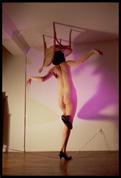
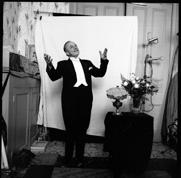



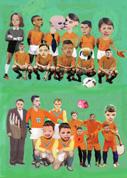

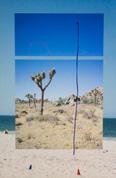

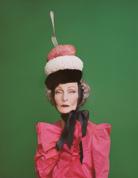



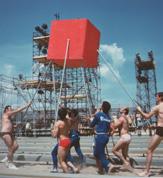

FEATURES 4 On My Mind 8 What’s New? 12 Bookshelf 14 Interview 22 Theme Text PORTFOLIOS 33 Rosana Paulino 49 Leonard Suryajaya 59 Kalev Erickson 73 Ivan Mikhailov 97 Lorenzo Vitturi 113 Alice Quaresma 125 David Fathi 137 Kay Kasparhauser 161 Mickalene Thomas 177 Charlie Engman & Hillary Taymour 189 Camila Falquez 201 Sheida Soleimani 225 Jimmy DeSana 239 Jos Houweling 249 Rolph Gobits 257 Pelle Cass 265 Sportification 289 Martine Syms 33 59 73 225 249 49 125 177 239 201 113 257 189 97 137 161 265 289
Play is one of the founding pillars that allows us to discover the world. To play is to learn how things work, how we behave, interact and how we can solve problems. It fuels our scientific thirst for experimenting, the enchantment towards the magic of discovery and the frustration of failure. It is also crucial to inform how we perceive and experience reality, and how we create a new, alternative one we might be able to control. Play investigates the powers at play in our society and its subversive, irreverent potential. It looks at its healing powers, the relief that comes from unlocking energy, creativity, and unexpected ghosts.
PL AY ! PLA y ! P L AY! PL AY! P LA y !
FEATURES
PLAYFUL APPROPRIATION AND THE ARCHIVE
JIMMY DESANA
ON MY MIND
Mavis Staples Fiona Tan Deborah Willis Glenn Ligon
WHAT’S NEW
Laura El-Tantawy Mariam Medvedeva BOOKSHELF of Hans Gremmen
INTERVIEW
with William Kentridge by Dana Linssen PLAY!
THEME TEXT by Elisa Medde ROSANA PAULINO
Text by Alecsandra Matias de Oliveira
LEONARD SURYAJAYA
Text by Efrem Zelony-Mindell
KALEV ERICKSON
Text by Timothy Prus
IVAN MIKHAILOV
Text by Anastasiia Fedorova
PLAYING THE SYSTEM
Text by Ben Burbridge
Text by Mariama Attah LORENZO VITTURI
Text by Kim Knoppers
ALICE QUARESMA
Text by Cat Lachowskyj
DAVID FATHI
Text by Lewis Bush
KAY KASPARHAUSER
Text by Carly Mark HOMO LUDENS
Text by Hinde Haest MICKALENE THOMAS
Text by Salamishah Tillet
CHARLIE ENGMAN & HILLARY TAYMOUR
Text by Maisie Skidmore
CAMILA FALQUEZ
Text by Chiara Bardelli Nonino
SHEIDA SOLEIMANI
Text by Maitreyi Maheshwari THE PLAYGROUND PROJECT
by Gabriela Burkhalter
Text by Bryan Barcena JOS HOUWELING
Text by Sacha Bronwasser ROLPH GOBITS
Text by Pim Milo
PELLE CASS
Text by Louis Kaplan SPORTIFICATION
Text by Franco Ariaudo & Luca Pucci BIOGRAPHIES CREDITS MARTINE SYMS
Text by chatbot
In his 1938 book Homo Ludens, Dutch cultural historian Johan Huizinga famously described play as the origin of all cultures. He believed the countless playful elements in our lives could not be explained purely by their biological benefits: the learning of skills, the release of tension, the acquisition of power and the establishment of hierarchies. Play was part of the nature of life itself, he believed, one that was reflected in extremely diverse cultural forms. If play makes you think primarily of squeals in the playground or a card game in the pub, then you underestimate the presence of play in our daily lives. To Huizinga, Homo Ludens was the basis of culture and cultural innovation. Culture does not merely arise out of play, it develops in and as play.
And although play can of course be valuable as recreation and relaxation, it never comes free of obligations. To play a game well you have to conform to certain basic principles. There is usually a clearly marked out playing field, there are players, there is play time and there are the rules of the game. If you fail to adhere to the rules you disqualify yourself. So inventiveness, creativity and innovation are of value only if deployed within the strict framework of a specific game. A player’s freedom is limited by the boundaries of the game. Play is often disinterested; the player’s interests concern only the game, and it is the game that gives playing its
value and purpose. At the same time, the game exists only by dint of the fact that it is played. In a sense this is analogous to art, which is likewise free of any selfinterest on the part of the artist, achieving real value only within a shared concept of what art is, how it is understood, and how it is deployed within a culture. There are cultural rules, commandments and prohibitions here too, often slightly disguised.
In this issue of Foam Magazine we turn our attention to the game, to playing and to humans at play. Play is essential to everything that makes us human and an integral part of almost everything we do. In play we find relaxation, pleasure and community spirit. There is plenty of space for frivolity, faux naiveté, humour and hilarity, no matter how serious the undercurrents may be. There is room for science too, for example, which similarly depends on rules and conventions but can fully develop only by means of creativity and experimentation, and which needs people with the courage to cross the boundaries of the familiar and explore new, unknown territory. Playing also means daring to be unconventional, to see things differently and make fresh use of them, to give them a twist and transform them. Audacity, vision and an open mind are essential in moving the game forward and adding something to what already exists. In his own time, Huizinga saw an erosion of the game and attributed this partly to
technological advances. What would he make of our own day, with its internethumans and the complex interaction of online and offline life? A nourishing environment for Homo Ludens or a paradise for cheats and spoilsports? At any rate, ours is a time in which nothing is fixed, in which everything is always in motion, in which realities and identities are compiled at will and hybridity is a key word. The browsing, cut-and-paste player creates new and unexpected forms of play.
We are extremely pleased with this issue’s wide-ranging interview with William Kentridge (portrayed by Dana Lixenberg), a South African artist whose expressionist and engaged work is unmatched in its exploration of social themes, in which playfulness coincides with seriousness and gravity is combined with lightness of touch. We also look at a shelf of books put together by Hans Gremmen, graphic designer and creator of photo books whose astonishing book designs always emerge from his appreciation of craft. All in all, we hope this issue will prove itself a great playing field with a variety of players that will give you, whether a discerning reader or participatory player, a very great deal of pleasure.
And last but not least, as she leaves Foam after 18 years as Editor-in-Chief, we give a final salute to Marloes Krijnen.
2 3 MARCEL FEIL
CONTENTS
Editor-in-Chief
4
225 239
Editorial
8 12 14 22 33 49 59 73 81
249 257 265 277 279 289
Text
89 97 113 125 137 145 161 177 189 201 209
MAVIS STAPLES is an American rhythm and blues and gospel singer, actress, and civil rights activist. Staples was inducted into the Rock and Roll Hall of Fame in 1999 and the Blues Hall of Fame in 2017. In 2011 she won her first Grammy award for the album You Are Not Alone. Her latest release, We Get By, features the image Outside Looking In as the album cover.
I had the pleasure of meeting Gordon Parks when he was alive, and was honored by his Foundation in 2017 with the Gordon Parks Foundation Lifetime Achievement Civil Rights Award. When we started talking about cover ideas for my new album, one of the ideas was to include a photo by Gordon Parks.
My label sent over a few different ideas and the shot Outside Looking In struck me immediately. That was it — I needed to have that as my cover. The image reminds me of me and my family growing up. It was so powerful I didn’t even need to see any other options.
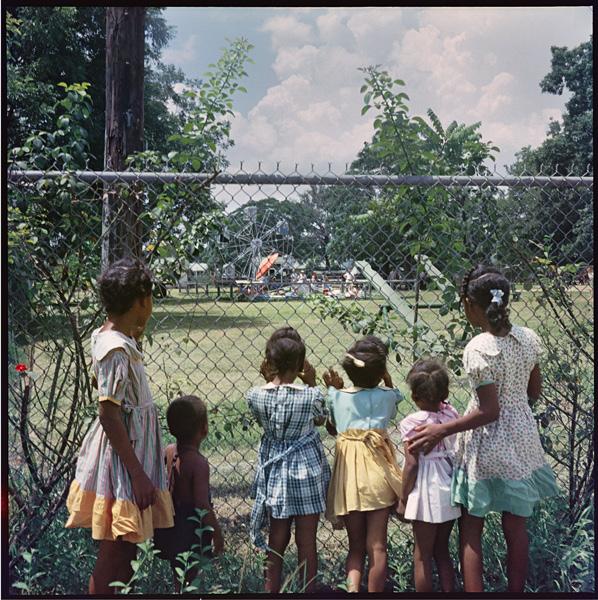
I’m so thankful that the Foundation let us use it for the cover. I can’t imagine having anything else.
Mavis Staples
FIONA TAN is internationally recognised for her photographic works, video and film installations in which explorations of memory and time are key. She represented The Netherlands at the Venice Biennale in 2009 and has participated in Documenta 11, and numerous other international biennials and exhibitions. Her work is represented in esteemed public and private collections. As the 2019 winner of the Spectrum Prize for Photography her work is currently on show in the solo exhibition Goraiko currently at the Sprengel Museum, Hannover.
As the fluorescent tubes flicker on, I am confronted by rows and rows of A5-format envelopes. I’m told that although this forgotten archive has been stored here in the museum depot for over 40 years, no one has ever really had a look at it.
I remove one of the orange A5 envelopes from a shelf at random. Attached to the front of the envelope is a small colour photograph, and above that a handwritten letter and number. The 6x6 original negative is stored inside. The image I’m looking at is a medium format shot of a woman posing with yellow flowers. This is clearly a staged photograph taken by a professional photographer. The woman’s expression is appealing but also disingenuous, managed. Although the resulting image is well lit, colourful, and professional, it’s also generic and impersonal. The image reminds me of the photos on my mother’s knitting patterns when I was a girl. What comes to mind is the word gaaf — colloquial Dutch for neat or perfect. What am I looking at? What is the photograph’s relevance today? And perhaps even more pertinently, what am I not seeing? The starting point for my photography exhibition — Gaaf — at the Museum Ludwig in Cologne.
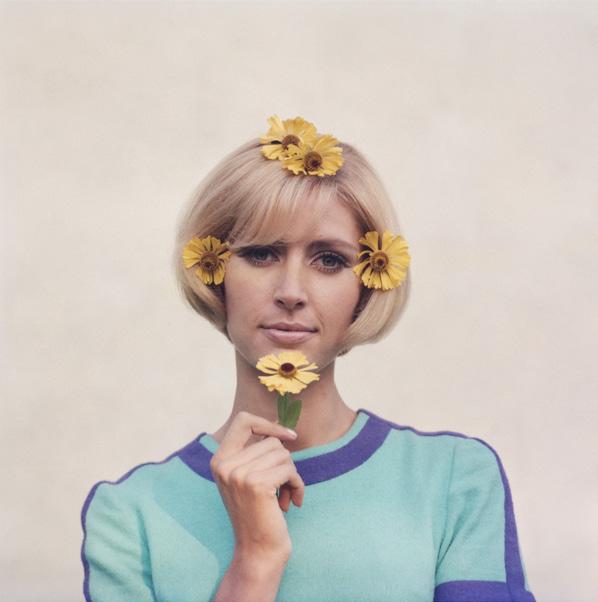
4 5 ON MY MIND ON MY MIND
Outside Looking In, Mobile, Alabama, 1956
© Gordon Parks, courtesy of The Gordon Parks Foundation
Fiona
Tan
Image from the Agfa Advertising Archive, 1950s/60s © Collection Museum Ludwig
DEBORAH WILLIS is a photographer, teacher, curator and an author of books on photography. She teaches at New York University.
Mirror (_2100135), 2017
I first met Gordon Parks in 1974. Parks was assigned by LIFE magazine in 1949 to photograph in Rome, Italy and a two-page spread was published in the August 1 issue of the magazine. The article documented Via Margutta, a narrow cobblestoned street in Rome where artists and poets lived and worked. This photograph of the artist Pericle Fazzini (1913–1987) in his Via Margutta Studio inspired me to think more about Parks’ focus on photographing artists at work. Here we see the artist chiseling, moulding, and shaping a female form in wood. He is wearing a
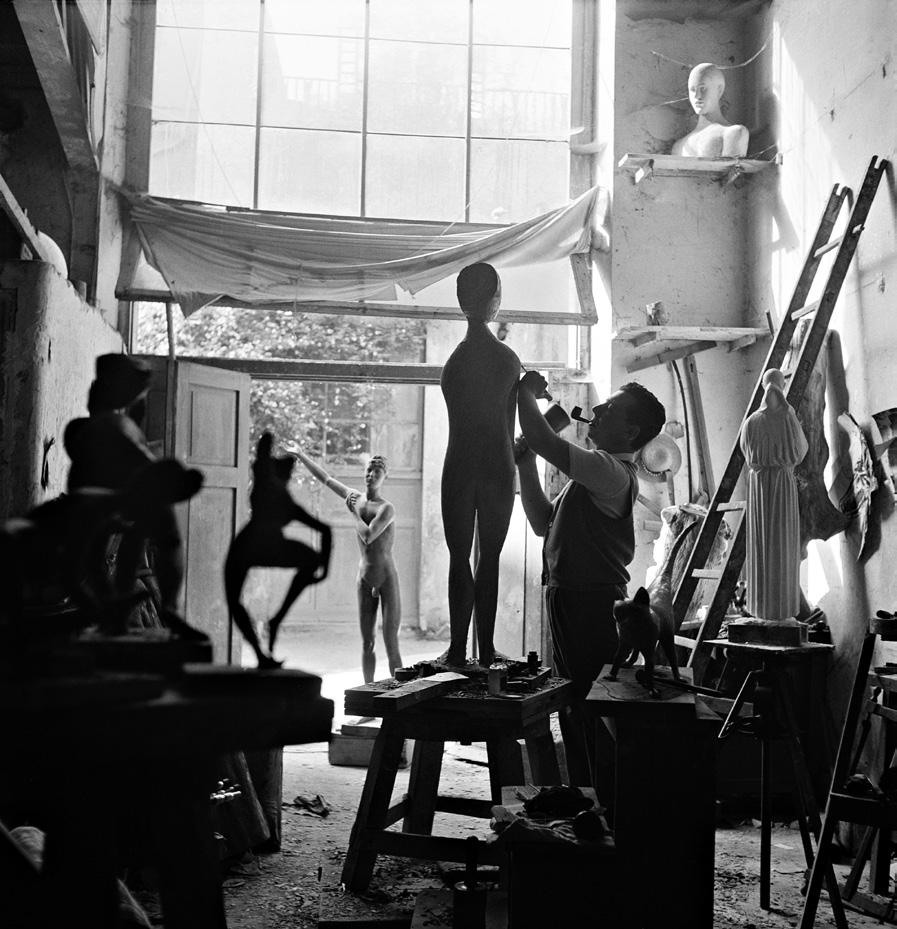
shirt and sweater vest, a pipe is balancing delicately from his mouth. The studio floor is filled with wood shavings and wooden models shaped in the female form appear to be dancing or holding on to a moment that Fazzini imagined. Its lighting and soft focus invites the viewer into the space as we peer through the studio trying to find the reference for the current piece. I am intrigued with Parks’ love of life, real and imaginary, as he creates this flawless image. Parks appreciates beauty in all forms — beauty in life and beauty in work.
Deborah Willis
The photograph is a record of some activities that took place in front of a mirror. One of those activities was the taking of a photo. The others are left for the viewer to surmise.
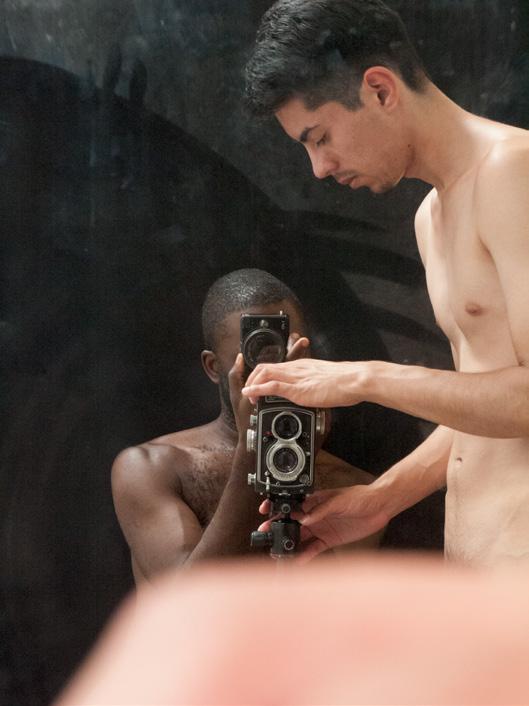
The image is dirty. Rather, the mirror in which the scene is reflected is dirty; coated with dust that someone has partially wiped away, but whose hands have left their mark.
The word ‘darkroom’ has several definitions: one is a room for developing photographs, another is a space set aside in a nightclub or bar for sexual encounters.
GLENN LIGON received a Bachelor of Arts from Wesleyan University and attended the Whitney Museum Independent Study Program. In 2011 the Whitney Museum of American Art held a mid-career retrospective of Ligon’s work, Glenn Ligon: America, organized by Scott Rothkopf. Recent exhibitions include: Des Parisiens Noirs, Musées d'Orsay, Paris; Glenn Ligon: Encounters and Collisions (2015), a curatorial project organized with Nottingham Contemporary and Tate Liverpool; Blue Black (2017), an exhibition Ligon curated at the Pulitzer Arts Foundation in St. Louis.
Is this image a self-portrait? The artist is in the centre of the composition, but the picture is not focused on him, it is focused on his entanglements. Sometimes a photograph is about what can’t be represented or what lies outside the frame.
A picture through a glass, darkly, so to speak.
6 7 ON MY MIND ON MY MIND
Glenn Ligon
Pericle Fazzini in Via Margutta Studio, Rome, Italy, 1949
© Gordon Parks, courtesy of The Gordon Parks Foundation
Darkroom
© Paul Mpagi Sepuya
LAURA EL-TANTAWY
A Star in the Sea is an overture for embracing the unexpected. The photographs, text and title pertain to three independent, personal life events: a love story, my first and only trip to my place of birth in the UK, and a vision on a beach in Italy. It is inspired by a desire to redefine my relationship with the ideals of success & happiness. In this context A Star in the Sea is an opportunity to celebrate imperfection — an artistic gesture to have faith in the universe. The work takes on the form of a book. It is conceived as an artistic object demanding intimacy — something you want to protect and treat with care.
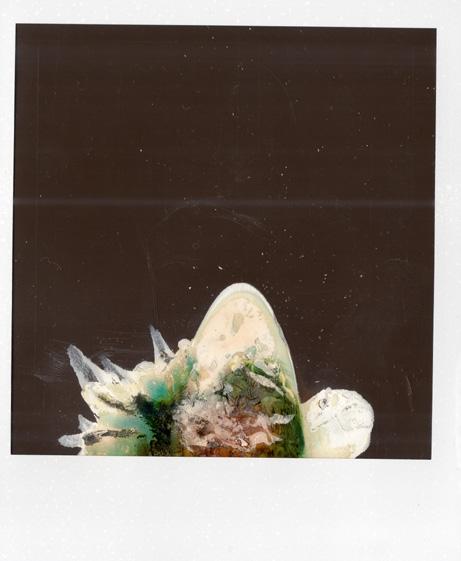
LAURA EL-TANTAWY is a documentary photographer, artful book maker and mentor. In 2015, she released her first title In the Shadow of the Pyramids a firstperson account exploring memory and identity. The publication was shortlisted for the prestigious Deutsche Börse Photography Foundation Prize. She self-published three other titles: The People (2015), a newsprint celebrating the Egyptian Revolution of 2011; Beyond Here Is Nothing (2017), a meditation on home and belonging; and A Star in the Sea (2019), an artistic contemplation on embracing the unexpected.

8 WHAT’S NEW? 9 WHAT’S NEW?
MARIAM MEDVEDEVA
Male Figure Studies explores the nature of men through photography and performance. I use natural lighting to paint the body. No electricity or batteries, everything is natural as a human body. The grey colour gives a 3D experience and is the ‘zero’ for our eyes and light exposure readings. The nudity of men and women is asymmetrically presented in visual culture. I gain inspiration from classical sculpture and fine arts. At first glance, in antiquity, female and male bodies were presented in relatively equal proportions. On closer inspection we notice how men’s bodies received very special representation because of their muscles, attitude, and masculinity. This is what influenced my choice of subject. For the models, in becoming naked they are taking on their bodies, experiencing dialogue with it. It always becomes their own personal experience. I observe and save. At the end of each photoshoot I have disconnected myself. I am there only as an instrument, capturing moments one by one. It is fascinating to see God and the source in men.
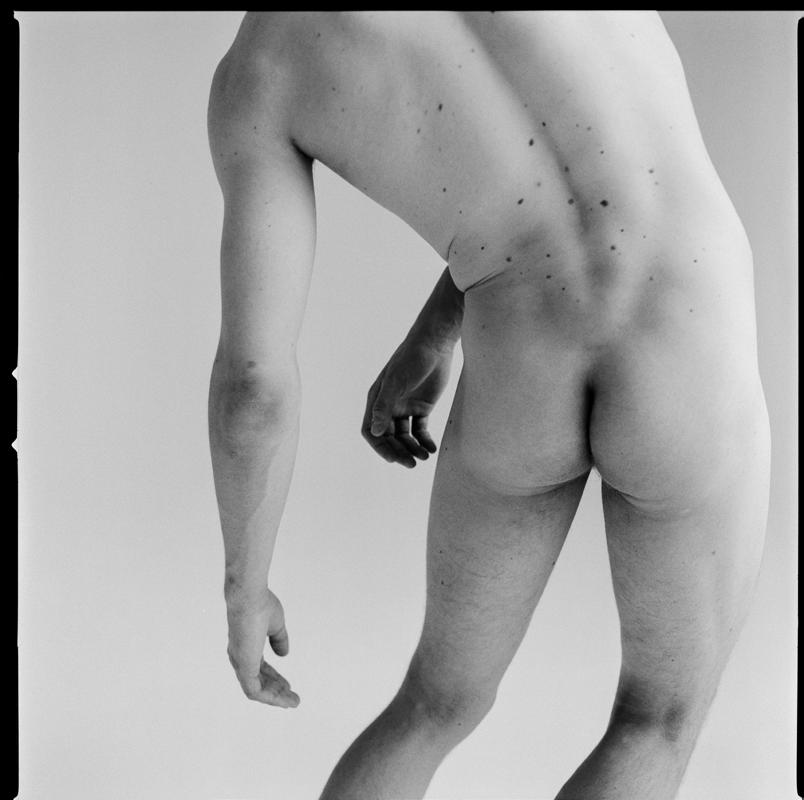
MARIAM MEDVEDEVA is a photographer based in Paris and working worldwide. After ten years in in the art and culture sector, she completed a Master in Photography at Speos Photographic Institute in 2013. In recent years, Mariam has been working on long-term and personal fine art projects.

10 WHAT’S NEW? 11 WHAT’S NEW?
2

1
BOOKSHELF
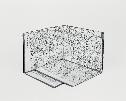
3 4 5 30.

THE RAND MCNALLY PHOTO-AUTO MAPS AND GUIDEBOOK 1

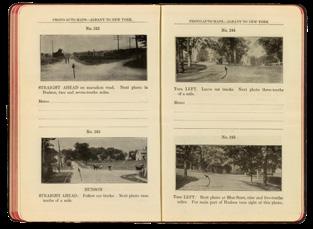
The Motor Car Company Co., Chicago, 1907
Not really a photography book pur sang but the way photography is used to guide people on their way is very charming. In the same way, it is very naive because the book is useless after cutting that one landmark tree on page 45, for instance. Nevertheless this book is Google Street View avant la lettre The way the landscape is documented is interesting because of the objectivity: the concept determined what should be in the frame, which results in a very honest slice of the American landscape of the early 1900s.
GOD’S OWN JUNKYARD — THE PLANNED DETERIORATION OF AMERICA’S LANDSCAPE 2
WISCONSIN DEATH TRIP
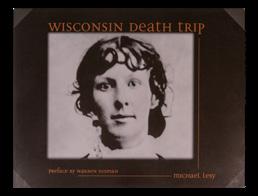
General note about my selection: this selection is my current state of mind; echoes from the near and distant past. When it comes to books, I like to surround myself with yesterday’s voices while I am working with friends on tomorrow’s books. The books are in chronological order.
HANS GREMMEN is a graphic designer, and founder of publishing house Fw:Books. He has designed over 200 books, and won various awards for his experimental designs.
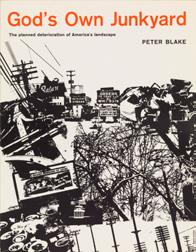
Among them a Golden Medal in the BestBookDesignfromalloverthe World competition, Leipzig.
Learning from Las Vegas by Venturi, Scott Brown and Izenour from 1972 is one of my favourite books; shaping my ideas and love for the behind the scenes of a consumer driven market, and its effects in architecture and on the landscape. God’s Own Junkyard (published nine years prior) is in many ways the counter voice of Learning from Las Vegas It is a visual pamphlet which takes a stand against the ‘uglification’ of America. A strong example of manipulating found footage into a political statement. This book is a dystopian projection of the future, based on images from the past.
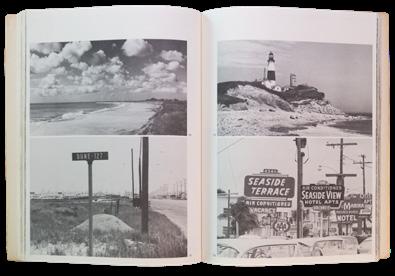
A brilliant book about the shadow part of the explorations of the frontier in the mid to late 1800s. The book contains historic images and is oblong in format. Both of these elements would, in 99 out of 100 times, make a super standard book which would most likely not leave a long lasting impression. But this book goes (way) beyond this issue: the mixing of texts, clippings, and images (many of them engravings) alongside photography comes together in such a good way, that time will never catch up with this book: it remains incredibly fresh and contemporary.

So far the far past.
In my two books from the recent past, picked two young photographers who both grew up in an era where the internet was already integrated into everyday life. This is reflected in their work in which they both balance on the thin line between reality, expectation and representation.
Google Street View is for both an important reference; it is a photographic tool, an incredible ‘new’ source of documentation of the world. Imagine how this will evolve in the next 20, 30, 60 or 100 years: being able to go back in time. At every location you can witness urban and social changes. Both photographers show their interest in the ghost in the machine by working with glitches of the system. This is an interesting and, in a way, a hopeful approach: within a world which seems more and more regulated, there will always be ways to wander, to be surprised and to create your own perspective on top of the image-drivenforced-cliché-thing-called-reality.

12 HANS GREMMEN’S
13 BOOKSHELF
Michael Lesy Pantheon Books, 1973
Peter Blake Holt, Rinehart and Winston, 1963
It
THIS WORLD AND OTHERS LIKE IT 5 Drew Nikonowicz Fw:Books with Yoffy Press, 2019 Drew Nikonowicz This World and Others Like It This World and Others Like
Drew Nikonowicz
GENERAL VIEW 4
Thomas Albdorf Skinnerboox, 2017
Thomas Albdorf
Skinnerboox
Damaged Utopias
William Kentridge in conversation with Dana Linssen
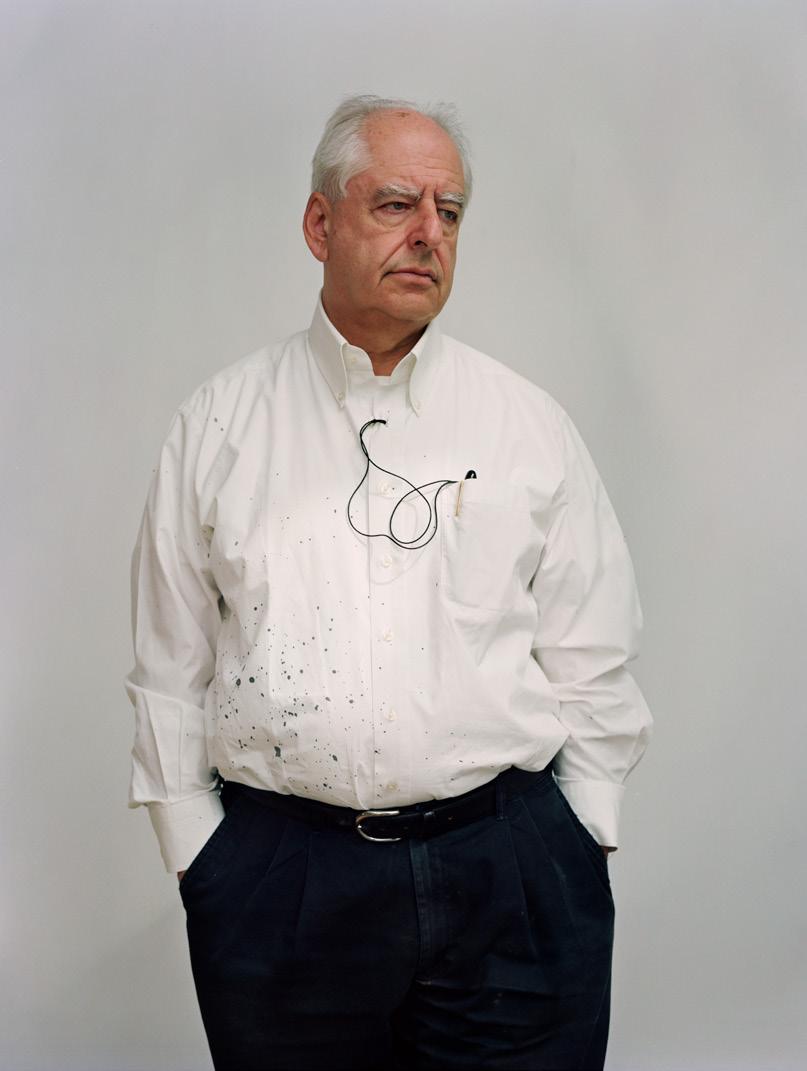
14 INTERVIEW INTERVIEW
15
Portraits by Dana Lixenberg
This stratification of images and materials can be found in his sculptures and stage designs as well. But this procedure also reflects his thematic interests: hidden histories, selective social amnesia and recollection and reconciliation. Damaged utopias as he calls them are another of his ongoing fascinations. I spoke with the artist about the importance of inadequacy and provisionality in his works on the eve of the premiere of The Head & The Load at the Holland Festival in Amsterdam, where he was associate artist and presented a cross section of his recent stage works. Simultaneously an exhibition in the Eye Filmmuseum presented his Ten Drawings for Projection, documenting South Africa history of Apartheid and its aftermath and the installation O Sentimental Machine, a love story with a megaphone, in which Kentridge plays revolutionary Leon Trotsky.
DANA LINSSEN: O Sentimental Machine was originally commissioned by the Art Biennale of Istanbul, but I understand that some of the ideas originated in Amsterdam?
WILLIAM KENTRIDGE: While working on the previous exhibition I had here at the Eye Filmmuseum in Amsterdam, More Sweetly Play the Dance / If We Ever Get to Heaven in 2015 I was already interested in a project on Trotsky in exile. The Eye has a distinction of being a film museum but is also the portal to the Dutch film archives and they showed me some wonderful pieces of archival material that I don’t think existed anywhere else, one of which was an eight-minute public oration that Trotsky gave in French. And my understanding, and I might be completely wrong with that, was that it was recorded on film with all the grand gestures as if he was talking to a crowd of thousands, because he did not get a visa to travel to France, so the only way his message could get to France was in this recorded speech. It is a very unremarkable speech. He doesn’t say anything new. He is so completely caught between wanting to defend what is happening in the Soviet Union and being against Stalin that he is left in a very weak position.
DL: Would you say that is politics at its best or at its worst?
WK: It is politics at its most tragic. But there is still a kind of optimism and hope in his voice in what he is saying that is kind of wonderful. So, it is a time capsule of that damaged utopian moment; even in that period it is already very compromised and damaged. I had already started
making that film in advance, in which I played Trotsky with a paper beard and moustache, and that is why I asked about that Trotsky footage. The film itself is a love story between a megaphone and Trotsky’s secretary. It has to do with the belief in the perfectibility of machines, that was a very strong Soviet and early 20th century idea and is not so far of the contemporary idea of artificial intelligence and machines that will think for us. Trotsky believed in humans being mechanical — if we could just solve that little bit of the human machine called psychology to construct the ideal revolutionary.
DL: One thing that is very characteristic for your work is the layering of images and their seemingly accidental quality. Can we break down the practice, process and the themes of your work from the perspective of accident and layering?
WK: The briefest capsule of my work is that it starts with drawing, with charcoal drawing. Charcoal is a medium you can adjust very easily, with a cloth or with an eraser. And so instead of making thousands of different drawings there are a few drawings in each film which get erased and redone many hundreds of times. And each piece of paper, each drawing is a record of that scene coming into being. Which means that of itself, without it ever having been a conscious decision, what is brought into the films is a sense of the passage of time. Because you see the trace of the previous frames and the erased and the grey erasure of the paper. It is always about inadequacy and provisionality in the sense that it can always be changed, it can always become something else. One has to find a strategy to allow these accidental moments to occur and become part of the work. The themes of that are time and erasure and memory and ghosts of things that are built into the image and the material and become part of the work. When we speak about the Ten Drawings for Projection, over the 30 years that these films have been made, they are not a direct history of South Africa, but they correspond to different key moments, from the end of Apartheid, to the AIDS epidemic.
DL: What came first, the practice of erasing and layering or your interest in the erasure of history, and issues of memory, recollection and trauma?
INTERVIEW
WK: It has to be both. There has to be a physical medium, whether it is charcoal or ink in which to think about the subject. But there is an impulse or a first image and then you rely on the physical work to suggest other images and gradually discover what the film is about, rather than knowing it beforehand. But they are never made with a script or a storyboard which makes them inefficient films, but that is the way that they have to be put together.
DL: You recently started to work in virtual reality and augmented reality too. What does that bring to your practice?
WK: They are generally still analogue performances captured by 360-degree cameras, which you then have to see in a virtual reality headset. It is a different way of making a theatre performance. You, the audience are right in the middle of it. And the voices are behind and around. It is the start of an exploration. I don’t think I’m so interested in deep virtual reality, when we would really recreate a world that looks like a drawing of mine. For now, I’m interested in having the drawing and looking at it from a different perspective. One of the problems of VR is that it is an isolated single person experience. The degree of immersion is frightening.
DL: Given your interest in the romances between men and machines, between drawing and the photographic images, what is VR giving you that other media and art forms haven’t been able to?
WK: Maybe the way scale changes. When you look at a drawing in the world there are many clues that set the scale for you, in relation to your body, or other objects in the same space. One of the things that VR does is that it completely loosens that sense of scale. It does things with that, and with the shocking feeling of presence that makes you aware how much your brain is doing constructing images. That is an ongoing fascination I have, how perception works, the work we do to make sense of images.
DL: Do you ever regret that due to the essence of your working methods most of your work is an irreversible process, that you can’t go back to a pre-existing image?
WK: You can, you just redraw it. You stop the film there and it won’t be exactly the same but that is ok. It maybe won’t be the same in a practical or factual sense, but also not in a philosophical sense, because time has passed. When I went from film to digital I did not change my practice. With animation in the digital camera there is a way that you can look back at what you have but I have a rule of never doing that, so that you are always thinking forward as you did with film, you couldn’t go back. So, it is always thinking the movement ahead and if you got it wrong you got it wrong.
DL: A question that comes forth of this practice is whether you prefer the concept of time’s arrow or time as a stratigraphy?
WK: Deep time I think of as geological strata, but current time either as an arrow if you want it to be immaterial but otherwise it is like a section of books on a shelf and the movement of time through all those pages, but it is a material that you are moving through naturally. No,
actually I don’t think of it as an arrow, because when you’re animating it is always stopped, everything is in a static moment, and accumulatively it gives you the movement of the arrow. So even if you are drawing a line and saying the arrow is moving, it consists of all these static moments.
DL: Can we take this as a starting point to talk a bit more about the themes of your work?
WK: There is a lot of geology drawn into Johannesburg’s history of mining, of going down into the ground. But I was realising I was working in a new film and there are certain sequences when there is a landscape when there essentially is a bird that moves from one side of the frame across to the other and in a way that is just drawing time, it could be anything, it’s just a movement. But the difference is that if you just draw a landscape and you have a static frame and you hold it for five seconds the time resides in the viewer. They are giving it the five seconds of watching. If there is some movement in it, suddenly the movement goes into the image. A lot of the drawing I have done in the last 10 years is on top of books. That has to do with the previous history that is being reinscribed. The same drawing on a blank sheet of paper or in a book has a different quality, partly because of the absorbency of the paper and partly because of the sense of grid of knowledge that lies underneath. The context becomes part of the drawing.
DL: When you are drawing over your own work you are actively erasing, so could we say that when you are drawing over a pre-existing text you are actively obscuring?
WK: That is a question that I would never ever ask myself in the studio. I think it is a belief in the fragment, and knowledge or meaning are always being made from a provisional combination of fragments, put together in a certain way to give a coherence we hope it holds. And when the fragments are rearranged in a different order the same information can give two different meanings. Which is then about the activity of making sense of the world. The collage makes you aware that you are making it coherent, because it wasn’t coherent to start with. The work in the studio is the demonstration of that. Because that is what happens for every artist in every studio, the act of creating is in itself a demonstration of how to make sense of the world.
DL: And when we expand this to the way you are not only returning to the history of South Africa in your work, and its interconnectedness with European histories of colonialism and the Holocaust, how do these themes create these tectonic shifts in your work, and keep erupting?
WK: Part of it has do with a set of images that sits in people. So, there is one film I did, The History of the Main Complaint (1996) where we see Soho, one of my returning characters, behind a curtain in a hospital. But a young black South African man told me: it is so fantastic that you’ve drawn a shack, with a corrugated iron roof. So, for him it was completely a drawing of a shack with a bowl of water outside and he loved it for that. Soho is always in his pinstriped suit, and some other viewers say: It is so interesting that Soho is wearing these striped concentration camp pajamas. Certainly, I was not drawing either of those. I think it is because of the roughness of
16 17 INTERVIEW
William Kentridge’s oeuvre is a landscape of layers: his animation films are produced during a process of drawing, erasing, and redrawing, putting one image over the other, often using existing backgrounds such as books, maps or photographs, creating visual sediments of time.
the drawings and their ambiguity which allows people to link in to images that they already have. I think that is what we always do, trying to make sense of things we don’t quite understand as if they might mean something we have seen. There is also a belief in the ability of other people to make imaginative leaps to understand other contents, even if they misunderstand, even if they misconstruct it. My intentions are always the least interesting part of it.
DL: But even without the artist’s intentions… if I as a spectator have a certain set of images in my mind, then you as an artist will have a certain set of images in your mind too that are returning in your work.
WK: Cultures are most lively when they are misunderstood and appropriated. Everything is enriched by people from outside the tradition. And the one thing that Apartheid taught us in South Africa was the destructive nature of identity politics. And I know that identity politics has become very important in gender relations and racial relations, but what I see each time is the damage of essentialism. And the falseness of trying to go back to an imagined tradition. Every tradition is a construction, the more desperately it is hung onto, the greater the falsity of it.

The only hope is a kind of bastardism, when things from different traditions are taken and meeting, and overlapping, and this is just a lesson from South Africa. Take someone like Gandhi, whose pacifist resistant politics relates back to a kind of Indian spiritualism of the Bhagavad Gita. But the last thing he got it from was from being a good Indian mystic. He got it from conversations with a Jewish South African architect he befriended who got him to read John Ruskin and Madame Blavatsky who used this kind of meta-fake Indian mysticism to justify her talking to dead people and through that he got back to the Bhagavad Gita and to Sanskrit and it is through that kind of mixture and these very circuitous causes that he arrives somewhere.
DL: Your sympathy for cultural appropriation could have been undisputed 20 years ago but is a controversial issue today. How do you discuss this with the new generation of South African artists that you work with, for instance in the Centre for the Less Good Idea in Johannesburg, where you support experimental, collaborative and cross-disciplinary arts projects?
WK: There are a lot of young black artists that are not interested in working with a white established artist. There is a much greater kind of separation than there was 20 years ago. But the people that I do work with understand the richness that comes from working with what comes from the meetings of different traditions, with stories and dances, and large parts of their histories that I know about that they have no idea about. In the opera The Head & the Load there is a lot of history that would be difficult to separate and say this is white history and this is black history. The whole point about colonialism is that everyone becomes complicit and the whole nature of the First World War was the schizophrenic desire to resist being part of the war and the demand to be part of it. And to take that and understand the real messy implications, so yes I am sure some people will hate the work for that, and with some people it will be possible to have a discussion about it and we also understand that rage is a current phenomenon and to even begin to have a discussion is to give in to the discussion. So I do understand that, but then there is nothing to be said.
DL: The Holland Festival opening production The Head & the Load about South Africa and the First World War is in fact the result of a very communal and collaborative process, could you describe how that went?
WK: We had a workshop of about 45 performers, of about 60 people in all. The music that comes out of the two composers Phillip Miller and Thuthuka Sibisi is sort of a mixture between European high modernism and African cultural tradition. The form is a mixture of Dadaism and dance from the north of South Africa. It
18 19 INTERVIEW
INTERVIEW
Every tradition is a construction, the more desperately it is hung onto, the greater the falsity of it.
was a larger scale than other ones that I have done, but it is no different from a lot of theater that I have made in South Africa over the years. I’ve worked with many of the dancers before in the Centre for the Less Good Idea, or had seen them at work in different projects, the composers suggested musicians. The design team are people I have worked with for years.
DL: What do you recognise in them? Is it the same desire to reinvent an art?
WK: I think so. In South Africa there is a huge pressure to write the political essay before the work is done. To say what the outcome is going to be. The Centre for the Less Good Idea is a release from that. A lot of the work we do is very political, but it is done without an agenda. And I think people are open to see what will emerge instead of what we will say in advance what it will mean. As artists we understand the gap between what happens when we are making something and the essay that either before or after tries to justify that. Oftentimes the things you make don’t say the things you expect them to.
DL: You just used the word ‘political’, how do you understand that term in relation to art?
WK: I understand the provisionality, the ambiguity, and paradoxes of politics. All attempts to make a work of political clarity are falling into the traps or authoritarianism, every stake certainty carries a big stick and beats everybody else into silence. So, the more ambiguous, the least clear, the most interesting they are. Paradox and ambiguity are central to my work, because they are often seen as the edges of knowledge that are in fact central to how we understand the world. Thats comes from my biography and my experience, from the work in the studio, from having seen all the political changes. At the end of Apartheid, it all seemed so clear, and it all seems so messy now. In a sense South Africa is a model for the rest of the world. Not a successful model, but a prescient image where the formal economy gets smaller and smaller and the informal economy where people have to get by and improvise, and informal settlements become larger than the highways, where you can divide the world into the 75 people that can get on Elon Musk’s rocket to Mars to start a new colony and the 7.5 billion that won’t. In that sense the disfunction of the society is kind of a key to where we’re going.
All images © Dana Lixenberg, 2019
WILLIAM KENTRIDGE is internationally acclaimed for his drawings, films, theatre and opera productions. His practice is born out of a cross-fertilisation between mediums and genres, and responds to the legacies of colonialism and apartheid, within the context of South Africa’s socio-political landscape. As an opera and theatre director, Kentridge has also collaborated with the Metropolitan Opera in New York, the Royal Opera House in London, and the Holland Festival in Amsterdam. His work has been featured in numerous solo and group shows, including Documenta, Kassel; Tate Modern, London; Museum of Modern Art, New York; Venice Biennale, and presently in exhibition at Eye Filmmuseum, in Amsterdam.

DANA LINSSEN is a philosopher and film critic. Since 1997 she has been working as a film critic for the Dutch daily newspaper NRC Handelsblad, and for more than 20 years she was the editor-in-chief of the Dutch independent film monthly de Filmkrant. In 2009, she won the Louis Hartlooper Award for Film Journalism. Dana has worked as a jury member for various festivals, including Berlin International Film Festival, Venice Film Festival and Cannes Film Festival.
DANA LIXENBERG is a photographer and filmmaker. She studied Photography at the London College of Printing and at the Gerrit Rietveld Academie in Amsterdam. Dana pursues long-term projects on individuals and communities on the margins of society. She lives and works between New York and Amsterdam. The series Imperial Courts 1993–2015 was awarded the Deutsche Börse Photography Foundation Prize in 2017.
20 21
INTERVIEW INTERVIEW
All Work a
 by Elisa Medde
by Elisa Medde
23 THEME TEXT
No Play 22 THEME TEXT a ghost in sharp relief , from the series psychic pictures , acrylic and UV print on hand-carved wood panel, 40×28", 2019 © Zach Nader, courtesy of the artist and Microscope Gallery
nd
The moment we start working on a new theme for Foam Magazine normally begins with a blank board and a word. We write down a word, and then we press play. We start talking, and writing down all the words that appear to be somehow connected with the master word.
In a process very similar to cell division, a map, a word bubble appears, made of many different words, each with its own identity and projecting each towards a different direction. As if that master word was an entity in fieri, made by a semantic core that erupts from as many particles as it is made of: a dual process of creation (a cell that starts dividing and by doing so expands and enlarges its limits, its physical boundaries) and expression, with words like pollen erupting from a ripe plant on a windy day. It’s a tricky play with no fixed rules: easy to get carried away with spin-offs and side bubbles, or overexcited with hay fever. It’s a free play, that we try and struggle to structure and tame into a strong game – by means of large doses of improvisation. A big house of cards based on two very strong founding pillars: creation, and expression. Which is exactly what the core essence of the noun Play is based on, making it all very meta and kind of dizzying. In fact, what we mean when we use the word play is a range of activities, with the purpose of leisure, enjoyment, pleasure: it is a recreational activity. To play means to act, perform. Also, to play means to act creatively. And also, to play means to create.
On Play, its functions and meanings for human and non human children and adult specimens, quite a few theories have been elaborated. Since around 1850, we can count at least seven classic (or old) theories – Surplus Energy, Relaxation Theory, Pre-Exercise Theory, Recapitulation Theory, Growth Theories, Ego Expanding Theories – and four current theories – Infantile Dynamics, Cathartic Theory, Psychoanalytic Theory, Cognitive Theory. These theories all disagree on the majority of positions and facts, but yet all have one assumption in common: that creativity plays a fundamental role in whatever the reason is that we play, and that it has a very deep, thorough effect on our brain and therefore in our emotional and social intelligence.
The Oxford Dictionary also reminds us that to Play means to ‘engage in activity for enjoyment and recreation rather than a serious or practical purpose’, while as a noun stands for ‘Behaviour or speech that is not intended seriously’, often ‘Designed to be used in games of pretence; not real’. In our cognitive map, Play belongs to the universe of the unreal, close to the galaxy of magic and very much influenced by the magnetism
of absurd and paradox. A dimension normally belonging to children, and unrelated to anything remotely useful. Unless we talk about organised play – that is –game. As Play accommodates structure, rules, architecture and especially purpose it exponentially becomes pertinent to the world of adults too. As adults, we do keep playing ultimately because it makes us feel good, it’s satisfying. It is liberating – we notice it more when we lack it, rather than when we have it in our frantic daily routines. The adult-friendly versions of Play go under the nouns of sport, performance (musical or theatrical), video games. Arts.
So what kind of game are we playing here? And why? The link between Play and the arts, all of them and specifically visual arts, it’s an easy one, stemming from that founding pillar that holds the weight of so much we are concerned with: Creativity. Creativity moulds, stimulates and directs play in so many different ways they are countless. But it needs a trigger, that we call Inspiration. And inspiration is indeed a game changer. Abundant in children, becomes more scarce, complex and precious in adulthood, frequently teaming up with Motivation.

24 THEME TEXT 25 THEME TEXT
finally somewhere to sit , from the series psychic pictures , acrylic and UV print on hand-carved wood panel, 40×56", 2019 © Zach Nader, courtesy of the artist and Microscope Gallery
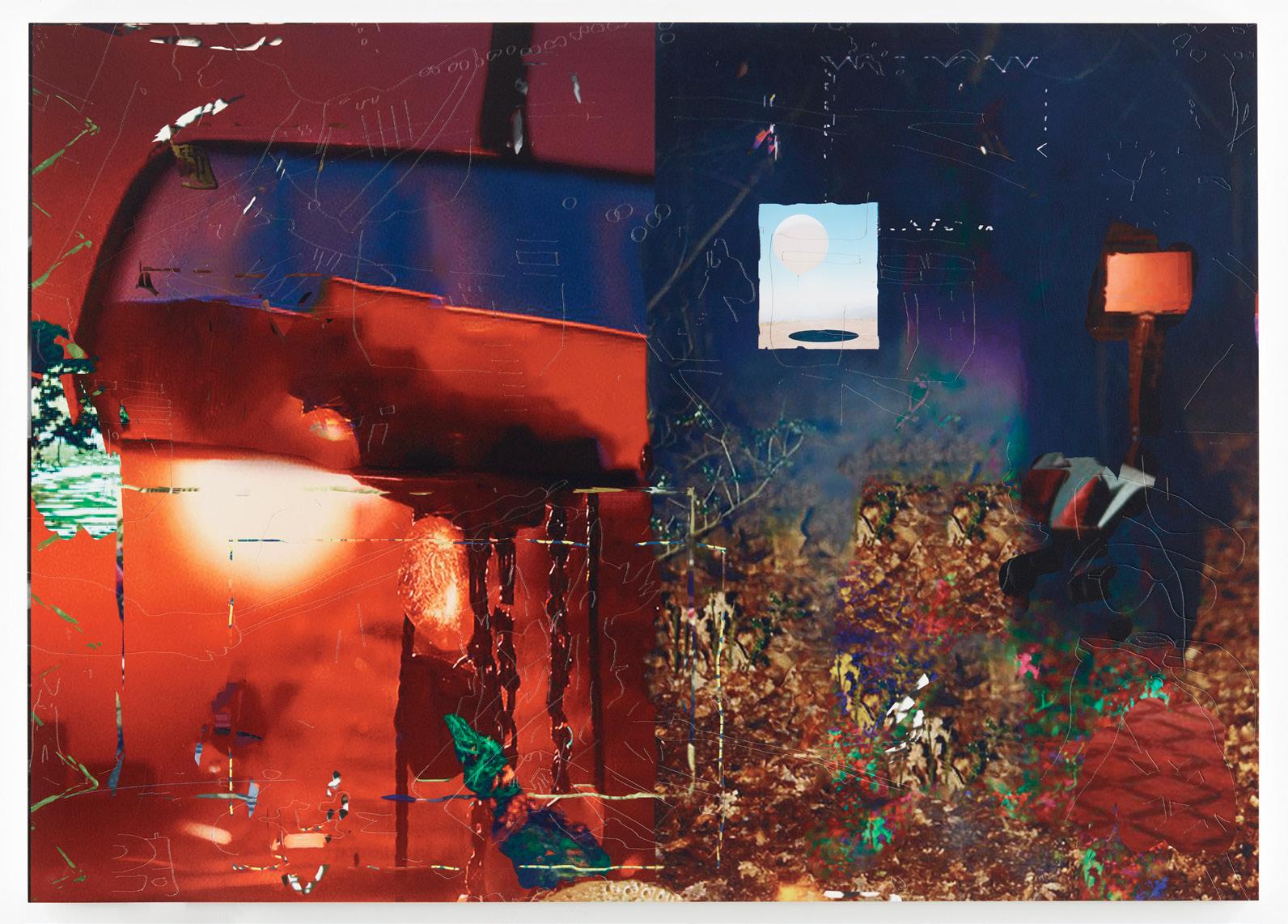 maybe we’re on fire , from the series psychic pictures , acrylic and UV print on carved hand-wood panel, 40×56", 2019
© Zach Nader, courtesy of the artist and Microscope Gallery
maybe we’re on fire , from the series psychic pictures , acrylic and UV print on carved hand-wood panel, 40×56", 2019
© Zach Nader, courtesy of the artist and Microscope Gallery
The creative process in adulthood often becomes a complicated one, drenched in struggle and horror vacui (especially the less we engage with it) until something unties the knot, plays the trick, and the magic begins. Everyone has their very personal and different relation with the creative act and the dynamic of it unfolding, but it is safe to say that the creative act releases a very strong and deep sense of liberation, a relief. Once this happens, and one finally starts playing the game, the possibilities are infinite.
If all artistic acts are playful, in a sense, some are more concerned and conscious than the others. If it can be said that any artist, or specific body of work, barely engaging with the medium itself is playing with it, there are plenty of cases in which Play becomes more central, sometimes crucial, to the core purpose of the work itself. It is one of the most important powers of art, to be able to catalyse, express and put the spotlight on acts and aspects that are absolutely central and fundamental in our everyday life – we are just too busy to see them, or feel them. Playfulness, leisure and performance all have a crucial role in building our personalities and our communities: we play and assume roles both on a personal and group level continuously, assuming stances and positions based on the extent in which we play by the rules or break them. Play is also one of the fundamental acts that allow us to discover the world. For babies, to play is to learn how things work, how we behave and interact and how we can solve problems – and this is an imitation game in which we all play a part.
Exactly the same attitude, can be argued, fuels our scientific thirst for experimenting the enchantment towards the magic of discovery and the frustration of failure. Science is often perceived, rightfully, as a very controlled form of play but it is one that requires an incredible amount of creativity to start with – to imagine what is not there yet, or perceive how processes might work and could be hijacked. Play is also crucial to inform how we perceive and experience reality and the events that create our everyday life. But also, how we create a new, alternative reality we might finally be able to control. Play also investigates the powers at play in our society and its subversive, irreverent potential: it will be a laughter that will bury you all. The spectrum includes also the healing power of play, the relief that comes from unlocking those hidden parts of our self through improvisation, rituals and the theatre of the absurd: a psychomagic act, as Alejandro Jodorowsky defined it.
When looking at photographic practices through this lens, each body of work amongst the ones presented in the issue of Foam Magazine you are holding in your hands assumes a specific role, performs its part in the precious ‘bag of seeds’ that we wish each issue of the magazine to be. After all, to play also means to willingly make room for a fertile ground that triggers and allows
more creativity – leaving us wondering if any of those theories mentioned before had a close look at the addictive nature of play. To Play, moreover, goes hand in hand with ‘to craft’. This is also a very important component of the artistic process, but also of the ‘activation’ mentioned above – to press play. This activation can also be seen as a fertile act that allows us to deal with incredibly difficult things such as tragedy, violence and oppression. Through art we can expose them, expose the power structure that allows their existence, and fight them – while at the same time we can finally start healing from them. This is the case, as an example, of the work of Rosana Paulino that we present here with a portfolio titled Atlântico Vermelho / Red Atlantic. The features that lie at the core of her artifacts – the craft itself, the manual labour involved, the reappropriation of images and symbols, and all the tools she employs to speak of her themes – slavery, diaspora, oppression and violence against women to only name a few – take the viewer by hand into an experience that resembles a ritual. A grieving ritual in which the evil, the pain and the suffering are faced, exposed, confronted, and then incapsulated in an act of love and healing.
Kay Kasparhauser’s portfolio is a remastered close up of her project @wip.tba.001. Living as an in-progress Instagram feed, it’s an immersive experience on the pure nature of images, their connections and our neural pathways. She plays and engages with, and manipulates visual elements coming from the most disparate sources, from paintings to sculptures to movies and more, creating narratives that are both immediate and

28 THEME TEXT 29 THEME TEXT stay cool , from
series psychic pictures , acrylic and UV print on hand-carved wood panel, 40×56", 2018 © Zach Nader, courtesy of the artist and Microscope Gallery
Play is also crucial to inform how we perceive and experience reality and the events that create our everyday life.
the
they will not die , from the series psychic pictures , acrylic and UV print on hand-carved wood panel, 28×40", 2018 © Zach Nader, courtesy of the artist and Microscope Gallery ↘ 31 THEME TEXT

looking for poison frog , from the series psychic pictures , acrylic and UV print on hand-carved wood panel, 40×28", 2019 © Zach Nader, courtesy of the artist and Microscope Gallery
articulated – with the devil hidden in the details and playing with ghosts. Each plate has also its own reason of being and is a micro narrative, unfolding in captions. A unique being with multiple personalities that acts as a modern Atlas of Mnemosyne.
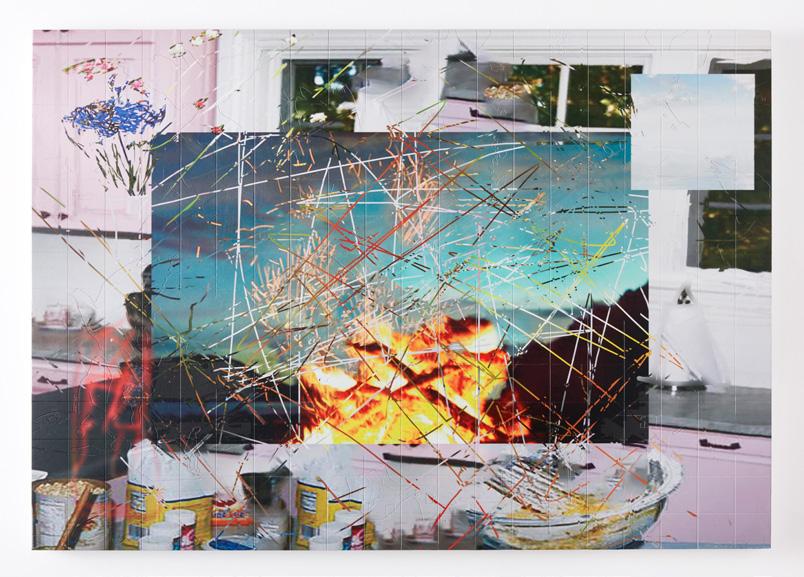
30 THEME TEXT
Ghosts are nothing more than traces, presences, carved in the memories of what was once. In 1924, art historian Abu Warburg started to work on his seminal (and unfortunately unfinished) work called the Atlas of Mnemosyne. This consisted in a series of 79 thematic plates (of which only 69 were effectively realised) in which Warburg arranged and rearranged black-andwhite photographs reproducing art-historical works and cosmographical images. In his words, it had to be a visual map ‘On the influence of the ancient world. This history is magical – to be dissembled. A ghost story for the full grown up’. Influenced by the studies on the nature of memory and its ‘physical’ location in the brain by Richard Semon, his aim was to ‘map the afterlife of antiquity’, that is ‘how images of great symbolic, intellectual, and emotional power emerge in Western antiquity and then reappear and are reanimated in the →
art and cosmology of later times and places, from Alexandrian Greece to Weimar Germany.’ Called phatos formulae (phatosformeln), the pathways illustrated in the panels formed a cartograph to investigate the origins, the histories of western visual culture and the movements and migrations of its elements through the centuries and cultures. A visual association game based on very rigid rules, the Atlas of Mnemosyne sought also to playfully create a method through which we could practically see the invisible threads that connect images, so to create a big puzzle that could ultimately help us understand something about our visual universe, and ultimately about us.
The images accompanying this text are made by Zach Nader, and are part of a series called psychic pictures. His work stems from Flusser’s idea that images both program and are programmed by our world in an endless feedback loop. Each image is a wood panel that is gessoed and painted white, carved into, and then printed over with a UV printer.
Everything in this set of work is made from existing advertisement imagery, imagining ‘these idealized situations and bodies combining, looping through our world, crumbling, and creating new things’. Again with his words, ‘think of the carvings as chunks of images, in this case also idealized situations and the place where I make the body visible again – as more of a ghost. They require the viewer to consider their distance and relationship to the object as they shift from appearing as a faint line into a physical mark’.
It is this physical mark making, whether through imagination or photography, that allows us to visualise play and its performative elements. Through learning and creativity, we can discover various ways of pressing Play, triggering our sense of discovery and learning and fueling our appetite for adventure. Play is also a call to arms: a resistance against passive entertainment, and the commodification of our attention. An ode to the energy sparked by a new adventure about to start, and the infinite possibilities it could unfold. WAAARRIORS!
32 THEME TEXT * The Warriors (1979)
COME OUT TO PLAY-AY! *
ROSANA PAULINO
Atlântico Vermelho / Red Atlantic

33


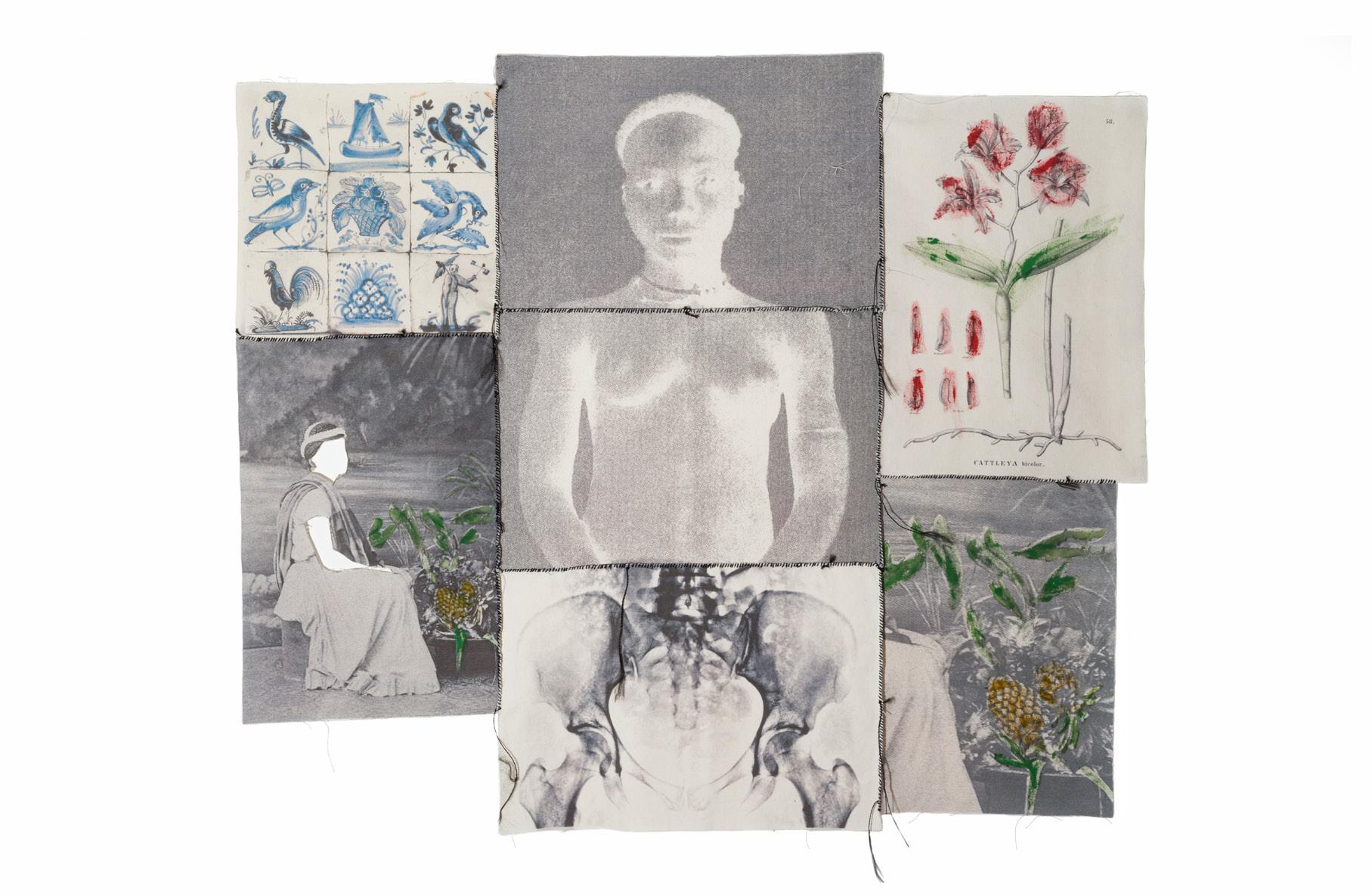
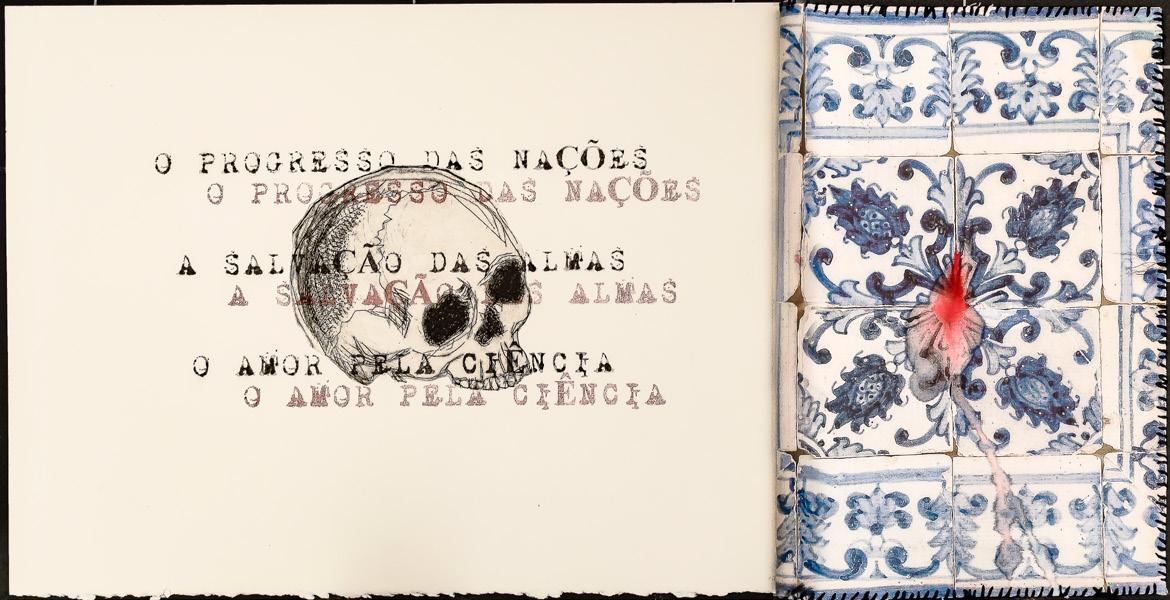


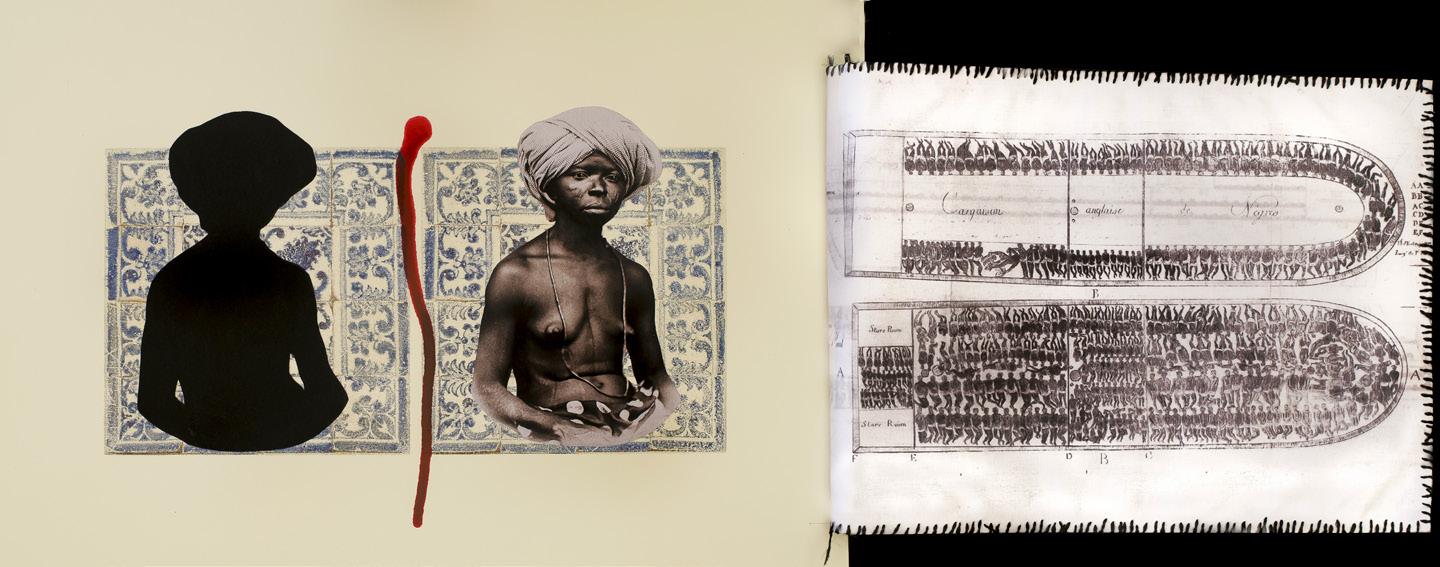 make the scanned background same as page background (Rich Black)
make the scanned background same as page background (Rich Black)
Rosana Paulino opts for addressing sensitive topics such as social, gender and racial issues, playing with various images and different techniques. This ranges from the simplest (coming from the domestic world) to the most sophisticated (requiring technology and experimentation). How to expose the scars of slavery, for example, in a delicate and poetic way? There are many solutions, however, the artist chooses the path of affections, memories and stories that emerge from the bricolage.

By employing drawing, engraving, weaving and photography, she places the colonial past and, above all, slavery, into the debate of our days. Yet, this is without apparent aggressiveness, it values the playful instead. In every work, there is a game of cut and paste as if it were fragmented and reassembled memories that stir up sensitivity and give new meanings to her works. These images bring the ‘anthropological photography’. The record of the fauna and flora of the ‘new land’, crude sutures, and disconcerting collages all these elements together recount memories silenced by the official history. In a special way, we evoke two works full of playthings: Red Atlantic and ¿História Natural?
Red Atlantic refers to the work of Paul Gilroy, the Black Atlantic: Modernity and
Atlântico Vermelho / Red Atlantic
Double Consciousness (Harvard University Press, 1993). In the book, Gilroy addresses a black Atlantic culture with African, American, British, and Caribbean roots. Rosana’s work is beyond cultural assimilation; it converges on one of the most sensitive metaphors for Afro-descendants: the crossing (the diaspora). Sea and caravels brand this imagination, however the voyage of a tomb ship through the unknown definitely marks the deprivation of the enslaved. Her Atlantic is red, tinged by the blood gushing between Africa and Brazil. The writings are red, as are the marks on the beautiful Portuguese tiles. For three centuries, the capture and sale of men and women deprived them of humanity, casting them into the category of ‘natural things’. In the composition of the images, these men and women emerge faceless, with their eyes covered or even overlaid by icons that transition between remembering and forgetting what is human. Flowers and exotic animals, colourful and exuberant, share the work’s surface with the black-and-white engravings and photos breaking its roughness.
As for ¿História Natural? (just like that, as a question) it is an artist’s book with 12 boards that refer to encyclopedic volumes recognised by the attempt to
categorise the animal and vegetable kingdoms. Motivated by the understanding of the colonialist logic, Paulino devoted herself to the research of the classification of races theories; she subverts and sutures images and arguments and shows the insides of this speech all from a soft perspective. Through engraving and collages, the artist offers blurred and dirty images as if showing us that that history, legitimised by moral, religious and pseudoscientific discourse, is false; it became a great cheating.
In short, these works, by the recombination of images, words and sutures, question, in an affective and lyrical way, the history instituted by the Brazilian patriarchal society. Through the game of memories, her works denounce that prejudice is the result of a construction and as such, can be deconstructed. It has been centuries of learning under the playbook of racism, and now comes the inevitable review of history and social roles.
— Text by Alecsandra Matias de Oliveira
False Idol
48 ROSANA PAULINO LEONARD SURYAJAYA
49
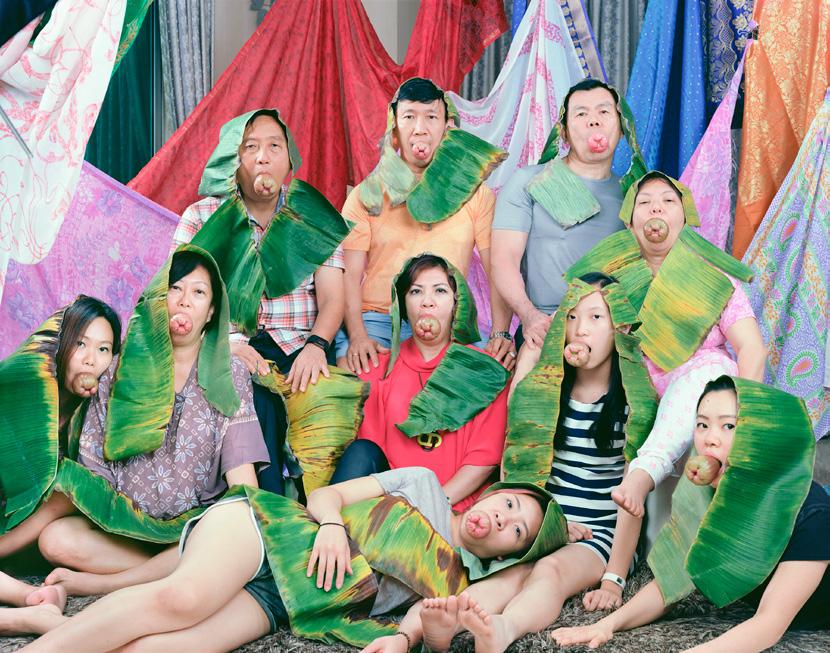


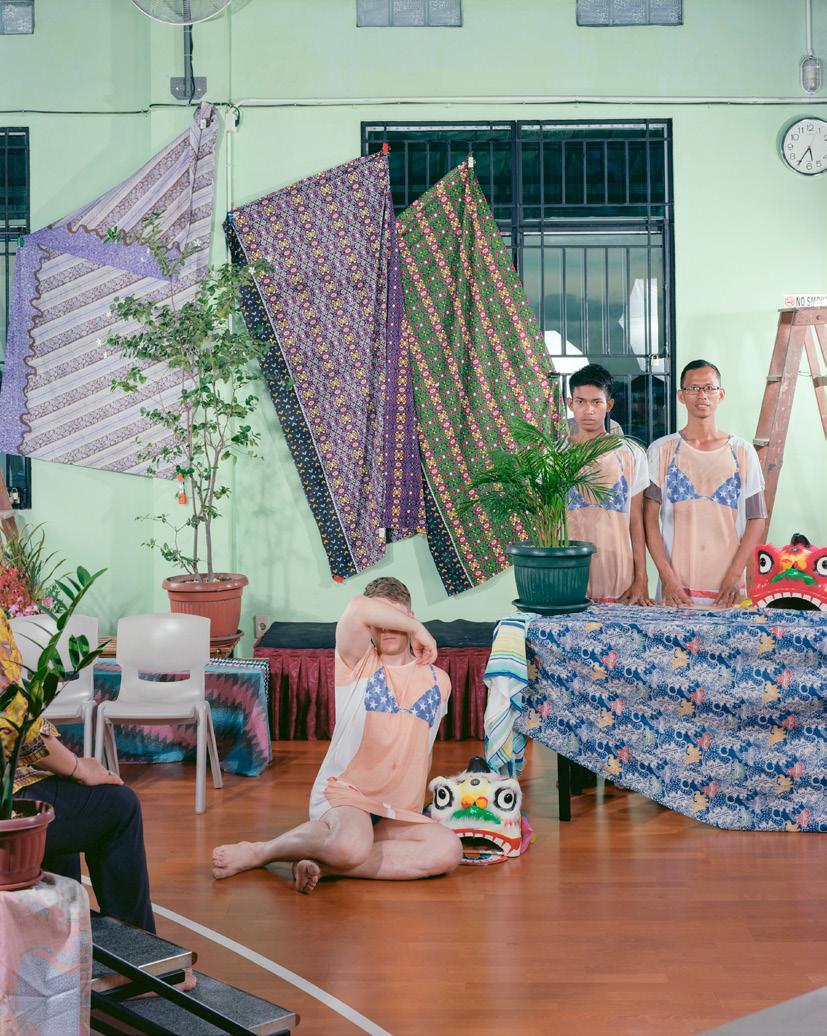
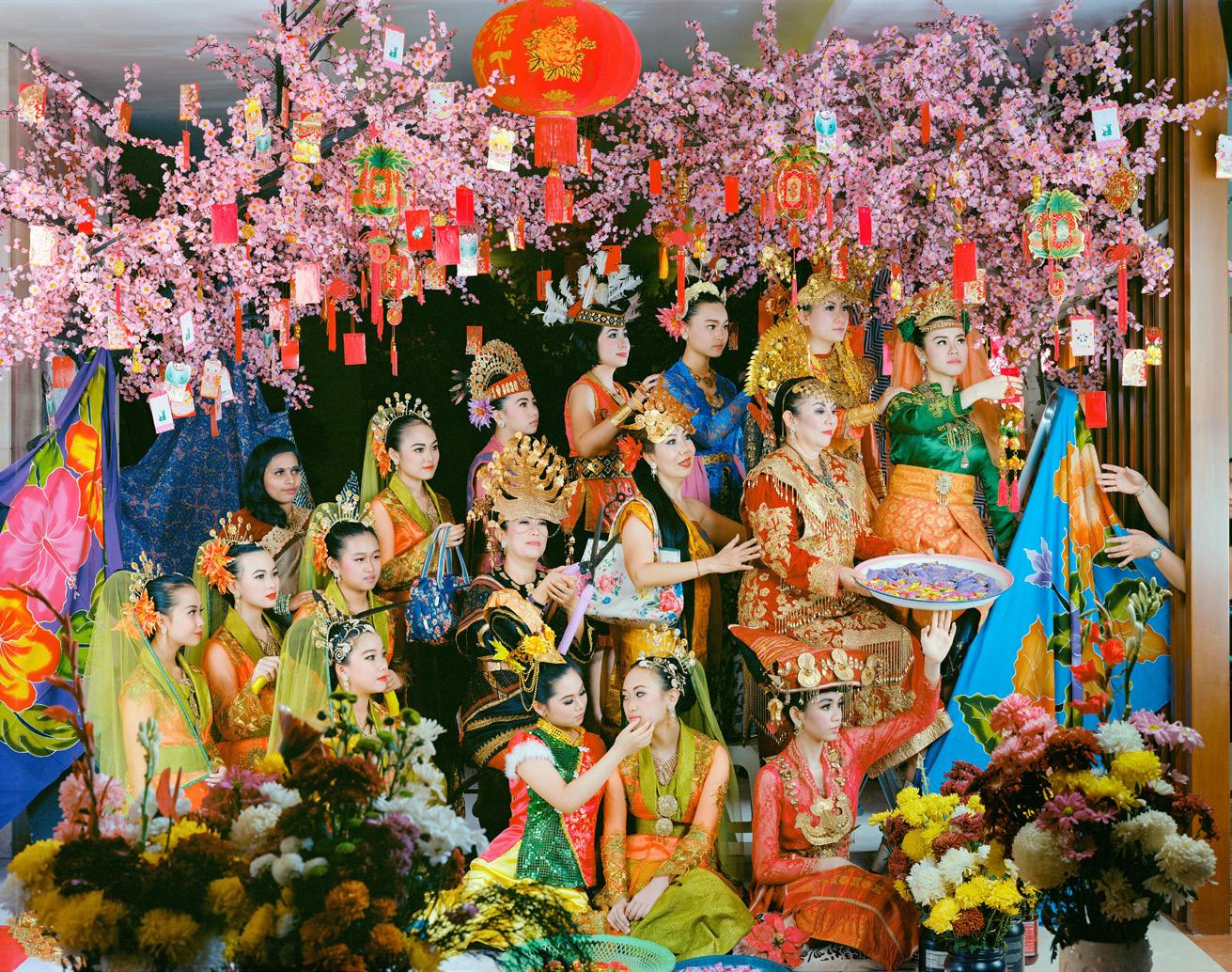
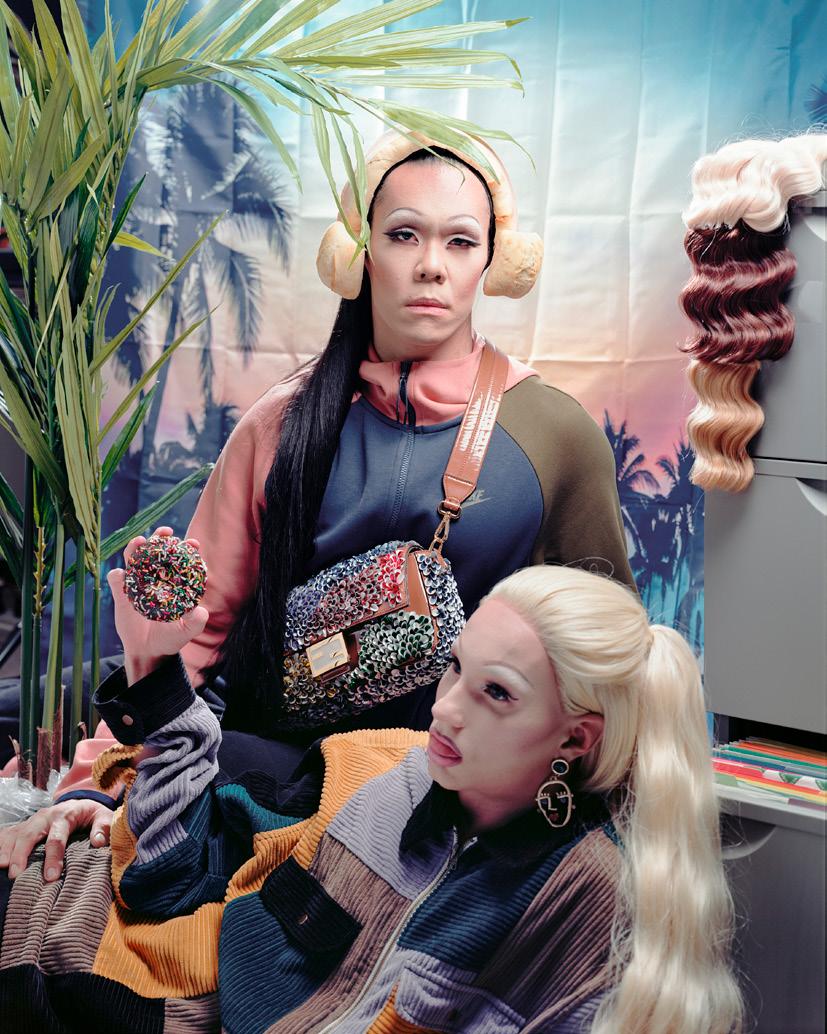

KALEV ERICKSON
The Greatest Show on Earth

59

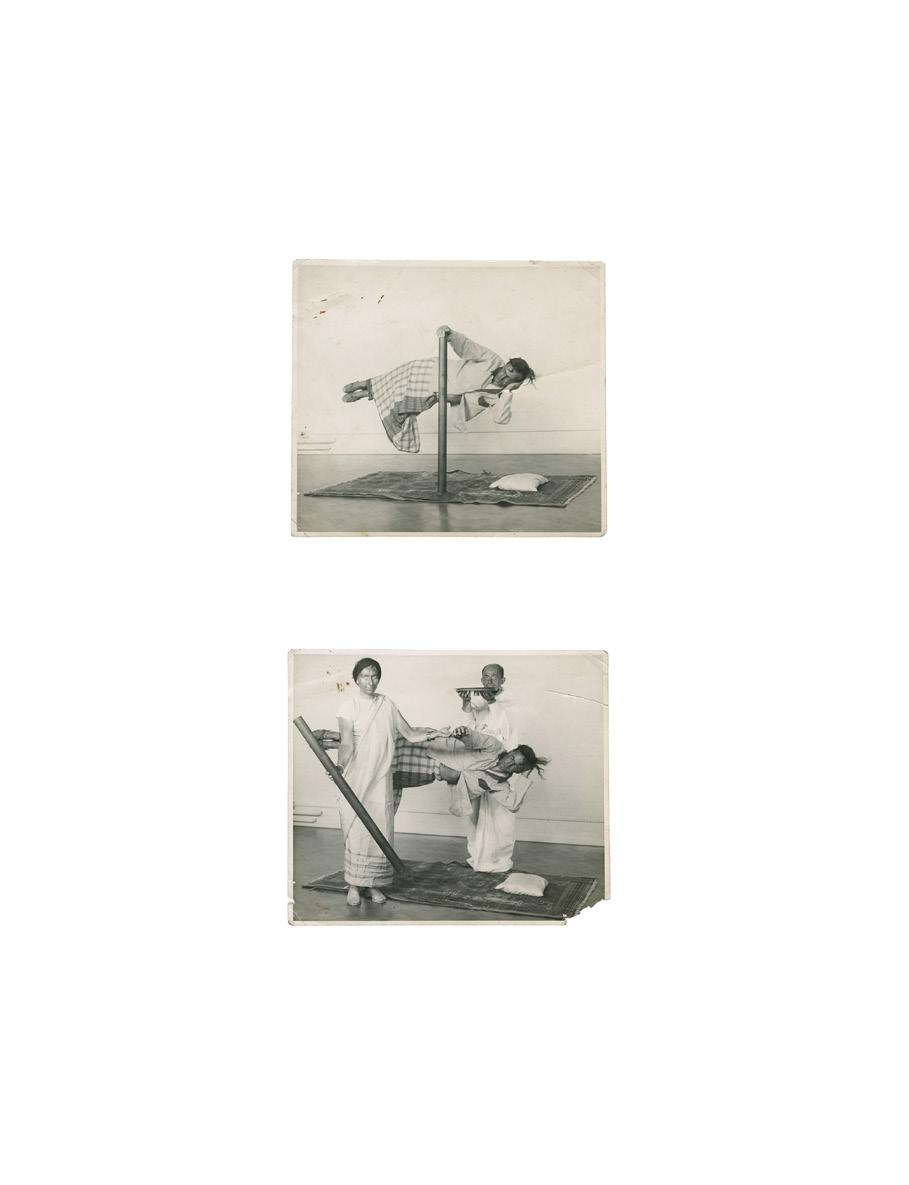
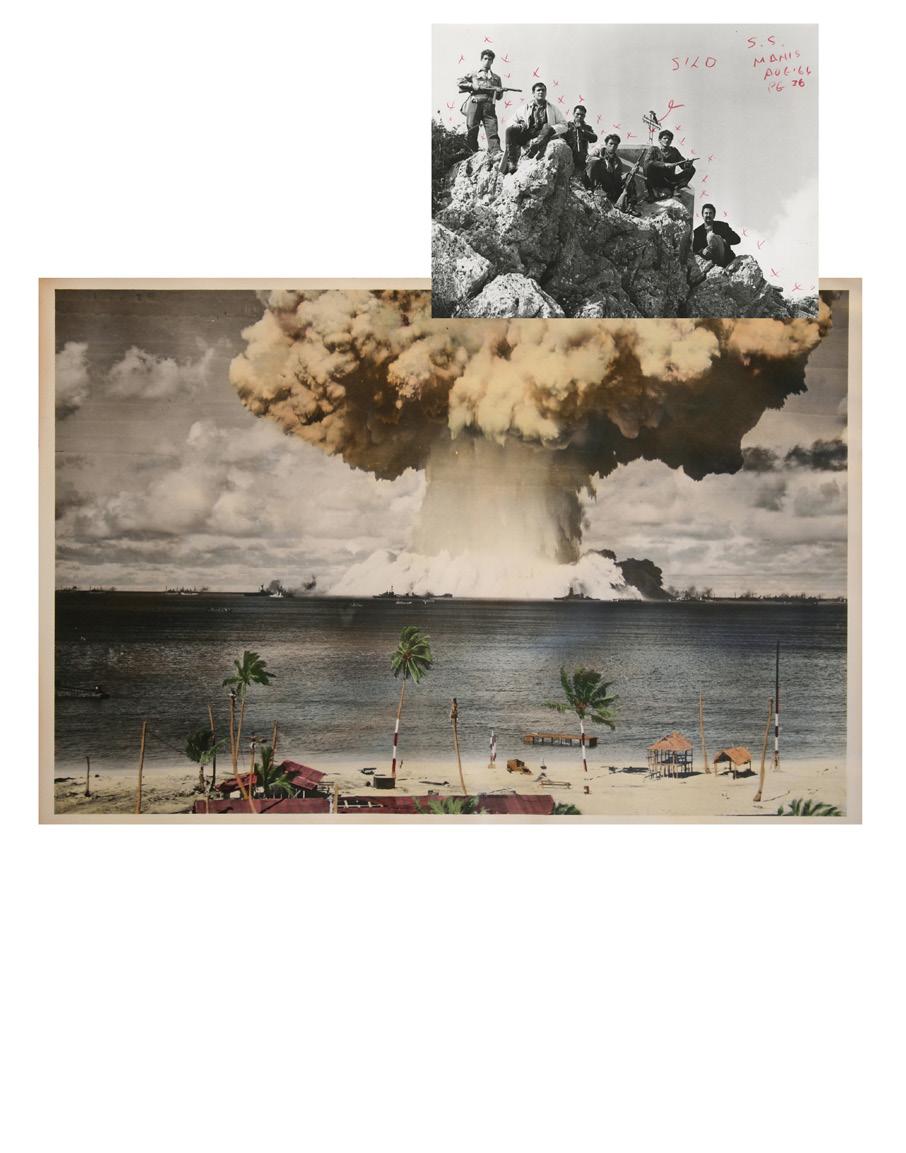


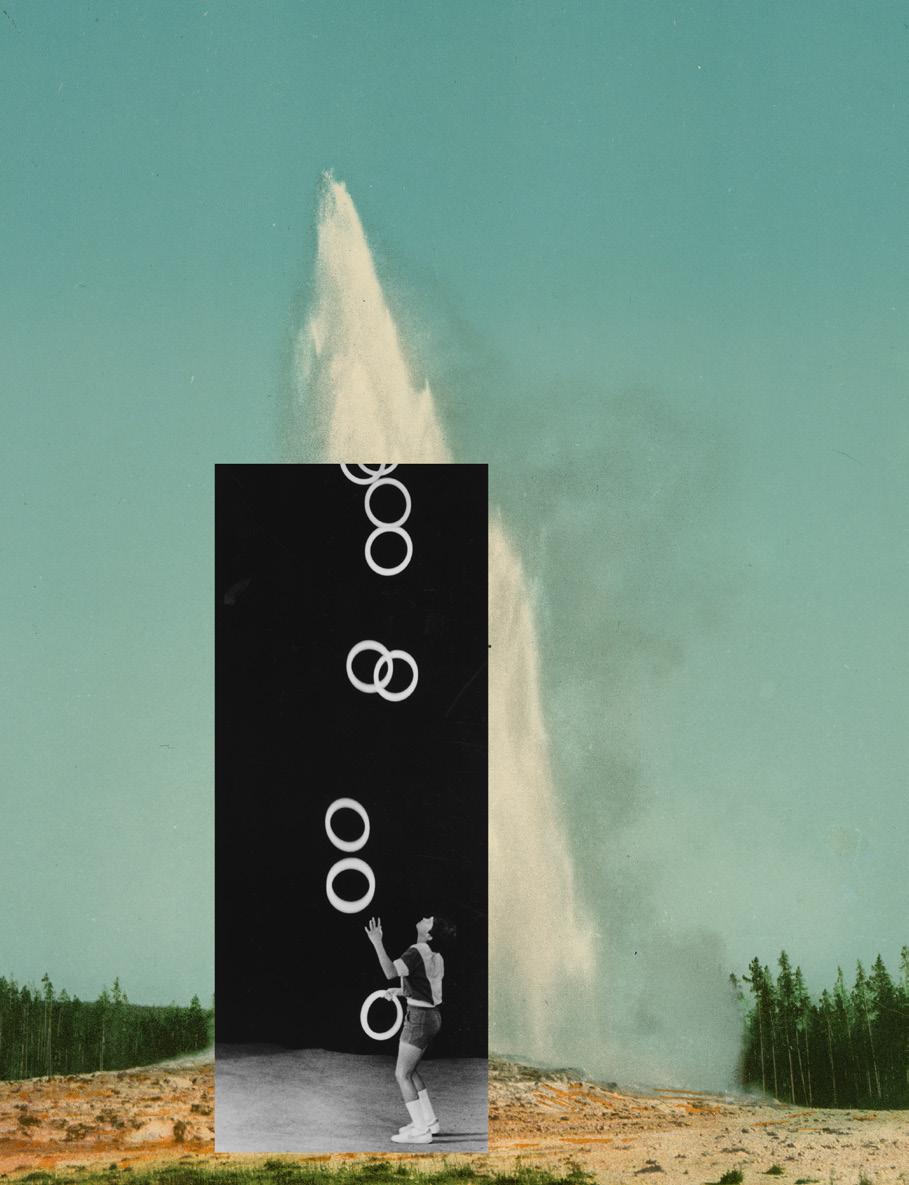
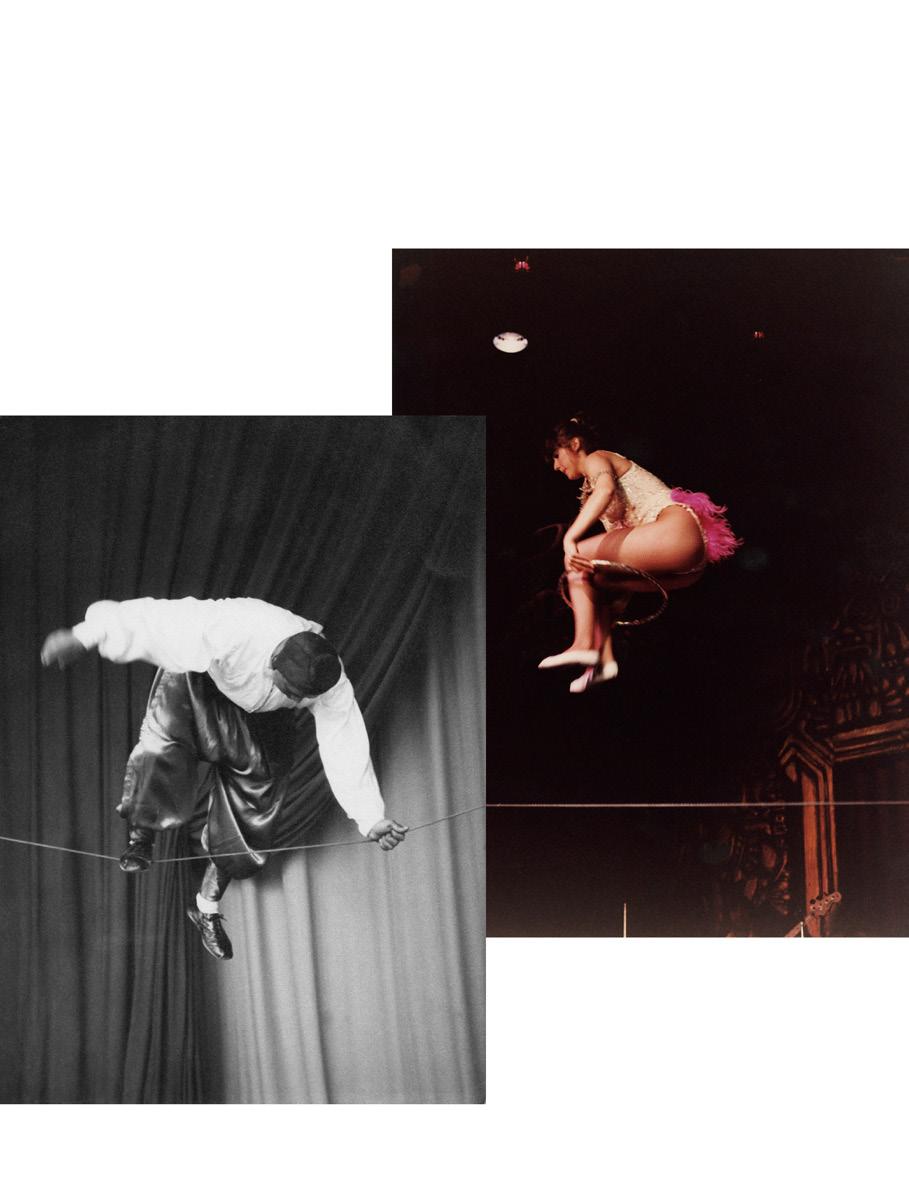



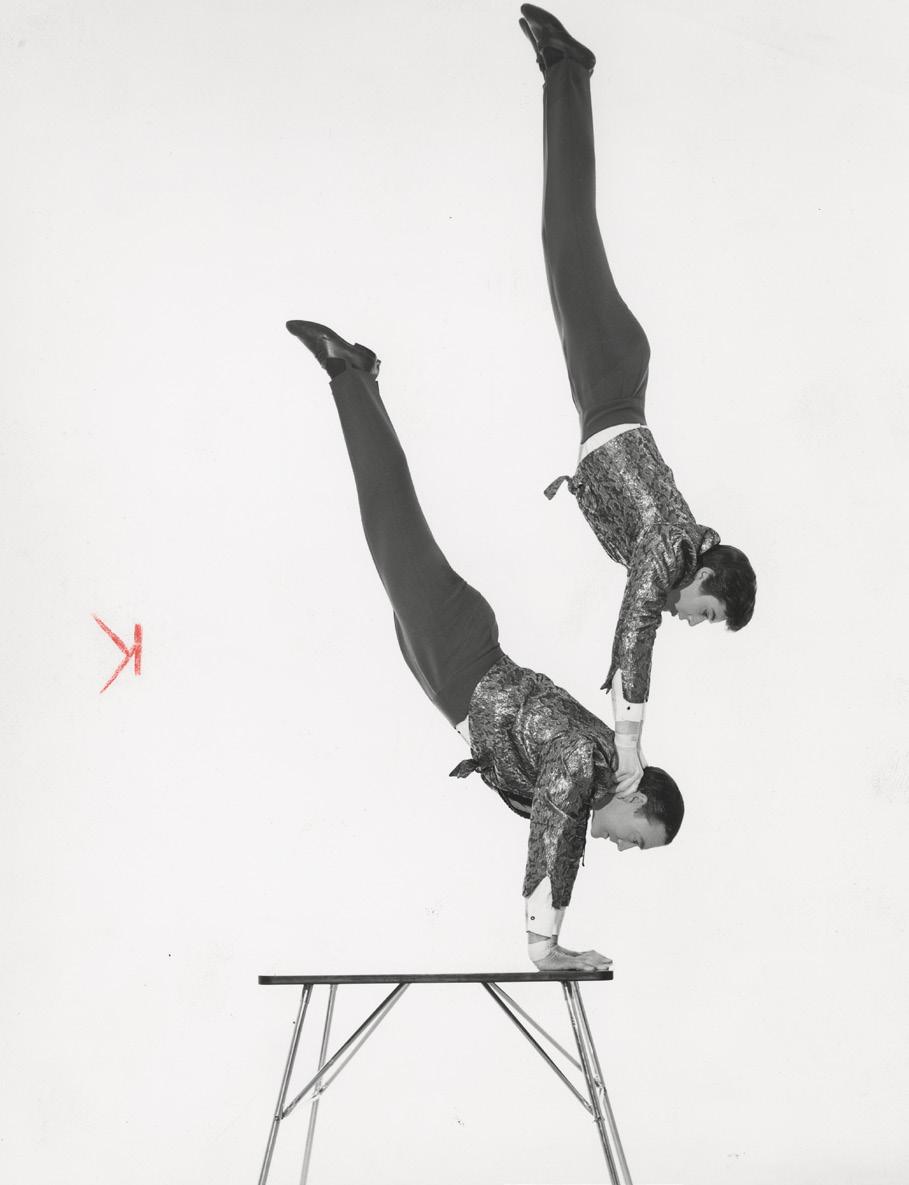

The Greatest Show on Earth
P.T. Barnum the 19th century circus impresario, and one of the greatest curators ever, was once heard to comment, ‘All the world’s a stage and life is a bloody circus’. No one knows for sure what he meant, but it seems in keeping with the spirit of Kalev Erickson’s The Greatest Show on Earth, which was exhibited at Photo España in 2018 as El mayor espectãculo del mundo and celebrated as Issue 13 of the Archive of Modern Conflict Journal AMC.
Photography has had to deal with the idea of spectacle almost since its invention. Ever more so as shutter speeds increased, and capturing the action shots of weird and wonderful events became a major thread in reportage. Now we have all become vicarious participants in the commercialisation of that ‘hold your breath’ moment.
The big top, that circular marquee of dreams, that disordered roundhouse has the most ancient of roots: the Greek and Roman amphitheatres where plays and games enthralled their audience. The life and death performances of gladiators evoked many of the same emotions as the
circus of the 20th century. Exploring the relationships between humankind and the rest of the animal world was a key feature of both. The incipient violence captured attention. A dangerous spectacle will most often transform the onlookers into a single organism. Sharing of fear, passion, hope and relief becomes addictive and acts as a chemical trigger in our brains. Agony and ecstasy have been shared by crowds and mobs since crowds and mobs began. This union gives us release from the constraints of our own individuality. We become one with each other.
Sexualised morphologies and narratives are intimately linked with a wide spectrum of spectacle. The Greatest Show on Earth doesn’t minimise this aspect and instead plays to the populace. Scantily clad bodies hanging upside down or flying through the air, squirting geysers, atomic bombs, ladies taming lions, speaks volumes about the metaphors in play. Spectacle and audience become complicit and co-dependant. It is interesting to note the dolphin training image; Erickson
believes that for years he has been pursued by libidinous extra-terrestrial dolphins.
Ritualised spectacle goes back further than the ancient world where Apollo and the trapeze artists forged a lasting duality with the wild anarchic clowns of Dionysius. Sex, and just as importantly, business are embedded in this rich and complex history. The animal and insect kingdoms are brimming with ritualised display. No doubt the dinosaurs had their own theatre. Erickson, with a deft touch, has massaged the surface of the phenomena. All we need to do is suspend belief. Not really a tall order. We then become player and performer in this magically created adrenaline rush that will transform our consciousness. Whatever else are photography exhibitions for?
— Text by Timothy Prus
Playgrounds
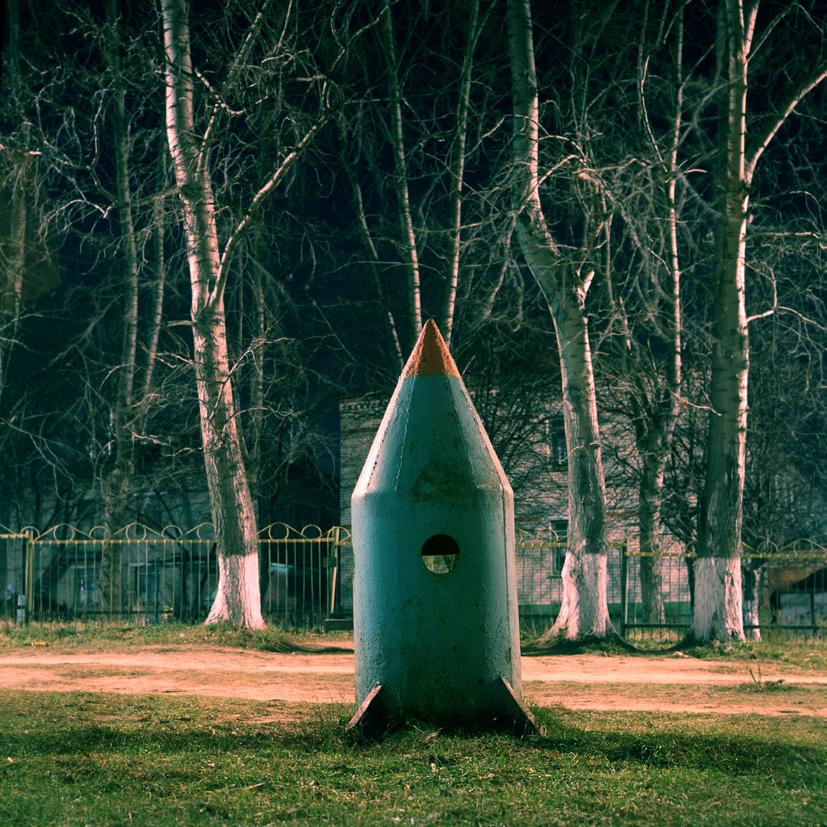
72 73
KALEV ERICKSON IVAN MIKHAILOV


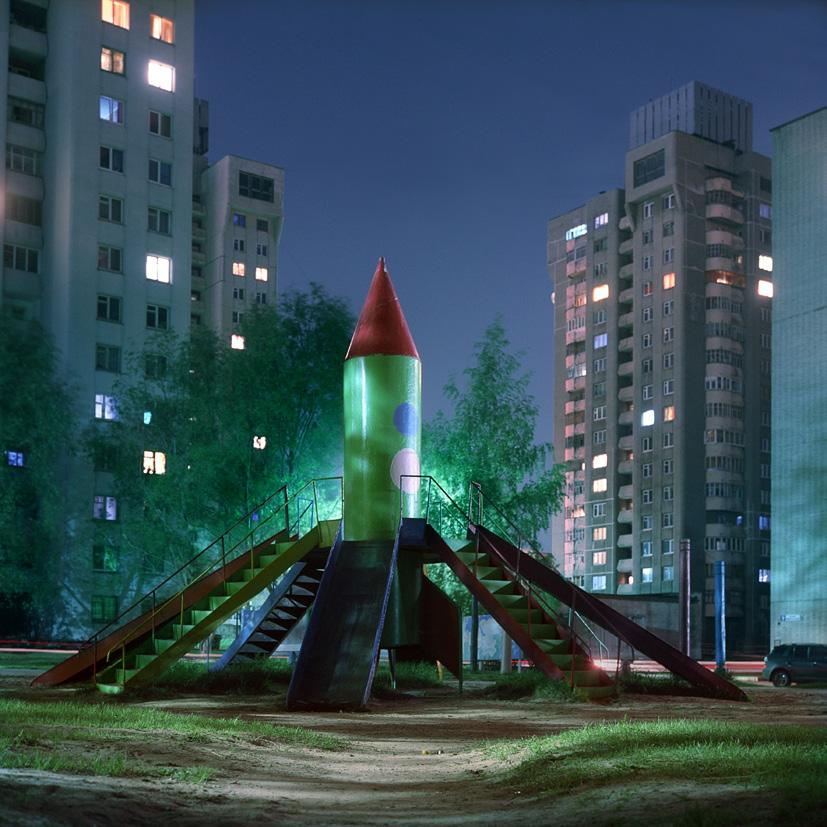
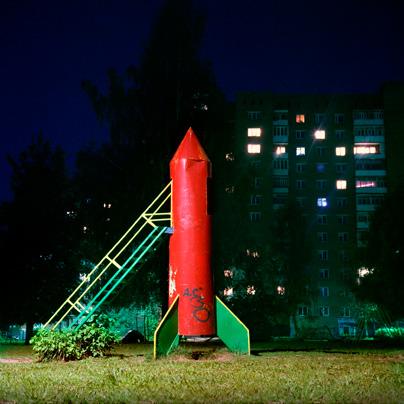


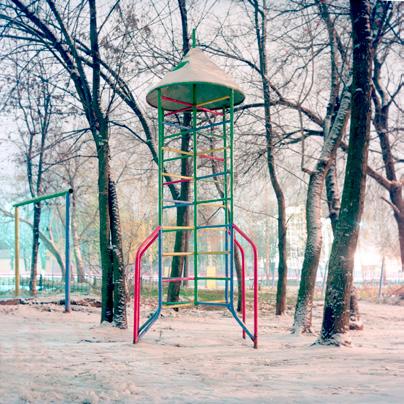

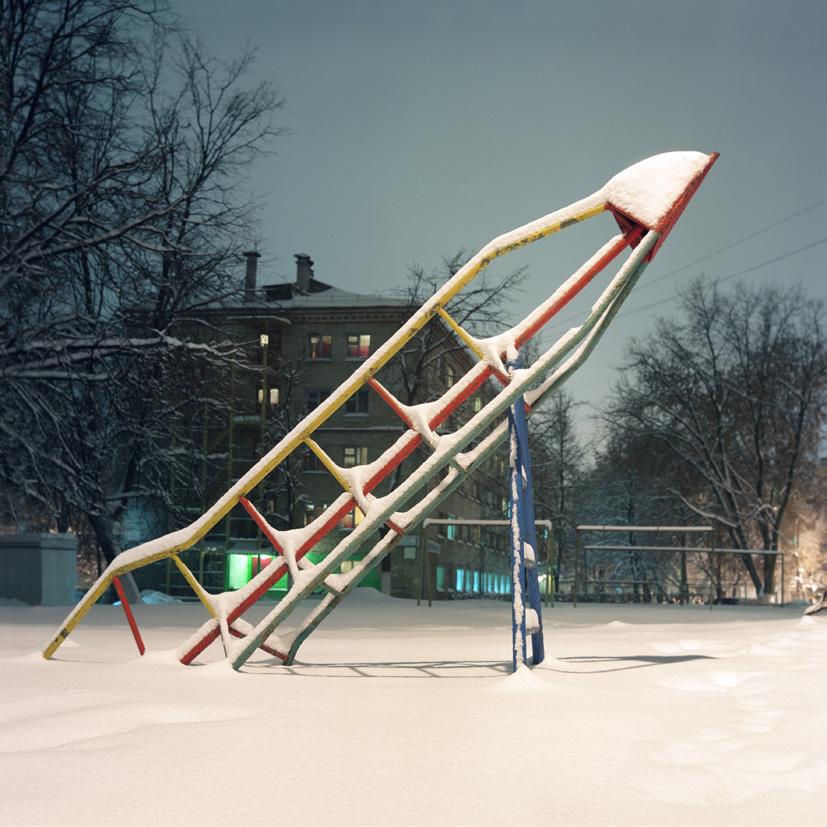
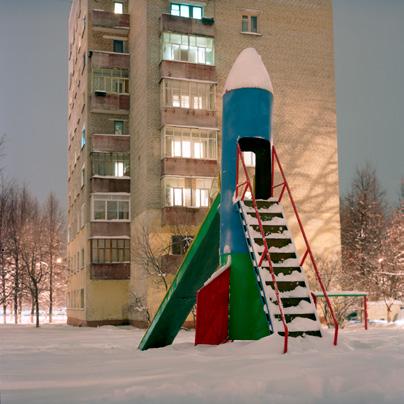


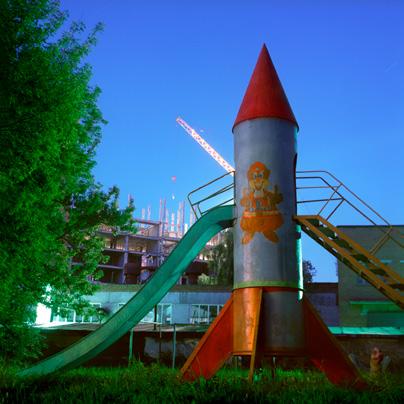
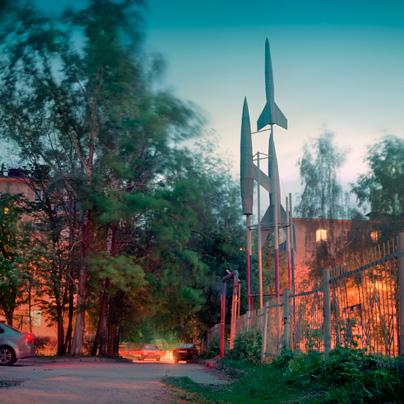
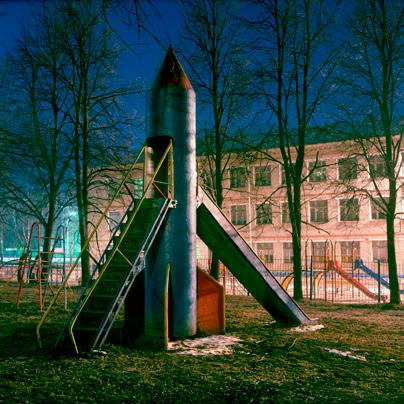
Playgrounds
Looking through the images of playgrounds by Russian photographer Ivan Mikhailov, it’s hard not to feel a slight tingle of nostalgia. It takes you back to childhood, when the world was small and usually confined to a couple of blocks yet limitless like the possibilities of life stretching out ahead. Back then, play transformed everything: sandpits and clunky metal constructions of local playgrounds transformed into far-away lands where adventures unfolded every afternoon. At the same time, Mikhailov’s Playgrounds offers more than one type of time travel: it’s also a journey into the history of Soviet Russia, where even child’s play was shaped by grand utopian visions.
Ivan Mikhailov was born in 1981 in Novocheboksarsk, a town on the southern bank of the Volga River, just over 600 kilometres east of Moscow. Growing up, he remembers the rocket-shaped slides and playhouses. He was one of many boys and girls inspired by Yuri Gagarin and Valentina Tereshkova, Soviet cosmonauts who were the first man and woman in space, in 1961 and 1963 respectively. In the minds of millions of Soviet kids, space travel was not just a distant fantasy but a viable career option. Since the 1960s, space dominated
children’s books and cartoons, and the broader Soviet propaganda; building communism was a mission not confined to the limits of our planet. These stories were reflected in urban planning through several space-themed playgrounds for kids. In Novocheboksarsk alone, Mikhailov spotted around 40 playgrounds.
If you have ever visited a Russian city, you will have noticed that the structure of residential areas is frequently the same: a children’s playground with a few trees standing at the centre of a housing estate, surrounded by towering apartment blocks. The glow from their many windows can be spotted in Mikhailov’s photographs: evidence of cosy day-to-day life juxtaposed with the almost otherworldly charm of cosmic playgrounds. Shot on medium format in a very static manner, these photographs are a testament to the private side of Russian life, but also its history, shaped by the grand, but also standardised way of thinking. If a relatively small town of Novocheboksarsk has more than 40, it’s hard to imagine how many of these tin rockets are scattered throughout such an enormous country.
At the same time, Playgrounds is much more than just a documentary project.
There is a certain magic to how these Earth-bound rockets look under the luminous night skies. A lot of them are now rusty and dilapidated, but previously possessed lightness, aspiration and dreams their creators wanted to pass on to the future generations. Notably, there are no people in the photographs, which places these constructions in the realm of imagination, separated from a boring mundanity.
After the collapse of the Soviet Union in 1991, many things changed, including stories and dreams. Bringing communism to the interstellar civilisations was not a priority anymore. These playgrounds are among the many relics left behind by Soviet utopian thinking, alongside modernist architecture and Lenin monuments. The rocket-shaped slides might soon be replaced by something else, signifying the country’s change of aspirations, but for now, they remain a part of children’s play and a crash course in history.
— Text by Anastasiia Fedorova
Playing System the
Essay by Ben Burbridge
80
IVAN MIKHAILOV
81 FOCUS ESSAY
Advances in machine learning and AI mean computers are becoming better at ‘seeing’ the visual content of images. Online interactions with photographs are subject to constant algorithmic surveillance, allowing everyday behavioural patterns to be identified, and likely future behaviours predicted, in ways that exceed the cognitive and perceptive capacities of any individual or group.
Digital media scholar Seb Franklin links the wider epistemic regime in which computational photography is enmeshed to a reconceptualisation of ‘the human as a computing machine’: ‘cognition, attention, communication and creativity’ are increasingly assumed to be ‘fully intelligible and representable as digital systems’. Sociality is understood in quantitative and statistical terms. Individual subjectivity is subsumed into datadriven probability models. Discussing social media platforms, artist Erica Scourti observes how, ‘algorithms ... do the number crunching to be able to predict what you might buy, and hence who you are, not because anyone cares about you particularly, but because where you fit in a demographic ... is useful information and creates new possibilities of control.’
Commentators sometimes query the role of the visual, or visually bound thinking, when approaching the social and political implications of computational
photography. An essay by Trevor Paglen suggests we may have to set aside ‘traditional visual theory’, along with our ‘meat eyes’, in order to truly appreciate what is at stake in an era of machineseeing. But if an engagement with photographs onlyasimages limits our understanding of photography as data, then does any parallel effort to attend to photography only as data risk reversing the current imbalance? Andrew Dewdney believes that the ‘global condition of the algorithmic image continues to function within the field of representation, precisely because it remains as yet the humanly understandable surface of communication operating within common sense’. We need ‘to understand the interface between mathematical and cultural coding’.
Images make data legible to humans as something other than data. The resulting interactions make humans legible to machines. Perhaps the most pressing challenge is to reverse that dynamic, using the content of images to develop the forms of critical legibility through which the operations of the network become clearer to humans. By recognising the types of images we are encouraged to upload and share, along with the forms of behaviour it is assumed our interactions with photographs will exhibit, can we also begin to understand thelogicofthesystems in which human sociality is entwined? By doing something that looks like, but is nonetheless significantly different from, those prescribed behaviours, can we start to play with the systems in ways that remain invisible to power? My colleague Micheal O’Connell describes this as ‘artificial stupidity’.
The pictures in A.M. Worthington’s 1908 book, A Study of Splashes, provide an early example of highspeed flash photography. Sequences of photographs depict a ball bearing as it descends into liquid surfaces and the delicate forms that result. Pictures are arranged in chronological order from left to right, sometimes from top to bottom, encouraging western audiences to ‘read’ them in much the same way they would a written text. One sequence, now held in the Science Museum Collection, London, consists of 23 photographs: two documenting the ball bearing as it falls; 21 depicting the splash as it forms, breaks, a jet rises, falls, and creates further, smaller splashes.
The main challenge faced by Worthington was how to make a series of very short exposures in quick succession in order to photograph the same fastmoving object multiple times. 20 years earlier, Eadweard Muybridge had produced sequential studies of human and animal locomotion using a bank of cameras with fast shutter speeds triggered by trip wires. His contemporary, Étienne JulesMarey, chose instead to use a rotating disk containing a small hole. A single exposure was made every time the aperture passed the camera lens, depicting figures multiple times on a single photographic plate as they traversed the space in front of the camera. The comparatively small size of the object that Worthington wanted to photograph, and the level of detail he desired, made similar methods untenable.

Machines today, we are told, can perform an increasing number of tasks almost as well as, often much better than, human beings.
‘Instantaneous Photography of Splashes’ Spark photographs of splashes by Arthur Mason Worthington, FRS, circa 1900 © National Science & Media Museum / Science & Society Picture LibraryAll rights reserved 83 82 PLAYING THE SYSTEM FOCUS ESSAY
Instead he worked in darkness with the camera shutter open, using the flash produced by spark discharges to create very short exposure times. It was not yet possible to produce a number of flashes in quick succession, however — this was a much later innovation normally associated with the stroboscopic photography of Harold ‘Doc’ Edgerton. Worthington opted instead to restage the same experiment multiple times, making a single photograph on each occasion and timing the spark to occur fractionally later and later as the process progressed. The series in the Science Museum Collection does not depict the uninterrupted descent of a ball bearing and the forms it created as the sequencing of the images encourages viewers to assume. It represents the ball bearing descending on two different occasions, and 21 different splashes, arranged in such a way that we ‘read’ them as constituent parts of the same event. The singularity of the event is a fiction, presented as though fact.
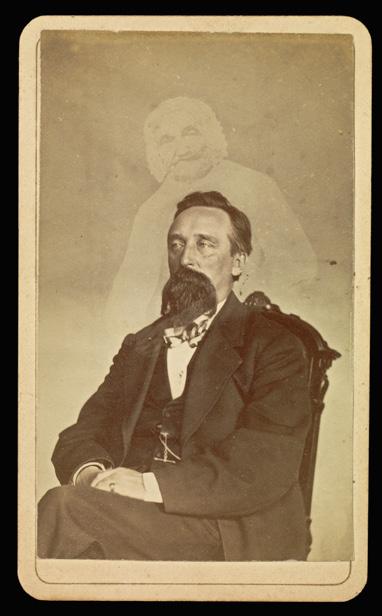
There are at least two ways to think about Worthington’s visual deception. The exactitude with which he went about the reenactment speaks to what science historians Lorraine Daston and Peter Galison identify as the virtuous character ascribed to mechanical objectivity in the latter 19th century. The increasing importance attributed to machinemade recordings in scientific investigations was driven as much by a puritanical distrust of the subjective distortions associated with human observers as it was a faith in the capacities of machines. While Worthington could not make his photographic sequence of a single event mechanically, he went to extraordinary lengths to internalise the operational logic of the machine: controlling constants and variables, timing each exposure with great precision, repeating the procedure to compensate for mistakes whenever required.
Alternatively, we could focus on the fact of the deception itself; on all that the camera does not see, but which was nonetheless crucial to the production of the series. The exposures are not separated by a fraction of a second, as their presentation encourages us to assume, but presumably by several minutes, as Worthington rearranged the apparatus, prepared the camera, waited for the liquid surface to still, all to produce an illusion. His mimicry involved thought and imagination.
The second possibility aligns Worthington’s photographs with a curious strand of early investigative photography, which utilised the assumed objectivity of the camera to veil or obscure more creative interventions. Photographic historian Marta Braun suggests that Muybridge misled viewers about the timing, order or content of up to 40 percent of his plates. On at least one occasion he combined elements from different picturetaking sessions and passed them off as though components of a single event. Where Worthington was responding to the irrevocable limits of the technology available at the time, it seems that Muybridge was lazy and/or conscious of the expense involved in restaging
PLAYING THE SYSTEM
an entire sequence, as even a single smashed plate or faulty shutter would have demanded.
Spirit photography pushed that logic to captivating extremes. Portrait sitters at William Mumler’s New York studio were reportedly awestruck when their photographs contained a translucent apparition. The photographer encouraged them to believe this to be the ghost of a departed loved one, ‘visible’ only to the camera, not the result of deliberate double exposure. Mumler played with assumptions regarding the production of photography, along with audiences’ lack of familiarity with a novel technology, to obscure actions through which the photographs actually came into being. This proved to be a highly lucrative venture, particularly in the aftermath of the American Civil War when the desire to connect with departed loved ones reached an understandable peak.
Curator Corey Keller has written about the disorientating impact that scientific photography of hitherto unseen phenomena had on 19thcentury audiences. To see the inside of a human hand in xrays, rapid movement frozen as still images in highspeed photography, minute organisms enlarged in exquisite detail by photomicroscopy was ‘exhilarating, novel ... and fundamentally disturbing’. As audiences had no way to verify the truth of what the photographs were purported to show, reception involved a leap of faith. This fuelled photography’s associations with wonder, even with magic, sparking the imagination of early audiences. It also created room for imaginative forms of illusionism, fiction, and trickery. The changing relationship between these factors, and the meanings it has been assigned, provides an interesting route through the histories of photography.
Muybridge’s work provided a major source of fascination for conceptual artists in the latter half of the 1960s, who were drawn both to the potential of its gridded
format and to those ways in which the serial presentation of images could deceive. SelfBurial by Keith Arnatt is a series of nine photographs in which the artist appears to gradually descend into a pile of earth. Hollis Frampton and Marian Faller’s Apple Advancing (Variety: Northern Spy) shows an apple that seems to move progressively closer to the camera, as though capable of moving independently. Exploding Paintbrush, a 1975 diptych by Robert Cumming, depicts a paint brush suspended in midair; then again with damaged bristles and surrounded by lively splatters, as though it had exploded spontaneously.
Speaking in 1977, Arnatt explained how, at that time, he had ‘become aware of the unreliability of photographic evidence and began to play with that feature’. He ‘felt that what a photograph could not tell or show might be just as significant as what it could.’ Artists’ playful science fictions opened up what art historian David Alan Mellor calls ‘a domain of comic absurdity inside the technique of willed amateur factualism’.
The production and reception of the 19thcentury images makes sense in the context of a wider belief in machines, both in terms of a capacity to negate the distortions of human subjectivity and to surpass the limits of humans’ own perceptive apparatus. When investigators such as Worthington, Muybridge and Mumler played with the operational logic of mechanical objectivity to create their convincing fictions, their work traded on, and in some important ways reenforced, the wider epistemological framing of machines as superior to humans.
Artists in the 1960s, by contrast, used similar tactics to reassert the imaginative and cognitive capacities of a subjective human presence, one capable of recreating movement based on a series of still images, but also of recognising signs of mimicry and play. The sentiments that underpin that work speak, in turn, to a wider disdain felt towards the rationalisation of the
As audiences had no way to verify the truth of what the photographs were purported to show, reception involved a leap of faith. This fuelled photography’s associations with wonder, even with magic, sparking the imagination of early audiences.
85 84 FOCUS ESSAY
William H. Mumler (American, 18321884) John J. Glover, 18621875, Albumen silver print. Digital image courtesy of the Getty's Open Content Program
work place and the monotony of massproduced consumer culture. It is a high cultural manifestation of what sociologists Luc Boltanski and Eve Chiapello describe as an ‘artistic critique’ directed at the ‘poverty of everyday life…the loss of autonomy, the absence of creativity ... the different forms of oppression in the modern world.’
Both the tactics deployed and the specific photographs critiqued indicate an important shift in society’s relationships to photography. By that time, the medium was more than a century old: its systems were better understood as a result of increased exposure and lived experience. The hopes previously invested in machine seeing had started fade, particularly once photography was enlisted as a vital component within consumer culture more broadly. Due to its uses in advertisements, celebrity portraits, as a commodity consumed by the suburban middle classes, photography’s mechanical reproduction had, in the words of art historian Blake Stimson, ‘become camp’. The medium was robbed of its investigative potential, its political promise, and its wonder. Artists like Arnatt and Cumming project a resulting scepticism back in time, towards the earlier revelations of photographic history and all they appeared to promise. High speed photographic series are no longer exhilarating and disturbing, but programmatic and thus capable of malfunction.
In more recent times, photography’s mass practice has been operationalised anew based on the logic of an attention economy. Photographs are no longer only images that encourage us to buy stuff, or an opportunity to make images that we buy. They provide the basis for social interactions that are surveilled, harvested and in various ways traded by powerful entities, including the state and multinational corporations. What economist Shoshana Zuboff calls ‘surveillance capitalism’ involves ‘the unilateral claiming of private human experience as free raw material for translation into behavioural data’.
Recent analyses of relationships between the politics of the network and political resistance often converge around a similar set of principles. Robert Jackson suggests algorithms be understood not as ‘monolithic, characterless beings of generic function, to which humans adapt and adopt’, but as complex, fractured systems to be negotiated and traversed.’ We must creatively navigate computational systems and develop different ‘modes of traversal’. Finn Brunton and Helen Nissenbaum describe the potential of ‘obfuscation’ — a tool ‘for evasion, noncompliance, outright refusal, deliberate sabotage, and use according to our terms of service’, reliant on the creation of false, deceptive and misleading content to create strategic cover. For Caroline Bassett, metaphorical communication possesses important potential: an encoded meaning, ‘produced by, but nevertheless separate from and irreducible to the truth and the lie it combines’, it is the form of language ‘furthest from coded instruction.’
Those perspectives cast interesting light on contemporary artists’ engagement with networked image culture. Think, for example, of Ed Fornieles’ 2011 project Dorm Daze, a Facebook sitcom set at the University of California. It used information ‘scalped’ from the existing social media profiles of Berkeley students as inspiration for a cast of characters, whose lives were performed on Facebook by the artist’s friends according a semiscripted narrative. Over time, the characters deviated from stereotypes: a basketball star became involved with a violent drug gang; an emo and a jock explored the joys of sadomasochistic sex; a yogalover became involved with Occupy and blew up a bank; the father of a rich kid was discovered to be harvesting human organs in Cambodia.
The requirement to present a single, stable identity is essential to the effective monetization of our online
behaviour. Even when the socially mediated world is understood to be inherently performative, it is the consistency of individuals’ performances in particular contexts or situations that allows sociological patterns to be identified, specific demographics exposed, common desires to be exploited. Fornieles notes how his absurdist fiction ‘pushed against the algorithmic environment within which it existed (the numbers, the data that feeds Facebook and other social media), turning analytics into a redundancy. Adverts and suggested friends become repurposed as scenery or props to a new fiction.’
Ingrid Hoelzl and Remi Marie explain that the Google Street View ‘database functions as a navigational tool only to create another database of user mobility patterns, preferences and purchasing behaviour, feeding back into the first with unprecedented

possibilities for commerce and control.’ Art projects based on reframing Street View photography by Jon Rafman and Michael Wolf result from a curious and unstructured ramble, following no particular logic beyond an intuitive sense of what makes for an intriguing image. This is not the case with projects by Mishka Henner or Doug Rickard, which adopted a more structured approach based on an interest in economic dispossession (Henner focuses on roadside prostitutes in Europe, Rikkard on poverty in the USA).
Guy Debord saw the modern metropolis as a manifestation of capitalist domination, designed to ensure the smooth flow of workers and consumers in tightly scripted daily rituals. It was by allowing ourselves to ‘be drawn by the attractions of the terrain and the encounters’ during unplanned explorations that we might resist those circumscribed behaviours. Rafman
87 86 FOCUS ESSAY
PLAYING THE SYSTEM
Jon Rafman, 2609 Mission Street, San Francisco, California, USA , 2009, from the series Nine Eyes of Google Street View Courtesy of the artist.
and Wolf seek nothing other than an interesting image, applying the logic of the dérive to an exploration of Street View. Henner and Rickard maintain a more systematic approach — it is not hard to see how the data generated through the production of their series could find realworld instrumental uses. The projects’ interest as art may be their downfall as templates for traversal.
Image recognition software requires significant input from human beings to learn how to ‘see’ the things that we do. Different objects must be tagged, one object differentiated from another, information entered in ways legible to machines. It is usually lowpaid casual workers, often Amazon Mechanical Turks, who perform the work of looking at and describing thousands upon thousands of photographs. A ‘speculative Prezi’ performance by Sebastian Schmeig imagines a world in which the global precariat recognise the importance of their labour to the systems it services, and thus the potential of their actions to shape the future. They train Google’s algorithms to identify photographs of aubergines as the British singer Chris Maloney; pictures of Donald Trump as depicting terrorists. This is art as an affective technology.
Imagine what might be achieved were this playful form of sabotage, largely invisible to power, was performed en masse and at scale. A world where Google books became unsearchable, facial recognition software could no longer recognise faces, the data harvested by platforms was rendered useless to advertisers, driverless cars started to crash.
Would this be enough to cause profitable economic models, premised on the exploitation of workers in a gig economy and the unpaid labour of social media users, to malfunction? If so, then should we also consider the sorts of world that could emerge from the chaos? Is it enough to play with the systems we’ve already got? Or should we also think about how to build new ones?
Playful Appropriation and the Archive
Essay by Mariama Attah
89 FOCUS ESSAY
88 FOCUS ESSAY
As a tool, play is used both in terms of uncovering and intervening with the found material, as well as in the sense of bringing a collection of images to life in a new, contemporary context beyond its original scope. In both cases, by virtue of the found images having been created and collected by unseen hands or unknown motivations, a level of imagination and boldness is needed to invade the archival space. This is in response to a freedom that potentially wouldn’t be present if working with firsthand images and awareness of the originator.
The treasure hunting, unlocking stories, and tracking down long forgotten bodies of work activates the archive and transforms it from a passive repository, outside of time, into an active site for reengaging and reactivating images. This allows for new readings of the work, as well as inserting second hand ideas into artistic material for inspiration and appropriation, whether practicebased or personally driven.
In examples given here, and in portfolios throughout the magazine, it is often an artist or curator who becomes the keeper of a found archive. They play the role of explorer, interpreter and owner of the newly found collection, as well as its translator. The original desire for collecting and shaping an archive is now overlaid with a second set of readings, meanings and intentions. Acting as interpreter, the new keeper of the collection is imbued with a sense of ownership and possession, no matter how tenuous or unrelated the content may be to the discoverer at first glance. Without this playful intervention, the archive faces an uncertain future of remaining unearthed — a type of relegation.
Artistic archival appropriation works on many levels. One of these being almost automatic and unavoidable, taking place from the moment an archive is discovered and ‘claimed’. In the process of changing hands, the archive moves from one set of experiences, knowledge and intentions into a different realm by dint of its new context. This new ownership is often evidenced by playing on the surface of the image, a performance that takes the physical photograph as a playing field for creativity and reinterpretation. Painting, scratching, mark making, breaking down and degrading are all elements used to detach a body of images from its former owner and subsequent state of inaction. Alternatively, this disassociation can be achieved through a careful (re)curation of the found images, rebuilding narratives with
these images already in existence. A found archive is a fixed space; it is no longer being added or attended to.
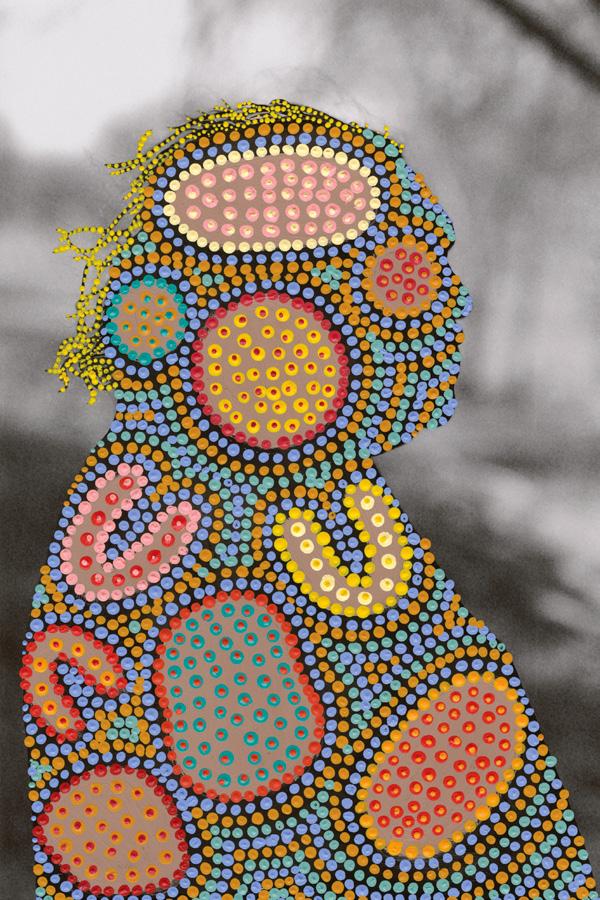
The connotation of the word appropriation can often be negative or undesirable, the suggestion being that an object has been taken from its original context simply to be used for its surface value without regards to its history. There is a farreaching legacy of colonialism and archives, working hand in hand. With motivations ranging from misplaced, and what could nearly be described as benign curiosity to racialised ideas of cataloguing and categorising, photography has been responsible for archiving people and cultural material with neat labels, often ignoring nuances or differences between groups of people. The act of taking a photo, and then storing it in an archive can in itself be an intrusive, disrespectful or damaging process. This runs in parallel to current debates on museums repatriating physical objects which possess cultural significance to the communities from which they were taken. From Easter Island statues — moai — which possess the spirits of leaders and ancestors, to shields used in the battle on the coasts of Australia, these objects have fallen prey to a devastating appropriation.
In the case of photographers appropriating imagery, the action of taking is accurate, but the disregard for history can be circumvented through play. Playing lifts these negative associations by resetting expectations, casting an irreverent, often lighthearted and well meaning feel to the revived material. Playing can be a disarming tool. It can be anarchistic and freewheeling — pushing boundaries to see what’s possible — or it can a more carefully coordinated affair of nicely colouring within the lines.
An impeccable example of a mindful approach is the project by Patrick Waterhouse, Restricted Images — MadeWiththeWarlpiriofCentralAustralia. Waterhouse combines collaboration, archives, play and photography to demonstrate a considered and considerate approach to working with and reinterpreting sensitive imagery. There are archives across Australia which have very limited access as viewing images of ancestors can often be a transgression. This leaves a huge amount of material undiscovered. Waterhouse worked with local Warlpiri artists in the Northern Territory of Australia to exert their autonomy over their own images. After spending years photographing people from the Warlpiri community, he handed back the images and asked them to
There is a certain thrill of the chase, or a rush of an unexpected discovery when renewing archives. Here, play becomes a key tool in activating, appropriating and animating this material.
91 90 PLAYFUL APPROPRIATION AND THE ARCHIVE FOCUS ESSAY Side Portrait Right. Restricted with Dorothy Napurrurla Dickson © Warlukurlangu Artists / Patrick Waterhouse
indicate their own censorship on the photos, blocking out identities and features, and highlighting their heritage using a traditional dot painting technique. The result is a colourful, conscious depiction of working with archives and sensitive material, using playful techniques to maintain respect and dignity.
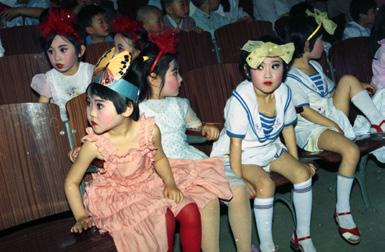
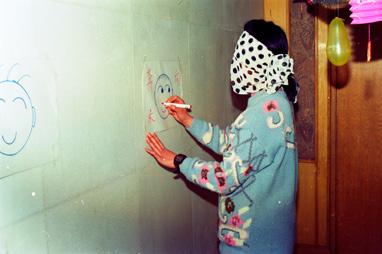


This reinterpretation moves beyond working on the literal surface of the image and widens its gaze to include the intersections of cultural understandings and ideas. Seen at these different levels, the archive is fundamentally changed through how the image is played with, whether surface or contextwise. The function is to provoke new meaning, whether by playful response or by encouraging new ways of understanding how to work with cultural material.
Approaching from another angle, Thomas Sauvin’s approach to creating and managing the Beijing Silvermine archive is a skillful and distinctive example of rethreading narratives. The collection has been ushered into being by Sauvin and his dedicated approach in saving thousands of rolls of film, purchased by the kilo, from a recycling plant on the outskirts of Beijing. Sauvin carefully sorts, scans and selects the negatives, adding them to a rapidlygrowing archive, now numbering over half a million photographs. A recent short clip on the Beijing Silvermine Instagram account shows Sauvin upending a cloth sack full of springy, coiling rolls of processed film in preparation of him sifting through the finds. The chosen images form a narrative, previously unseen, detailing the lives of everyday, unknown Chinese citizens between the years of 1985 and 2005. The vernacular images aren’t necessarily revealing in themselves, yet understood within the context of the scale of the archive, they have the ability to tell a greater story of this period of time in China. The notion of play enters the equation in its role of discovery and recovery, as well as within the images themselves. While a handful show people standing stiffly in front of monuments in the standard vacation photo pose, many more of them show people of all ages leisurely enjoying their free time or engaging in childish games. Adults blind
folded with luridly coloured and patterned scarves lean into the fun at hand, whether trying to blindly sketch a face on a sheet of paper, or gently force feeding their goodnatured friends or colleagues. Largescale statues of animals also seem to feature strongly, shrinking children and adults and lending a sense of returning to childhood.


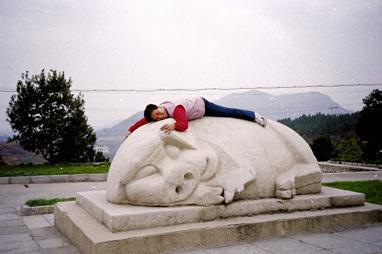
Because of their age, and their relegation to a recycling plant, the negatives were left in limbo. The damage has taken its toll on many of the images and this neglect can be seen on the faces of the photos. The unintentional destruction of the surfaces, corroded and breaking apart, gives an almost fluorescent hue, as if glowing with all of its infused history. The new context given to these images helps them to bridge the gap between then (when the photos were taken) and now (when the photos are displayed). Despite the huge number of images in the archive, there are still gaps in this history but through the process of being printed, included in publications, talked about, and Instagrammed, the chosen individual images have the chance at a second life, and to indicate the shape of the stillmissing history. Photography has often been used to play with the narrative and order of history. These images are helping to show what has been overlooked up until now. Like Vivian Maier’s posthumously discovered treasure trove of negatives documenting US street life, the power of these photos showing everyday life may have been slightly delayed, but not deleted.
Likewise, the Archive of Modern Conflict also adopts a process of acquiring images and reanimating them through new contexts, including publishing them in magazines and books, and featuring them in exhibitions. The initial collected photos, objects and ephemera shared a common focus of depicting images of conflict but over time has steadily grown to become a hugely diverse and reflective collection which is among the largest of its kind in the world. Through its many outputs, groupings or individual images from the collection are called upon to weave new narratives out of the source material. Dipping into the collection and retrieving
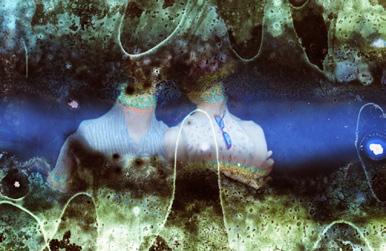
93 92 FOCUS ESSAY
Beijing Silvermine
Thomas Sauvin PLAYFUL APPROPRIATION AND THE ARCHIVE
The notion of play enters the equation in its role of discovery and recovery, as well as within the images themselves.
©
/
images acts as a way of shedding light on the extent covered by the collection. This means that one image has the potential to have endless reinterpretations in its lifetime in the archive, as well as multiple uses, contexts and readings. One of the appeals of the archive, which can be understood from this fluidity, is that it takes on the shape and need of its interpreter. This can be seen through the many forms and approaches of the publications, ranging from newspapers to holy bibles and everything in between. The diaristic, leatherbound publication, complete with leather buckle for veracity, Jan Mayen by Cristina De Middel uses a combination of archival and new works to (re)tell the tale of a failed 1911 Arctic expedition to the island of Jan Mayen. The crew on board resorted to staging photographs of the landing as the voyage was ultimately unsuccessful. Play, as a tool, is so beautifully defined here in the portrayals of the unlucky explorers using photography to trick us, the viewers, into believing this narrative of landing
successfully on the island they had set out to explore. The act of play is twofold as the performed photographs have gone on to experience yet another narrative shift, this time in the De Middel publication, alerting us to the fact that the staged landing may have had yet another layer of fakery added to it.
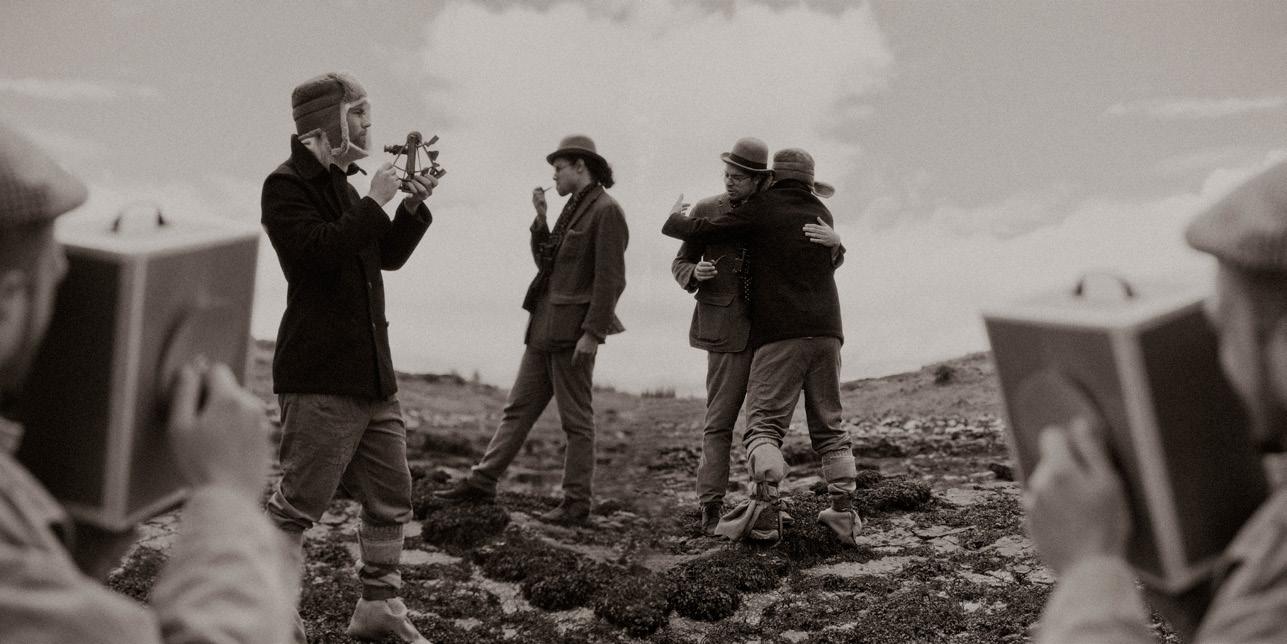
At the other end of the scale is a truetolife replica of a photo album found on a shelf in the AMC office (edited by Kalev Erikson) which faithfully reproduces the photos found within. The archive revived these images and provided further contexts for these works; not only in the publication itself, host to a new sequence of images, but also in the new contexts that the publication will find itself in, new homes, bookshelves, collections and more.
Another type of artistic archival appropriation is cultural appropriation. This takes place when an archive is taken over by someone who has knowledge or a connection
PLAYFUL APPROPRIATION AND THE ARCHIVE
to the inherent cultural properties of the images themselves. The images are then actively, knowingly reintroduced into another cultural context. This occurs in addition to the physical and automatic appropriation. The shifting of images from one setting to another forces the images, the interpreter and the viewer to make sense on multiple levels. The material plays out against unexpected settings and results in new associations and sets of semantics being created. An example of images playing across several settings is the Arab Image Foundation, founded in 1997. It is host to a collection of 500,000 photographic elements, arising from approximately 300 collections, all with a clear and strong relation to the Arab world.
The foundation’s documentation policy favours a multi faceted approach which, ‘applies a stratified documentation process, gathering layers of historical, theoretical, conceptual and other forms of knowledge and information. This approach encourages multiple readings and interpretations of the objects in our care, allowing different understandings to emerge, rather than one dominant, imposed vision.’ This emphasis on flexible readings is key to the images and archives being able to be read in various settings.
One of the founders of the archive, Akraam Zaatari, incorporates archival research and reinterpretation into his curatorial and artistic practice. A longterm explorative project is based on the found collection of Hashem El Madani, thought to be the first owner of a 35mm camera in Lebanon. One grouping of images from this collection focuses on the hypermasculine poses of wrestlers standing topless and proud for El Madani’s camera. There is an air of theatricality and playing up for the camera. Broad men face down the camera in an outdoor training area. Their poses are the classic Superman ‘hands on hips’ or menacing the air with their powerful arms, but the surface of the photo is breaking up and the patchy emulsion is showing its age. In other photos, similarly damaged by time, the men pose and flex and play the role of strong men.
There is little known about the motivations for these photographs. How El Madani came to find these men, and why they chose to represent themselves and their relationships with each other in this way, but we can see so clearly the link between play and identity and the role that photography has in recording this. An archive will take on many shapes as it passes through the years and it is part of the beauty of being able to look back through time.
A more recent archival inspired project by Zaatari, this time in his role as art practitioner, is The Script. Zataari uses YouTube as an archive of videos and images with which to prompt and inspire new narratives. Entering ‘father and son’ into the search bar in Arabic, he pulls up a list of results, leading him eventually to finding a
95 94 FOCUS ESSAY
From the series Jan Mayen . Cristina De Middel. 2015. Courtesy of the artist.
cache of videos of fathers performing the salah, the 5 daily prayers for practicing Muslims. Zaatari engages an actor to reenact this prayer, while their actor son plays unphased by the serene and serious performance. The role of play is being called upon to give a glimpse into a life or activity that might not otherwise be witnessed in quite such a neutral manner.
In a similar way, the recent project by Liz Johnson Artur and her Black Balloon Archive also speaks to the power of archives in representing and reflecting diasporas. The Black Balloon archive is a living repository which Johnson Artur uses to chronicle daily black life in London — where she lives — and while on her travels. It is a reminder of the way in which photography can be used as a tool for social justice and how archives can be used as a vehicle for empowerment and discovery. With an intuitive, rather than didactic, collecting method, she has built a body of images which highlight pride and identity. Whether dancing with abandon or demurely showing off a new dance move, the images are pulled together in a way to show connections between people.
Play and appropriation, as tools, have the potential to transform found material into artworks with new meanings and potential. In this sense, the archive can become an endless source of inspiration and interpretation with the potential to reach beyond its original scope. Play is a key factor in discovering, exploring and reinventing archives and it is in these steps that we can see routes to new ways of making meaning.
96 FOCUS ESSAY
Caminantes

97 LORENZO VITTURI
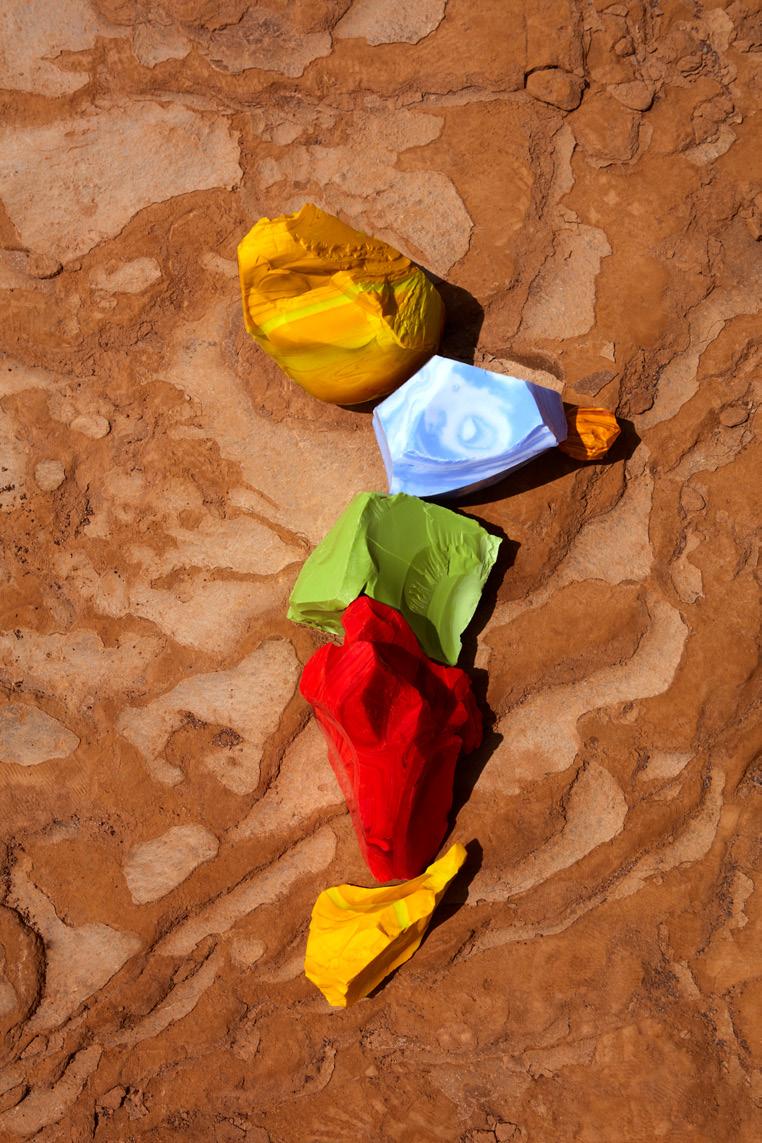

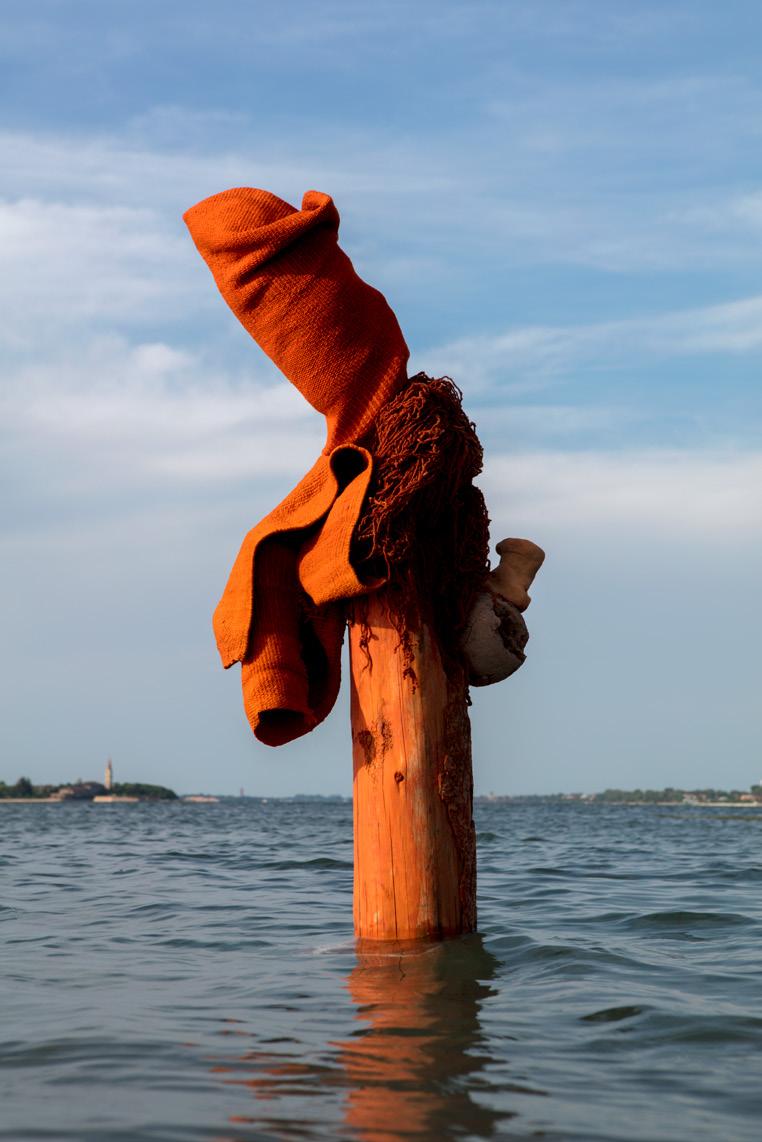
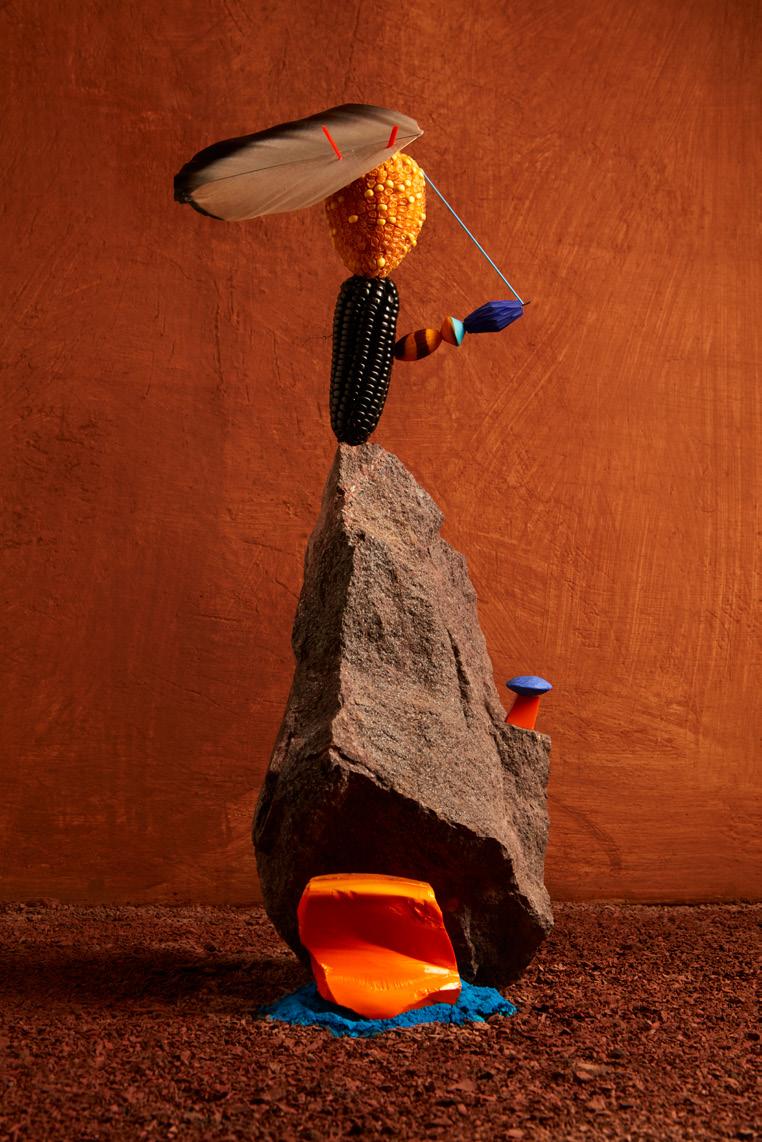

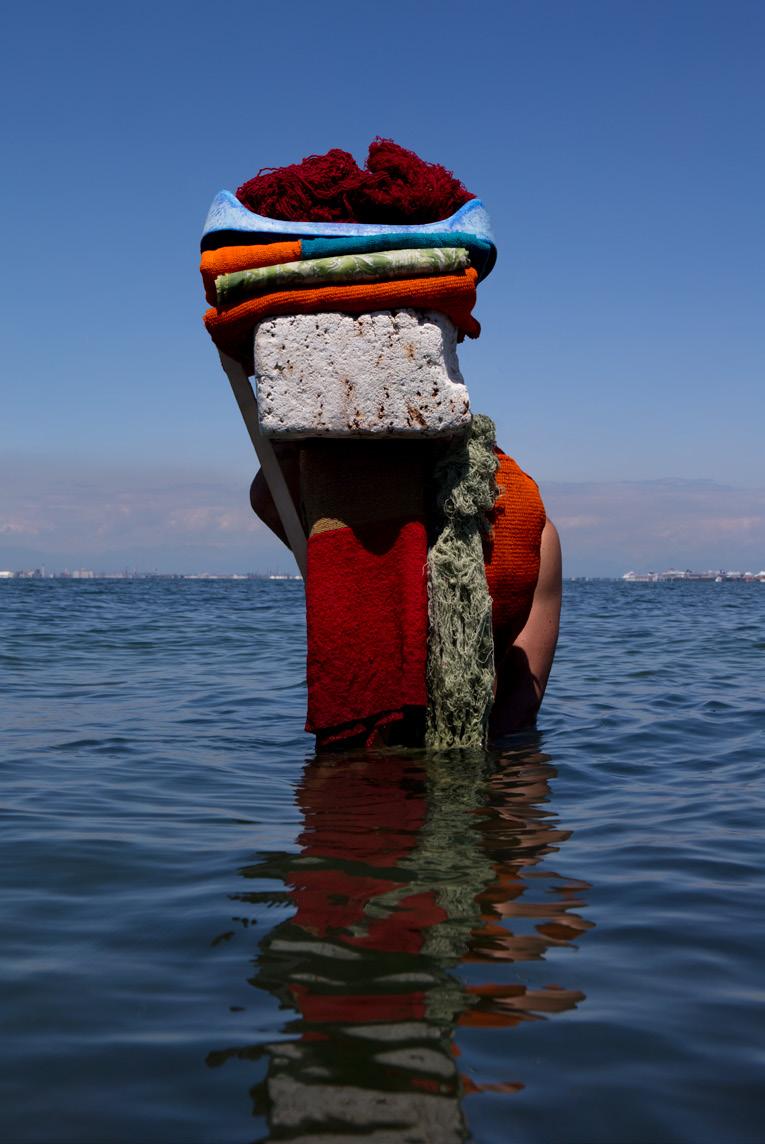

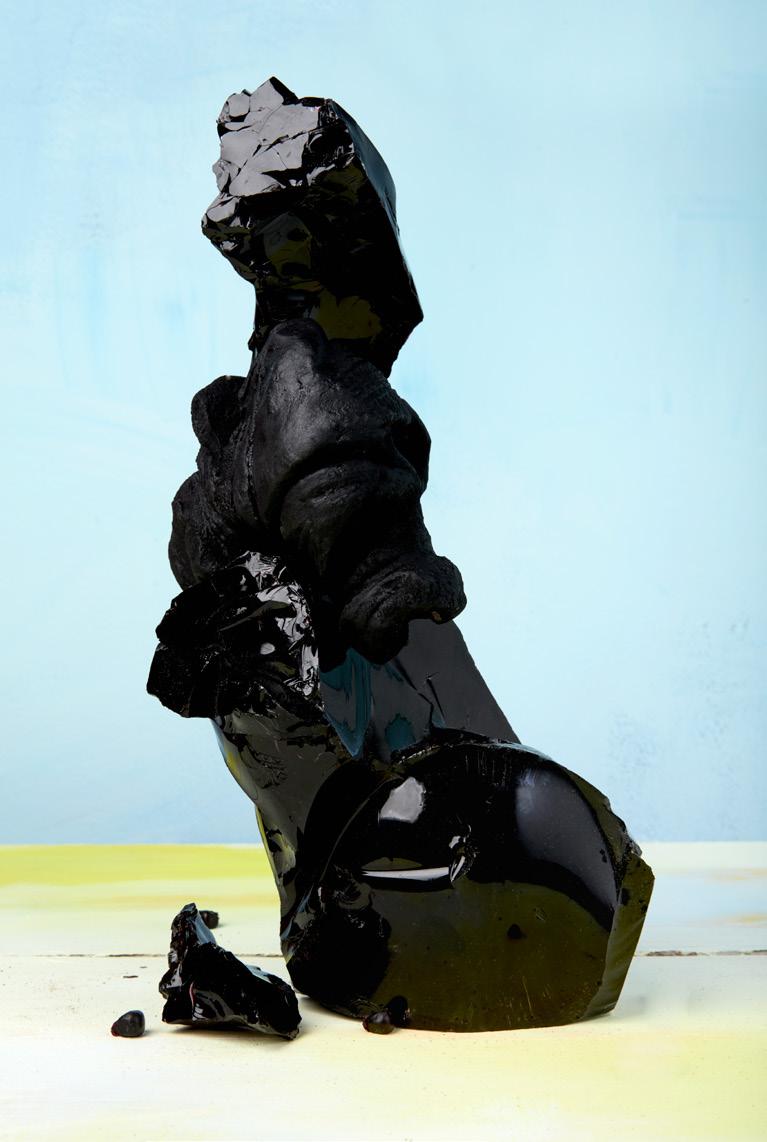
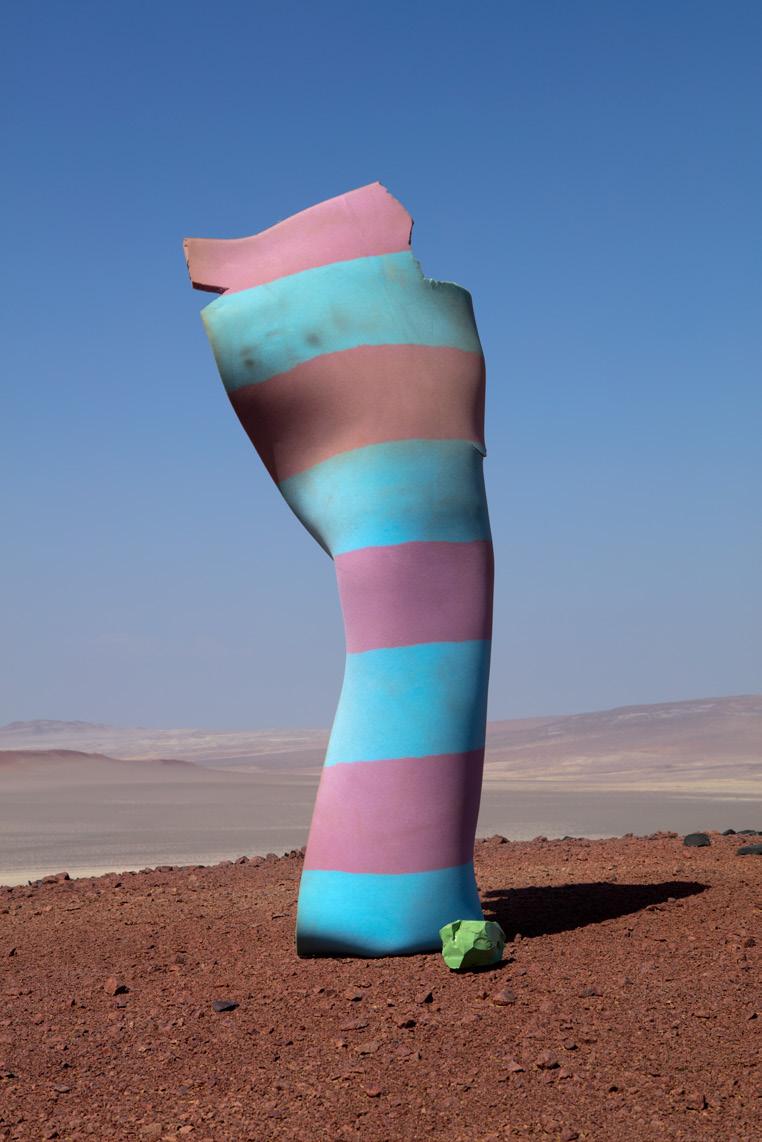
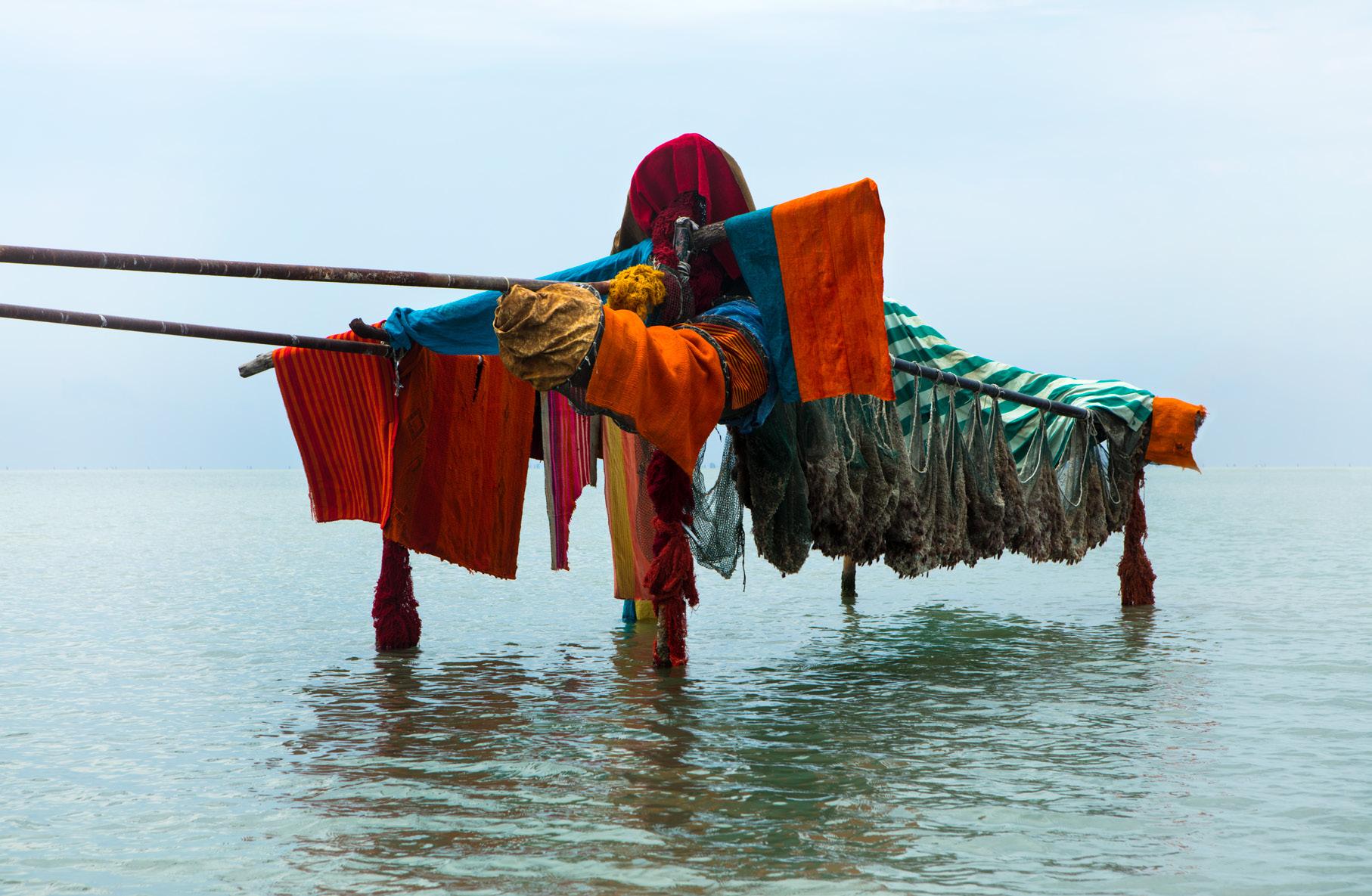

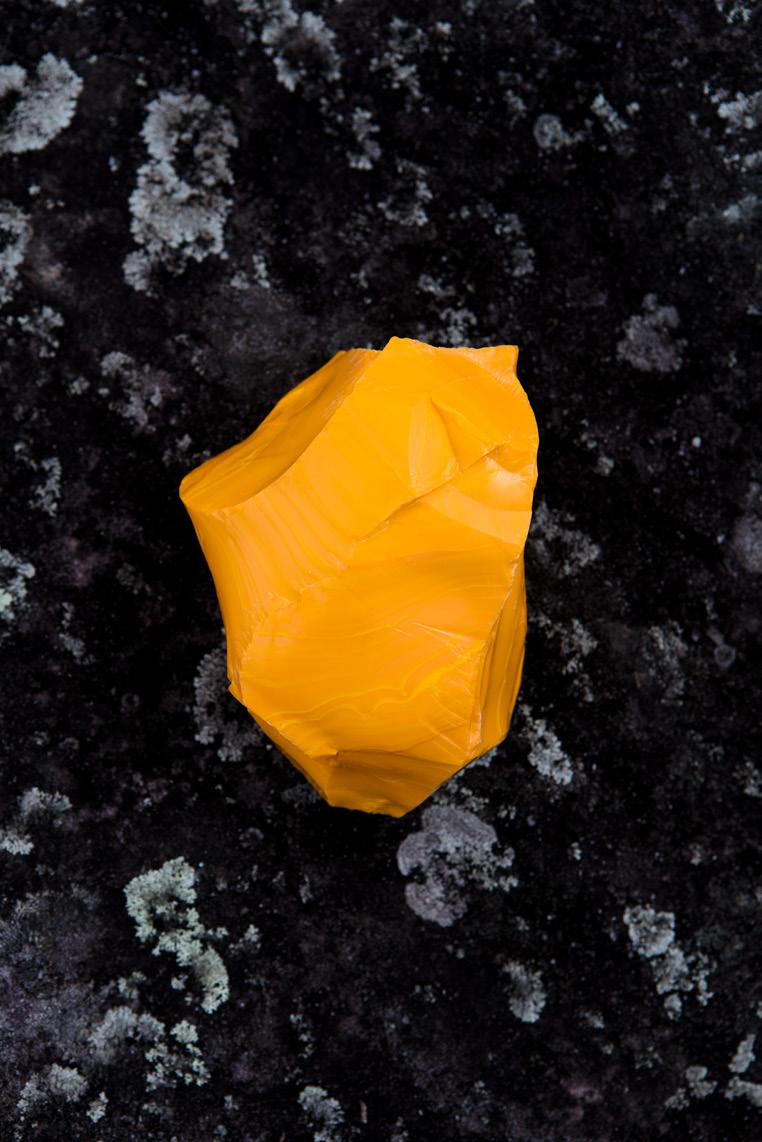
Caminantes
It seems that the locations in which Lorenzo Vitturi (Italy, 1980) lives, or is otherwise personally connected to, are important building blocks in the oeuvre that he has been consistently establishing since the publication of his distinctive book Dalston Anatomy (published by SPBH, 2013). Vitturi grew up in Venice, which, in 2019, is no longer a city but a theme park where the grandeur of the past is being relentlessly packaged and sold. Today, Vitturi lives in London in a multicultural neighbourhood where the advancement of gentrification persistently threatens its diversity. Urban changes beyond Western cities, the blending of cultures and the movement of people and goods in a globalised world are essential aspects of Vitturi’s work.
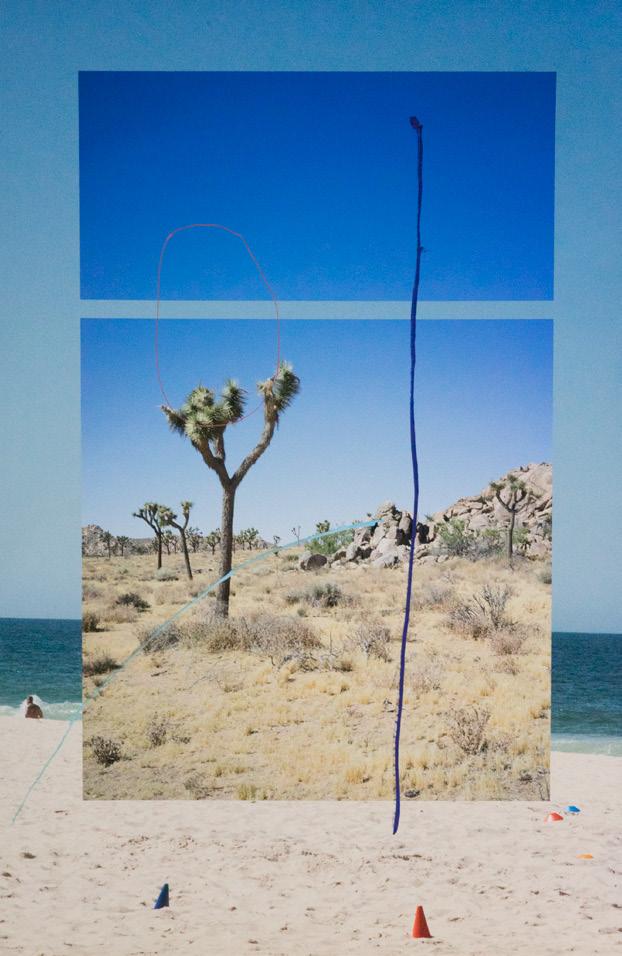
Playing with the combination of reality and fiction, mixing photography, sculpture, painting and collage, Vitturi builds temporary sets in his studio and specific geographical environments. His projects focused on cities including Lagos, London and Venice and selected areas in Peru; on their colours and shapes and the communities that inhabit them. The sets, built either indoors or outdoors, are cap-
tured by the camera. Highlighted by Vitturi are the temporal and location-specific effects on his material subjects as he investigates their many mutations with his lens.
Vitturi’s most recent project Caminantes (Spanish for walkers) draws inspiration from his family history and explores the encounters between and merging of different cultures. In the 1960s, his father, originally from Venice, crossed the Atlantic to open a Murano glass factory in Peru. There he met Vitturi’s mother. Drawing from a series of trips between Peru and Italy, Vitturi combines selected materials, which carry stories of local cultures and encounters, as well as perform the rituals of travel and shipping. The fusion of materials allows the viewer to question their function as cultural markers and to explore the dynamics of converging cultures, showing that no element can be seen as pure. Once travelling, he combines the glass with a wide range of raw materials (rocks, wood, foam, textiles, shipping materials) collected along the way and he creates series of ephemeral interventions in the environment. At the end of the trip, he fuses the glass with Peruvian soil.
Returning to Venice, together with the materials processed in Peru as a final act of transformation he combines them in the lagoon and make a series of physical sculptures where the materials from both places find their final stage of transformation. They are the result of a series of encounters and changes that take place over time and across multiple locations.
In Vitturi’s photographs, we see a cacophony of texture and colour. The human body here of Vitturi himself is hidden by fabrics, materials and objects. In this way, it becomes an object and a material in itself. The camera documents the makeshift sculptures and interventions in the landscape, and as such, they endure. The ephemerality of sculptures and landscape interventions mirror the impermanent nature of a rapidly changing globalised world in which cultures fuse. Meanwhile, their reintroduction in the magazine or exhibition space as photographic images allows us to reflect on constant cycles of production, destruction, and recreation.
—
ALICE QUARESMA
Mental Object
Text by Kim Knoppers
113 112
LORENZO VITTURI
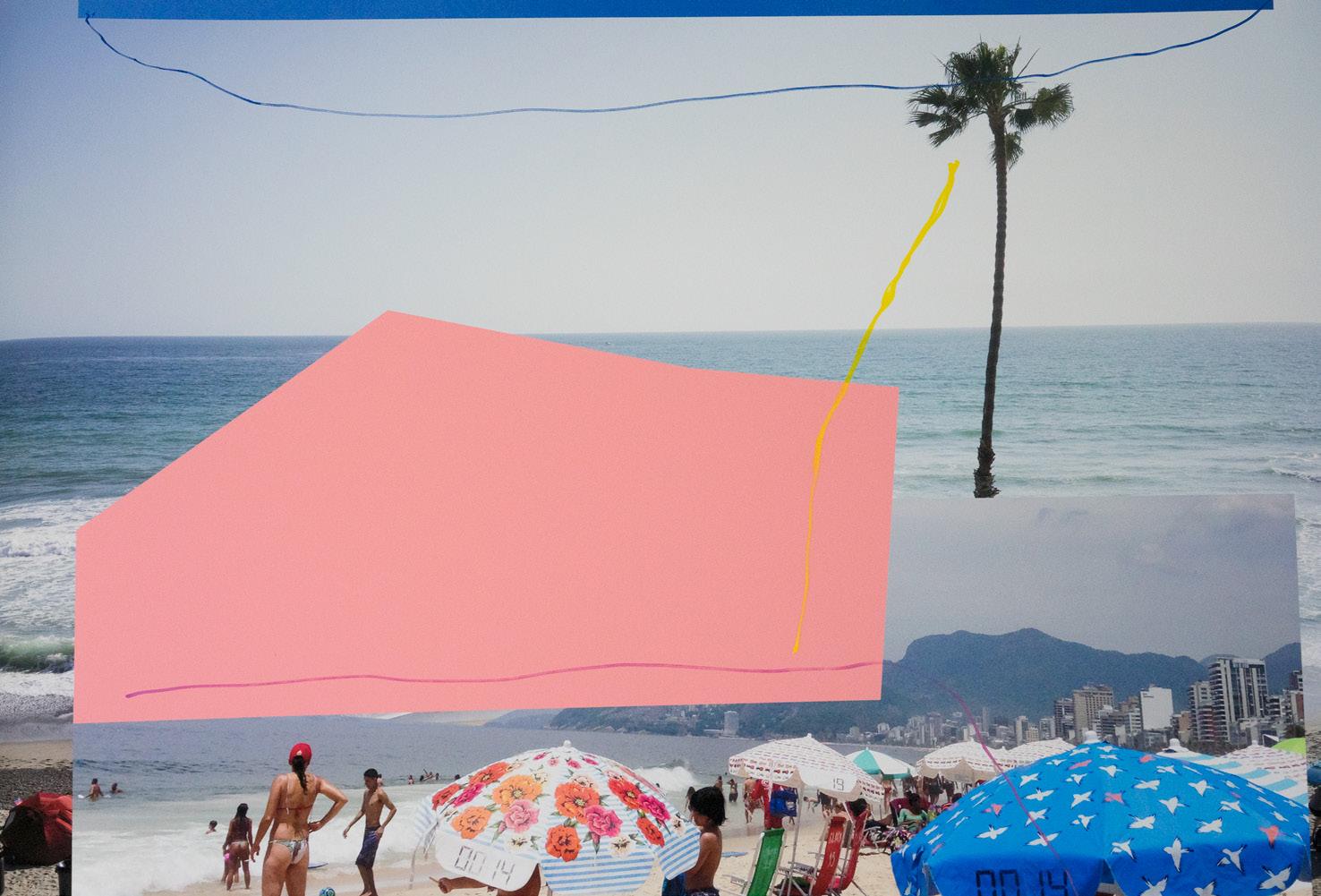
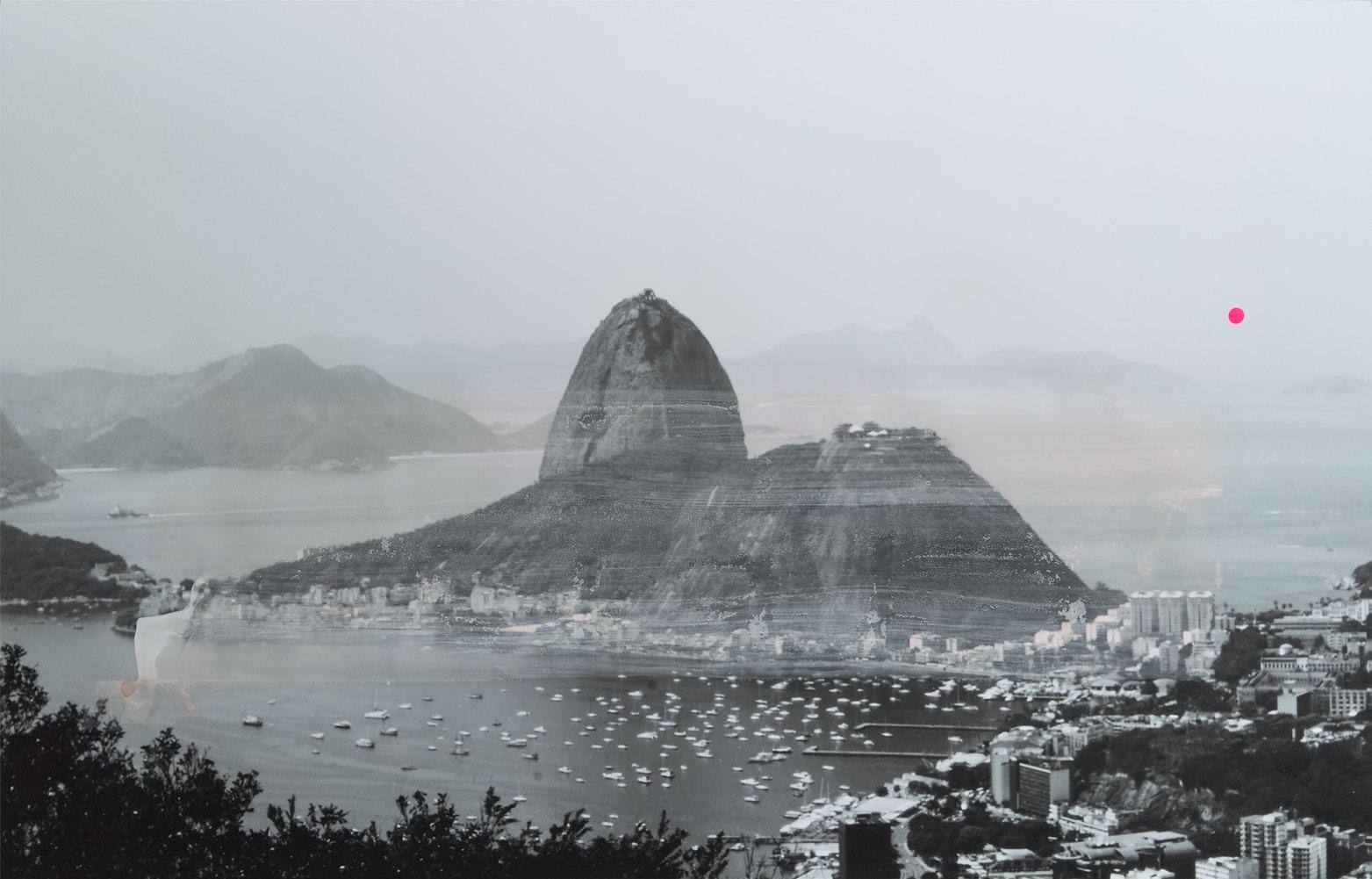

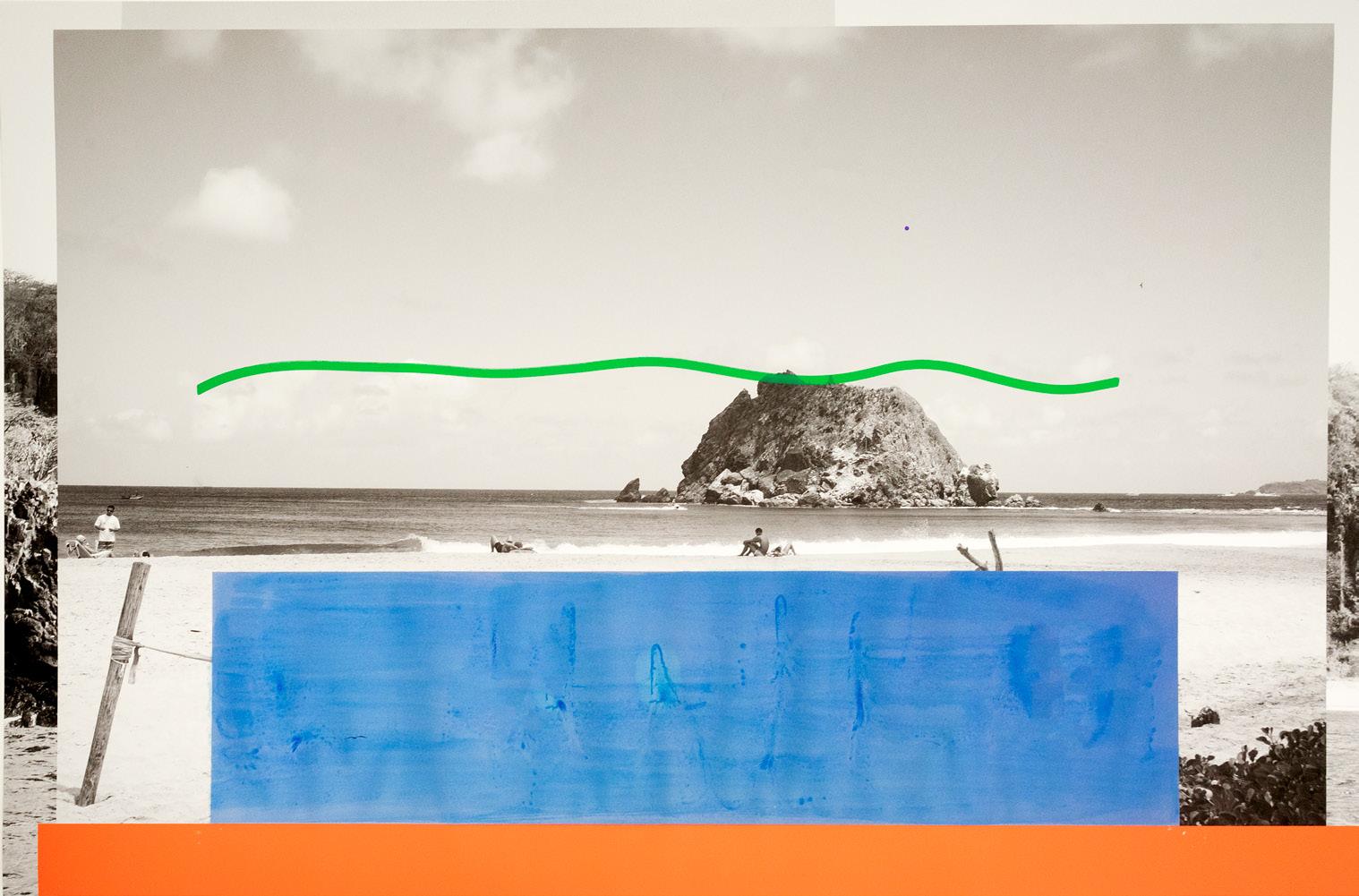

Mental Object
As a medium rooted in chemical reaction, the magic of photography of recording ‘reality’ and watching its fixed image slowly appear on a flat surface is still felt today. But despite its initially enchanting qualities, the mechanical confines of the medium often pose creative roadblocks for artists. While a camera can point and shoot what is directly in front of its lens, its straight practice doesn’t compare to the textural possibilities contained within an unformed slab of stone, or the colourfully surreal potential that awaits a blank canvas. And yet, as history reveals, whenever the confines imposed by photography feel heaviest, artists expand its definition by asking: How can we use photography to mould the intangible?
Alice Quaresma is deeply interested in unlocking the expressive potential of photography. Trained as a painter, she relished in the boundless possibilities of shapes, colours, textures and paints. But in art school, her educational shift to photography felt suffocating. She was always happy to return to her brushes, where the opportunities for expression were limitless. But one day, while doing research on her hometown Rio de Janeiro, she came
across an artist collective from the 1950s called Grupo Frente, an avant-garde group that sprung into activity after the country fell under a dictatorship. At a crucial time when artists were banned from expressing themselves, their most enduring contribution was the Neo-Concrete Movement, shifting the tides of Brazilian art.
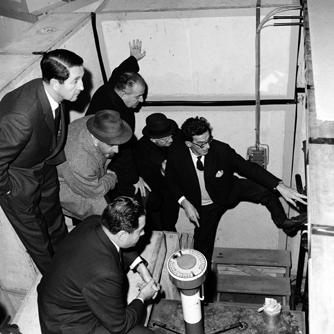
The Neoconcretists created paintings, objects and performances using highly geometric patterns a discipline the government couldn’t justify categorising as unlawful and invited people to participate in each work, manifesting their own interpretations. This meant the focus of each piece was its interaction with other people, as well as each artist’s own meditative expression during its creation. No matter the medium, each work became an object of play, so that its impact wasn’t necessarily expressed through visceral colours and familiar references it was internalised within the people it touched.
Inspired by this participatory practice, Quaresma returned to her vast archive of mundane images, realising that the flow state of the Neoconcretists could be extended to her own photographs. She started isolating each take by intervening with
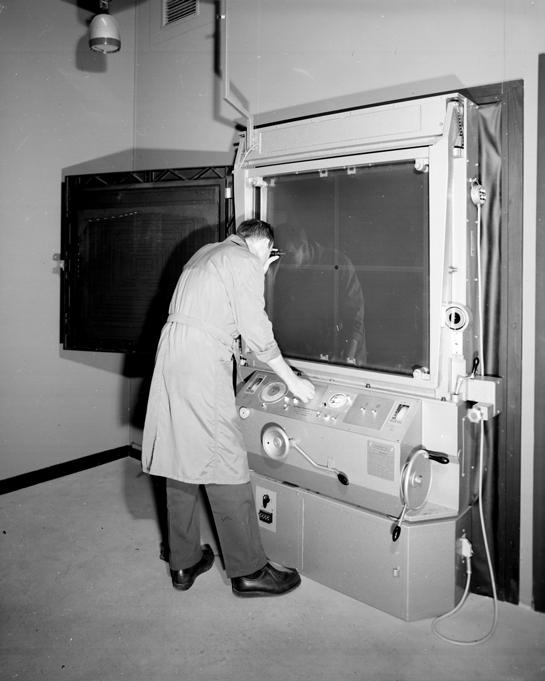
their surfaces, injecting them with new life through her own impulsive interferences strokes of paint, scraps of fabric, paper cut-outs and other ephemera while also ensuring each work had participatory potential for her audience. Sitting in front of each photograph, Quaresma acts intuitively with her brush strokes and additions: a thin line of blue cuts through a photograph of a palm tree, while other images are spliced together to form impossible glitching landscapes and minimalist collages. When we look at a final piece, we can see the artist’s hand at play, the gestures of her working process laid bare rather than erased through the shiny perfection of a well-lit, expertly developed, dodged and burned, flat, glossy print. What’s more, in exhibitions of her work, visitors are welcome to touch the pieces and interact with them, forming their own relationship to her projects. Quaresma’s pieces reveal the hands they have passed through and the life they have lived, elevating them from static images to participatory objects full of life and full of play.
— Text by Cat Lachowskyj
124 125
ALICE QUARESMA DAVID FATHI Wolfgang


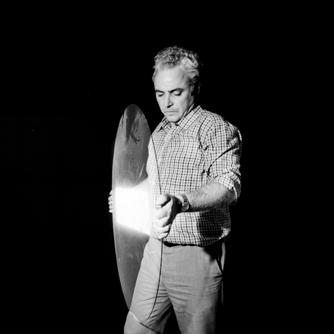
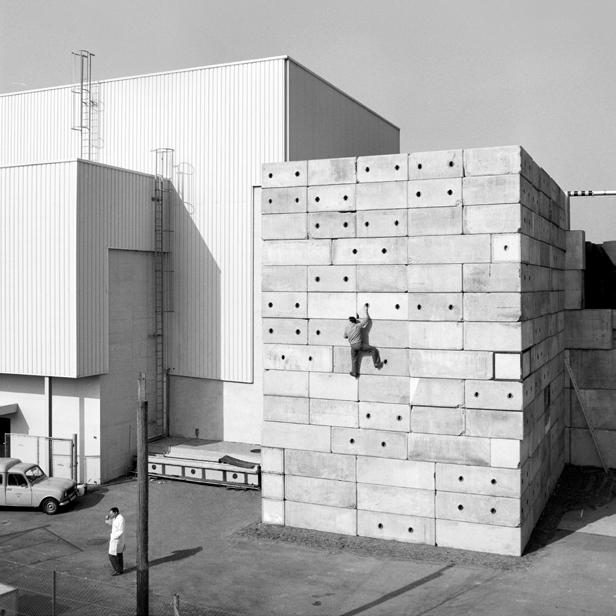
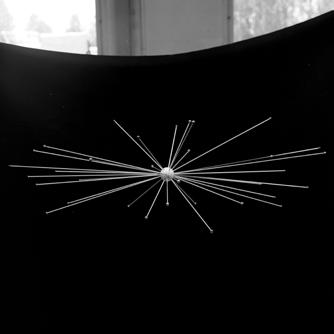
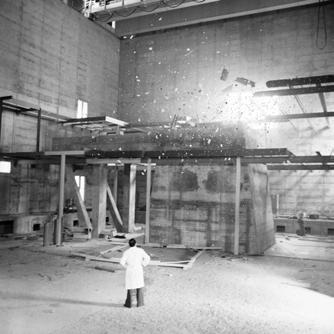

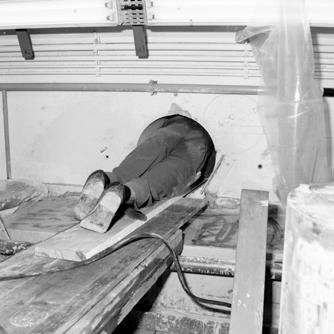
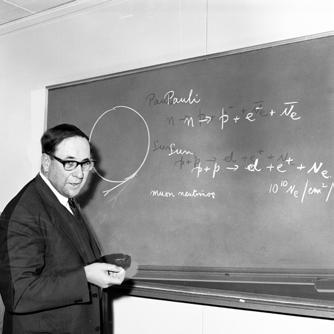
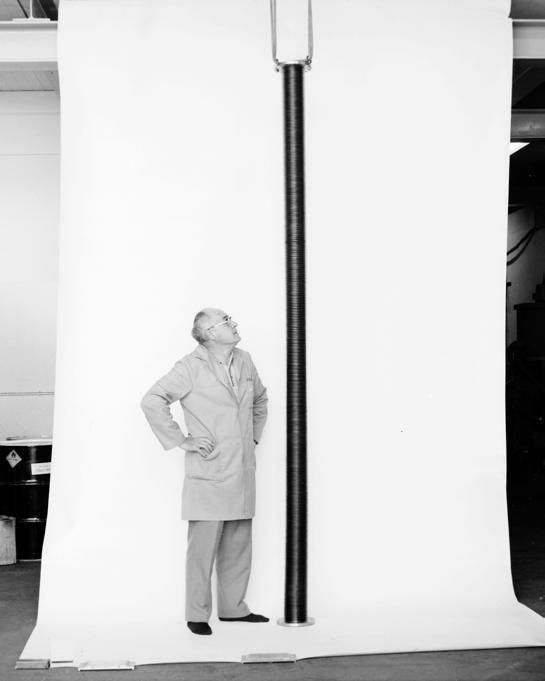

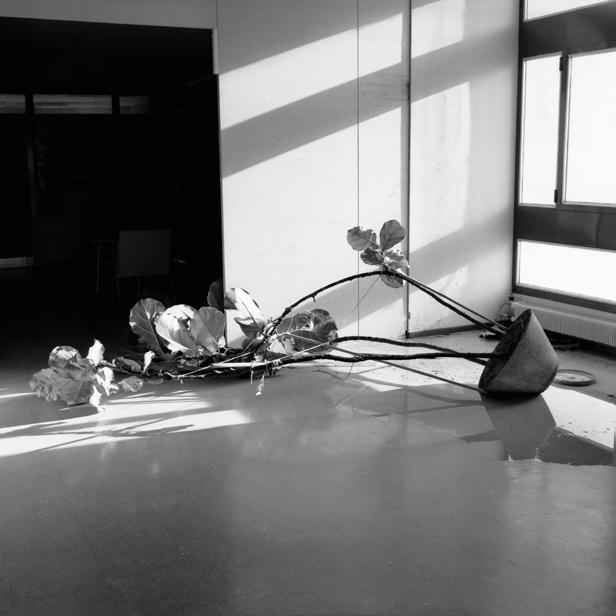





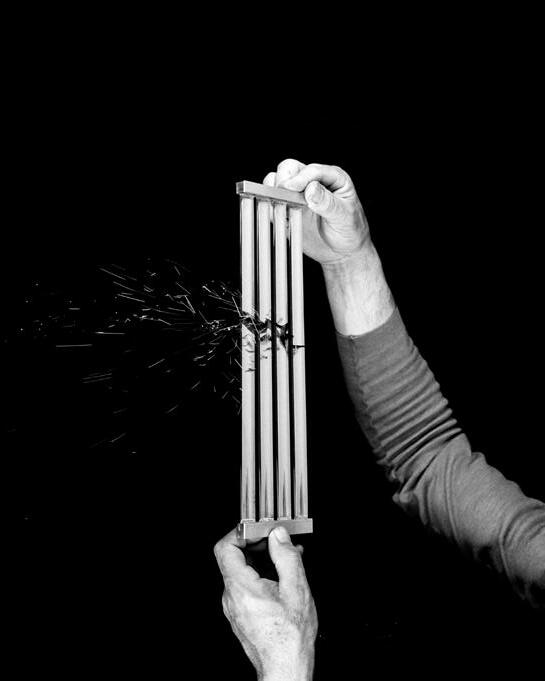



It is often imagined that photography is a technology without identity that, like a chameleon, it adapts its form to the fields in which it finds use. This might seem a valuable quality in pursuits like science which are intended to be transparent and free of bias, but even the idea that this quality is desirable is itself political. Photography, rather than exposing this fact, has more often served to extend the illusion of neutrality, and make still more invisible the truth that even the empirical pursuit of knowledge is the product of a very particular sense of how the world is, and how it should be.
David Fathi’s Wolfgang is a clever and playful utilisation of photography intended as a servant to science, in this case taken from archives of the European Organization for Nuclear Research, or CERN. Following its creation in 1954 the organisation began to employ photography for a variety of purposes, from scientific documentation to public relations activities, and recently began to make this archive public. The namesake of Wolfgang is not however directly present in any of these images. He is Wolfgang Pauli, a noble prize-winning pioneer of quantum physics who died shortly after CERN’s formation.
Besides Pauli’s ground breaking research, he is remembered for the eponymous Pauli Effect, a phenomenon which supposedly caused experiments to go wrong, and equipment to break down when he was present. This became something of an internal joke at CERN, but Pauli apparently revelled in it, and according to some reports even believed it to be a real phenomenon, a strange example of how the most scientific minds can also be inclined to mysticism.
Fathi takes this small footnote in the history of quantum physics, and uses it as inspiration to repurpose and at times rework the CERN archive. From these images he creates a narrative of mysterious accidents, malfunctions and events all, it seems, driven by Pauli’s restless spirit, which appears to haunt the halls and laboratories of CERN. In Fathi’s images, freak accidents occur, machines fail, and objects are inexplicably transformed as if by a poltergeist, all while groups of scientists look on in disbelief and bafflement.
Fathi’s work stands in something of a tradition of creative reuses of scientific documentation, one which came to wider awareness with Larry Sultan and Mike Mandel’s influential 1977 series Evidence But far from being just a nod to these fore-
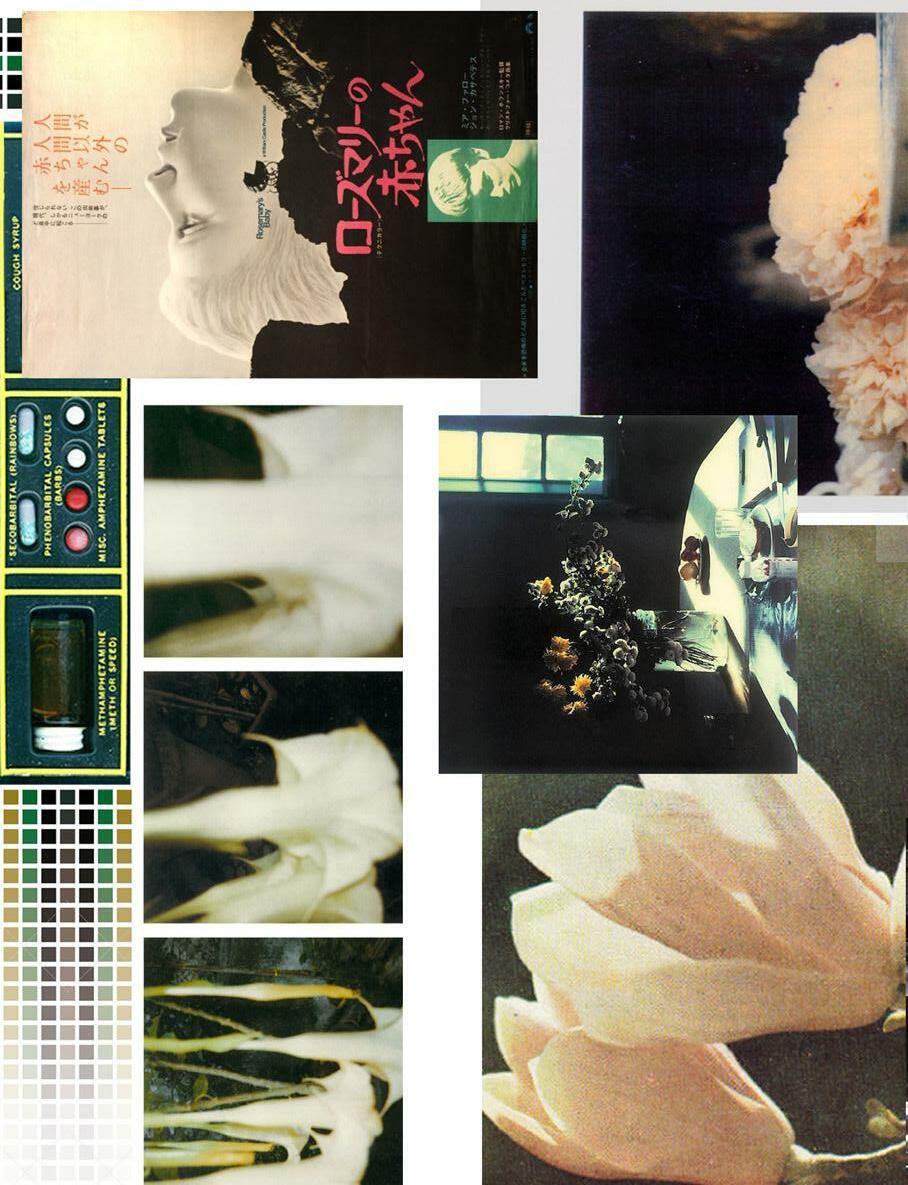
bears, Fathi takes the approach somewhere else with a different type of humour and playfulness, one which turns on the viewer’s knowledge that not only are his photographs shorn of context, but they are also manipulated in other ways which are far harder to detect. As well as playing with the photographs, and the history they represent, Wolfgang plays with us as viewers.
Even by the standards of his field, Pauli was reputedly a perfectionist, reserving scathing criticism for studies which he felt were insufficiently scientific. His deepest criticism however was reserved for research which was so lacking in rigour that it could not even be evaluated, and which was in Pauli’s words therefore ‘not even wrong’ but worse than wrong. Photography in its own way has become something which often feels beyond evaluation, because it is not only hard but frequently impossible as a viewer to determine what is the truth of an image and what is not. Wolfgang adds, albeit in a very entertaining way, to the sense today that at least as a medium of evidence, photography is itself not even wrong, but worse than wrong.
— Text by Lewis Bush
137 136
DAVID FATHI KAY KASPARHAUSER wip.tba.001
Wolfgang

Homo
wip.tba.001
have had the pleasure of following @wip. tba.001 since its first post. have seen the evolution unfold before my eyes, like a bloom. In an algorithm intended for single post structure, wip defies. It is the whole that is important here. That is not to say that each post does not hold up on its own they do. But to truly see wip, in its budding performance of colouration crescendos and virtuoso-like cultural cataloguing, you must visit its home.
A home is defined as the place where one lives, and an individual does live here. They are kind enough to let guests visit at their leisure, but Kay Kasparhauser is wip’s only permanent resident. About year ago Kay had a stroke. Before that, she had two brain surgeries. This is the distinct mo-
ment can remember her memory getting fuzzy. By fuzzy mean, she stopped recalling specifics very well. Wip is Kay’s way of remembering. Like a diary, she uses it as a research notebook, exploring not only the visual aesthetic symphony that it so obviously is, but also herself. I compare wip to music because Kay is also a musician. Her brain thinks in chords. am not surprised that this venture pours out of her as mutated form of synaesthesia. She sings in hieroglyphs.
Images are removed from their original context. They deviate, expand, form new bonds with other images. These bonds are formed with the intention of beauty while simultaneously remaining transparently data. Data is part of Kay’s
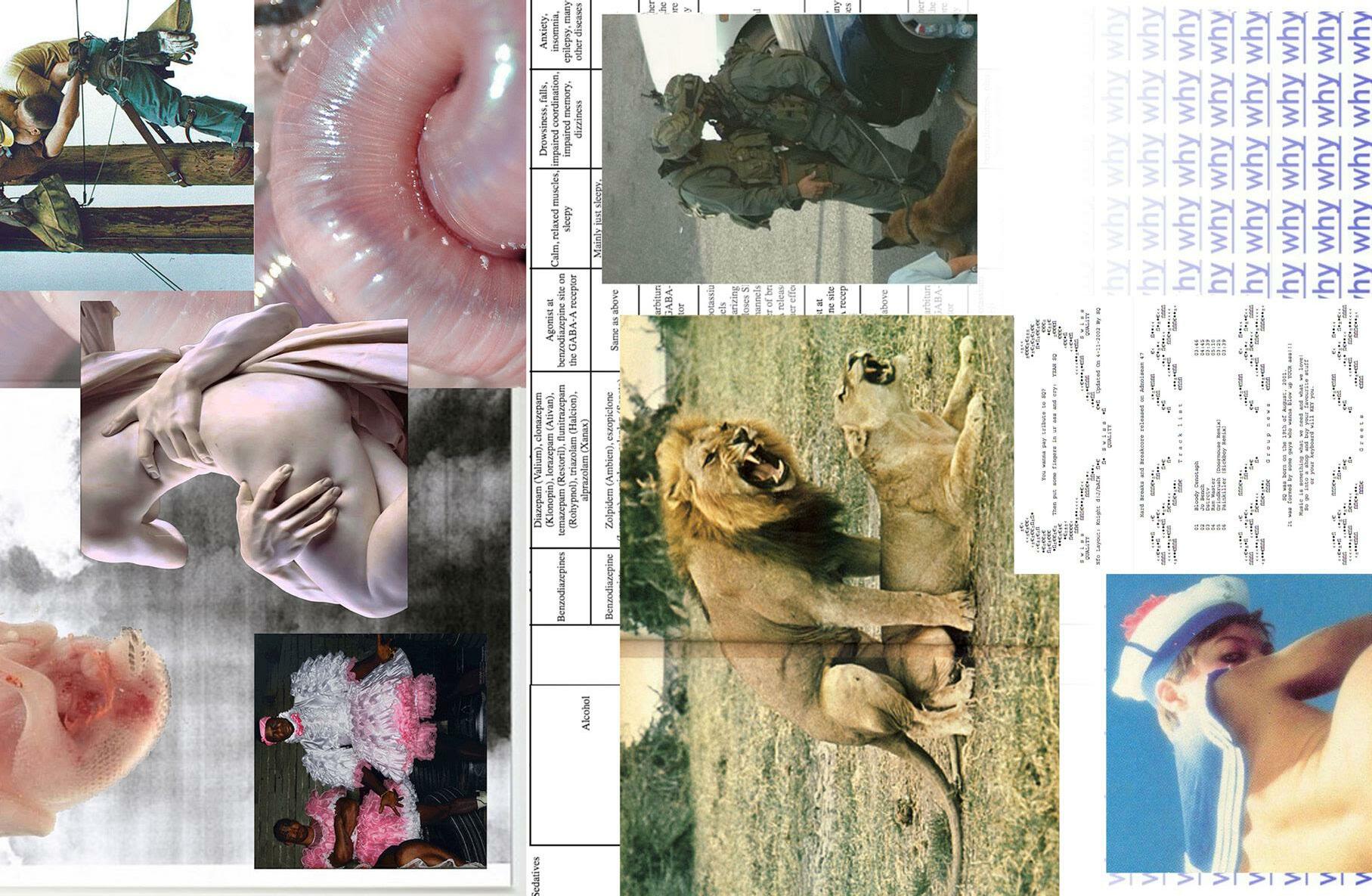
everyday aesthetic. In a way, I think she sees herself as data. Moving through the city wearing more or less a uniform. She is a cell colliding with other cells in a vast sea of computer-like cohabitation. Or at least that’s how it feels these days as we become more and more reliant on our iPhones for food, dating, directions, etc.
The interactions Kay experiences through wip are anonymous but also personal. She lets you in, whether you realise it or not. She also speaks through wip, whether she realises it or not. Wip is a personal yet anonymous love song. The viewer is the beloved. A siren along the shores.
— Text by Carly Mark

The Playful Turn in Photography
Ludens
by Hinde Haest
144
KAY KASPARHAUSER 145 FOCUS ESSAY
Essay
From Huizinga’s starting point of playfulness as a pillar of civilisation to photographers using their imaginations as a way forward, we see photography and play acting as an instrument of promoting different ideologies, and the imagination of an alternative society.
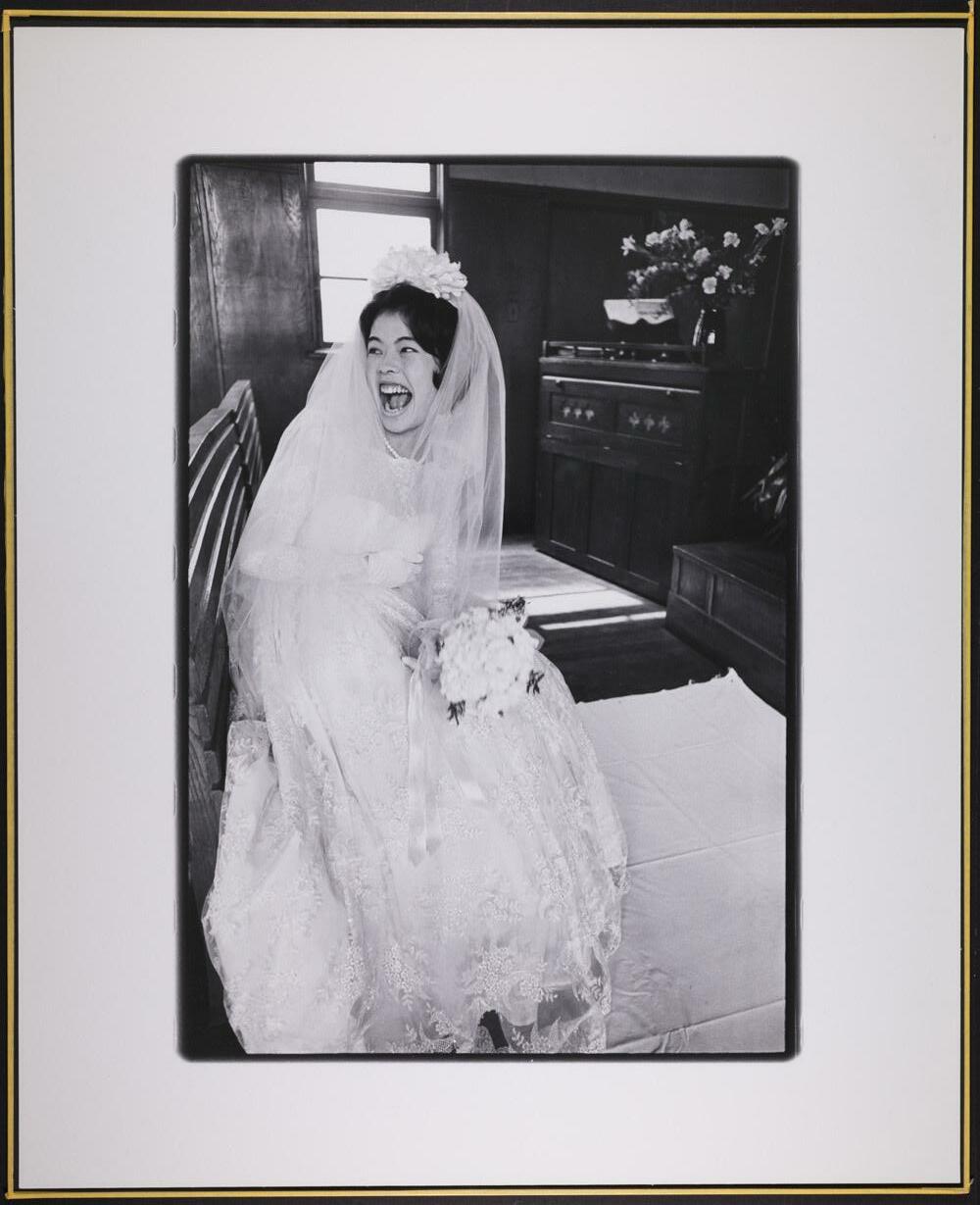
When Dutch cultural theorist Johan Huizinga (18721945) famously declared play to be the pillar of civilisation, he excluded the plastic arts (and therefore photography) from the realm of play. His 1938 manifesto Homo Ludens — Latin for ‘playing man’ or ‘man the player’ — reads, ‘Once finished [the] work, dumb and immobile, will produce its effect so long as there are eyes to behold it. [...] For where there is no visible action there can be no play.’ (Huizinga 1938, p. 166) Indeed, playfulness has not typically been associated with artistic genius, while humour and fun are carefully avoided by many a self-respecting artist. Art is a serious matter. Art is the heart of civilisation. But if art is a pillar of civilisation and — following Huizinga’s declaration — civilisation is inherently playful, then art should, in essence, be play. Having passed away at the end of the Second World War, Huizinga did not live to see his Homo Ludens become a major source of inspiration for many an artist in the 1960s. CoBrA member Constant Nieuwenhuys (1920-2005) famously referred to the resurrection of man playing in relation to the creation of his architectural utopia NewBabylon (1956-1974). Huizinga’s study would later become a corner stone of the civil disobedience of counter culture movement Provo in The Netherlands. Upon reading its Japanese translation from 1963, the now iconic photographer Masahisa Fukase (19342012) published his pivotal first book under the title Homo Ludence (1971). Director of the Fukase Archives, Tomo Kosuga identified the translation as a primary source of inspiration for Fukase’s tribute to playfulness as a means to free oneself from societal constraints.
What all of Huizinga’s advocates have in common is their search for an alternative way of life through free imagination. They regard the work of art not as a finalised product, but as a playful means to imagine alternatives to oppressive normativity. Play, then, is not the lack of earnestness. Playing can in fact be a most serious matter. It forges kinship and thrives on creativity, but it also sparks competition and even violence. Following Huizinga, the line between play and war, politics, philosophy, language and art — to name but a few cornerstones of civilisation — is very thin. At the heart of his argument is the observation that all society is in fact ‘played out’. ‘Civilization arises and unfolds in and as play.’ (Huizinga 1938, foreword)
The belief that play can (re)form society explains the rekindled artistic infatuation with Huizinga’s manifesto in the 1960s. Yet even in his day the transformative power of play lay at the heart of artistic movements such as Constructivism, Bauhaus, De Stijl, CoBrA, Dada and Surrealism. It is telling that a number of notable artists with digressing artistic perspectives started advocating interactive art and design for children. From the Russian Revolution to the rise of Fascism, the child became the embodiment of innocence, hope and ideology — the blank slate on which a better future could be projected. ‘Children’s books, clothing, and toys — often suffused with a combination of humour and violence — became a vehicle for transporting adult politics into fictional worlds of engaged citizenship.’ (Kinchin in: Century of the Child, 2012, p. 121).
© Masahisa Fukase Archives 147 146 HOMO LUDENS FOCUS ESSAY
Photography, and photomontage in particular, proved a particularly suitable medium to imagine a brand new world through play. At the dawn of the ‘century of the child’ (a term coined by Ellen Key in 1900), artists such as Edward Steichen, Aleksandr Rodchenko, Piet Zwart, Claude Cahun and Hannah Höch all ventured into the creation of photographically illustrated children’s books. Though some of these publications are more didactic than others, all of them employ the element of play as a means to imagine a utopian — or dystopian — vision of society.
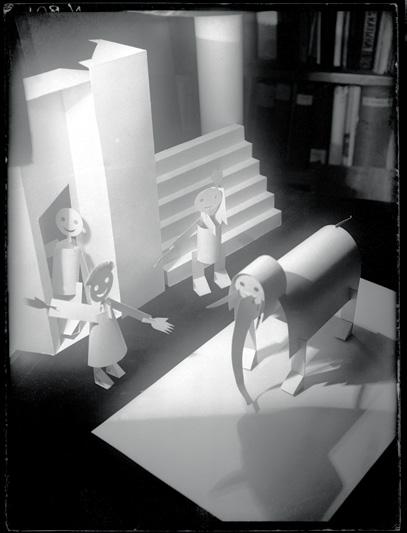
PLAYFUL (DIS)ORDER: THE BOOK OF PTT
A case in point is the playful moralism displayed in the 1938 Het boek van PTT [The Book of PTT] by Dutch designer and De Stijl member Piet Zwart (1885-1977). In 1932 the Dutch Postal Telegraph and Telephone Company (PTT) commissioned Zwart to design a book explaining to school children how to use their services. Het boek van PTT aimed to present the corporation as family-friendly, an unusual branding strategy for the time. The booklet took six years to complete; one of the photographs Zwart took for this publication already appeared in 1932 in the British yearbook Modern Photography under the title Postmanikin. Het boek van
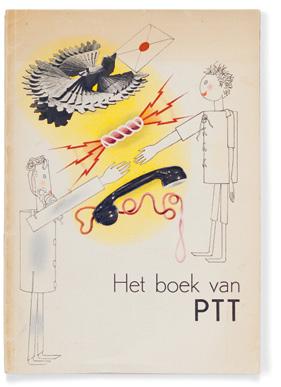
PTT includes a plethora of (photo)reproductive techniques, such as the then state of the art four-colour rotogravure. It also featured elaborate photomontages, a Piet Zwart trademark that had matured during his work for Dutch cable factory NKF (in 1928 and 1933).

The stars of the book are two photomontage figures named J. Zelf (Y. Self) and de Post (the Post): cardboard and tin personifications of the youthful reader and the company respectively. Their adventures include de Post drowning in an address book due to J. Zelf’s negligence to provide a precise address, or exploding after J. Zelf accidentally mailed a combustible package. At first sight the whimsical narrative, along with the chaotic layout and pastel colour drawings by Dick Elffers, seem stylistic anomalies in Zwart’s oeuvre. The Dada-esque cacophony of different techniques, colours and fonts stands in stark contrast with the more rigid style of his earlier company photobook NKF (1928), which betrays the influence of De Stijl and Constructivism. In a 1931 letter to his colleague Jan Tschichold, Zwart explains, ‘I would much rather see a badly designed, but lively page, than a page that reeks of rigid schematics.’ [author’s translation]

149 148 HOMO LUDENS FOCUS ESSAY
↑ Animaux à mimer , Serge Tretiakov, Alexandre Rodtchenko © éditions MeMo, 2010 ↘ © Hans Bol
With its undogmatic appropriation and curbing of various stylistic features, Het boek van PTT is exemplary of Zwart’s credo that design follows function.
Having suffered Nazi censorship of her ‘degenerate art’, the colourful and fantastical animal characters can be read as a celebration of regained freedom to create, dream and imagine.
With its undogmatic appropriation and curbing of various stylistic features, Het boek van PTT is exemplary of Zwart’s credo that design follows function. It was his firm belief that art and design had a social responsibility. He had particularly high expectations of the didactic potential of photomontage. In his opinion, contemporary schoolbooks were invariably ‘typographic monstrosities’ in need of drastic reconsideration. In the spirit of the teachings of Maria Montessori, Zwart employed the visual and the tangible as principal learning aides. In utilising the descriptive and plastic qualities of the medium, Zwart recognised photography as the quintessential means to articulate abstractions such as the metric system or, for that matter, the consequences of mailing inflammable substances. It is in the playful, the tactile, and the imaginative character of books such as these that the fundamentals of modernism coincided with those of childhood.
Zwart’s use of photography and graphic design as a didactic and at times moralising tool was part of an international tradition, which includes El Lissitzky’s early children’s book Of Two Squares. A Suprematist Tale in Six Constructions (1920), featuring two squares that rebuild the world, and the typographic fairy tale The Scarecrow (1925) by Käte Steinitz, Theo van Doesburg and Kurt Schwitters. The figurines in Het boek van PTT are reminiscent of the photographic illustrations for Aleksandr Rodchenko’s unpublished book Samozveri [Autoanimals] (1926-1927), featuring cardboard dolls, elephants, giraffes and other animals. Rodchenko showed his illustrations at FiFo — Film und Foto Internationale Ausstellung (1929) in Stuttgard, where Zwart certainly must have seen them.
The children’s books by El Lissitzky, Zwart, Rodchenko and others resonate with Huizinga’s statement that ‘play creates order, is order. […] Into an imperfect world and into the confusion of life it brings a temporary, a limited perfection.’ (Huizinga 1938, p. 10) However playful, it is doubtful Huizinga appreciated their didactic, functional or constructivist appropriation of play. He wrote, ‘True play knows no propaganda; its aim is in itself, and its familiar spirit is happy inspiration.’
(Huizinga 1938, p. 211) Huizinga painted a bleak image
of the future of play in a technologically and socially constructed society. To him, neither socialism nor liberalism left much room for playfulness. His observation, ‘Work and production became the ideal, and then the idol, of the age. [...] This grotesque over-estimation of the economic factor was conditioned by our worship of technological progress, which was itself the fruit of rationalism and utilitarianism [...]. But they had forgotten to free him of folly and myopia, and he seemed only to mould the world after the pattern of his own banality.’ (Huizinga 1938, p. 191-2).
THE END OF PLAY: PICTURE BOOKS BY HANNAH HÖCH AND CLAUDE CAHUN
Writing in the 1930s, a time in which the arts were increasingly mobilised in service of a malleable society by communism and fascism alike, Huizinga should be forgiven for announcing the end of play. His pessimism about mass-culture was shared by artists such as Claude Cahun and Hannah Höch, who both published playfully illustrated children’s books with an ominous undertone and cryptic critique of the political status quo. It is with good reason that both books turned out to be equally — if not more so — appreciated by adults. Both used the, up until then, quintessentially Constructivist element of photomontage to protest a rigidly designed society. As such, their playful compositions are as entertaining as they are political.
Hannah Höch (1889-1978) created the creatures that inhabit an enchanted garden in her Bilderbuch [Picture Book] in 1945, in the months following the fall of the Third Reich. Having suffered Nazi censorship of her ‘degenerate art’, the colourful and fantastical animal characters can be read as a celebration of regained freedom to create, dream and imagine. Unfortunately, the Bilderbuch proved too complicated to print due to post war paper shortage and the abundant use of colour (Höch inserted dyed fibres into her black-andwhite collages) at a time when high-end colour printing was still in its infancy. In 1952 only one of the illustrations was published — in the German newspaper Welt der Frau — and the dummy wasn’t presented to the public until 1975, as part of the exhibition Als der Krieg zu Ende war: Kunst in Deutschland 1945-1950 [When
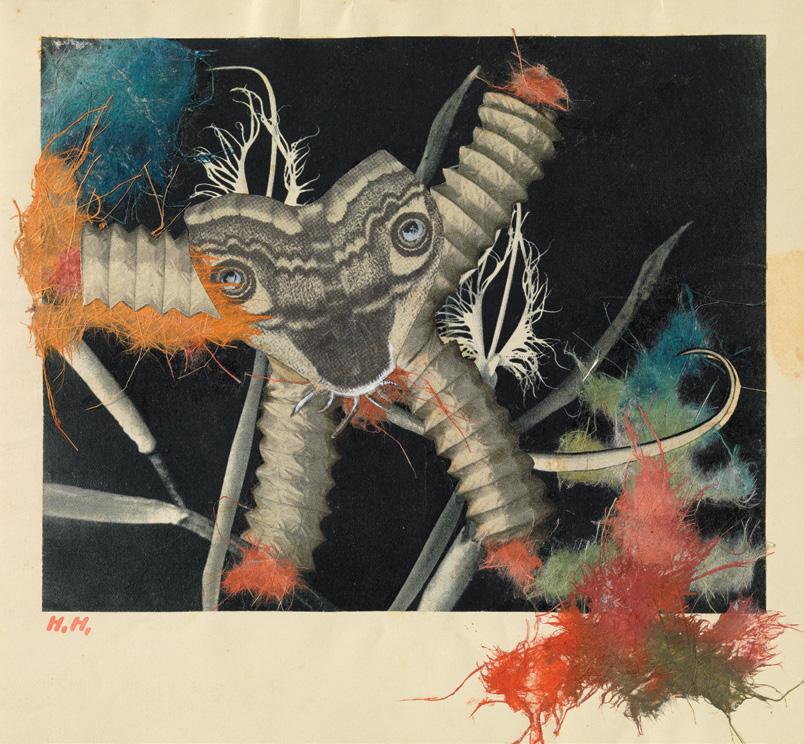
151 150 HOMO LUDENS FOCUS
ESSAY
Loftylara (Die Santaschwebe), 1945 in: Hannah Höch: Picture Book (Bilderbuch) , The Green Box, 2010 (first published in German in 2008)
the War was Over: Art in Germany 1945-1950]. The artist would not live to see the eventual publication of her work by Leipziger Reclam Verlag in 1985 (in a modest edition of 200), nor its English translation by The Green Box Berlin in 2010.
Höch’s exquisite use of colour was not the only reason for the hesitancy of the publishers. The texts are cryptic and the fables are pregnant with subdued societal criticism. Pitching her book in 1961 she wrote, ‘it is by no means intended to provoke’ but merely ‘made to bring some bread to the table’. The fact that publishers needed convincing is telling, if not proof of the controversial nature of her seemingly innocent imagery. Upon closer reading, the book is jubilant only in appearance; and a prime example of Huizinga’s observation that play can be dead serious. The accompanying poems by Höch feature feelings of dissatisfaction, escapism and alienation. Die Santaschwebe [the flying doe], for instance, much prefers to observe the world from high up in the clouds, rather than soil her dress with, well... reality. A montage from the same year which did not end up in the book shows an owl observing the world through
a magnifying glass. Such critical detachment is a metaphor for the secluded state Höch lived in during the war. Deemed a ‘cultural Bolshevist’ by the Nazis, the artist was forced to leave Berlin 1934, and retreated to a cottage in Heiligensee, where she remained in isolation until the end of the war. Her work during this period is marked by introspection and a mildly defeatist view of the world, both within and with out. The last words of the Bilderbuch read, ‘Life is quite languishing.’
That is not to say Höch’s subdued cynicism and opaque irony are not simultaneously light hearted and funny. As Schopenhauer aptly put it: ‘Humour is earnestness hidden behind jest. But when jest hides behind earnestness, irony emerges. (in: Die Welt als Wille und Vorstellung, p. 109) Through humour and irony, Höch employed play as a powerful tool to imagine alternative scenarios for a world she did not feel she belonged to. For a children’s book, her creatures display a remarkably unconventional stance towards normative tropes such as motherhood, marriage, domesticity and beauty. The book, like much of Höch’s work, can be read as an implicit criticism, not only of fascism, but also of constructed gender roles. Dumblet’s egg will not hatch the way she expected and ends up killing her dreams, while Unsatisfeedle was born with the wrong colour dress and lives out his days struggling to express his true nature. Such motifs can be traced directly to the artist’s personal life. From 1926 to 1929 Höch lived in The Hague with female Dutch author Til Brugman, a highly controversial living arrangement at the time. The artist remained childless and was the only woman to be (reluctantly) accepted into the male-dominated Dada circles.
Höch’s French contemporary Claude Cahun (1894-1954) also used playful bricolage to oppose fascism, capitalism and normative gender roles. Her photographically illustrated children’s book Le Coeur de Pic [The Heart of Spades] (1937), with poems by Lise Deharme, is suffused with snide anti-fascist and anticapitalist references. In 1932 Cahun had joined the Association des Écrivains et Artistes Révolutionnaires (AEAR), an association of artists with communist sympathies. Despite her expulsion from the party in 1933, Cahun kept resisting fascism as part of the Surrealist group Contre Attaque which she co-founded in 1934. Le Coeur de Pic was published in 1937 (the year follow-
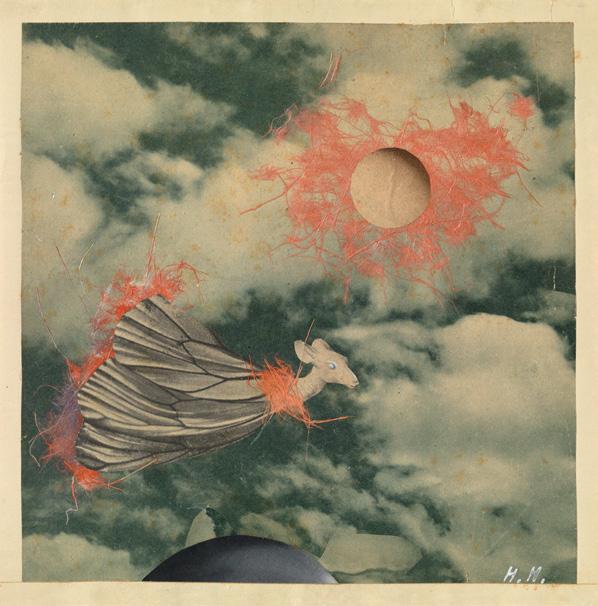
ing the election of the Popular Front) by the prestigious French publishing house José Corti, and reissued in 2004 by Éditions MeMo. The book was among the items taken from Cahun’s house upon her arrest by the Nazis in 1944.
Children’s book or not, no photograph of Cahun is ever innocent. Her figures are typically androgynous and her ‘women’ are often constructed from awkward inanimate dolls, mannequins, puppets and other products created for mass consumption. For Cahun, the everyday object embodied desires and power structures that needed to be ‘domesticated’. A literal reading of her image of a bell jar containing a hammer and sickle, a five-pointed soviet star and the word ‘histoire’ may be difficult to extrapolate, but the ensemble illustrates a concern with the politics of gender, sexuality, class, and labour that are unconsciously embedded in the everyday. To accompany the exhibition of her photographs at the 1936 Surrealist exhibition at Charles Ratton Gallery in Paris, Cahun published a text with the ominous title Prenez Garde Aux Objets Domestiques [Beware of Domestic Objects].
A MANIFESTO FOR FREEDOM: THE REVIVAL OF HOMO LUDENS IN THE 1960S
In the cryptic fables of Höch and Cahun, playfulness proves empowering at a time of political, social and psychological oppression. It is through play that we can reinvent a reality outside of ordinary life and redefine the rules by which we abide. In essence, play is the freedom to imagine the world differently. ‘Here, then, we have the first main characteristic of play: that it is free, is in fact freedom.’ (Huizinga 1938, p. 8) It is here that we can pinpoint the renewed appeal of Huizinga’s credo in the counter cultural circles of the 1960s. When Masahisa Fukase published his visual counterpart Homo Ludence in 1971, it presented a way of living that rocked the very core of rigid traditional Japanese society. We see his wife and muse Yoko bantering and smoking in her wedding gown, performing in the streets of Tokyo, or posing sensually in the intimacy of their own home. The images breathe her wild energy and dismiss all conventions around traditional femininity in Japan. As such, the associative sequences present a manifesto for playfulness as freedom.
153 152 HOMO LUDENS FOCUS ESSAY
Unsatisfeedle (Der Unzufriedel) , 1945, in: Hannah Höch: Picture Book (Bilderbuch) , The Green Box, 2010 (first published in German in 2008)
It is through play that we can reinvent a reality outside of ordinary life and redefine the rules by which we abide. In essence, play is the freedom to imagine the world differently.

155 154 HOMO LUDENS FOCUS ESSAY © Hans Bol
The renewed reading of Huizinga’s study, appealing to the power of play as a catalyst for societal change, was also picked up in The Netherlands. In the course of the 1960s, Amsterdam became the ‘magical centre’ of happenings and a thriving counter culture. Homo Ludens became the banner under which anarchist movements such as Provo plotted their playful yet provocative antiestablishment happenings. Feminist movement Dolle Mina [Mad Mina] was a case in point, using playfulness and humour to curb public opinion in favour of emancipatory legislation. They set fire to corsets, whistled at men in the streets, barricaded urinals with pink ribbon, and occupied public squares and government buildings with pop-up kindergartens. The events were highly photogenic and inspired feverishly mediatised ‘second wave feminism’ in The Netherlands.
Provo and Dolle Mina proved that playfulness could be a powerful weapon in generating public goodwill and pressuring governmental reform. Photography played a key role in mediatising such playful anarchism. A 1978 leporello of nine unfolding postcards with images by Eva Besnyö (who had herself become a ‘Mina’ at age 58) revisits major moments in the battle for the legalisation
of abortion. The leporello is a direct response to a 1978 draft bill that further complicated abortion beyond 12 weeks of pregnancy. Here, Dolle Mina unleashed a spamming campaign, flooding politicians’ letterboxes with their demands and mailing 60,000 cards to government officials.
Whereas the medium of photography, and photomontage in particular, had enabled Modernists and the Russian Constructivists to devise elaborate utopian worlds, come 1970 it served the fantastical musings of hipsters, eccentrics and activists. Huizinga would likely have been pleased to see that playfulness and humour were no longer artistic taboos, but celebrated stylistic elements. In Dutch counter cultural circles, play reached a high point in the work of Cor Jaring (1936-2013), the unofficial chronicler of ‘happening’ Amsterdam. Armed with his camera and his ‘magical press helmet’ he was present at every notable performance in town. Jaring became the visual spokesperson of anarchist Amsterdam with his images of the Provo movement and performances by cult figure Theo Kley, bundled in the playful yet political manifesto Moeder, wat is er mis ... met deze planeet [Mother What’s Wrong ... With this Planet] (1970).
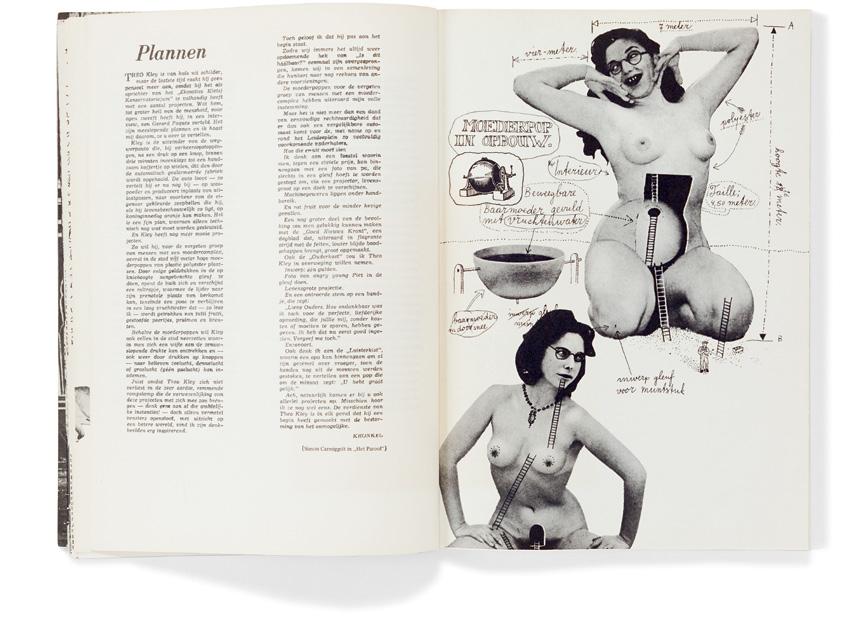

157 156 HOMO LUDENS FOCUS ESSAY
↑ ↘ © Hans Bol
Jaring became the visual spokesperson of anarchist Amsterdam with his images of the Provo movement and performances by cult figure Theo Kley.
The publication is a doctor’s prescription for a better world. The cover features Theo Kley in white scrubs, wringing his hands and frowning over the rim of his spectacles about the abominable state of the earth.
Kley was a figurehead in the 1970s Amsterdam counterculture movement. His ‘deskundologisch laboratorium’ [expertologist laboratory] proposed creative and environmentally friendly alternatives to the confines of the middleclass. Solutions ranged from disposable cars that ran on washing powder to selling off The Netherlands as a ‘finished product’. The book includes designs for foldable cars with Gothic facades, and a giant surrogate mother with an accessible womb that was to be placed in public squares. Cut out models of Amsterdam landmarks allowed the elderly or impaired anarchists to participate in the protest marches from their own homes. Cor Jaring invariably photographed performances of Kley’s illustrious musical collectives: the Exotic Kitsch


Conservatory and the Insect Sect. Jaring’s images show Kley marching through the streets of Amsterdam with a cacophonic troupe — which included local characters Max Reneman and Huub Mathijsen — crashing official events whilst playing homemade instruments. The Insect Sect protested the use of pesticide and oil dumping by staging their Butterfly Opera on industrial sites or contaminated farmlands. Costumes were constructed from recycled trash that was scavenged from the garbage dump. Jaring’s photographs of Theo Kley in a meadow wearing a gas mask and feelers, or flapping his ‘immune blue’ wings amidst a herd of cows, present a bizarre yet effective lamentation of the state of the earth. Naturally, Jaring stood by the bed of Yoko Ono and John Lennon as Theo Kley pronounced them honorary members of his Insect Sect during the BedIn for Peace at the Amsterdam Hilton Hotel in 1969.

159 158 HOMO LUDENS
FOCUS ESSAY
↑ ↘ © Hans Bol
THE REBIRTH OF PLAY IN PHOTOGRAPHY
Despite his dismissal of the arts as inherently unplayful, Huizinga acknowledged the power of the image to imagine. He writes in his opening statement, ‘If we find that play is based on the manipulation of certain images, on a certain “imagination” of reality (i.e. its conversion into images), then our main concern will be to grasp the value and significance of these images and their “imagination”.’ (p. 4) It is here that we can identify the medium of photography as the missing link between art and play. Granted, the photograph itself is static and incapable of playful action. However, it is capable of reproducing action and has been an important catalyst for performance and playful protest since its inception. The children’s books of Zwart, Cahun and Höch, and the resuscitation of ‘playing man’ in the work of Besnyö and Jaring, testify to the transformative power of play in photography. Though Huizinga was convinced that play had died along with the Baroque, it seems to have found new life with the advent of photography.
The texts about Het boek van PTT and Moeder, wat is er mis ... met deze planeet were adapted from the book 1/100 Dutch Photographic Publications from the Wingender Collection (2016) by Hinde Haest.
160 FOCUS ESSAY
MICKALENE THOMAS

Collages
161

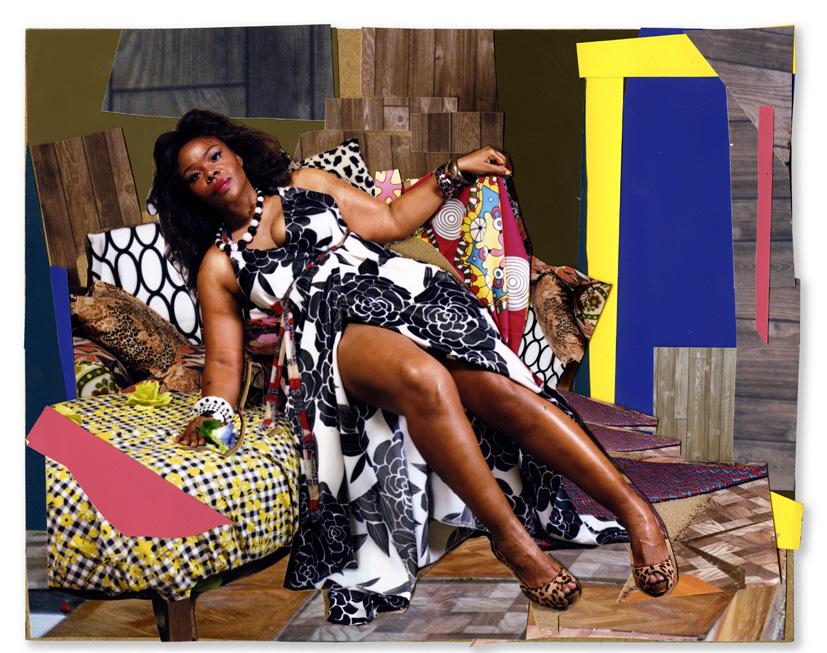
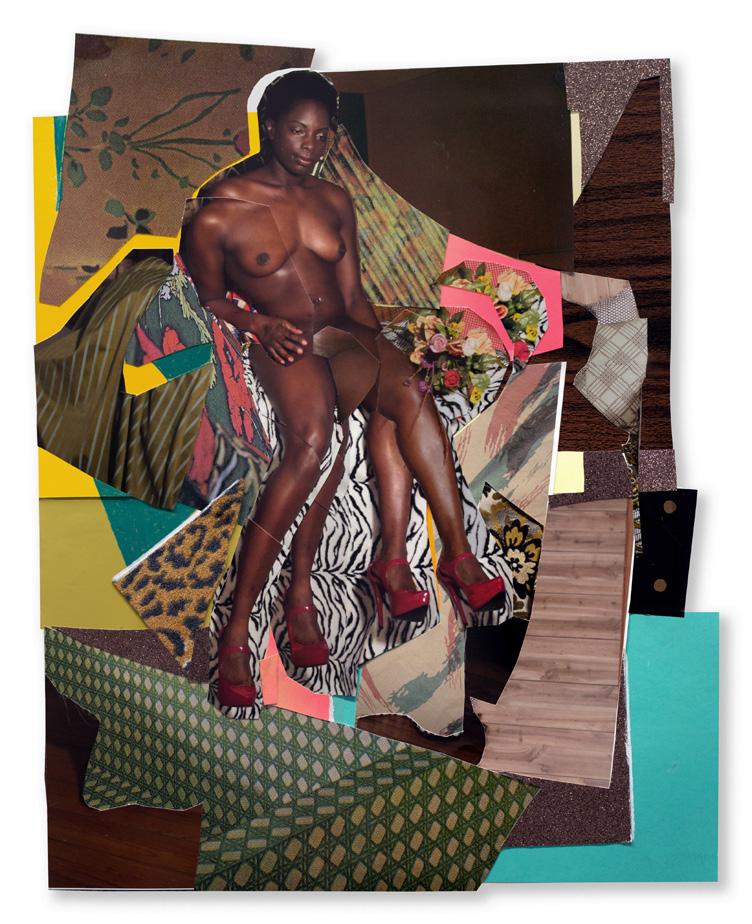

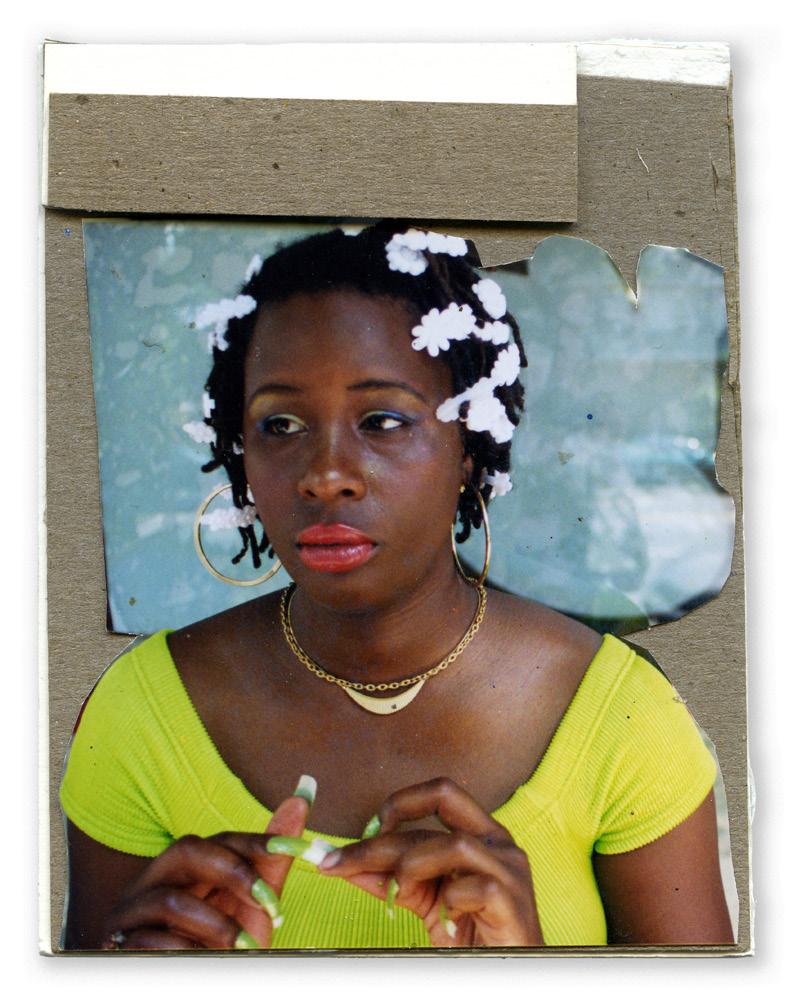
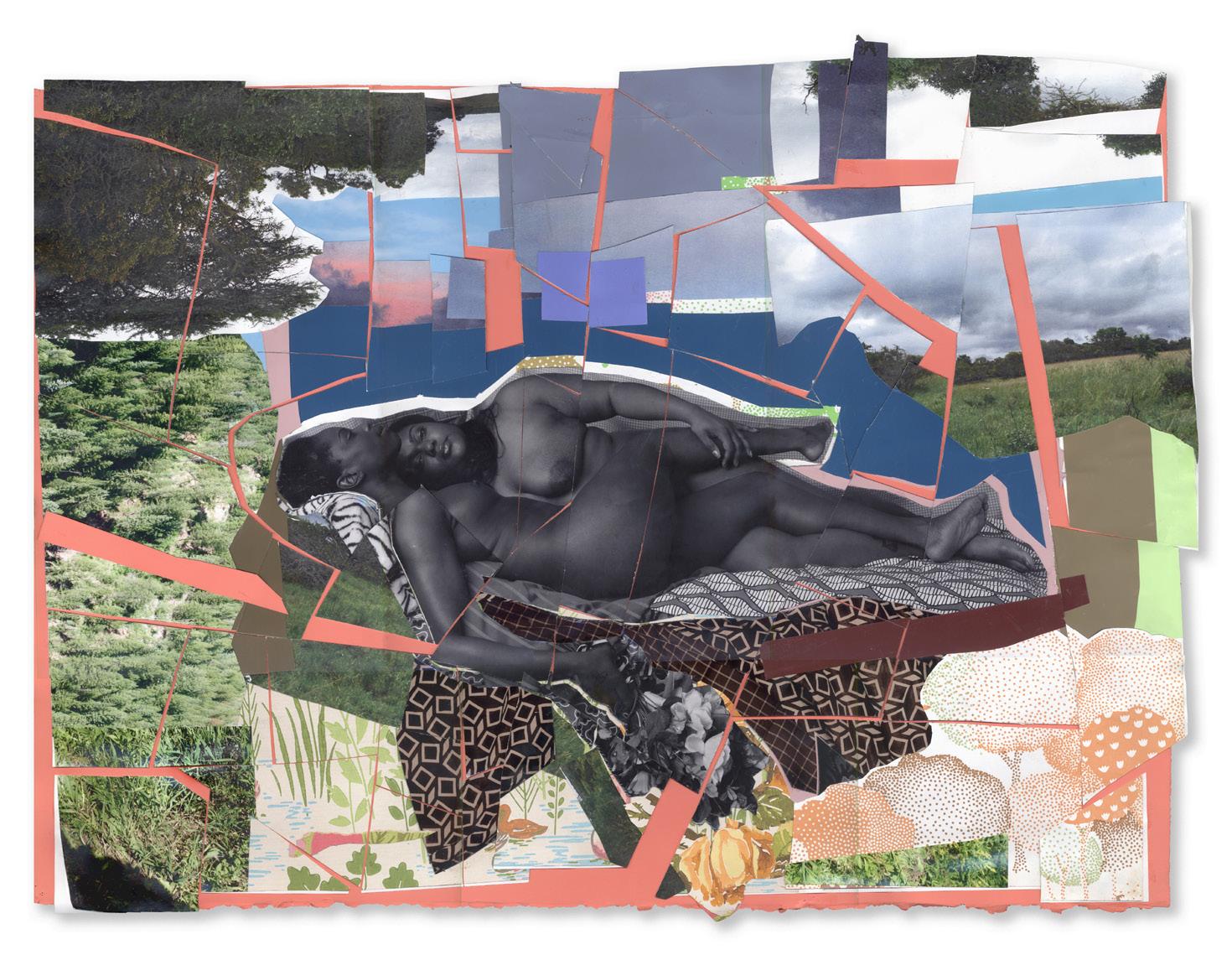
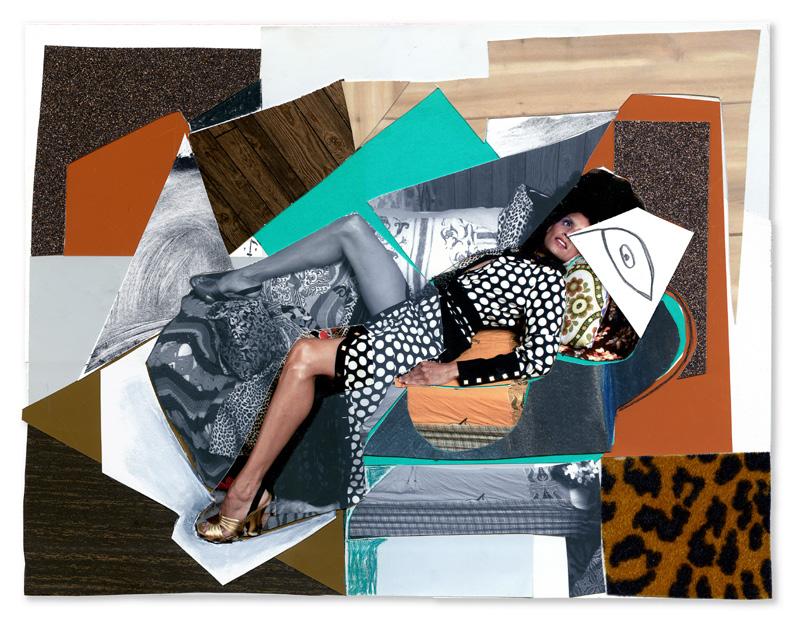
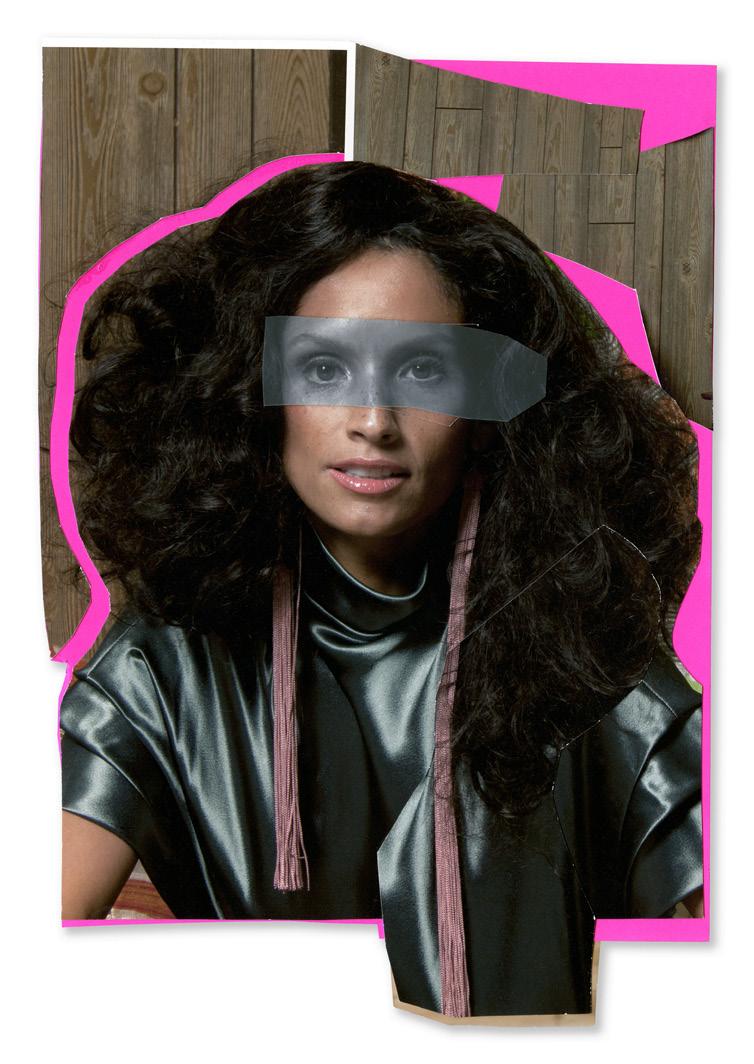

Collages
Last April, I invited a group of black women artists and scholars to attend the Frida Kahlo exhibition at the Brooklyn Museum. Afterwards, Mickalene Thomas invited us to her studio. Her workspace was vast and divided into the many facets of her identity: the administrative wing was followed by an open-air room for her large scale paintings and collages, which then curved into her printmaking area. But even the first floor of a Dumbo warehouse building could not contain Thomas’ multitudes: her famed photoshoots take place upstairs.
As we toured her art making space, we were mesmerised by the variety of these larger-than-life images. As we neared the end of our visit, I asked her about the collage that she recently made and opens ‘Toni Morrison: The Pieces That I Am’, a documentary on the famed author’s life.
In response, Thomas casually walked over to her file box and pulled out bits and pieces, a flower, a cut of cloth, and a fragment of a black-and-white photo. ‘I keep everything’, she says. ‘I never know when I might use it again.’ And then I realise these remnants are not scraps, but rather betray the secret of her genius.
‘So, you actually think in collage don’t you?’, I ask, bewildered.
‘Yes.’
Thomas plays with layers. She covers up one part of an image, only to reveal or recreate another. Moving between seductive odalisques, mixed patterns, sketches, and photograph cutouts, Thomas’s paintings end up being both panoramic and profoundly intimate. The result is a mixing of histories and a series of witnessing: the viewer stares at Thomas’s many black female muses, figures who, in turn, appear to revel in being watched but more importantly, derive great pleasure in their own gaze. The voyeur is us. The seer is her. And of course, Thomas herself.
It was at the opening of her show, Femmes Noires in Toronto last December that I first heard Thomas discuss the influence of French psychoanalyst Jacques Lacan’s theory of the ‘mirror stage’ on her work. But the influence has been ongoing. ‘To see yourself, and for others to see you, is a form of validation’, she said in a 2012 interview. ‘Those philosophical notions of Lacan relating to the mirror are so deep, in the sense of “I see you, therefore you exist.”’
Decades later, however, Lacan came up with another theory, ‘There is jouissance beyond the pleasure principle.’ Here, Lacan described what he believed was our intrinsic need to push past the boundaries
of pleasure imposed on us as well as the ill-fate that befalls us when such transgressions turn our enjoyment and amusements into pain. For Lacan, prohibition is inevitable; pleasure is known only through its limits.
Thomas’s paintings refuses such restraints. Her use is much closer to feminist writer Hélène Cixous’s retort in which she saw women’s pleasure as an ‘explosion, diffusion, effervescence, abundance’ and one that ‘takes pleasure in being limitless’. Suffering comes from the suppression of jouit, not in its release. And when Thomas infuses her black female subjects with such jouit and agency, it is hard to imagine that beyond their straightforward gaze lies anything but more pleasure, and by extension, more power.
Of the collage, Thomas once opined, ‘It’s a metaphor, something you can’t and shouldn’t always define, but you know it when you see it.’ For Thomas, there is no form more subversive than collage to capture the complexity of black women’s sexuality and socio-political identities. And for us, there is no artist better suited to giving us back the gift of ourselves.
 — Text by Salamishah Tillet
— Text by Salamishah Tillet
HILLARY TAYMOUR Radical Transparency
176 MICKALENE THOMAS 177 CHARLIE ENGMAN &
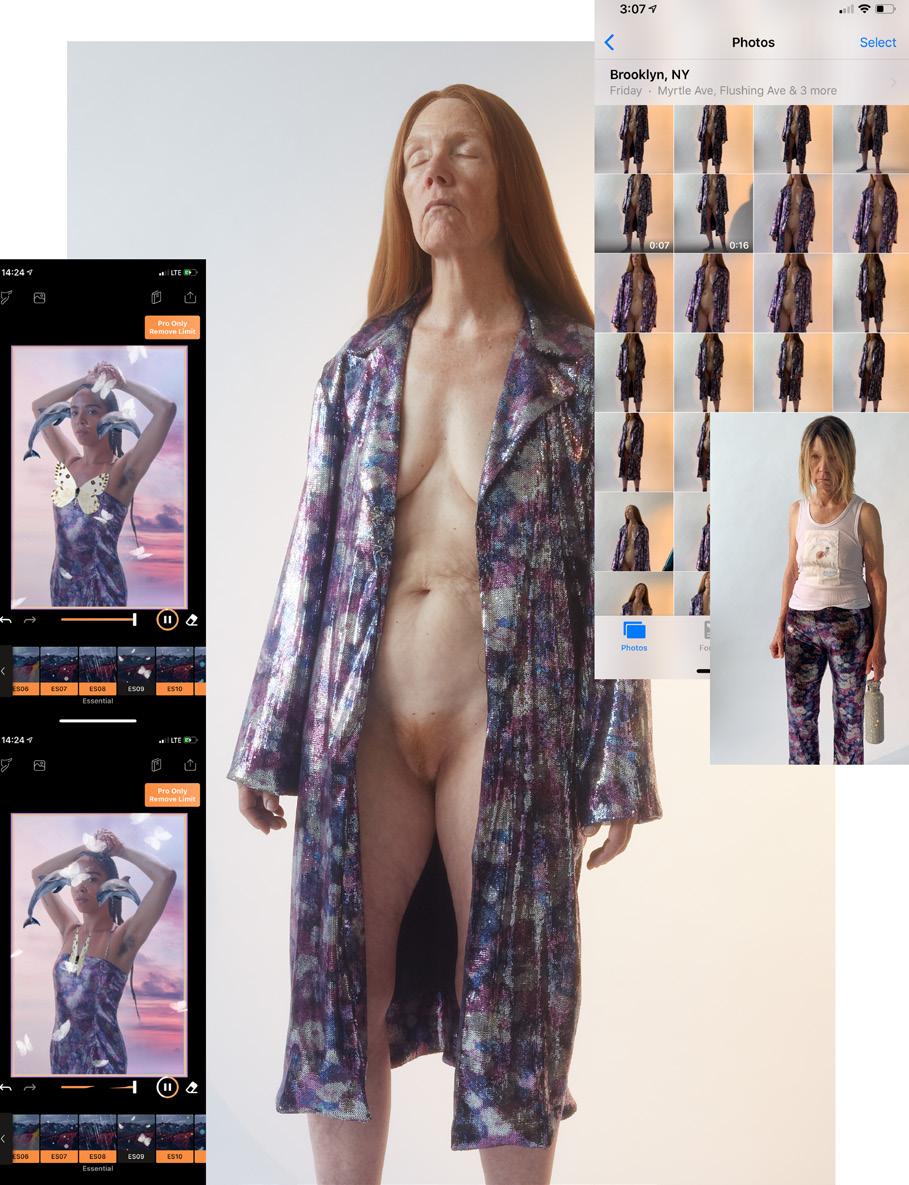
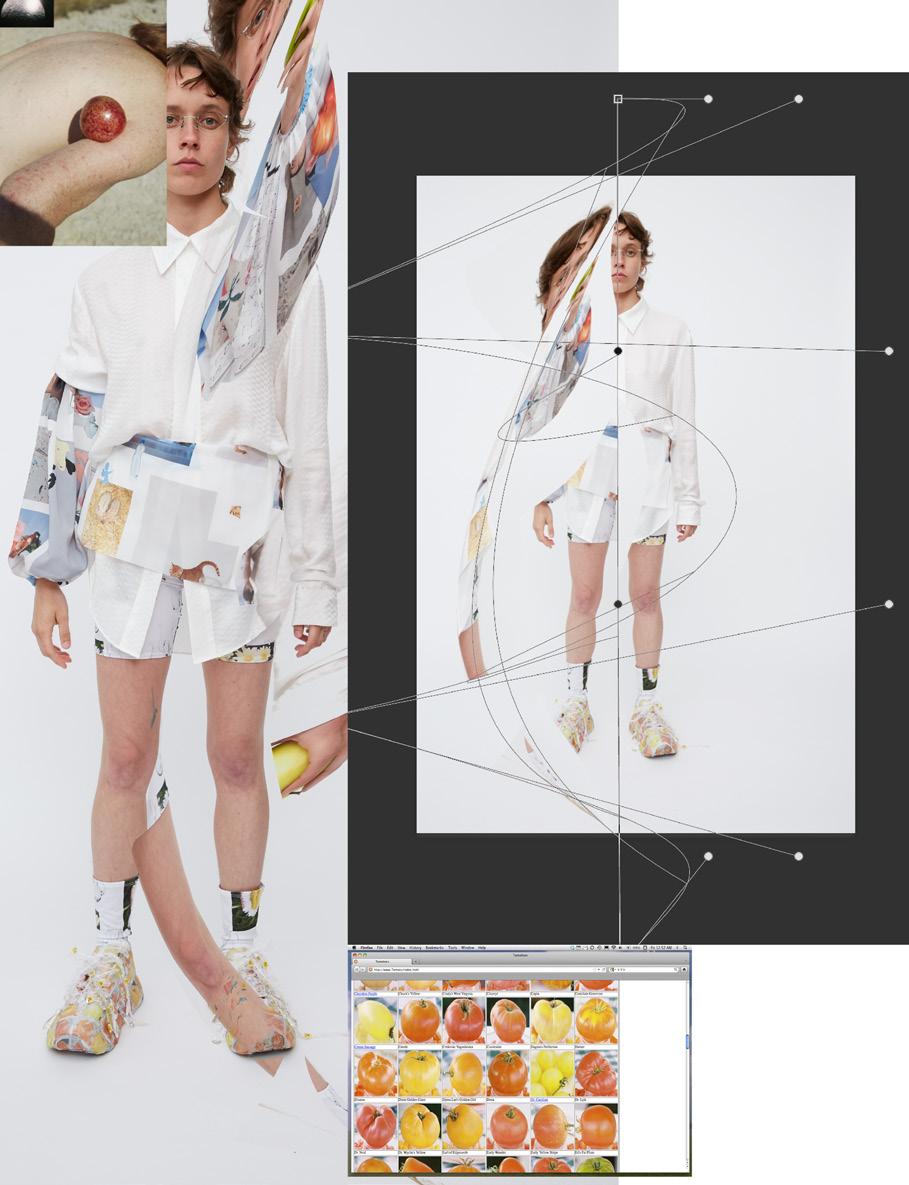

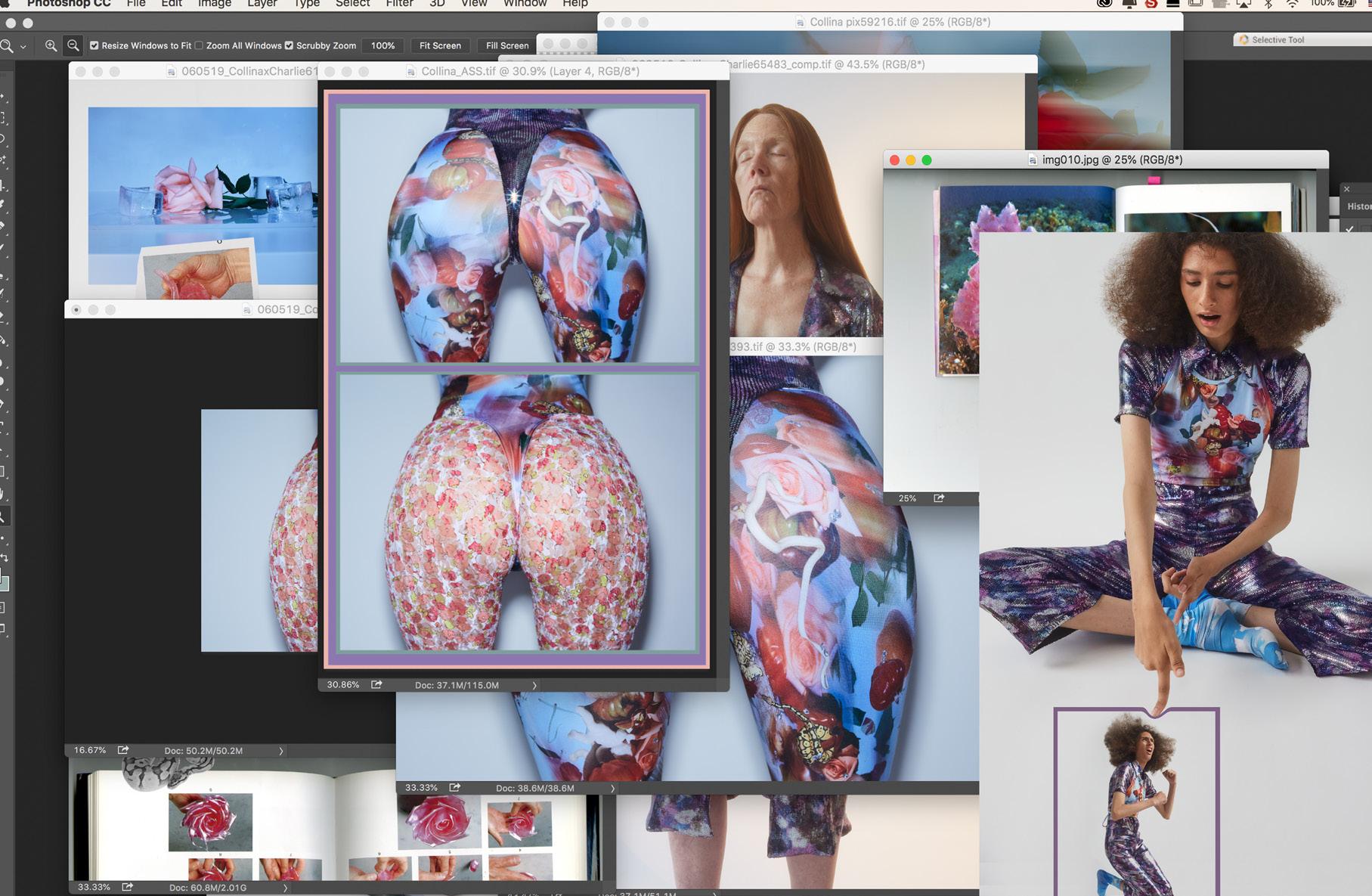
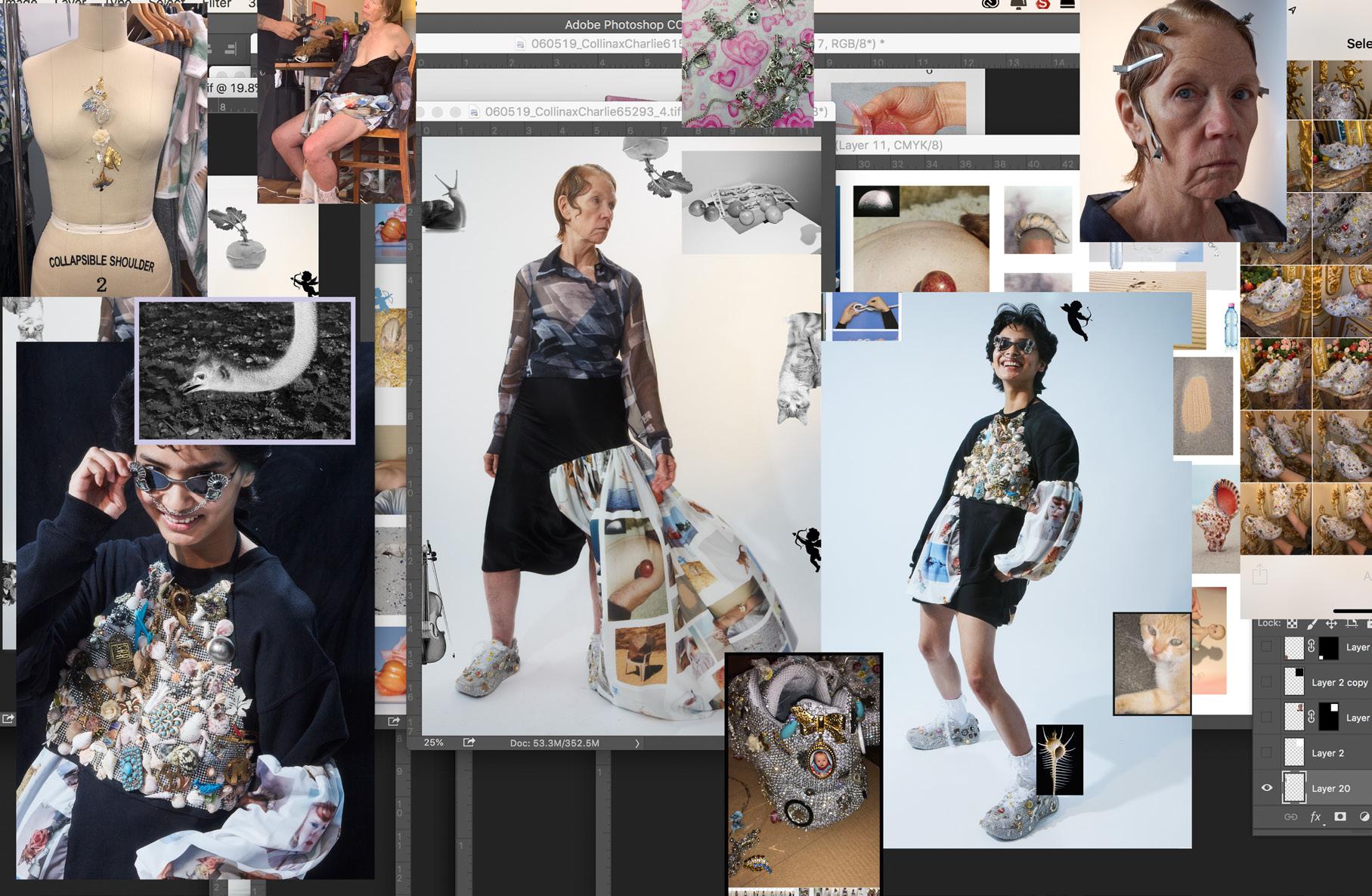

CHARLIE ENGMAN & HILLARY TAYMOUR
CAMILA FALQUEZ Féminas
He’s best known for his photographs, but Charlie Engman is a multi-disciplinarian through and through. ‘Photography has never been the ending point,’ the Chicagoborn image maker explains. Rather, ‘it’s an access route to other things.’
Case in point: Engman was a dancer and a painter in his teens and early twenties, and studied Japanese and Korean at Oxford University. Ten years ago he moved to New York, and it was there, searching Craigslist for internships that would allow him to learn to pattern cut and sew, that he discovered Hillary Taymour, the founder and creative director of fashion brand Collina Strada. He applied right away.
At that time, Taymour’s brand had already made a name for itself as a socially aware entity. First it created handbags, and then ready-to-wear items. ‘We had a very brief, informal interview process, and that was the beginning of the whole saga,’ says Engman. While the internship was shortlived, it did culminate in his producing all of Collina Strada’s visuals for several years to follow. The pair have been collaborating ever since.
For the brand’s Resort 2020 collection, this ongoing back-and-forth reached a new apex: they worked together on a whole
Radical Transparency
season of pieces their individual influences, ideas, and image archives colliding in a bold, bright extravaganza. The idea for the collection was born when Taymour found herself at Engman’s house, watching her friend struggle to sew photographs onto his clothes. ‘I was like, “You can’t even sew a straight line!”’ she laughs. ‘I helped him for a second, and then I got bored. I said, “can we just go to my studio and make things legitimately?”’
‘We’d both always had fingers in each other’s pies,’ Engman continues. Creating clothing together was a natural progression. ‘For me, the collection was a space to play,’ he says and out of their shared willingness to do so experimenting, bouncing off one another, making mistakes and finding new opportunities in their solutions comes a joyful synthesis of two worlds.
Take, for example, the Sistine Tomato print, ostensibly the hero of the collection. Rhinestones, roses and babies (both real and caricatured) all feature in a vibrant and dynamic cacophony of imagery the pair made together in the studio. They then built this, layer by layer, into a repeatable pattern which could be printed onto fabrics and made into garments. Meanwhile
in the lookbook, Taymour and Engman’s creative synthesis is even more evident; over the course of four days they captured their respective muses in their pieces, playing, posing, laughing. Engman’s oftphotographed mother is, of course, a key character.
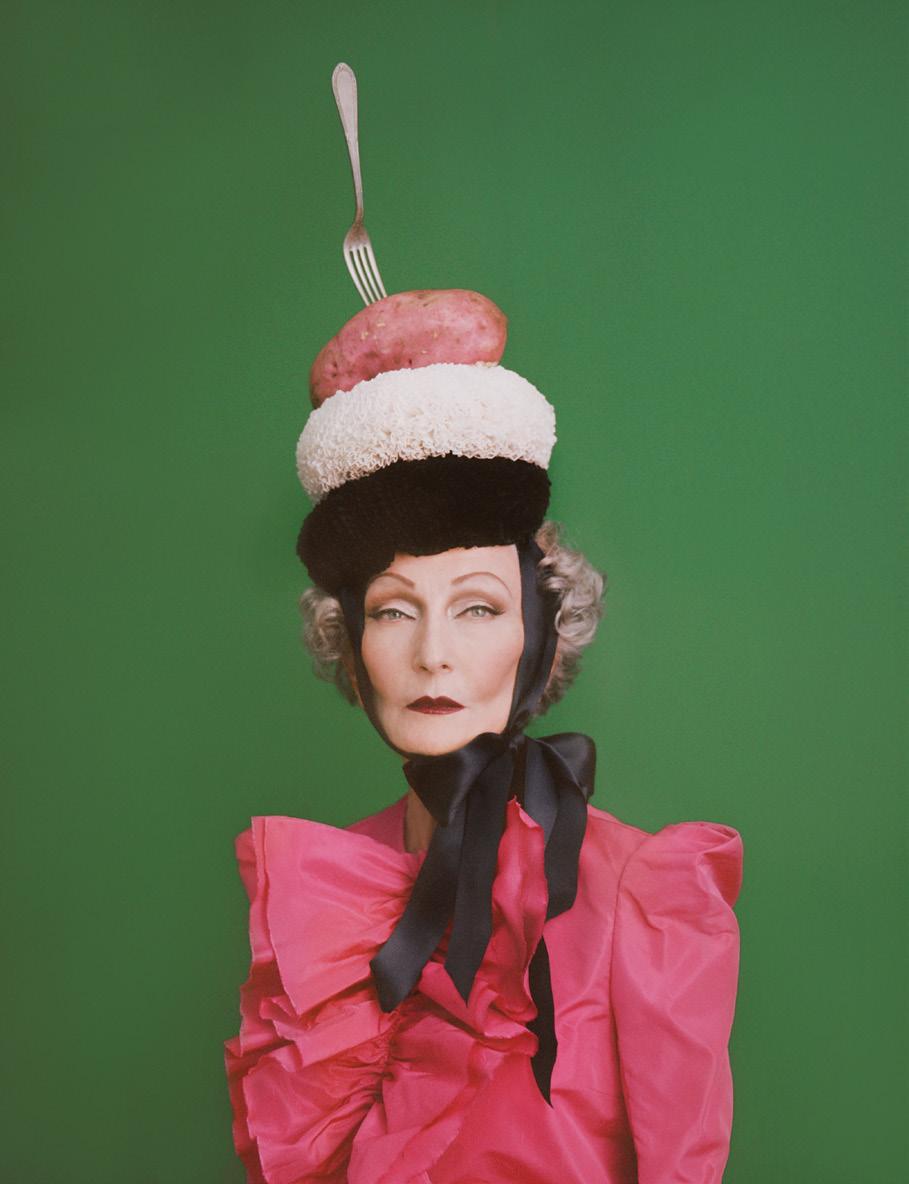
But while both the collection and the lookbook is underpinned by what Engman calls ‘goofiness and irreverence’, this playful delivery serves as a Trojan horse for more serious themes. Sustainability and social awareness have always been at the core of Collina Strada: the brand uses deadstock fabrics and recycled materials wherever possible. Everything is made locally in New York’s garment district; it advocates passionately for transparency, in an industry whose infrastructure does not lend itself to that.
‘It’s about trying to do our best, and being as ethical as possible,’ Taymour says modestly. In both medium and message, Collina Strada demonstrates that it’s possible for fashion brands to confront the issues threatening our future, and to have fun all the while.
— Text by Maisie Skidmore
188
189
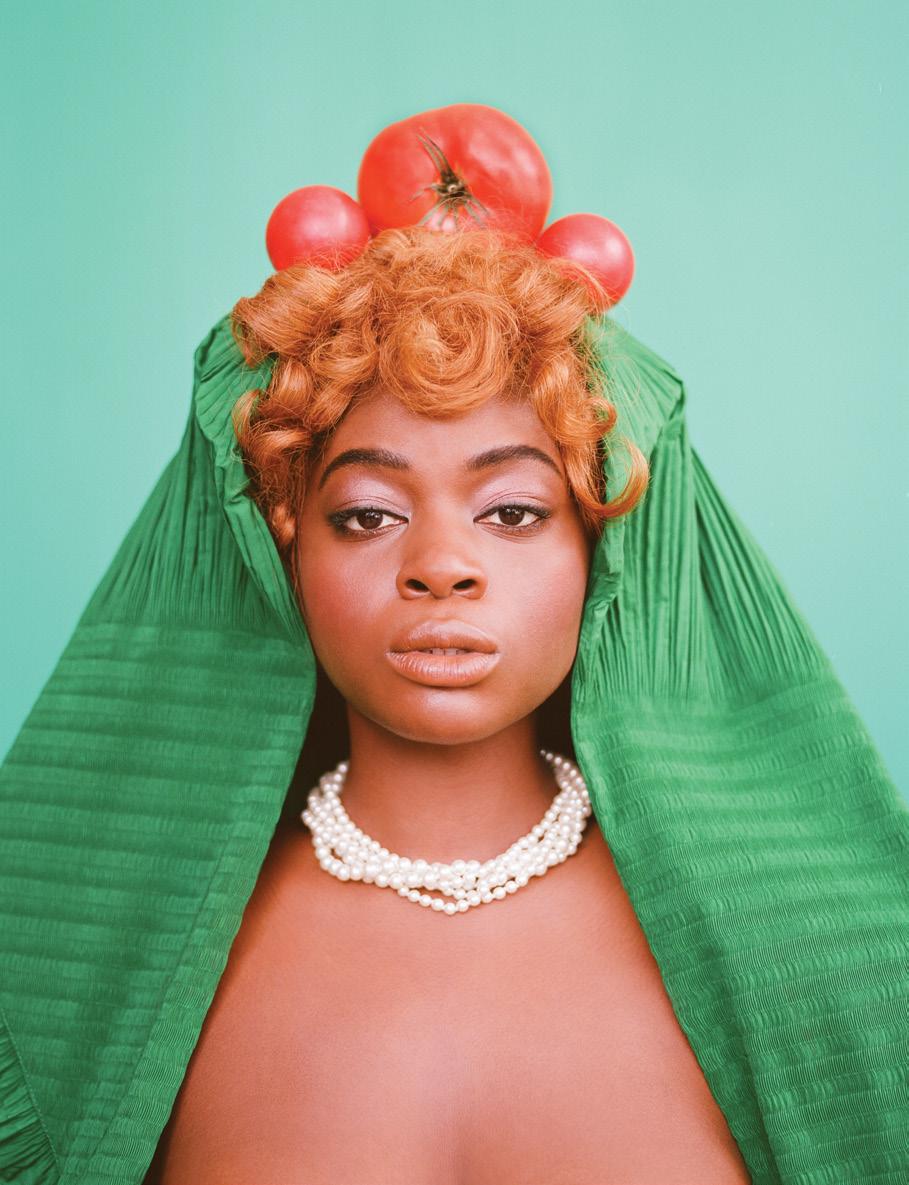
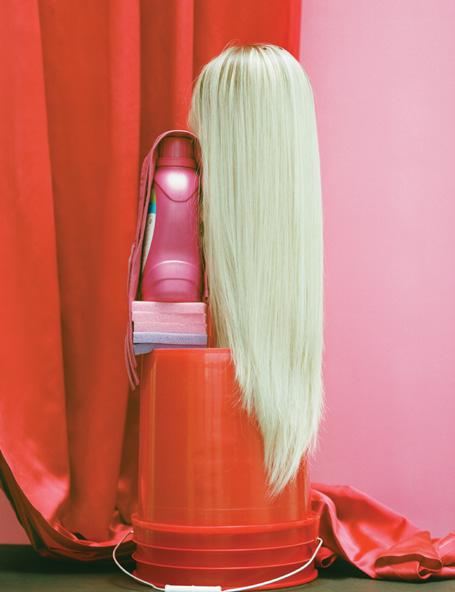

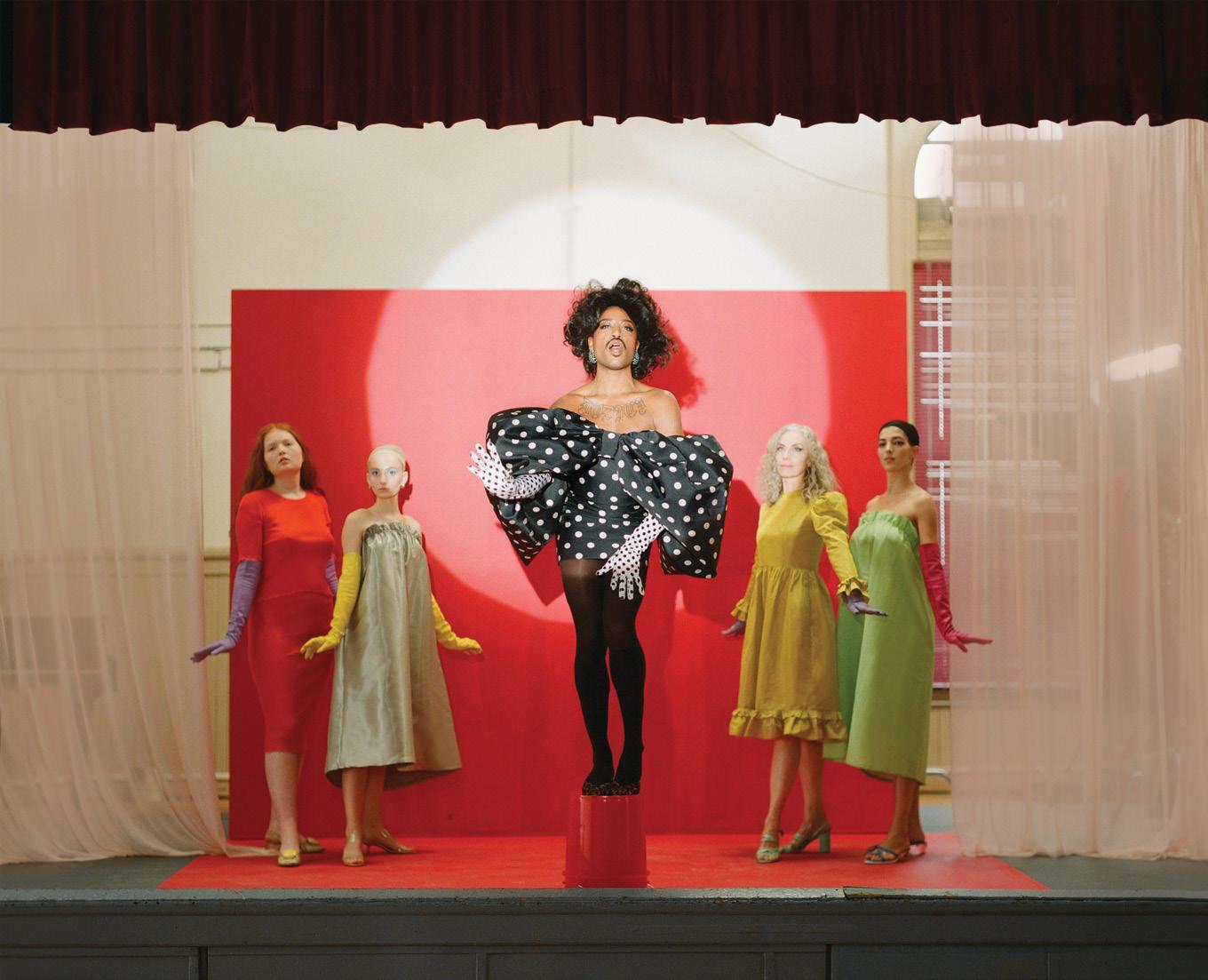

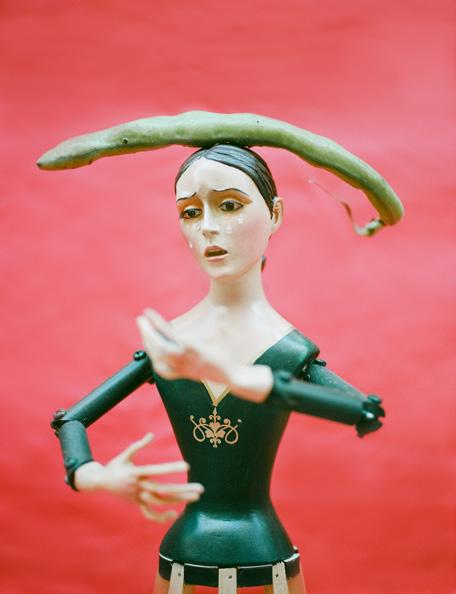
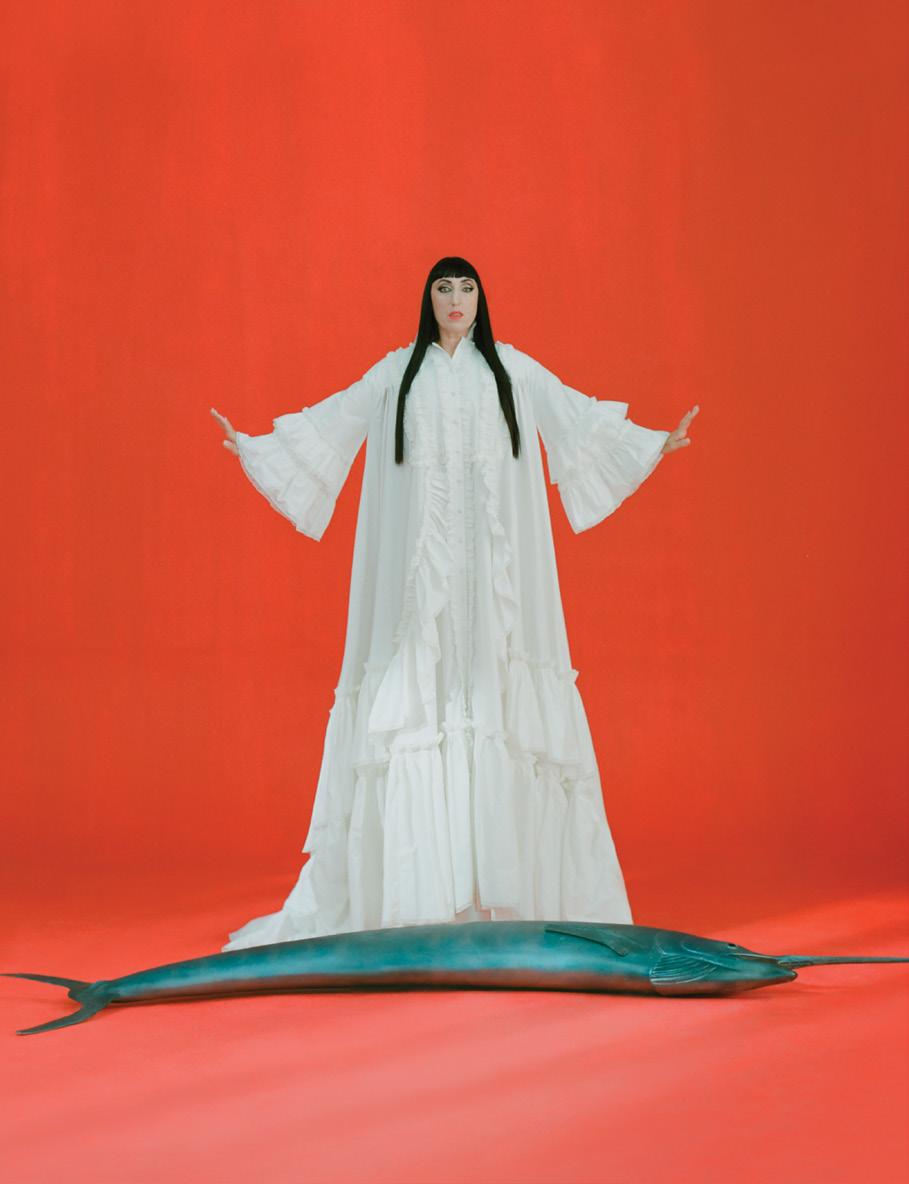

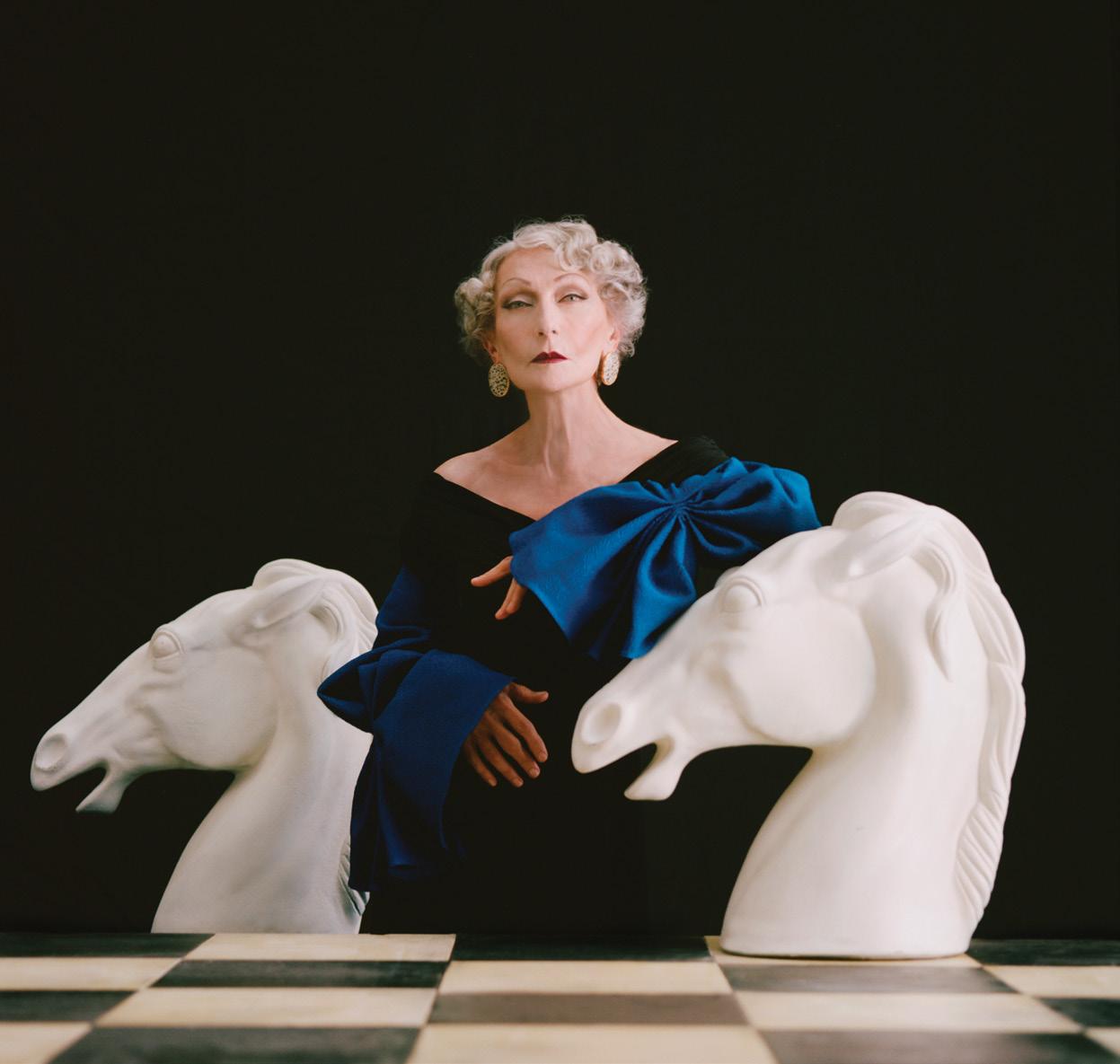
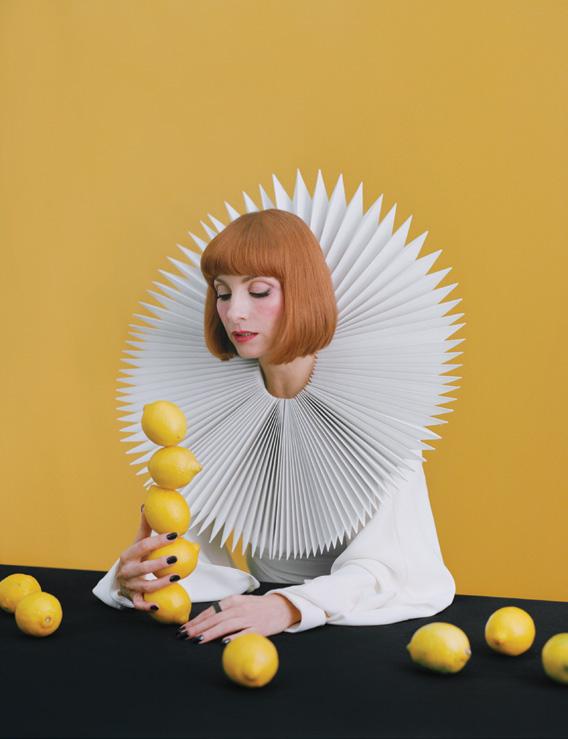
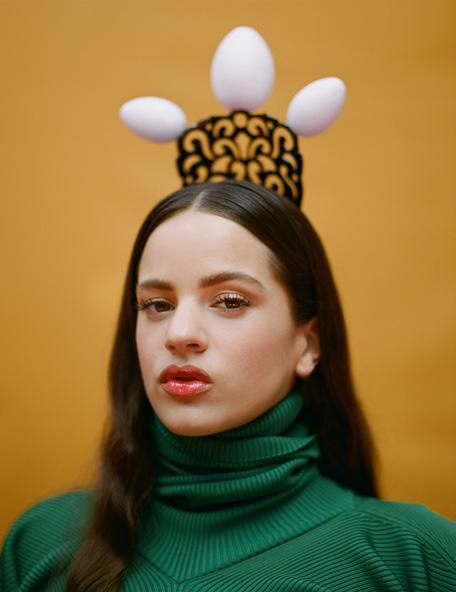
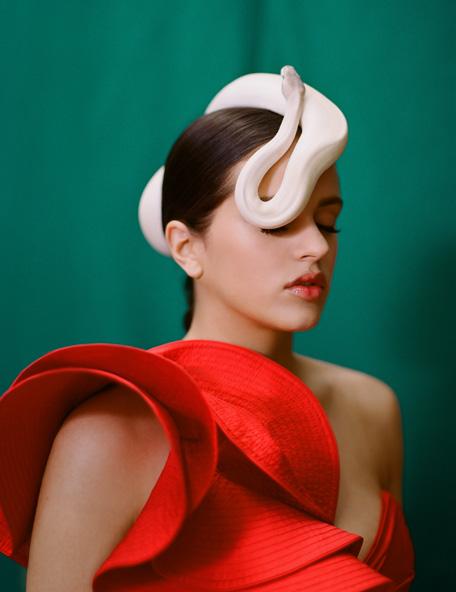

Féminas
Interviewing David Wojnarowicz, Nan Goldin famously asked him what he would like his work to do and David replied, ‘I want to make somebody feel less alienated that’s the most meaningful thing to me.’
The intentionality of the artist has never been more important (and more scrutinised) than today, especially in fashion photography, whose role and impact in shaping our desires and ideas of beauty has significantly grown very much so thanks to its capillarity in the new media.
That’s why an artist like Camila Falquez, who is not only socially conscious but also aware of the immense power and reach of fashion imagery is so relevant, ‘Fashion is intrinsically aspirational, so if you channel that longing in new directions, ones that are healthier and more inclusive, you really are helping the world. Not feeling this responsibility is not an option.’
Falquez has been an immigrant her whole life: she was born in Mexico to Colombian parents and when she was seven she moved to Spain. A dancer at heart, she studied Philosophy and Communication before landing a job as The Sartorialist Scott Schuman’s assistant, thus starting her photography career. Since going solo and moving to New York, Falquez
has slowly but methodically developed her own visual language, merging a personal form of surrealism with a pastel color palette and an empowering gaze.
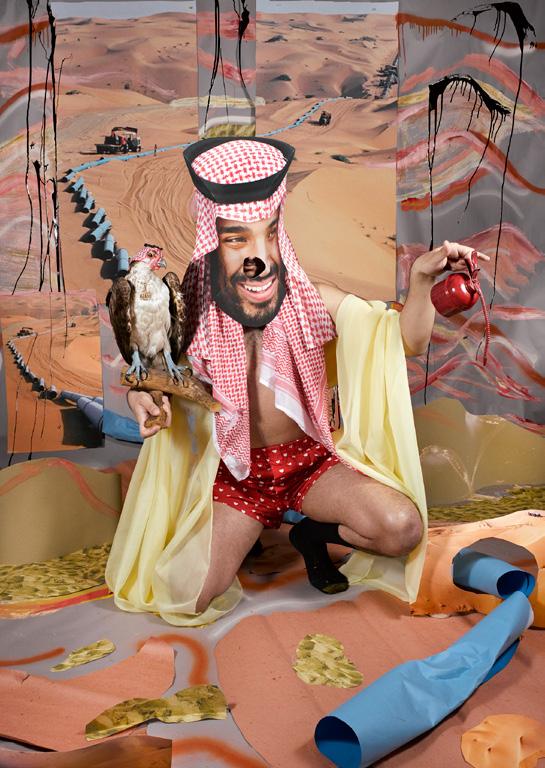
Falquez is tremendously concerned with representation, deeming it essential to highlight underrepresented communities in contexts where they feel beautiful, confident and regal. ‘I am obsessed with the idea of regalness, I want to create new images of this concept. In the very end, if you take out all the unnecessary bells and whistles, regalness is an attitude. You can look regal even carrying a potato on your head, if you feel so.’
Knowing very well what dancing means, Camila has a deep knowledge of how the body works and of how must be directed she knows how to release hidden tensions and how to bring out the performative potential dormant in everyone, ‘In my shootings it’s like we close the door and we work in a space with no gravity. Everyone becomes part of this shared universe we all contribute in creating, where we can become the hidden versions of ourselves, our most surrealistic personas.’
Las Vírgenes del Flamenco is an artwork in which flamenco dancers become holy virgins in the streets of Sevilla. In
Las Mujeres Que Hay en Mi, Falquez pays homage to all the women that made her who she is (and incidentally is the first cover of Vogue Spain ever shot by a Spanish woman). The Pedro Almodóvar tribute sees New York counterculture kids re-enacting iconic scenes of Almodovar’s movies. These are all exercises in exploring and expanding identities in an almost therapeutic process.
‘Even if none of my photos ever came out, I still would be happy because of that healing, magical thing that happens while shooting: it is so beautiful to allow someone to see themselves as they envision in their mind, that I could live even only for that moment of self-recognition. It’s something that gives me so much joy because it confirms an intuition I had all along: it’s so powerful to take photos.’
— Text by Chiara Bardelli Nonino
200
CAMILA FALQUEZ 201 SHEIDA SOLEIMANI
Medium of Exchange
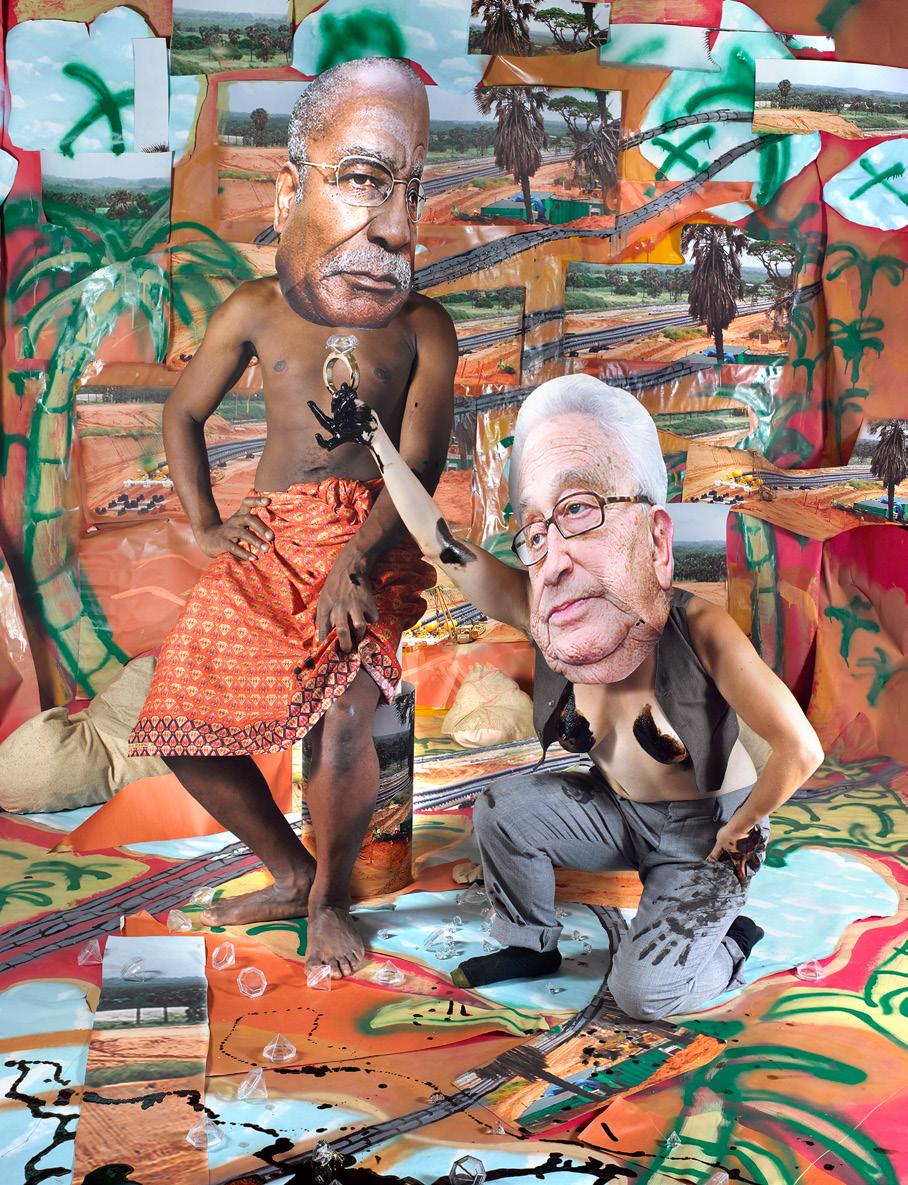
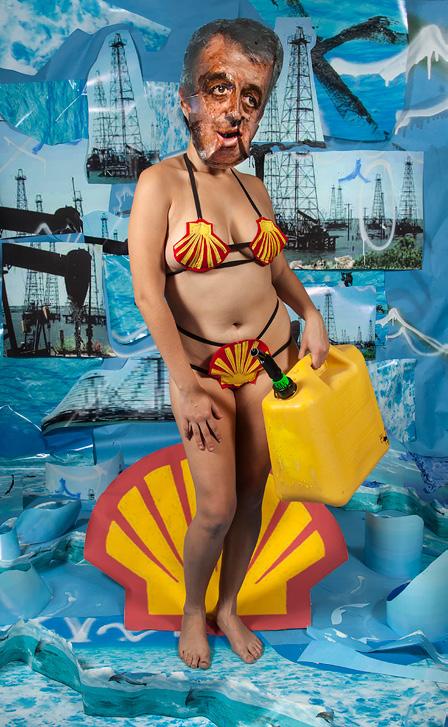



Medium of Exchange
Bobo dolls, ice cream eating contests, paper masks, and games of snap all seem unlikely forms for the representation of vulnerable bodies, let alone issues of state-sanctioned violence against women, the oppression of queer bodies, crony capitalism, trade cartels and environmental destruction. Yet the work of Iranian-American artist Sheida Soleimani often deploys absurdist play and performance to confound how we read gender and trauma in photographs. The complexity of what it means to represent the subjugated has led Soleimani to build lasting conversations with her subjects as a way to speak truth to power.
In To Oblivion, Soleimani worked with human rights lawyers and families of women who have been executed or disappeared for acts of dissidence in Iran. The work questions what publicly enacted violence against women inculcates in a society, while also shaping a portrait of an individual who has been systematically erased. The work manifested as a series of near life-size soft doll-like sculptures printed with found images of these women, alongside photographic works that referenced, through props and backdrops, the lives they led or how they died.
In her most recent series, Medium of Exchange, Soleimani is still working with
portraiture, but rather than looking at the victims of power, she turns her eyes to its brokers. Questioning the conventional representations of the Middle East in Western media, in which people and places are frequently seen as ruins, decimated by war and corruption, she focusses instead on the international networks, which Soleimani sees as complicit in enabling such destruction. The dominance of OPEC (Organisation of Petroleum Exporting Countries) in particular, skews relations between governments or supranational agencies such as the United Nations.
For Soleimani, power is a performance that is mostly enacted behind closed doors, which she echoes in private performances at her studio that playfully translate the machinations of geo-politics into staged sexual encounters. Devising scenarios from redacted documents and political speeches, Soleimani collaborated with some of her queer and femme identifying students from all racial backgrounds who volunteered to play the roles of various ministerial OPEC representatives and their Western counterparts.
Flirtatious, kinky liaisons take place between seemingly unlikely couplings such as the Minister of Energy, Industry with the Mineral Resources, Saudi Arabia
and the UN Secretary General in a BDSM inspired Dom/sub pose. Set against a DIY backdrop of collaged images of landscapes scarred by oilfields or mines, overpainted with graffiti markings and slicks of crude oil, the faces of her collaborators are hidden behind oversized paper masks of these powerful men who become the signifiers of otherwise faceless, impenetrable institutions. The crudely cut misplaced holes for eyes, nose, mouth in each mask evoke a Dadaist glee in the cut-up but also the violence in the act of disfigurement.
At first glance the works look like kitsch digital collages that draw on pop cultural tropes and celebrate the freedom to express sexuality and sexual practices within Western culture. The absurdity of these satirical scenarios both eroticises and infantilises the represented men. However, there is a seriousness at the heart of Soleimani’s work which addresses the very real issue of political disenfranchisement and what happens when a queer body wears the mask of power.
— Text by Maitreyi Maheshwari
Playground
The Project
Essay by Gabriela Burkhalter
SHEIDA SOLEIMANI
208 209 FOCUS ESSAY
‘I was completely swept off my feet by my first visit to the Emdrup playground. In a flash of understanding I realised that I was looking of something quite new and full of possibilities.’ (Marjory Allen und Mary Nicholson, MemoirsofanUneducatedLady.LadyAllenofHurtwood, London 1975, p. 196.) This was the English children’s rights activist Marjory Allen’s first impression on seeing Carl Theodor Sørensen’s Skrammellegeplads (‘junk playground’) in Emdrup, Denmark, in 1946. I had similar moments of great astonishment as I learned more and more about the (almost nonexistent) history of playgrounds. What at first seemed like an insignificant niche turned out to be a realm of public experimentation, and something for both adults and children to project their desires onto — in short, playgrounds were and still are sites of subversive potential.
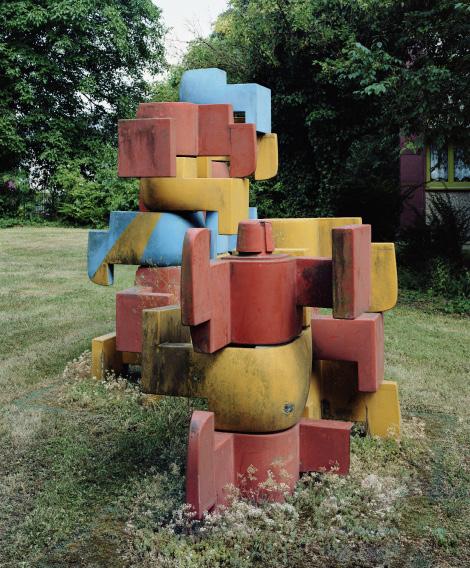
The playground is a byproduct of the industrialised city of the 20th century — and it continues to be both an ugly duckling and a coveted space. A focal point for ideas about education and childhood, urban planning and public space, architecture and art, creativity and control, the playground has repeatedly resisted institutional and ideological appropriation and grown in its own sometimes quite anarchic ways. Still, as hardly anyone sees playgrounds as part of their cultural heritage, much of their history has been forgotten, and many playgrounds of artistic and historic value have been destroyed.
At the end of the 19th century, playgrounds existed in the industrialised cities of England, Germany, and the United States. They were meant to promote public health, to prevent criminality, and to supervise children and protect them from the dangers of the city. In American cities like New York, immigration and industrialisation created catastrophic living conditions, which were decisive in the development of playgrounds. As child labour began to be regulated at the beginning of the 20th century, the issue of what children should do with their free time grew more and more urgent, with many children from the working class being completely unsupervised during the day.
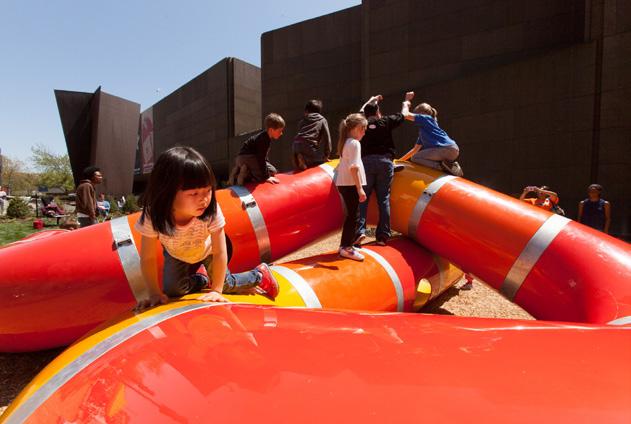
The American playground movement had begun in Boston in 1868, when a German model inspired the creation of a sand garden for children to play in. Encouraged by developments in Boston, philanthropic groups in other cities — New York, Chicago, Philadelphia — took up the cause in a fight against poverty and neglect that was also meant to influence the education and socialisation of children and teenagers. The playgrounds were so successful that in 1903 the Parks Department opened the first playground financed by the city itself, Seward Park on the Lower East Side. New York now took the lead among American cities in playgrounds and recreational facilities, establishing them both in parks and on school grounds.
Robert Moses (1888–1981), New York’s Parks Commissioner radically changed the city by building streets, bridges, and public parks, as well as facilities for sports, recreation, and play. He standardised the design of playgrounds and established play areas all over the city, with 20 new playgrounds in Central Park alone. Inexpensive, solid, and indestructible steel structures ordered from catalogues began to replace the individually built equipment used until then. In addition, local governments began to lose interest in paying for playground supervisors. What the children were given were prisonlike ‘pipe frame exercise units’; playgrounds separated by age and gender with standardised steel equipment on asphalt foundations.
Parallel to standardised solutions for playground, the idea of progressive education steadily gained more supporters; its goal was to make education more appropriate for children. Numerous early 20th century works on the psychology of children and teenagers offer a scientific perspective as the basis for their claims. In this period, the strongest international impulses for playgrounds came from Sweden, Denmark, and The Netherlands before and after the war. New playground concepts emerged based on psychological research, and encouraged by the latest developments in art, architecture, and landscape architecture. Unlike the playground of the social reformers, the focus was now on free play as one of children’s fundamental needs.
A look at the evolution, history and inspirations of playgrounds from around the world, and their impact on children and childhood.
211 210 THE PLAYGROUND PROJECT FOCUS ESSAY 41 40 21 Yvan Pestalozzi, Lozziwurm (1972), 2013 Carnegie International , Carnegie Museum of Art, Pittsburgh, 2013 22
/ Ribbons in colored
20 Michael Grossert, Kletterskulptur / Climbing sculpture, Siedlung / Housing estate Moosjurtenstrasse Muttenz bei Basel (1971 / 1972), 2010
Ralph Bänziger, farbige Betonschleifen
concrete, Schulhaus / School Grünau, Zürich-Altstetten, 1977
Hardly any other modern concept had a more farreaching and enduring influence than the Skrammellegeplads. Inspired by the Danish teacher Hans Dragehjelm (1875–1948), Carl Theodor Sørensen (1893–1979) was convinced that natural play was best for children. In 1908 Dragehjelm undertook a trip to Germany to study playing in sand, which was widespread there. He published the findings from his trip in 1909 in Danish and German and described amongst other things how playing with sand, water, and earth fostered health and encouraged the imagination: ‘Sand, the greatest teacher [ ... ] spurs the playing child to generate idea after idea.’ (Hans Dragehjelm, Das Spielen der Kinder im Sande. Kopenhagen 1909, p. 85–86.) Dragehjelm set up Copenhagen’s first sand playground, which helped popularise the idea. For Sørensen, the sand playground, along with a wading pool, was an essential part of his playgrounds for housing developments. In the Skrammellegeplads as he first realised it in Emdrup in 1943, Sørensen made even more room for the creative moment: the children were given materials and tools to build their own worlds.


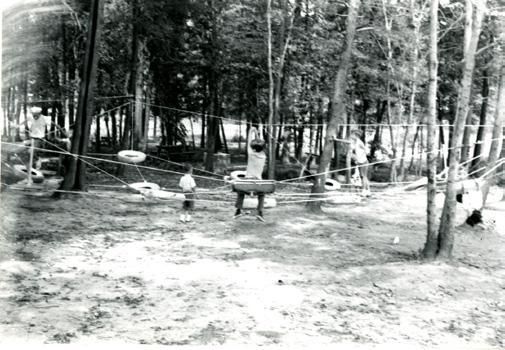
At the same time, Denmark’s neighbor Sweden also began to pursue new approaches in landscape architecture and playground planning in order to improve the poor quality of life in the capital and offer the population more parks and play areas. In 1949, as part of this program, an abstract sculpture for playing was set up in a sandbox in the People’s Park in Stockholm. Tufsen, a curious construction for both sliding and climbing, piqued the imagination and curiosity of children. The sculpture by SwedishDanish artist Egon MøllerNielsen (1915–1959) was neither a monument nor the expression of an ideology, but the first work of antielitist art to connect abstract art and play in a public space. This new approach generated a boom in playground sculptures from the 1950s on. The spread of abstract playground sculptures was driven by companies and cultural institutions like museums. The abstract playground sculptures fit the mood of the age, which wanted to promote creativity in children. The supply grew, and soon it was good form for city governments to install playground sculptures, even if mass production led to more and more banal designs.
A third and very influential line of playground development originated in Amsterdam in the city’s urban planning office. Before the Second World War, the city had already begun to develop new plans for more public playgrounds. The plan was first really put into practice in 1947 by a young architect working for the city, Aldo van Eyck (19181999). His huge sand playgrounds with simple jungle gyms was not separated from its immediate urban surroundings, a city centre still scarred by the war. Van Eyck drew attention to such intermediate spaces and gave them new significance. After the war, his playgrounds became icons for city planners throughout Europe.
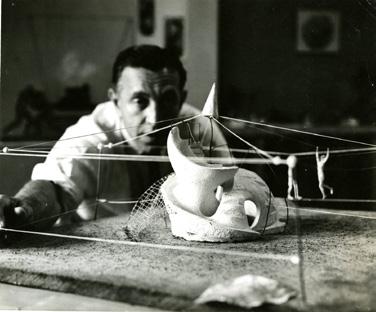
63 62 38
/
structure with ropes
tires 40
37
für
von / presented
213 212 FOCUS ESSAY
Joseph Brown, Spielstruktur mit Seil und Reifen
Play
and
Joseph Brown, Jiggle Rail , c. 1953
Modell
/ Model for Whale Yard , präsentiert
by Joseph Brown, c. 1955 39 Joseph Brown, Zappel-Struktur / Jiggle structure, “Design-in,” Central Park New York, 1967, gesponsert von / funded by the School of Arts of New York University, the New York Chapter of the Industrial Designers Society of America and Department of Parks
THE PLAYGROUND PROJECT
THE PLAYGROUND
PROJECT
This wide variety of new playground concepts only became known to a wider public after the Second World War. An important role in this growing awareness was played by an international network of ‘playground advocates,’ above all Marjory Allen in England. Allen introduced the Skrammellegeplads to England and promoted the idea as ‘Adventure Playground.’ Progressive magazines like Casabella and Domus in Italy, and Architectural Record, Progressive Architecture, and Landscape Architecture in the United States created opportunities to discuss new projects. Art exhibitions like the Biennale di Venezia and the Triennale di Milano, as well as such institutions as the Centre de Création Industrielle in Paris, the Moderna Museet in Stockholm, and MoMA in New York, provided space for artists to present their playground projects to a wider public.
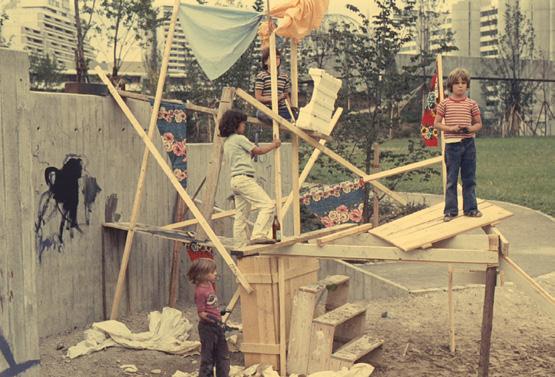

These ideas caught on in part because the growth of leisure society encouraged new concepts of play. With more holidays, increasing prosperity, and many adults no longer working on Saturdays, people had more time and money. New entertainment technology like movies, television, and comics was becoming accessible to the younger generation. This irritated many ‘upright’ citizens, who thought that children and teenagers should not indulge in passive entertainment, but instead do something ‘meaningful.’
The events of 1968 revolutionised not only politics and society, but also ideas about the environment, childhood, and education. ‘Creativity’ and ‘selfdetermination’ became magic words, and pedagogy sought new ways to particularly promote these traits in children. The common denominator of the heterogeneous movements of the time was the questioning of authority, and playground design was no exception. Now that public space was also seen as a democratic space, playgrounds could no longer be left to government officials. Democratic negotiation of solutions by all those involved became an important element in design. It was no longer important to follow the style and authority of an individual designer; instead, new concepts of play that were antiauthoritarian and antiinstitutional had to be tested.

123 122 88 Pädagogische Aktion, Spielaktion / Play action, München / Munich-Neuperlach, 1971 89 Pädagogische Aktion, Winter-Spielaktion / Winter play action, München / Munich-Neuperlach, February 1972
90 215 214 FOCUS ESSAY
Pädagogische Aktion, Spielaktivitäten im Olympischen Dorf / Play activities in the Olympic Village, München / Munich, 1972
In New York, at the beginning of the 1930s, the JapaneseAmerican artist Isamu Noguchi (19041988) was the first to design landscapes for play. Doing completely without playground equipment, his designs focused on sand, water, and landscaping. Between 1933 and 1966, Noguchi worked on a number of projects for parks in New York; however, not a single one of them was ever realised. Still, they were displayed as models at the Museum of Modern Art in New York, where they inspired other designers, such as M. Paul Friedberg and Richard Dattner. Starting in the mid1960s, their playground designs led to a ‘playground revolution’ in New York.
Handbooks and selfpublished pamphlets played an important role in this shift of emphasis; they made ideas public and laid the basis for selfempowerment.
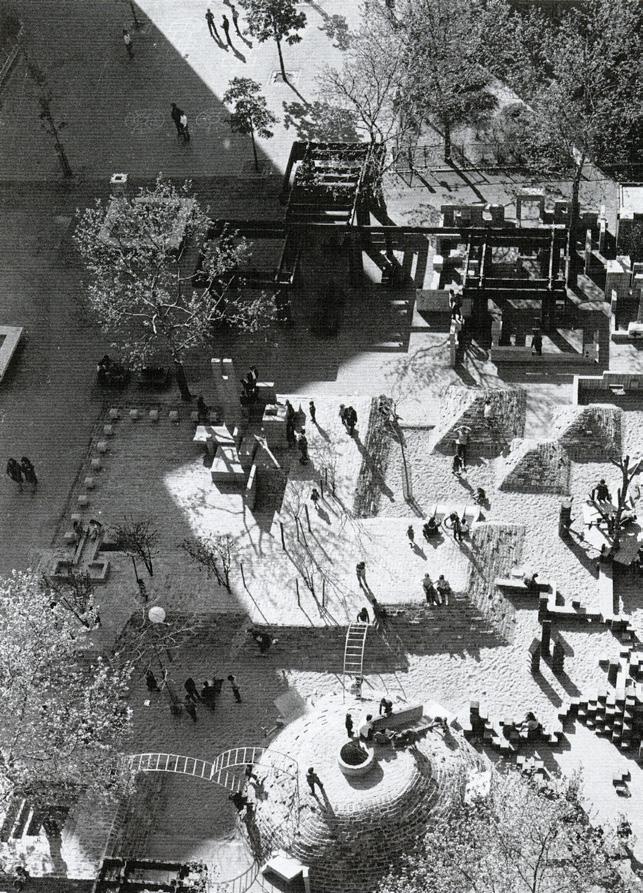

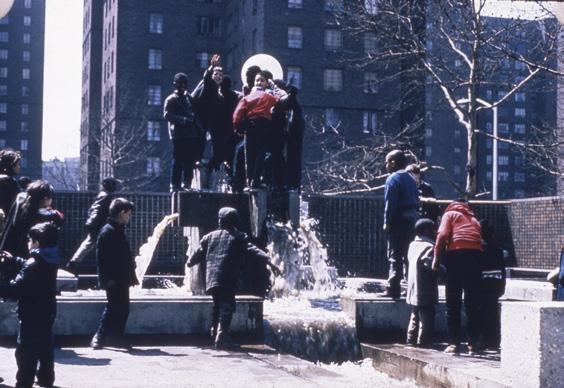
103 102 71–73
1965 217 216 FOCUS ESSAY THE PLAYGROUND PROJECT
M. Paul Friedberg, Riis Plaza, Jacob Riis Houses, New York,
The DIY movement, which encouraged people to shape as many parts of their own lives as possible, including playgrounds, was taken quite seriously, especially in the United States, where it led to the building of numerous playgrounds as community efforts. Planning and building in cooperation with future playground users became central in American cities. Nowhere else was so much invested in the ‘healing’ effect of play and its diffusion in public spaces. After the economic boom of the 1950s, disenchantment set in in the 1960s, with race riots and the separation of white suburbs and black inner cities. Some innercity neighborhoods deteriorated into slums, and crime spread. Vacant lots filled with garbage were temporarily turned into playgrounds, gardens, or squares. The landscape architect M. Paul Friedberg was one of the pioneers in finding new, temporary uses for such abandoned spaces; he designed a series of temporary playground modules that were easy to adapt to each new setting.
In the 1950s, Philadelphia became the epicentre for experimental approaches to architecture and planning. GermanAmerican landscape architect Karl Linn (1923–2005), was amongst others interested in a community approach in planning. Influenced by the kibbutz movement, Linn began to notice the lack of public spaces and communal life in the booming suburbs. In 1959, when he began teaching in the Department of Landscape Architecture at the University of Pennsylvania in Philadelphia, he set up a ‘community designandbuild service program’ to make landscape architecture more socially relevant. Instead of just offering lectures and dry seminars, he took his students into neglected
innercity neighborhoods. First, they evaluated how the inhabitants used public space and made it their own. Then, in 1960, on the basis of their observations, they worked with local organisations to plan and build a public playground and meeting space on a vacant lot.

Urban decline, the growth of the suburbs, and racial conflicts motivated the search for pragmatic solutions in the United States. In contrast, Europeans had different priorities: after the Second World War, the decisive catalysts were the rebuilding of the cities, the housing shortage, and urbanisation. Further, pedagogic issues were given greater weight in Europe. The adventure playground came newly into focus, and an important source of inspiration. The idea of creating a selfadministered space in an environment increasingly dominated by consumerism and technology gained in traction.
With the economic boom, and especially from the 1960s on, European cities had enough financial means for new kinds of playground projects, and for the design of public space. As a result, many housing developments and schoolhouses had outdoor spaces designed by artists. These publicly financed projects stood in stark contrast to the private initiatives and DIY approaches in the United States, where the state played hardly any role in developing public space.
In pedagogy, design and architecture, Italy was one of the most innovative countries. The architect and artist Riccardo Dalisi (*1931) was an exponent of ‘radical design’ or antidesign, which replaced functionality and established taste with creativity. Between 1971 and 1974, he combined architecture and pedagogy, teaching
seminars with his architecture students in a neglected neighborhood in Naples. Dalisi was less interested in play than in encouraging children to find their own language. He and his students always took models and materials along and invited children to be inspired by them to build things, to realise their own ideas, and to respond to the hostile space by occupying it.
It was no longer important to follow the style and authority of an individual designer; instead, new concepts of play that were antiauthoritarian and antiinstitutional had to be tested.
Pedagogues hailed the city as a rich and lifeshaping learning environment outside of directive spaces like the school or the playground. From this followed a wider interrogation of the very idea of the playground as a separate space. Art educators, like the loosely grouped KEKS (abbreviation for ‘art, education, cybernetics, sociology’), moved outside of the classroom so that the pupils could enter into an unmediated dialogue with people and the surrounding environment, as well as exposing their senses and thinking to the everyday. Out of these actions grew, for example, the 1971 mobile playactions in Munich’s playgrounds. Play equipment was secondary; more important were modeling materials: blocks of Styrofoam, rolls of paper and plastic, waste material, piles of earth, and holes in the ground full of rainwater. It was a rejection of everything that was permanently installed, designed, lauded, or that made educational sense.
The Danish artist and architect Palle Nielsen (*1942) saw the playground’s pedagogical and socialcritical potential as connected. In the 1960s, he called for more space to be available for children by organising spontaneous adventure playgrounds in and around Copenhagen. In 1968, Stockholm’s respectable but innovative Moderna Museet gave Nielsen and a group of political activists permission to turn part of the museum into Modellen, a wild adventure playground that Nielsen saw as a model for a ‘qualitative’ society.
Between 1949 and 1979, the playground was a place for new ideas and experiments in art, architecture, and pedagogy. The beginning of the 1980s, though, marked a fundamental change. Alongside a growing aversion to risk, privatisation and commercialisation were on the increase; not only could art and architecture not escape them, they even played an active role in the process. As it promised neither success nor prestige, the playground lost its significance, while also facing new restrictions in the form of safety requirements. Parental attitudes and expectations changed as well. Fearing kidnappings and other reputed dangers, parents kept their children under constant supervision and significantly reduced the time children were left to themselves. At the same time, as
219 218 FOCUS ESSAY
107 106 75 Doppelseite aus / Spread from M. Paul Friedberg and Ellen Perry Berkeley, Play and Interplay. A Manifesto for New Design in Urban Recreational Environment , The Macmillian Company, London 1970, p. 178–179. THE PLAYGROUND
PROJECT
the pressure on children to perform well in school has grown, their daily schedules have been filled with activities. A new understanding of childhood began to emerge. In 1982, the American media theorist Neil Postman published his provocative book TheDisappearance of Childhood, in which he discussed the influence of consumption and the mass media on children and the concept of childhood.


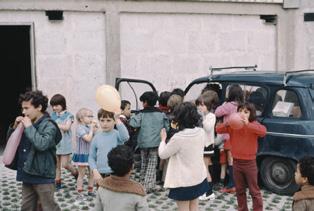
At the beginning of the 21st century a shift began to take place. In his 2006 book Last Child in the Woods, the American author Richard Louv coined the term ‘nature deficit disorder’: children who grow up far from nature and risks cannot develop healthy selfconfidence. For children to judge and get to know themselves, they must be allowed to take chances and try things out. While playgrounds became more and more standardised and sanitised, especially architects discovered the play space and the question of the public sphere anew. They discovered play and community spaces as a possibility to root their projects into the local fabric, and to build with cheap or poor material, and limited financial resources. It also became a way to enter in contact with a young generation, to empower them, and to return to a socially relevant practice.
An early and important pace maker of this approach was Auburn School of Architecture’s Rural Studio. Founded in 1994 by D. K. Ruth and Samuel Mockbee, this ongoing design/build program brings students together with local communities in order to build houses, public buildings, bridges, sports fields, playgrounds with affordable and often recycled material. All this happens in the economically disadvantaged region of Alabama’s Hale County. Since Hale County had no construction laws and no building inspectors, Rural Studio became an architectural laboratory with almost no limits to imagination. Over the years, it turned into an internationally acclaimed project in the way it investigated and respected local needs to promote a human architecture.
Throughout the 2000s, a growing number of architects became active in this field: they built public space and facilities for the community in different countries in Europe, Africa, the US, and Latin America. They invested public spaces and buildings together with the users to change some of these spaces for good. Spanish collectives Basurama realised projects in Spain, Chile, Brazil, and Recetas Urbanas in Spain, EAHR (Emergency Architecture & Human Rights) realised projects in Jordan; Italy, Chile, and Denmark; LearnMovePlayGround (Vittoria Caprese and Barbara Pampe amongst others) in Cairo and Vilnius, Rozana Montiel Studio in Mexico, Public Space Project in Kibera/ Nairobi and other cities, Sreejata Roy in New Delhi, Studio assemble in the UK, Alejandro Aravena and Studio Elemental in Chile, Al Borde in Ecuador.
221 220 FOCUS ESSAY
153 152 123–125 Workshops, Foyer Rémois, Reims (Champagne-Ardenne), 1973 THE PLAYGROUND PROJECT
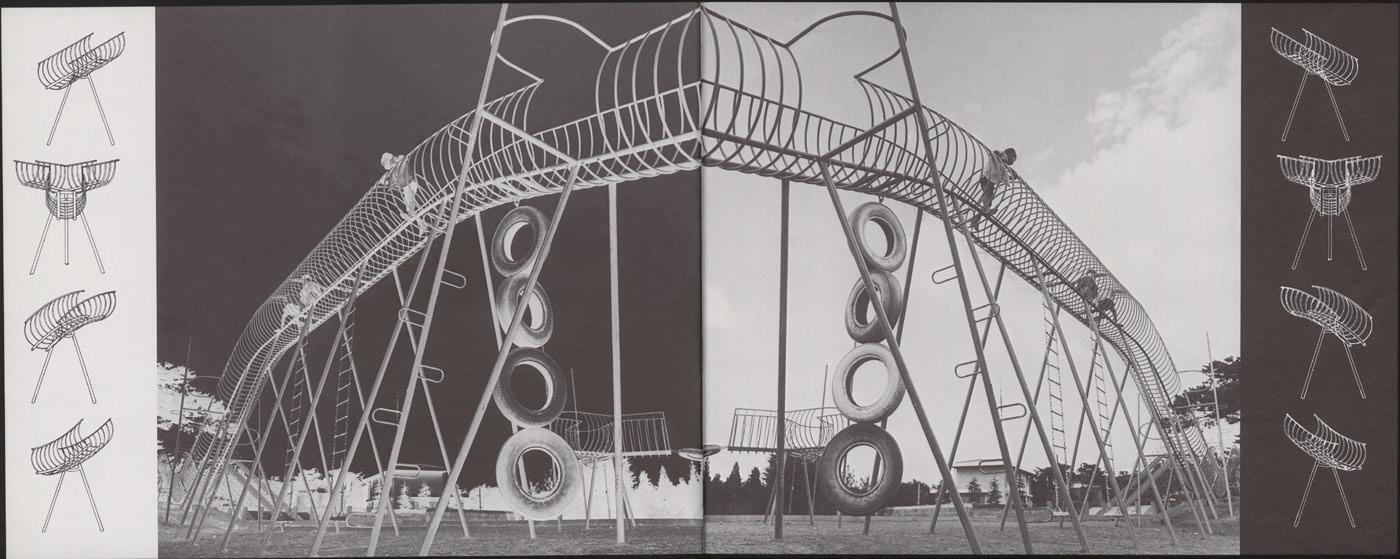
199 198 223 FOCUS ESSAY 222 THE PLAYGROUND PROJECT
At the same times many of their activities have been rewarded through prestigious prizes, and have also been the subject of numerous exhibitions. Surprisingly, the 2015 Turner Price, usually given by the Tate to an outstanding artist, went to Assemble Studio from London who uses play as a methodology of their work. In 2016, the Pritzker Prize went to the Chilean architect Alejandro Aravena and his studio Elemental. The inhabitants of his ‘unfinished’ standard houses in Iquique, Chile from 2004 selfbuilt to lower costs to the minimum. Collective space between the housing units strengthen the community of the families. This approach shows an innovative and playful way of rethinking social housing. Aravena’s Children’s Bicentennial Park from 2012 is a huge playscape in Santiago, a meeting point on a future promenade. Through all these different projects and engagement, play and the playground became a key element of social architecture, the main theme of Aravena’s 2016 Architecture Biennial Venice ‘Reporting from the front’.
All images presented within this essay are from the publication The Playground Project, JRP|Ringier 2018
FOCUS ESSAY
224
Suburban / Submission
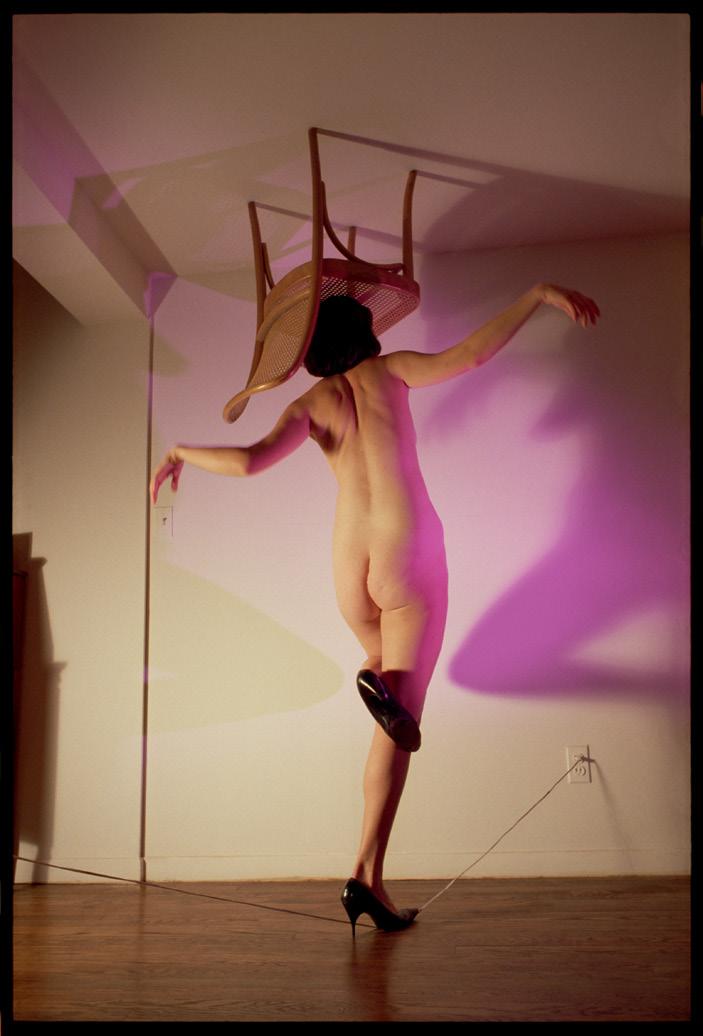
225
JIMMY DESANA
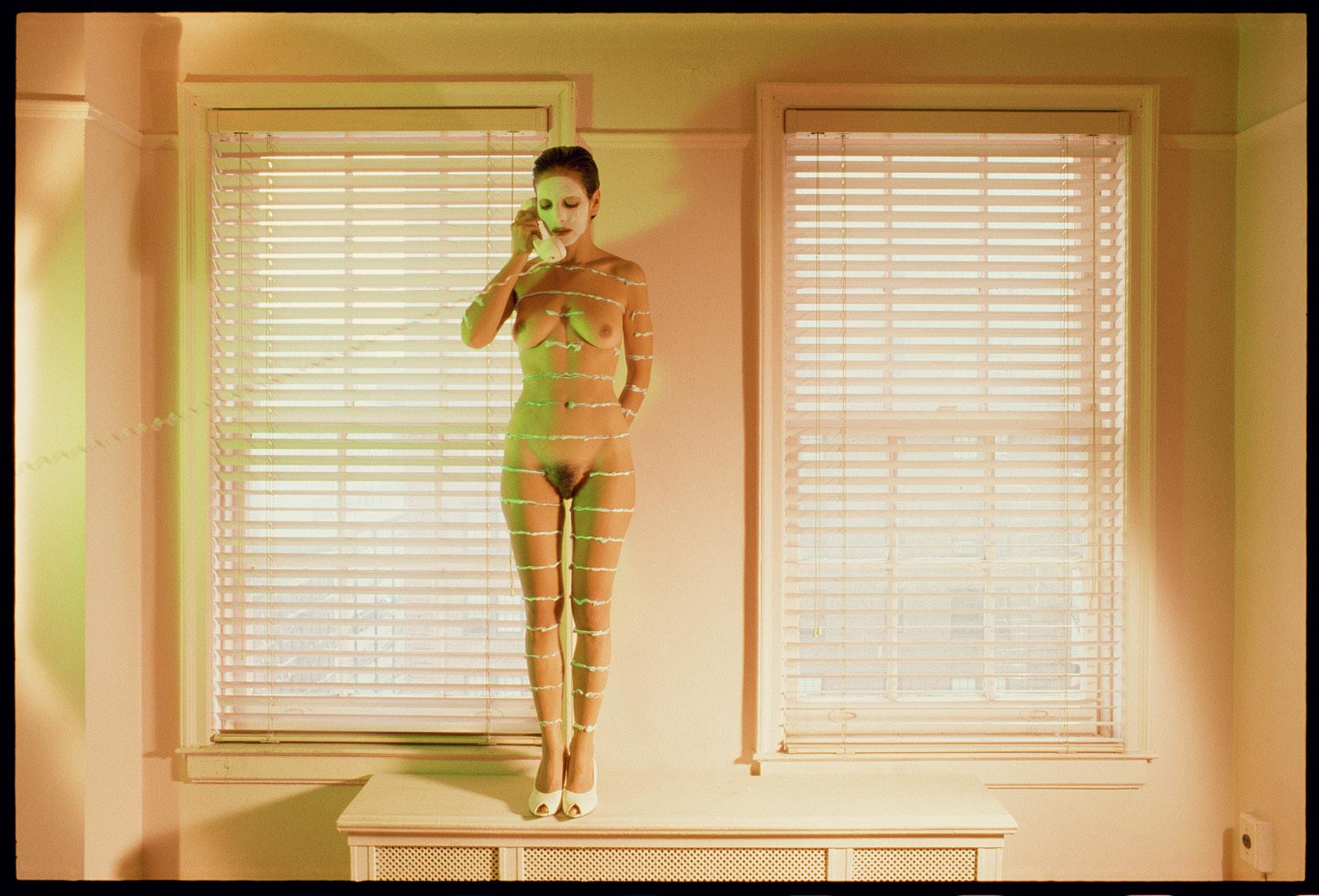

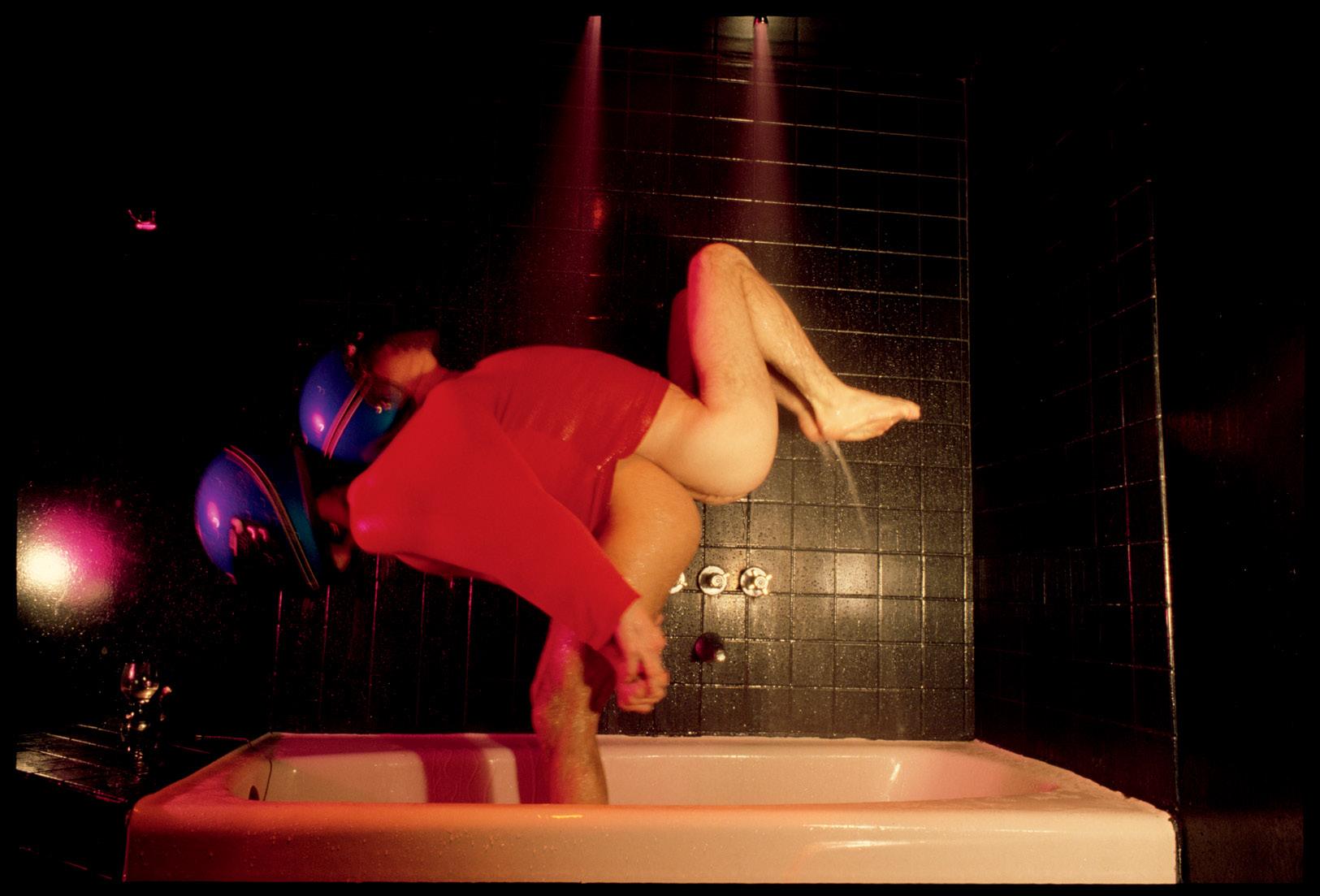



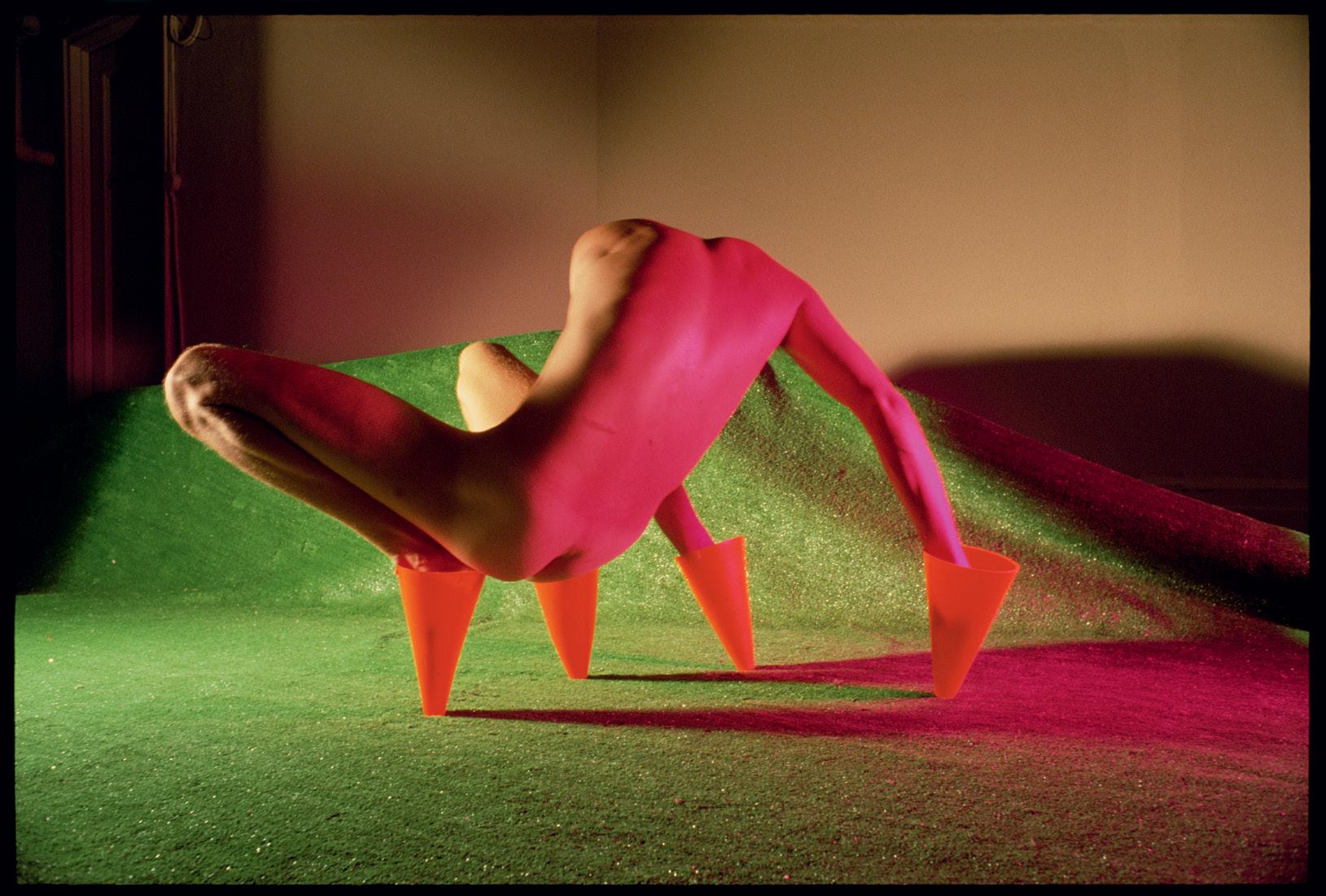
JIMMY DESANA
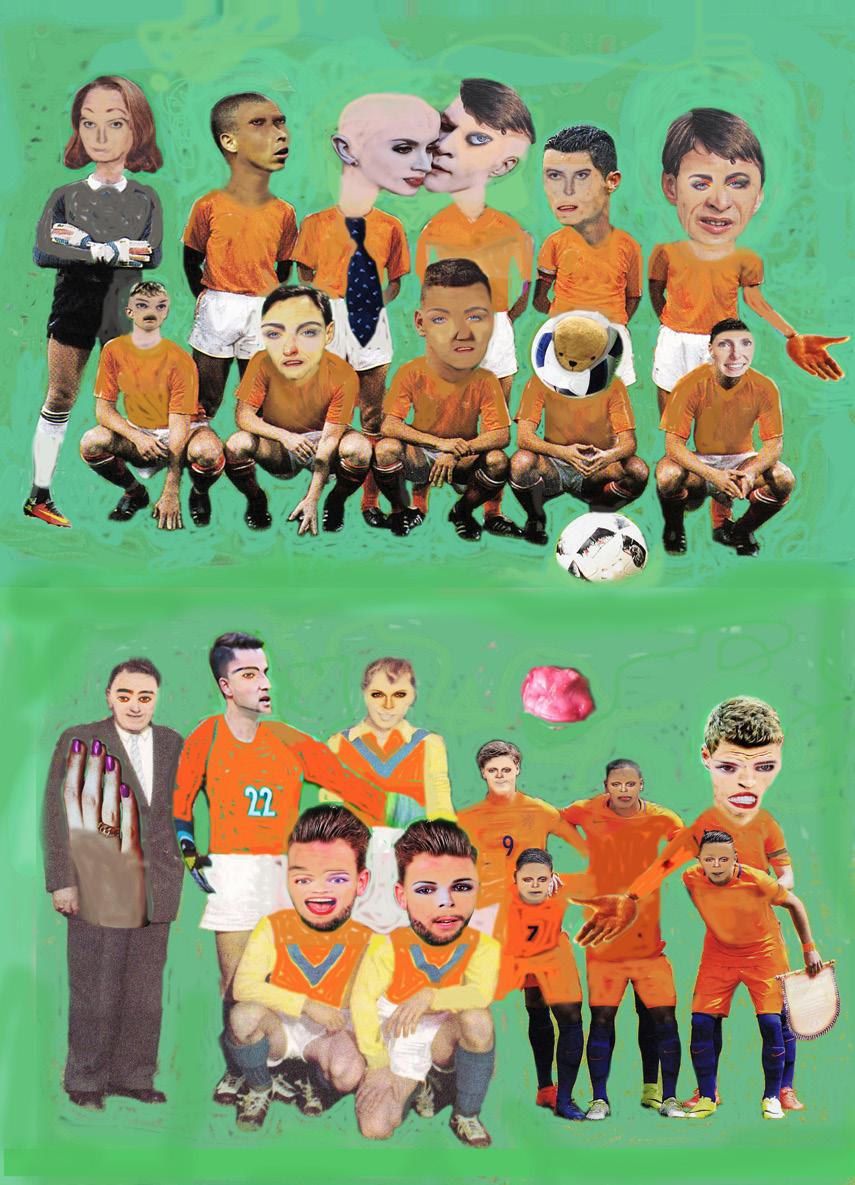
Suburban / Submission
Across shag-carpeted living rooms, tiled bathtubs, and linoleum-floored kitchens, Jimmy DeSana staged his queering of the domestic. DeSana systematically peeled back the veneer of suburban life, focusing his interest on the ever-widening discrepancy between the public and private lives of post-war Americans. An omnipresent downtown scenester, DeSana’s photographs preserve all the visual grit and uncertainty of a post-punk New York that rewarded and punished in equal measure, a playground for sexual experimentation born in the wake of Stonewall, the feminist revolution, and just before the spectre of AIDS and the moral conservatism of the 1980s exacted their toll on these newfound freedoms.
The images of BDSM acts pictured in DeSana’s Submission photobook showcase his ability to puncture the everyday with the sexual revolution he was witnessing on the Lower East Side. Bound and gagged men and women sprawl across living rooms and bedrooms, squat amongst antique dressers, and watch the family tv through leather masks. These voyeuristic photos of fetishism are in fact almost entirely staged, originally commissioned by
famed writer and downtown dominatrix Terrence Sellers to illustrate her novel The Correct Sadist. The fantasies of desire and play DeSana constructs here are often just that. While the snapshot aesthetic of the photographs seems to suggest that here DeSana is voyeur and ethnographer, in fact he is the architect, willfully constructing these scenes to maximum effect. Props and roleplay are foundational to fetish culture; however, these photographs project the taboo rather than document it.
The vivid colour profiles of the Suburban series are riotous, yet the scenes are often subdued, serious, even melancholic. These acid-toned prints are more sinister, more surreal, and less eager to please than the images we often associate with the Pictures Generation. It’s easier to draw a line between DeSana and the surrealist photography of Man Ray and Hans Bellmer than to Cindy Sherman’s plucky film tests or the crisp portraits by Robert Mapplethorpe or Peter Hujar. Further distancing his work from that of his contemporaries, DeSana almost never reveals the identity of his sitters. Faces are almost invariably obscured by a prop: a stocking, a helmet, soap suds, or even the camera itself. The viewers’ in-
nate desire to know the subject is stymied by the unrecognisability of these exploded, contorted anonymous bodies. By making chairs, coat hangers, helmets, and even an iguana an extension of the body, the photographs propose a flattening of the hierarchy between prop and actor, blurring the distinction between stage and sitter, foreground and background, organic and artificial. In much the same way that subjugation and compliance are fundamental to BDSM culture, here the camera becomes dominant, imploring the body to perform for the photographer. DeSana uses these bodies are props, stripping them of agency and compelling them serve the needs of the composition.
DeSana made a career of piercing through the realm of the banal and conventional with the queer and radical. His works suggest that the home itself and the objects within it are in themselves a prop to conceal an arena of libidinal play. For DeSana, the camera acts as catalyst and instigator, a tool used to coerce a performance, a device that invites us to subjugate our egos in the service of latent desires.
— Text by Bryan Barcena
239 JOS HOUWELING Bal & Voet 238

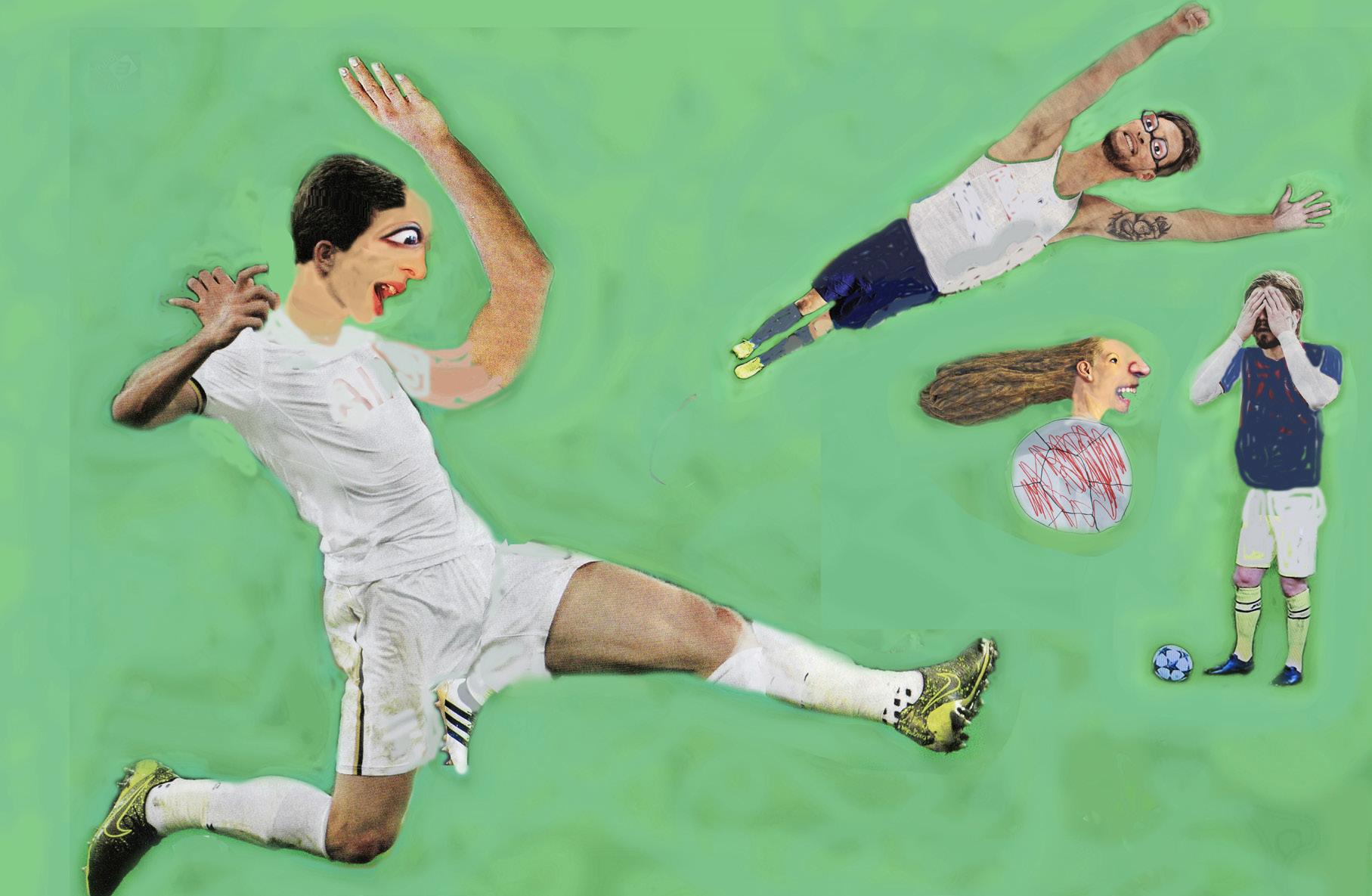


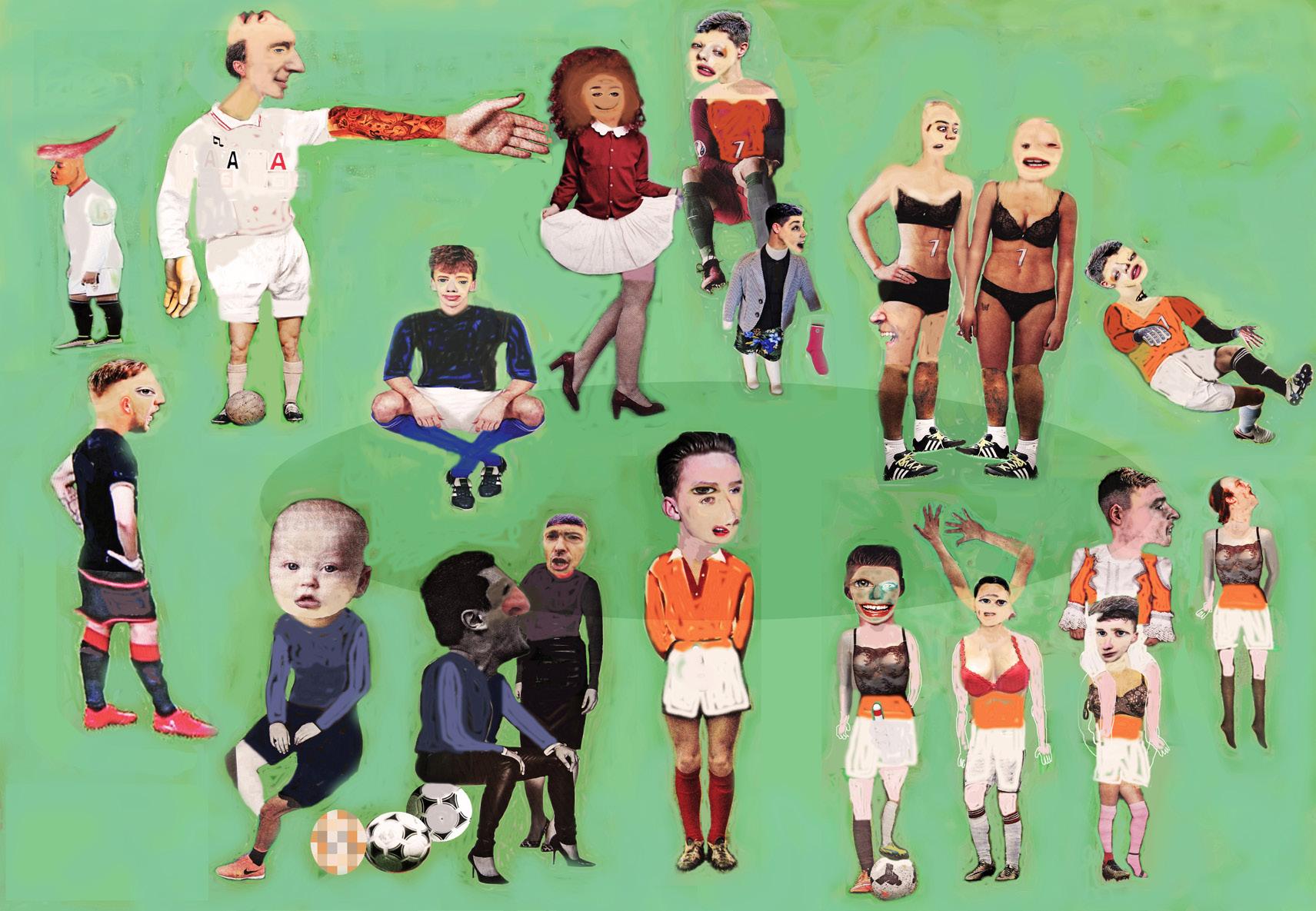
Bal & Voet
Imagine someone waving these collages by Jos Houweling back and forth for a moment, from five metres away, so that you can barely register what’s on them. You would still see, no, feel in a millisecond what the subject is. You hear yelling. You smell grass. However nothing remotely like this will ever be seen on a football pitch. Conifers grow on the field, players swap limbs as if it was a card game, shirts run about that no national team ever wore. Yet despite the fact that sausages, cacti, old sandwiches, high heels or handguns have no business being there, the brain still says: FOOTBALL.
Jos Houweling, who has been making photo series and collages since the 1970s, started with a simple rule: he would go in search of green seamless green with which to make abstract collages. And the most beautiful green is that of the grass on a well-maintained, freshly mown football pitch. It made him look at soccer matches on television in a new way, with an extra eye. Waiting for the moment when the grass was nothing but grass. Then he would take a photo of the television screen.
It’s the simplicity of a rule like that, combined with immense patience and a tremendous passion for collecting, that
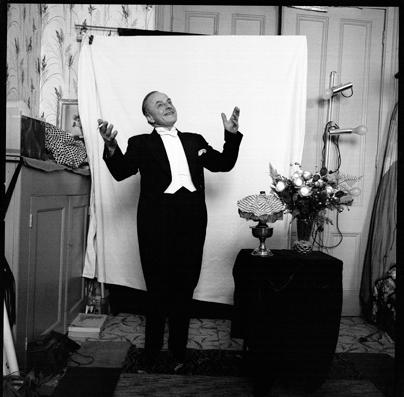
characterises his entire oeuvre. Houweling photographs coffee cups, front doors, paving stones, traffic signs, cucumbers, souvenirs (I could go on for the rest of the page) and uses them as the building blocks for new pictures. Establishing the rule means immediately embracing the aberration and the infringement. Otherwise there’s little point, just as there’s little pleasure to be had from a match without a single foul or calamity. In that grass-green image of his first photographs there is always a mark, a ball or a line. Legs above all, ‘legs with first-class sinews’ he wrote to me. Taking seriously this violation of his own rule (‘photograph an area of green’) became the starting point for the series Bal & Voet.
Against the grass-green background, apparently stuck together digitally with some nonchalance (the idea of green = green enough), we see everything that makes football into Football, even beyond the rules of the game. The gestures. The tattoos. The haircuts and the boots. The men and the women. Fear, screams, euphoria, crowds, money, discussion of it all. It’s as if I’m looking not at football, nor at art, but at visual haikus about the worldwide game that nobody can escape.
Football fans will recognise their irrational love of the game, and football haters their infinite loathing.
The game of soccer is not a popular subject in art. Too familiar, too visually obtrusive perhaps. The green field, the white lines and the players form such a strong image between them that there is little room left for an artist. One of the few successful football artworks in Dutch art is the painting Footballers (1950) by Pyke Koch, showing three players in the snow. The grass has been carefully whited out, otherwise we’d no doubt fail to notice the dramatic beauty of the three figures suffering from cold, their legs turning blue.
Jos Houweling does the opposite. He has drawn his framework, his pitch is ready. He embraces the green, letting us wallow in it; we drown in a football sea and the most hallucinatory scenes unfold. There’s a place for everything: beauty, drama, delusion, hideousness, pain, love, hysteria, flatness and depth. Just like in the real game.
— Text by Sacha Bronwasser
248
JOS HOUWELING
249 ROLPH GOBITS
Entertainers

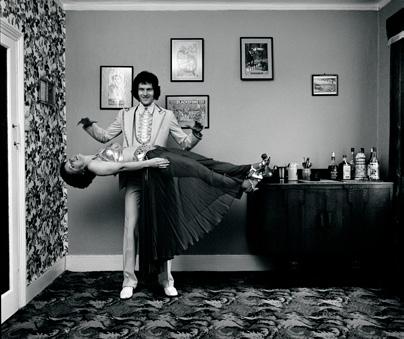
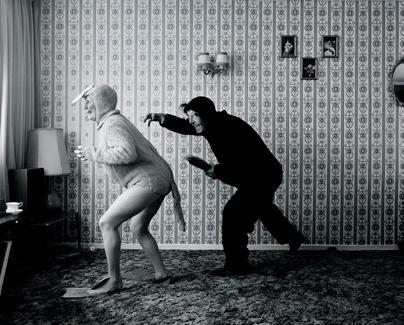
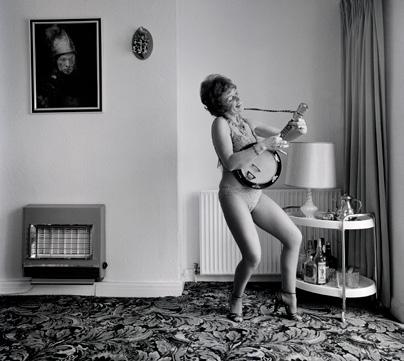
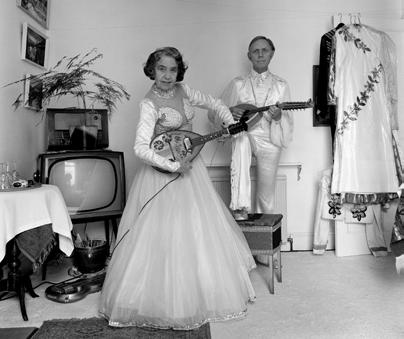
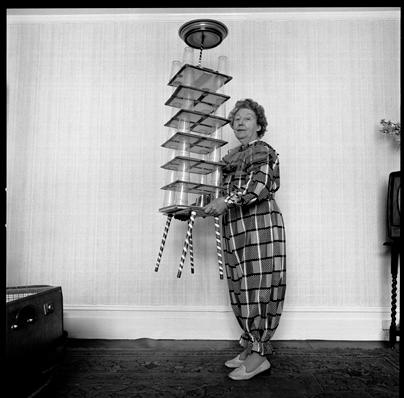
Entertainers

Who we are is determined by what we do. We derive our identity from our work. To quote Tennessee Williams, ‘When I stop, the rest of the day is posthumous. I’m only really alive when I’m working.’
Edward S. Curtis did it with the Native Americans of the United States: in 40,000 photographs he recorded the vanishing culture and traditions of some 80 tribes. Irving Penn did it with Small Trades, studio portraits of skilled workers in London, New York and Paris, dressed for work, with the tools of their trade. And since 1971 Rolph Gobits has been doing it with his portraits of variety artists. Over a period of more than 40 years, in almost 200 photos, he has portrayed clowns, acrobats, sword swallowers, jugglers, fire eaters, mimes, magicians, tightrope walkers and other travelling entertainers — in their homes, giving informal performances.
The profession of variety artist disappeared along with the music hall and vaudeville, driven out by television and other new forms of entertainment. Gobits visited them in anonymous blocks of flats or old people’s homes. He asked them to put on their acts one last time, exactly as they had done in clubs or theatres. For lack of a stage they performed right there and
then, with the photographer as their only audience. The interiors of their homes show that they are far from affluent. The rooms are small, austere and simple. At the same time, these retired entertainers are honest. They demonstrate who they are without inhibition, with no tricks up their sleeves. They have the courage to be vulnerable, yet are proud of who they were and what they were able to do.
Rolph Gobits grew up in Amsterdam at a time when the Theater Tuschinski provided entertainment before the film began, and during the interval: jugglers, high wire acts, conjurers. It was there that Gobits developed a fascination for variety acts. After he had finished his secondary school Gobits’ mother suggested him to go to London for a while to improve his English.
He had been taking photographs since he was a boy. It was in London that he discovered it was possible to train to be a professional photographer and earn a living from it. His aptitude for photography became clear when he showed his portfolio to an art college and was promptly admitted as a student, first at the Bournemouth and Poole College of Art and then for two years at the Royal College of Art.
In those days — and little has changed in this respect — photo editors attended graduate shows. That was how Gobits got his first paid commission for the trendy fashion store Biba, which had just opened a shop in the Derry & Tom’s Building in Kensington High Street. The celebrated magazine founder Roland Schenk asked him to make portraits of the crème de la crème of British business owners, for publication in Management Today. The directors of industry had little time to spare and did not feel at all comfortable being photographed. So Gobits decided to include their surroundings. By shifting the attention to ‘environmental portraits’ he relieved the worst of the pressure. Furthermore, Gobits worked slowly, using cumbersome largeformat cameras, which helped to create a sense of peace and relaxation. It also gave him plenty of opportunity to establish a bond with the sitter.
Calmness and compassion come through in Gobits’ portraits, which are in no sense lachrymose or nostalgic. Full of empathy, they are images of people returning for a moment to what gave them their self-respect.
— Text by Pim Milo
Crowded Fields
256 257
ROLPH GOBITS PELLE CASS

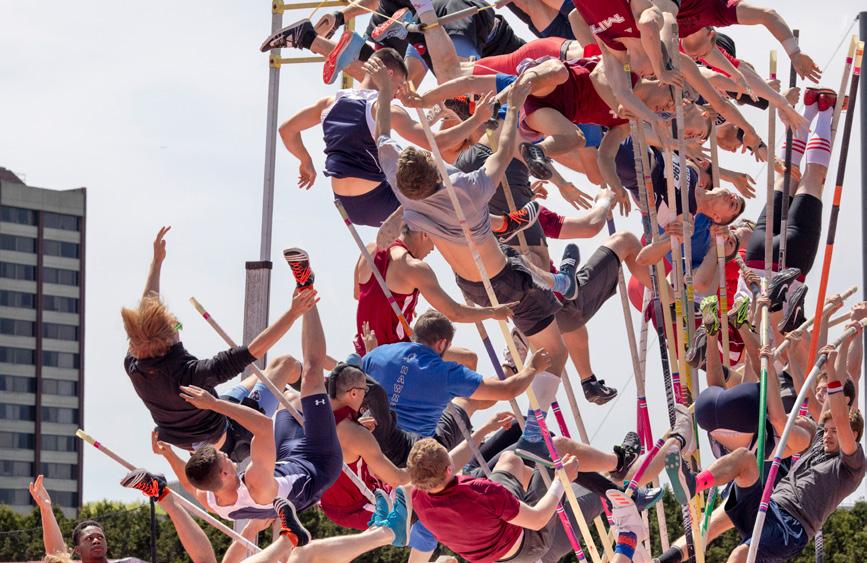
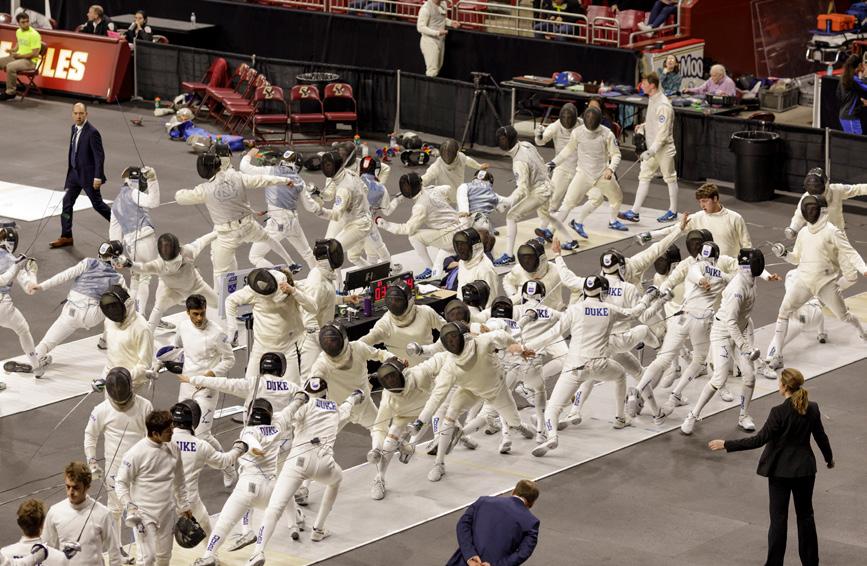


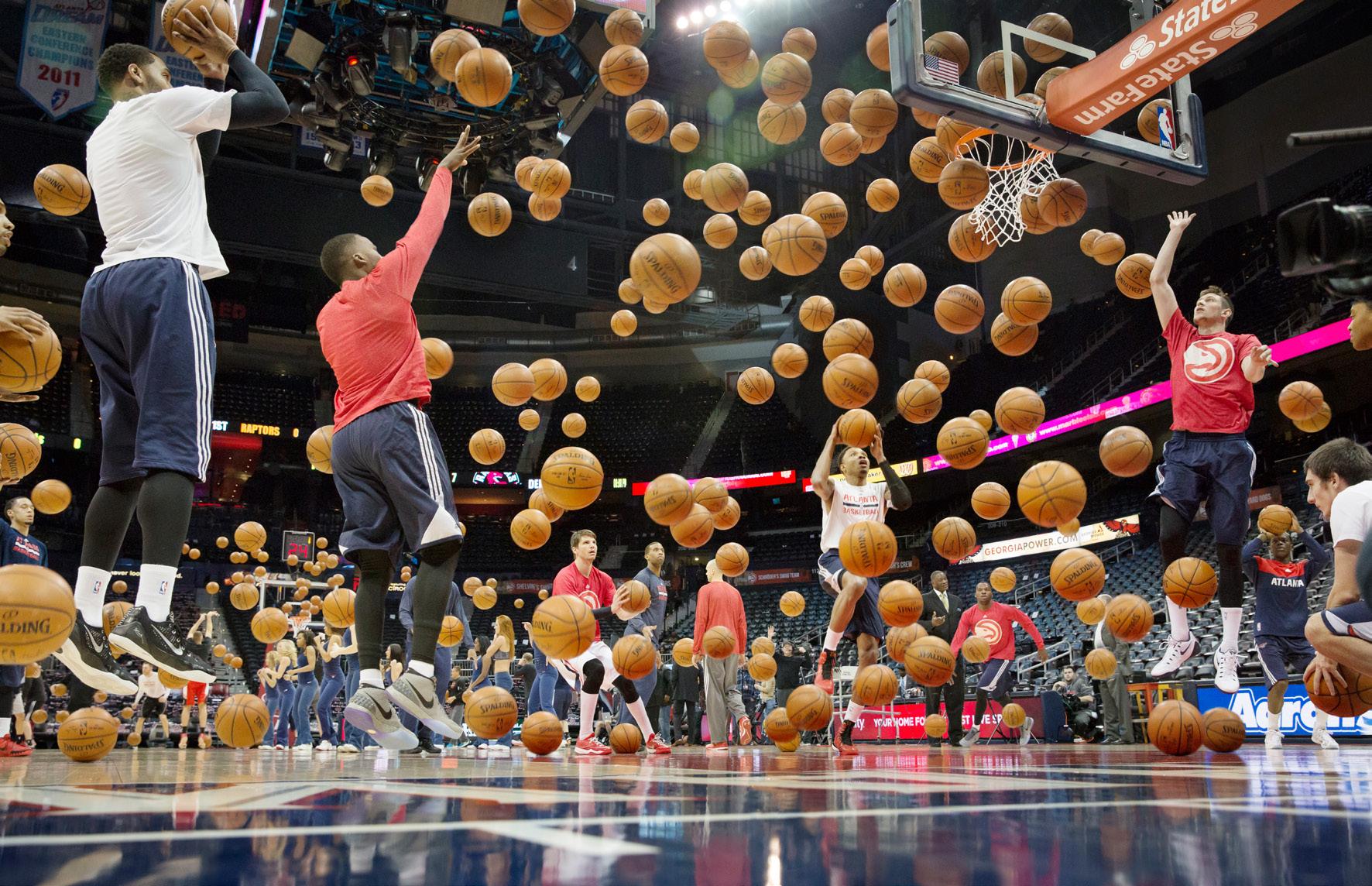
Crowded Fields
In an interview about his earlier digital photographic series Selected People but just as relevant for the trickster methodology deployed in Crowded Fields the photographer Pelle Cass invoked a philosophical dictum about the nature of time and the workings of our universe attributed to Einstein’s collaborator J.A. Wheeler, ‘There’s a saying in physics: the purpose of time is to keep everything from happening at once. Everything happens at once in my work.’ With this astute contrast, the adept Boston-based Photoshop wizard appears aware that he is playing with the laws of physics in producing this (super)imposing series of fantastic images that suggest elaborate distortions of time.
Whichever the sport exhibited here, we witness crowded playing fields. But what exactly is happening in and on the fields captured by Cass at stadiums and arenas around the college-saturated Boston area? These composite photographs are playing a game of temporal distension as we observe a single photographic frame that contains aspects culled from a series of moments spanning the entire sporting event. Deeply indebted to the heavy layering afforded by Photoshop, Cass draws upon the roughly 1000 shots of the field taken at regular intervals during each game and from the same vantage point. Straining the capacity of the program to its limits,
the final composite consists of 400-500 layers with the meticulous production of each image taking up to 80 hours. Thus, a key paradox lies in the painstaking work required on the part of this photographer of play. Cass once likened the process to a Tetris-like puzzle that avoids overlapping figures but this is no longer the case in more recent examples.
Starting with a commission for an Atlanta Hawks’ shooting practice (2015), Cass has put far too many spherical objects into play. He refers to these images as ‘still time-lapse photographs.’ This observation helps us to understand further how Cass’s composite images play with time and operate in the gap between still photographs and moving pictures. It is not surprising to learn that the two 19th-century photographers who pioneered the cinematic discovery (Étienne-Jules Marey and Eadweard Muybridge) also trained their cameras on athletic bodies and their movements. But their chronophotographic experiments pale in comparison with the elaborate and seemingly impossible digital choreography staged in Crowded Fields. The intricate interweaving of players in Woman’s Hockey Game, Northeastern University (2018) also calls to mind the Canadian composite master William Notman as another point of comparison. In his grandiose skating party images (ca. 1870), Notman photo-
graphed the entire rink and then filled it up by cutting and pasting more than 300 individual and small group studio portraits to create a composite negative for printing. Another street photographic precedent for Pelle’s ‘penalty shots’ or his ongoing transgression of having too many players on the field would be Garry Winogrand whose images always insisted upon multiple centres of attention.
As a branch of photojournalism, sports photography has been enchained to the rhetoric of the decisive moment. The goal has been to capture the game winning shot or a particular moment of fierce and intense competition. This is a crucial way in which Crowded Fields intervenes and answers to the call of a more complex composite aesthetic. In this manner, Cass takes a timeout demanding that we turn our attention away from winning or losing and rather focus on being good sports, ‘What I want you to notice is the play, not the competition.’
With Crowded Fields, Pelle Cass deftly takes back the flow of becoming to aggrandize the still photograph while we the spectators revel in his playtime.
— Text by Louis Kaplan
Eurovisions, Performativity and Playgrounds 1965-99
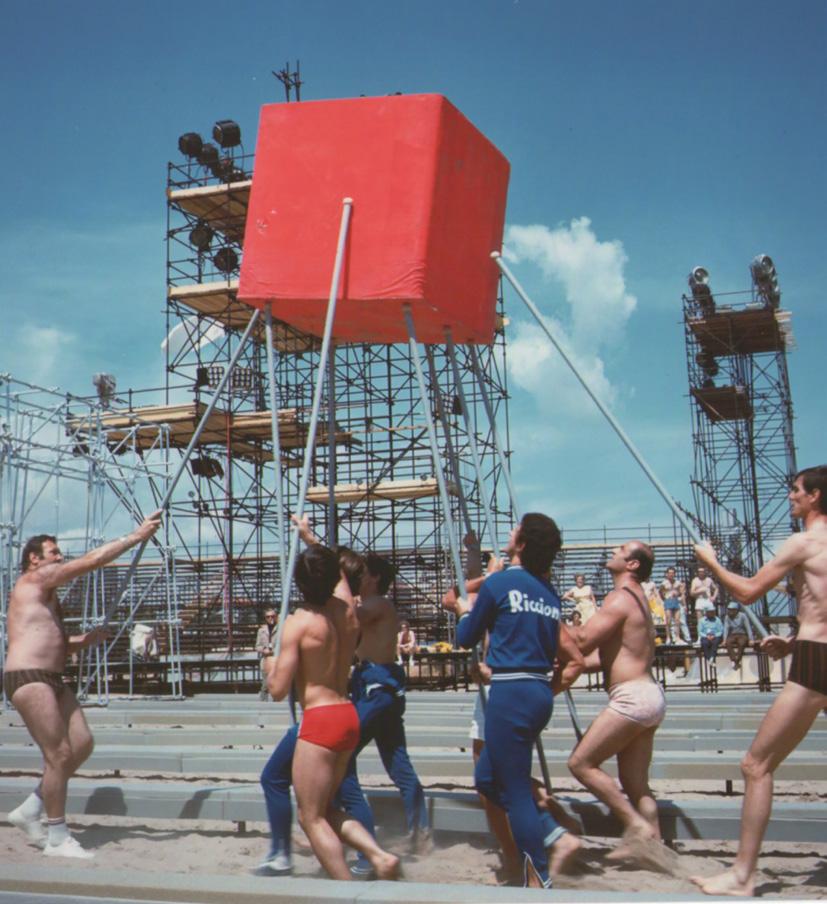
264
PELLE CASS 265
SPORTIFICATION

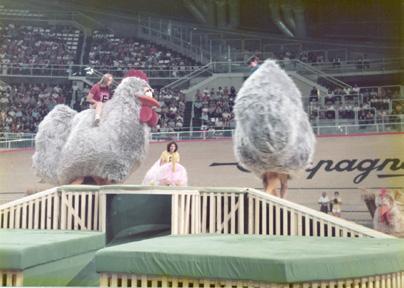

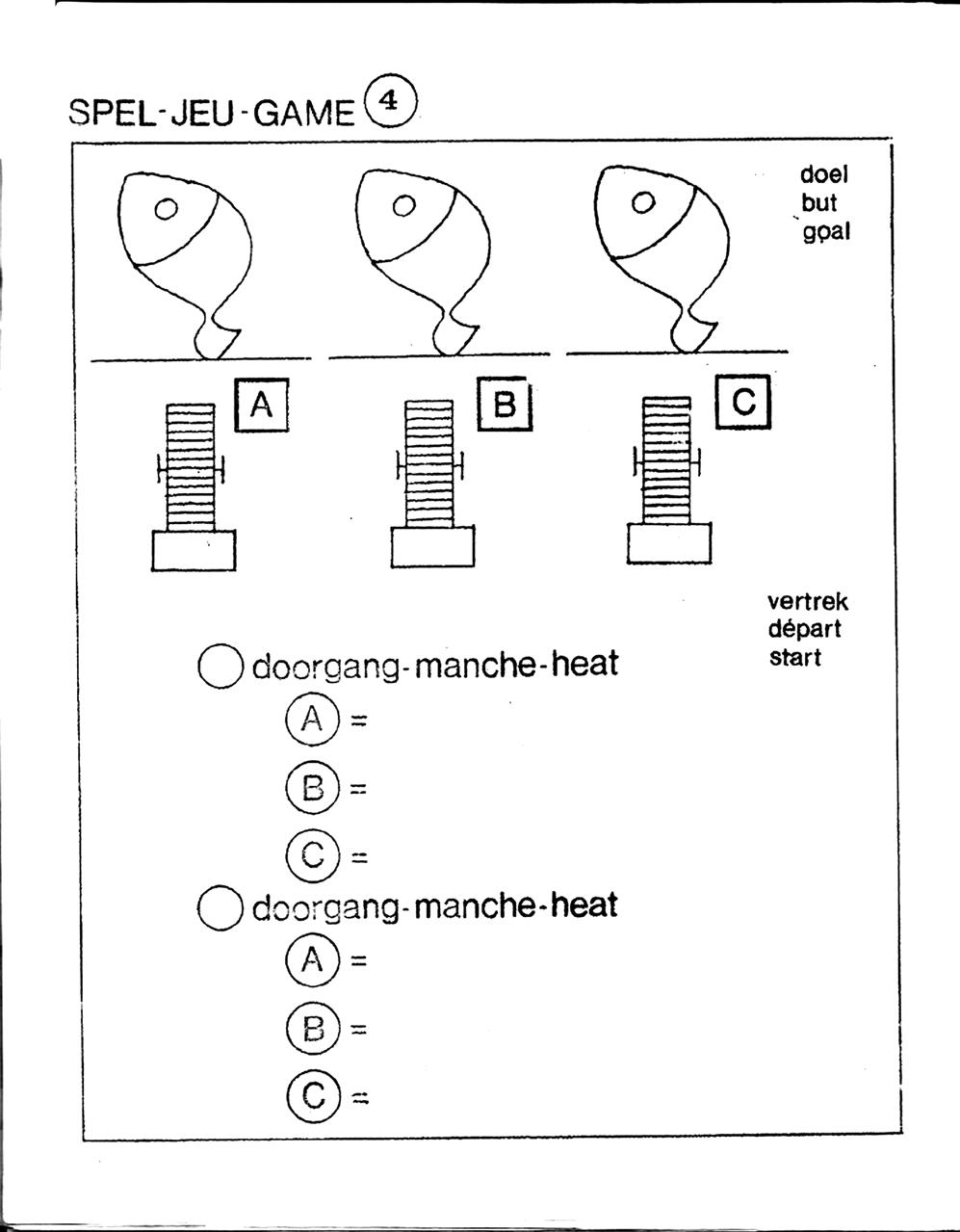

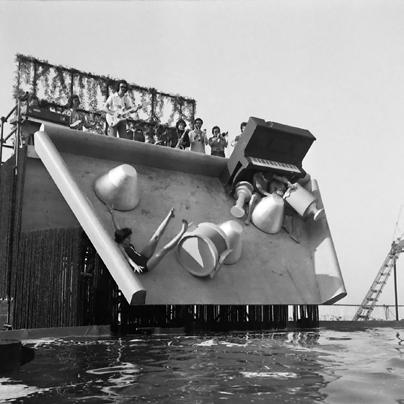


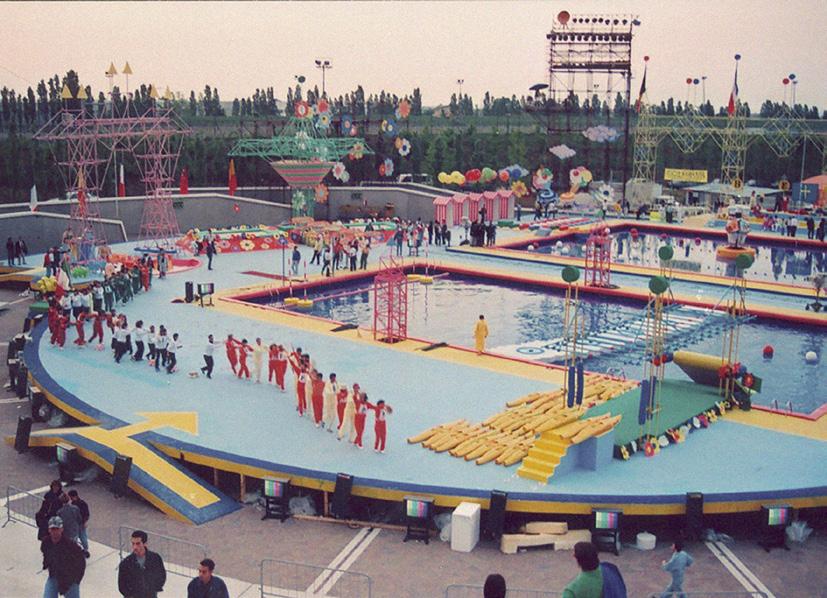
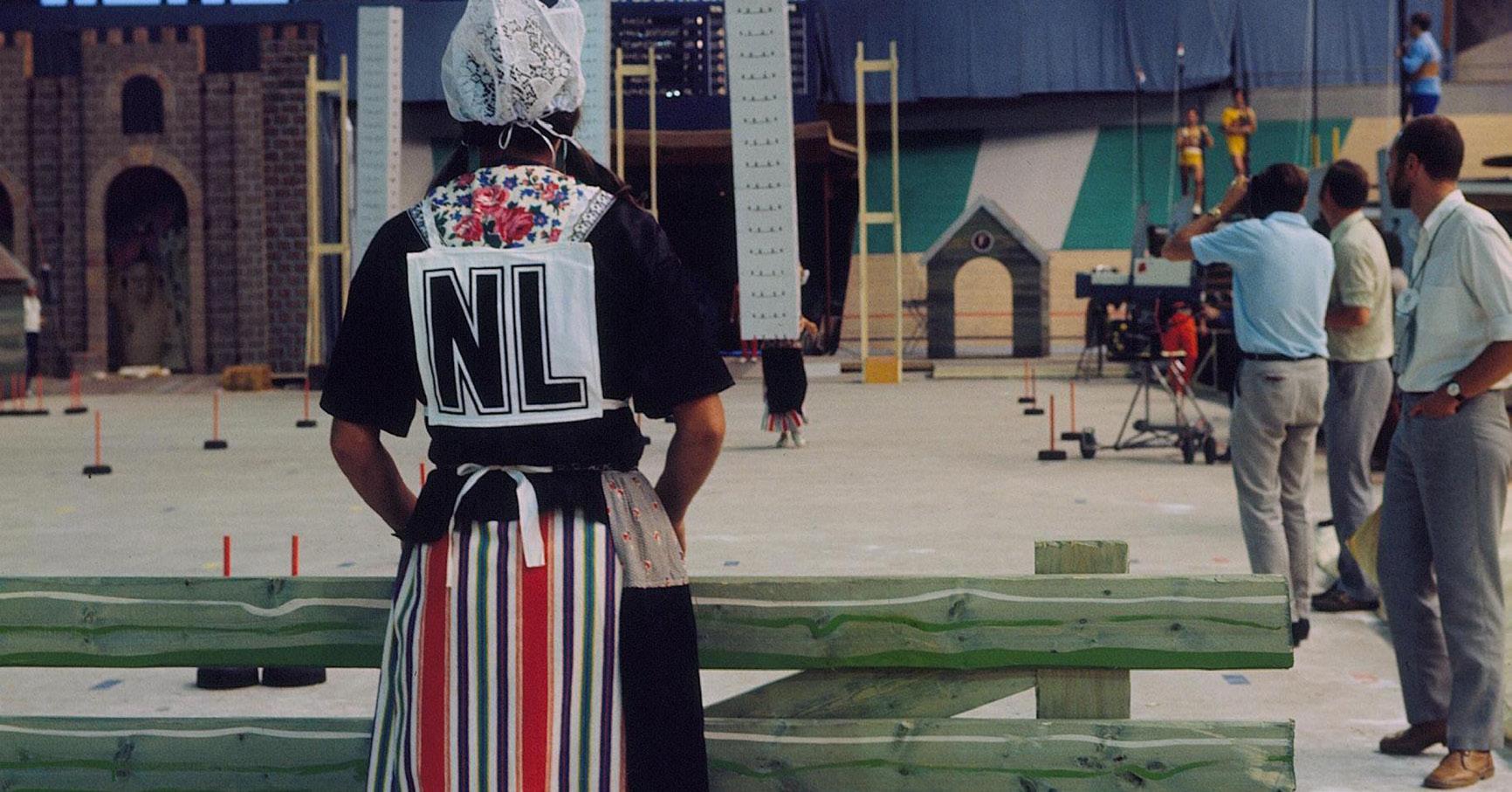
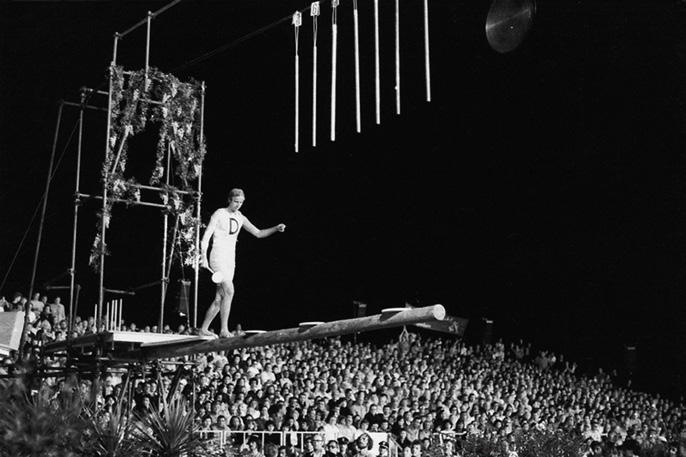
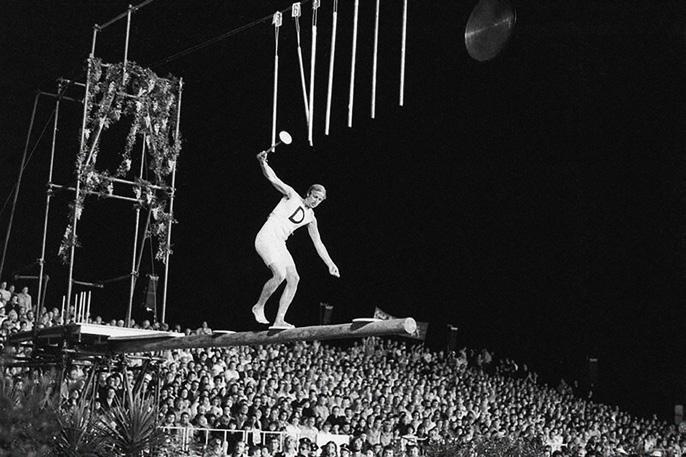

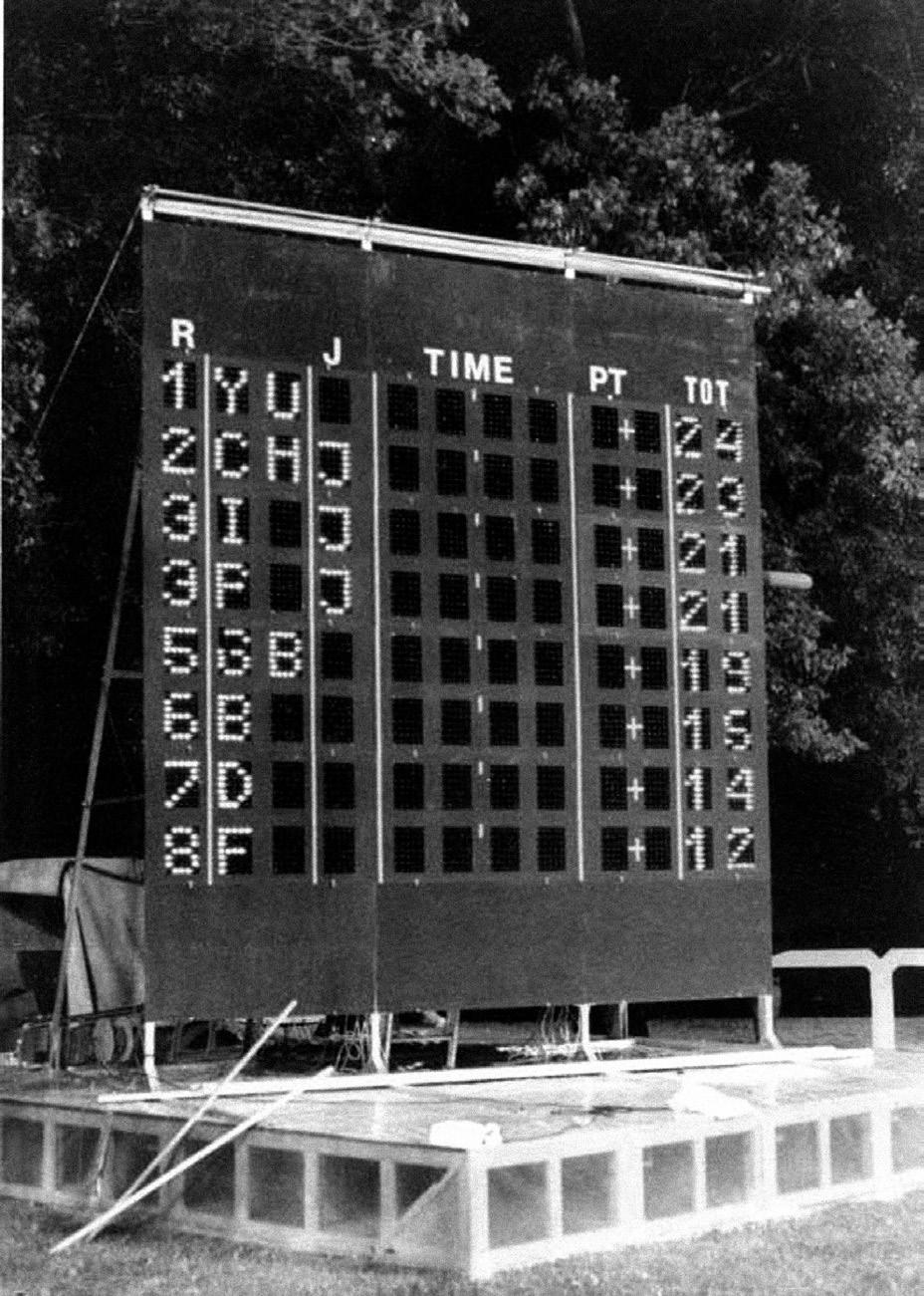
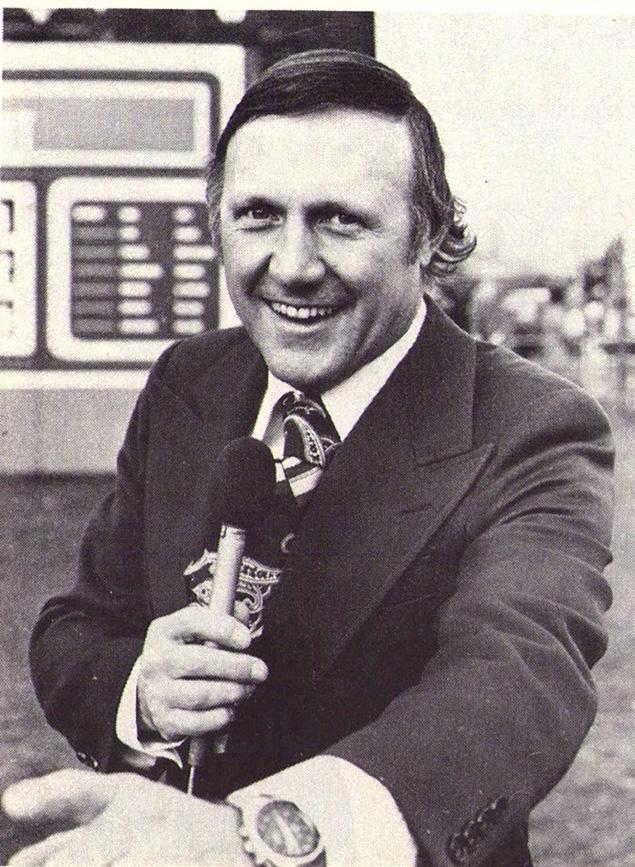
Eurovisions, Performativity and Playgrounds 1965-99
SPORTIFICATION: EUROVISIONS, PERFORMATIVITY AND PLAYGROUNDS
1965–99 is about the vast playground that was established in Europe between 1965 and 1999 and broadcast in Eurovision, the ‘sportificating’ infrastructure of the burgeoning confederation. Research was carried out to try and describe this media event, this epochal passage. The analysis compared two types of archives: one of Jeux Sans Frontières, forerunner of a Europa Felix confederated through collective games and state television politics, and one of the impalpable fluxus movements of behaviours, attitudes, agonistic forms, happenings and performances that emerged in the early 1960s in and outside conventional contemporary art spaces. How did these two visions, the offmedia critical-radical art movements and the popular-folkloristic mass media TV show, influence each other?
This study examines the surprising impact that modernist architecture / urbanisation as well as the performative aspect
of various avant-garde movements such as Dada, Situationism and Fluxus had on the design of the games and the playgrounds (see the Blackpool episode). This tendentious thesis is not strictly anchored to an art theory perspective of the question, or to the sectarian and elitist discipline of art criticism. This cultural proposal in the form of a research-book tends towards a much more permeable and fertile social perception of the phenomenon. The Riccione 1975 episode clearly shows how the sportification of a seaside resort was able to exert influence on the political and economic apparatus. Democratic and European sportsmanship established and determined the first form of touristic colonisation of the German people on the Italian coast. The Huns from the small town of Attendorn performed in Riccione cheered on by a large public of fellow compatriots, a preview of the exodus of tourists from Germany to the Adriatic coast in the 1970s and 1980s. Jeux Sans Frontières is a spectacular television show that fits perfectly
into Roger Caillois’s theory of the four main categories of games four forms of social competitiveness: Agon, Alea, Mimicry, Ilinx. The competition ring of popular television reached huge audiences precisely because it merged these four levels into a form of sport crossbred with children’s games, Commedia dell’Arte, extreme performance and television. This analysis of high-performance euro-television during the life of Jeux Sans Frontières, from 1965 to 1999, deals with ludic momentum, performance and playgrounds in many European cities (in those years, deputy Ettore Andenna, ex Games presenter, put forward a proposal for legislation on European television). It is a timely structural critique of the European mission that was budding at the time and is now in deep crisis.
— Text by Franco Ariaudo & Luca Pucci
FRANCO ARIAUDO develops transdisciplinary researches related with anthropology, sociology, ritualism, sport and leisure. He resorts to different media and devices (installations, collective performances, video, books) that, by virtue of small perceptual variances, tend to destabilise the habitual gaze of the spectator. His work highlights and features ‘the play of forces at play’ — the tension between contrasting movements and energies that leads to a specific subject becoming an object of contention (between tradition and modernity, power and submission). Franco lives and works in Turin, Italy.
MARIAMA ATTAH is a photography curator and editor. With a BA in Photography and MA in Museum Studies, her interest in photography is centred on its ability to represent visual culture and history alongside the over looked and the under explored. Before joining the editorial department of Foam Magazine, she was Programme Curator at Photoworks, responsible for developing and programming exhibitions and events, including Brighton Photo Biennial and the Jerwood/Photoworks Awards. She was also Comissioning and Managing Editor of Photoworks Annual magazine. She has worked with a number of national and international artists. Mariama is currently Assistant Editor at Foam Magazine.
BRYAN BARCENA is Assistant Curator and Manager of Publications at the Museum of Contemporary Art, Los Angeles. Bryan served as cocurator on Anna Maria Maiolino, and Adrián Villar Rojas: TheTheaterofDisappearance. From 2013 to 2016, he was Curatorial Assistant at The Institute of Contemporary Art/Boston, where he was part of the team that organised Leap Before You Look: Black Mountain College 19331957, and worked on exhibitions with artists including Liz Deschenes, Adriana Varejão, Jim Hodges, Matthew Ritchie, Erin Shirreff, and Mona Hatoum. Bryan is currently organising the first retrospective of the work of Jimmy DeSana.
CHIARA BARDELLI NONINO graduated in Philosophy with a dissertation on postmortem photography. She has been the Photo Editor of Vogue Italia and Editor of the Photography channel of Vogue.it since 2012. She is also the Photo Editor of L’Uomo Vogue and she cocurated with Alessia Glaviano a series of exhibitions, such as The Female Gaze for PhotoVogue Festival. Chiara has contributed to the editing of various independent publishing and exhibition projects.
SACHA BRONWASSER is an art historian, author, moderator and curator. She writes and talks about contemporary art and film for several (international) platforms and she is editor and host of the controversial Amsterdam live art talkshow Stampa. From 19982018 she worked as an art critic for the newspaper The Volks
krant. She also curated exhibitions and film programs. In 2011 her book of artist portraits Zo werken wij came out. Sacha’s first novel Nietsisgelogen is published by Ambo Anthos in October 2019.
BEN BURBRIDGE is Course Leader of the Photography: History, Theory, Practice MA at University of Sussex. Recent curatorial projects include Revelations: Experiments in Photography (Media Space/National Media Museum, 2015) and AgentsofChance: Photography and Politics of Space (Brighton Photo Biennial 2012). The editor of two publications Revelations: Experiments in Photography (MACK, 2015) and Photography Reframed (I B Tauris, 2018), Ben is currently completing his first monograph, entitled Photography After Capitalism
GABRIELA BURKHALTER is a political scientist and urban planner based in Basel. Documenting the history of playgrounds since 2008, she was the curator of The Playground Project at Kunsthalle Zurich, and the editor of the accompanying catalogue (The Playground Project, Kunsthalle Zürich/JRP Ringier, Zurich 2016). The PlaygroundProject was first presented at the 2013 Carnegie International, Carnegie Museum of Art, in Pittsburgh. In 2014, she was a guest curator for Architectures for Children – Zurich’s Playgrounds at gta exhibitions, ETH Zurich. Gabriela is a grantee of The Graham Foundation for the project Group Ludic’s Visionary Urban Landscapes, 19681979.
LEWIS BUSH works across media and platforms to visualise forms of contemporary power. After studying history and working in international development, he began developing his own projects in 2012. His work has explored issues ranging from the aggressive redevelopment of London, to the systemic inequalities of the art world. Recent works include Shadows of the State, which examines the democratic deficit of intelligence gathering, and Trading Zones which focuses on international finance. Lewis is lecturer in documentary photography at London College of Communication.
PELLE CASS is a photographer from Brookline, Massachusetts. The Fogg Art Museum, the Addison Gallery of American Art, the Polaroid Collection, the DeCordova Museum, the Peabody Essex Museum, the MFA, Houston, and others own his work. Pelle’s photos have been published widely online and in books such as Photoviz, Deleueze and the City, and Langord’s Basic Photography, and in magazines such as Consumer Reports, Businessweek, McSweeney’s and the Boston Art Review. Pelle has received fellowships from Yaddo and the Polaroid Collection.
JIMMY DESANA was an artist, best known for his presence in the punk
art scene in New York’s East Village in the 1970s and 1980s. Using the human body as primary subject, his work has been often classified as antiart and described as alternating from the brutally explicit to purely symbolic.
William S. Burroughs wrote the introduction for his photo book Submission selfpublished in 1980. Jimmy lived and worked in New York and died from an AIDSrelated illness in 1990.
CHARLIE ENGMAN is an artist and photographer. He earned a degree in Japanese and Korean studies at the University of Oxford before turning towards art. He will be releasing his first monograph in spring 2020 entitled Mom Charlie currently resides in Brooklyn and is definitely a Leo.
KALEV ERICKSON has worked as an archivist for the last 12 years and is exhibition curator and photo book editor at the Archive of Modern Conflict (AMC), a unique and expansive photography collection based in west London. The exposure to such a diverse collection of photography that spans the medium’s history from its origins to the contemporary has influenced his practice, focusing interest in vernacular photography together with challenging the traditional use and understanding of archives in general. He has contributed to numerous acclaimed AMC exhibitions and publications over the years, while continuing to develop his own artistic projects. Kalev lives and works in London.
DAVID FATHI has completed a Master’s degree in Mathematics & Computer Science, and started an artistic research in photography sidebyside with his career in engineering. This double practice can be perceived in his photographic work as an intense passion for science and the limits of knowledge. His work, be it still or moving image, takes root in various archives and visual databases, depending on the subject, blurring the appropriationist work in the boundaries between documentary and contemporary art. David lives and works in Paris.
ANASTASIIA FEDOROVA is a writer, curator and cultural critic. She is a regular contributor to Dazed, D and Garage Magazine among other titles. In 2018, she cocurated the exhibition PostSoviet Visions: image and identity in the new Eastern Europe at Calvert 22, London. Anastasiia lives and works in London.
ROLPH GOBITS is a graduate of The Royal College of Art in London and an awardwinning photographer. He has worked on his project of travelling entertainers for over 20 years, during this time he has travelled all over the UK and has collected more than 150 photographs. Rolph lives and works in London.
HINDE HAEST is Curator at Foam, who has worked on exhibitions including Masahisa Fukase — Private Scenes
and William Eggleston — Los Alamos She previously worked on photography exhibitions at the Rijksmuseum and Huis Marseille in Amsterdam, the Victoria and Albert Museum and the Barbican Art Gallery in London, and the New Museum in New York. She authored two books and has written for magazines such as Aperture, Metropolis M and Foam Magazine. She holds an MSc from SOAS, an MA from University College London. Hinde lives and works in Amsterdam.
JOS HOUWELING is a Dutch artist. He taught at the Rietveld Academie (19761998), and directed the Sandberg Instituut (19992010). His photobook celebrating Amsterdam’s 700 years of history, 700 Centenboek (1975), was bought by the Centre Pompidou in Paris and became part of a large retrospective on his work. He is the initiator of The One Minutes, a worldwide platform for videos of exactly 60 seconds. In 2018, Jos published three photobooks in collaboration with Voetnoot, Antwerp.
LOUIS KAPLAN is Professor of History and Theory of Photography and New Media at the University of Toronto. His books in the field of photography studies include American Exposures: Photography and Community in the TwentiethCentury (Minnesota, 2005), The Strange Case of William Mumler, Spirit Photographer (Minnesota, 2008), and Photography and Humour (Reaktion, 2016). Louis’ next book At Wit’s End explores the discourse on the Jewish joke from Weimar Germany to the Holocaust and beyond (Fordham, May 2020).
KAY KASPARHAUSER is an artist, writer, producer and musician living in New York City. Her work, both written and visual, has been featured in CR Magazine, Purple Magazine and Vogue l’homme She has collaborated with Kanye West, Pornhub, Puppets & Puppets, Sounds, and Yeezy. She was the front woman for The Prettiots, a band signed to Rough Trade whose first album was featured in both The New York Times and NPR’s TIny Desk Sessions. She graduated with a BFA in design from RISD. Kay currently works as a concept and ideation developer, semiotic navigation consultant, interaction and engagement facilitation, bottle peeler, lip chewer, yarn spinner, cannon fodder, and brow furrower.
KIM KNOPPERS is an art historian graduated from University of Amsterdam, and Curator at Foam. Since 2011, she has worked on solo and group exhibitions, including Back to the Future: The 19th Century in the 21st Century (2018). She has contributed to various magazines including Foam Magazine, Unseen and Aperture and has written catalogue texts for Jaya Pelupessy and Sylvain CouzinetJacques, amongst others. Kim is also a lecturer on the MA Photography at ECAL in Lausanne where she initiated and developed the course Do Not Disturb – Curating in Progress.
277 BIOGRAPHIES
276
SPORTIFICATION
CAT LACHOWSKYJ is a freelance writer and editor. Prior to pursuing a career in writing, she trained as a photography archivist in Toronto, where her work on colonial photography albums was funded by the Social Sciences and Humanities Research Council of Canada. Cat has completed residencies and fellowships at the Art Gallery of Ontario, the Ryerson Image Centre and the Rijksmuseum, and her writing has appeared in many publications, including Unseen, The British Journal of Photography and Rvm Magazine. Cat lives and works in Europe.
MAITREYI MAHESHWARI is Programme Director at the Zabludowicz Collection in London, where she oversees the programme of exhibitions, residencies and events across all locations. As a curator, Maitreyi is focused on artists working with ideas of embodiment through new technologies and performance, producing new works with artists for solo shows and leading on the presentation of artists’ VR.
CARLY MARK is a contemporary artist and writer working in a range of media including sculpture, painting, and video. She is known for creating works that relate to commercial product packaging and consumer culture, such as Haribo gummy candies. Carly lives and works in New York.
ALECSANDRA MATIAS DE OLIVEIRA has a degree in History from FFLCH USP (1995), a Master’s in Communication Sciences from ECA USP (2003), a doctorate in Visual Arts from ECA USP (2008) and a postdoctorate from UNESP (2018). Alecsandra is producer of exhibitions at MAC USP, a member of ABCA, researcher at the Center Mario Schenberg ECA USP and professor of African and AfroBrazilian Art History at CELAAC USP. Alecsandra is the author of the book Schenberg: Crítica e Criação (EDUSP, 2011).
ELISA MEDDE is a photography editor and curator. With a background in History of Art, Iconology and Photographic Studies, Elisa worked for various cultural institutions, publishing houses and nonprofit organisations as project and research coordinator as well as independent curator and editor. Her academic research reflects on the relations between image and power, particularly in the context of contemporary photography. She has served as juror for many prizes, including the Luma Rencontres Book Award, Copenhagen Photo Festival, Premio Celeste and Lens Culture. She has been a nominator for the Mack First Book Award, Prix Elysée, and MAST Foundation for Photography Grant, amongst others. Since 2012, Elisa has been the Managing Editor of Foam Magazine.
IVAN MIKHAILOV graduated from the Chuvash Pedagogical State University in fine arts and drawing in 2003. Be
tween 2008 and 2012, he focused on personal projects that were exhibited in group and solo exhibitions, alongside art residences in Dusseldorf and Paris. Ivan studied at the Institute of Contemporary Art, Moscow between 2013 and 2014 and has works in collections of the Moscow House of Photography, the National Museum of Chuvashia and private collections in Canada, France, Italy, Germany and the US.
PIM MILO is the founder of the Photographers Association of the Netherlands (PANL) and a photography critic and journalist. He was rejected for the Royal Academy of Art in The Hague, went into military service and then studied Graphic School. He started as a production assistant at an advertising agency and, 20 years later, left advertising as Chief Operational Officer (COO) of Saatchi & Saatchi. He has been writing since the age of ten, but his first real piece was an interview with photographer Richard Avedon in 1994. Pim has been writing professionally since 2002.
ROSANA PAULINO received her PhD in printmaking from the University of São Paulo and a Bachelor’s degree from the same university. In her work, Rosana explores as a main theme the place occupied by black people, and in particular black women, in Brazilian society. She has participated in many art exhibitions in Brazil and abroad. Rosana has received several awards in Brazil for her art performance, especially scholarships to both academic studies and artistic creation.
TIMOTHY PRUS is the curator of Archive of Modern Conflict since 1992. He is also an exhibition organiser and a photobook editor. His previous publications include Nein, Onkle (2007) and Scrapbook (2009). Amongst his exhibitions are Collected Shadows (Museum of Contemporary Art, Toronto, 2013) and A Guide to the Protection of the Public in Peacetime (Tate Modern, London, 2014). Timothy lives and works in London.
LUCA PUCCI earned a BA from the Academy of Fine Arts of Perugia in 2007 and in 2011, his MA in Visual Arts from the University of Venice. Luca’s research is focused on randomness and routine useful to recreate/reactivate specific places of interests, especially by using videos, installations, actions and performances. Some of his most significant researches have been developed and increased during several residencies, amongst them Manufatto in Situ (Foligno), NAC foundation (Rotterdam), and Van Abbemuseum (Eindhoven). Luca lives and works between Assisi and Foligno, Italy.
ALICE QUARESMA has shown work in many exhibitions, including the PS122 Exhibition Prize (2009), Foam Talent Prize (2014), Caixa Cultural São Paulo Open Call (2018), Aperture Foundation Summer Open (2019) and
Houston Center for Photography Annual Exhibition (2019). Alice gained her MFA from Pratt Institute in 2009 and has been participating in exhibitions and residency programs since 2006. Alice lives and works in New York.
MAISIE SKIDMORE is a freelance writer and editor specialising in fashion and art, and their intersection in contemporary culture. She is the editor of Noon, and a contributing editor of Apartamento. She has written for publications including AnOther Magazine, British Journal of Photography, Dazed and Riposte. Maisie lives and works in London.
SHEIDA SOLEIMANI is the daughter of political refugees who were persecuted by the Iranian government in the early 1980s. Soleimani makes work that melds photography with sculpture, collage, and film, to highlight her critical perspectives sociopolitical occurrences in Iran and the Greater Middle East. Her images focus on media trends and the dissemination of societal occurrences, adapting images from popular press and social media leaks to exist within alternate scenarios. Sheida lives and works in Providence, Rhode Island.
LEONARD SURYAJAYA uses photography to test the boundaries of intimacy, community and family. His works shows how the everyday is layered with histories, meanings and potential. Leonard’s work is in collections including the Art Institute of Chicago, Museum of Contemporary Photography, Joan Flasch Artist Book Collection and Center for Photography at Woodstock. Awards include Artadia Awards, Robert Giard Foundation Fellowship, New Artist Society Award, James Weinstein Memorial Fellowship, Claire Rosen and Samuel Edes Prize for Emerging Artist, The Santo Foundation Fellowship.
MARTINE SYMS has earned wide recognition for a practice that combines conceptual grit, humour and social commentary. Using a combination of video, installation and performance, often interwoven with explorations into technique and narrative, Martine examines representations of blackness and its relationship to vernacular, feminist thought, and radical traditions. Martine’s researchbased practice frequently references and incorporates theoretical models concerning performed or imposed identities, the power of the gesture, and embedded assumptions concerning gender and racial inequalities.
HILLARY TAYMOUR is the founder and designer of the fashion brand Collina Strada. She is best understood through the characteristics of her dog, Powwow, a beguiling blue merle Pomeranian with an exceptional aptitude for selfpresentation and interpersonal relationships but who cannot be left alone and will make a welldeserved mess if mistreated or
misunderstood. Hillary currently resides in Brooklyn and is definitely a Leo.
MICKALENE THOMAS received a BFA from the Pratt Institute, Brooklyn, NY in 2000 and an MFA from Yale University School of Art, New Haven, CT in 2002. She makes paintings, collages, photography, video, and installations that draw on art history and popular culture to create a contemporary vision of female sexuality, beauty, and power. She constructs complex portraits, landscapes, and interiors in order to examine how identity, gender, and sense of self are informed by the ways women are represented in art and popular culture. Mickalene has been awarded multiple prizes and grants and her work has been shown in numerous solo exhibitions. She lives and works in New York.
SALAMISHAH TILLET is the Henry Rutgers Professor of AfricanAmerican Studies and Creative Writing at Rutgers University — Newark. She is working on the memoirs, In Search of The Color Purple: The Story of Alice Walker’s Masterpiece and All The Rage: Mississippi Goddam and the World Nina Simone Made Salamishah is the cofounder of A Long Walk Home, Inc., a nonprofit organisation that uses art to end violence against girls and women.
LORENZO VITTURI works in photography, sculpture, installation and performance. Following his experience as a cinema set painter, Lorenzo builds temporary sets and ephemeral sculptures, in studio and on location, using both organic and fabricated materials. Starting from specific geographical locations and encounters with local communities, his work explores informal economies and the merging of different cultures, focusing on the movement of objects and people. Recent solo exhibitions include Dalston Anatomy at Foam. Lorenzo also participated in group exhibitions at Centre Georges Pompidou in Paris and BOZAR in Brussels, amongst many others. Lorenzo’s latest book Money Must Be Made was published by SPBH Editions in September 2017. Lorenzo lives and works in London.
EFREM ZELONYMINDELL is a curator, writer, and artist. His curatorial endeavours include shows in New York City: n e w f l e s h Are You Loathsome, FamiliarStrange and This Is Not Here He writes about art for Unseen, Dear Dave, VICE, Musée Magazine, SPOT, and essays for artists’ monographs. His first monograph n e w f l e s h published by New York’s Gnomic Book will be available in August 2019. Efrem received his BFA from the School of Visual Arts.
p.33: All images from the series AtlânticoVermelho/ RedAtlantic © Rosana Paulino, courtesy of the artist.
p.49: All images from the series False Idol © Leonard Suryajaya, courtesy of the artist.
p.59: All images from the series The Greatest Showon Earth © Kalev Erickson, courtesy of the artist and the Archive of Modern Conflict, London.
p.73: All images from the series Playgrounds © Ivan Mikhailov, courtesy of the artist.
p.97: All images from the series Caminantes © Lorenzo Vitturi, courtesy of the artist.
p.113: All images from the series Mental Object © Alice Quaresma, courtesy of the artist.
p.125: All images from the series Wolfgang © David Fathi, courtesy of the artist.
p.137: All images from the series wip.tba.001 © Kay Kasparhauser, courtesy of the artist.
p.161: All images from the series Collages © Mickalene Thomas, courtesy of the artist.
p.177: All images from the series RadicalTransparency © Charlie Engman & Hillary Taymour, courtesy of the artists, Collina Strada and M.A.P. USA.
p.189: All images from the series Féminas © Camila Falquez, courtesy of the artist and Vogue Spain.
p.201: All images from the series Medium ofExchange © Sheida Soleimani, courtesy of the artist.
p.225: All images from the series Suburban/Submission © Jimmy DeSana, courtesy of the Estate of Jimmy DeSana and Salon 94, New York.
p.239: All images from the series Bal &Voet © Jos Houweling, courtesy of the artist.
p.249: All images from the series Entertainers © Rolph Gobits, courtesy of the artist.
p.257: All images from the series Crowded Fields © Pelle Cass, courtesy of the artist.
p.265: All images from the project Sportification. Eurovisions, Performativityand Playgrounds 1965-99 © Franco Ariaudo & Luca Pucci, courtesy of the artists.
In order of appearance:
— The Cubo Race game, tech rehearsals, Jeux Sans Frontières, 1971, Piazzale Roma beach, Riccione, Italy
— The Animal Olympiad, Giant Octopus and Oysters game; Italian Jolly presentation; Giant Chickens and Eggs game, Jeux Sans Frontières, 1976, Sports hall San Siro, Milano, Italy.
— Playground layout, Jeux Sans Frontières, 1973, Harbour Square, Blankenberge, Belgium
— The Descending orchestra game, Jeux Sans Frontières, 1975, Piazzale Roma beach, Riccione, Italy
— Playground, Jeux Sans Frontières, 1988, Misano Adriatico, Italy
— The case race game, Jeux Sans Frontières / Spiel Zonder Grenzen, 1971, Ahoy arena, Rotterdam, The Netherlands
— Preliminary games Attendorn, Pulheim, Stone Age games, Jeux Sans Frontières / Spiel Onhe Grenzen, 1975, Attendorn, Germany
— O Sole Mio game, Jeux Sans Frontières, 1975, Piazzale Roma beach, Riccione, Italy
— Electronic scoreboard, Jeux Sans Frontières, 1979, Ascona, Switzerland
— Stuart Hall, JSF TV presenter, Jeux Sans Frontières / It’s a Knockout, GB Domestic Series, 1978, Wolverhampton, UK
p.289: All images from the series Mythiccbeing © Martine Syms, courtesy of the artist, and Sadie Coles HQ.
PHASE is the typeface used on the cover and title pages throughout the magazine and is created by Elias Hanzer. Phase is a generative type concept. It is systematically designed with modular components, which form the base for an infinite number of shapes. Through variable font technology, it can be manipulated in real-time or with sound via voice input. Go play with it yourself at: www.eliashanzer.com/phase
278 BIOGRAPHIES 279 CREDITS
All work and no play makes Jack a dull boy
All work and no play makes Jack a dull boy
All work and no play makes Jack a dull boy
All work and no play makes Jack a dull boy
All work and no play makes Jack a dull boy
All work and no play makes Jack a dull boy
All work and no pl ay makes Jack a dull boy
All wo rk and no play makes Jack a dull boy
All work and no play makes Jack a dull boy
All work and no play makes Jack a dull boy
All work and no play makes Jack a dull boy
All work and no play makes Jack a dull boy
All work a nd no play makes Jack a dull boy
All work and no play makes Jack a dull boy
All work and no play makes Jack a dull boy
All work and no play makes Jack a dull boy
All work and no play makes Jack a dull boy
All work and no play makes Jack a dull boy
All work and no play makes Jack a dull boy
All work and no play makes Jack a d ull boy
All wo rk a nd no p lay m akes Jack a dull boy
All work and no play makes Jack a dull boy
All work and no play makes Jack a dull boy
A ll work and no play makes J ac k a d ull boy
All work and no play makes Jack a dull boy
All work and no p lay m akes Jack a d ull boy
All work and no play makes Jack a dull boy
157 GALLERIES – MAIN SECTOR
127 Marrakech
ACB Budapest
AIR DE PARIS Paris
AKIO NAGASAWA Tokyo
ALAIN GUTHARC Paris
ALARCON CRIADO Sevilla
ALINE VIDAL Paris
ANITA BECKERS Frankfurt-am-Main
ANNE-SARAH BÉNICHOU Paris & THE PILL Istanbul
ART+TEXT Budapest
ATLAS London
AUGUSTA EDWARDS London
BAUDOIN LEBON Paris & ETHERTON Tucson
BENDANA|PINEL Paris
BENE TASCHEN Cologne
BERTRAND GRIMONT Paris
BINOME Paris
BLINDSPOT Hong Kong
BRAVERMAN Tel Aviv
BRUCE SILVERSTEIN New York
CAMERA OBSCURA Paris
CAMERA WORK Berlin
CARLIER|GEBAUER Berlin
CARLOS CARVALHO Lisbon
CAROLINE SMULDERS Paris
CASEMORE KIRKEBY San Francisco
CHARLES ISAACS New York & GRÉGORY LEROY Paris
CHRISTOPHE GUYE Zurich
CIPA Beijing
CLÉMENTINE DE LA FÉRONNIÈRE Paris
DANIEL BLAU Munich
DANZIGER New York
DEL CEMBALO Rome
DIE MAUER Prato
& SOUS LES ETOILES New York
DIRIMART Istanbul
DIX9 – HÉLÈNE LACHARMOISE Paris
DOMINIQUE FIAT Paris
DU JOUR AGNÈS B. Paris
EDWYNN HOUK New York
ELVIRA GONZÁLEZ Madrid
ENGLAND & CO London
EQUINOX Vancouver
& LAURENCE MILLER New York
ERIC DUPONT Paris
ESTHER WOERDEHOFF Paris
FAHEY/KLEIN Los Angeles
FELDBUSH WIESNER RUDOLPH Berlin
FIFTY ONE Antwerp
FILOMENA SOARES Lisbon
FLOWERS London
FRAENKEL San Francisco
FRANÇOISE PAVIOT Paris
& VINTAGE WORKS Chalfont
GAGOSIAN Paris & 1900-2000 Paris
GILLES PEYROULET & CIE Paris
GITTERMAN New York
& VON LINTEL Los Angeles
GOODMAN Johannesburg
HACKELBURY London
HAMILTONS London
HANS P. KRAUS JR. New York
HAUSER & WIRTH Zurich
HENRIQUE FARIA New York
HOWARD GREENBERG New York
HUXLEY-PARLOUR London
IBASHO Antwerp
IN CAMERA Paris
JACKSON Atlanta JAMES HYMAN London
JEAN-KENTA GAUTHIER Paris
JENKINS JOHNSON San Francisco
JOHANNES FABER Vienna
JUANA DE AIZPURU Madrid
JULIAN SANDER Cologne
KAHMANN Amsterdam
KARSTEN GREVE Paris
KICKEN Berlin
KLEMM’S Berlin
KUCKEI + KUCKEI Berlin
LE RÉVERBÈRE Lyon
LELONG & CO. Paris
LES DOUCHES Paris
LES FILLES DU CALVAIRE Paris
LOOCK Berlin
LOUISE ALEXANDER Los Angeles
LUISOTTI Santa Monica
LUIS ADELANTADO Valencia
LUME Sao Paulo
LUMIÈRE DES ROSES Montreuil
LUNN Paris
M97 Shanghai
MAGNIN-A Paris MAGNUM Paris
MARIANE IBRAHIM Seattle
MARTIN ASBÆK Copenhagen
MAUBERT Paris
MELANIE RIO Nantes
MEM Tokyo
MICHAEL HOPPEN London
NAILYA ALEXANDER New York
NAP Tokyo
NATHALIE OBADIA Paris
NICHOLAS METIVIER Toronto
NIKOLAUS RUZICSKA Salzburg
NORDENHAKE Berlin
ONLY PHOTOGRAPHY Berlin
PACE/MACGILL New York
PACI Brescia
PARIS-BEIJING Paris
PARROTTA Cologne
PATRICIA CONDE Mexico City
7.10 NOV
PALAIS
PERSONS PROJECTS Berlin
PETER FETTERMAN Santa Monica
PHOTO & CONTEMPORARY Turin
PHOTON Ljubljana
POLKA Paris
PRISKA PASQUER Cologne
RICHARD SALTOUN London
ROBERT HERSHKOWITZ Lindfield
ROBERT KOCH San Francisco
ROBERT MANN New York
ROBERT MORAT Hamburg
ROCIOSANTACRUZ Barcelona
ROLF ART Buenos Aires
RX Paris
SAGE Paris
SIES + HÖKE Dusseldorf & KICKEN Berlin
SILK ROAD Tehran
SIT DOWN Paris
SOPHIE SCHEIDECKER Paris SPRINGER Berlin
STALEY-WISE New York
STENE PROJECTS Stockholm
STEPHEN BULGER Toronto
STEPHEN DAITER Chicago
STEVENSON Cape Town SUZANNE TARASIEVE Paris
TAKA ISHII Tokyo
TANIT Beirut
THE THIRD GALLERY AYA Osaka
THOMAS ZANDER Cologne
TOBE Budapest
TOLUCA Paris
V1 Copenhagen
VAN DER GRINTEN Cologne
VINTAGE Budapest
VU’ Paris
XIPPAS Paris
YANCEY RICHARDSON New York
YOSHIAKI INOUE Osaka
YOSSI MILO New York
YUMIKO CHIBA Tokyo
14 PROJECTS – PRISMES SECTOR
ANNIE GENTILS Antwerp
FEDERICO LUGER Milan
FISHEYE Paris
GUILLAUME Paris
HATJE CANTZ Berlin
& THE RAVESTIJN Amsterdam
INDA Budapest
JECZA Timisoara
MARIANE IBRAHIM Seattle
PURDY HICKS London
ROMAN ROAD London
SPAZIO NUOVO Rome
THIERRY BIGAIGNON Paris
THIS IS NO FANTASY Melbourne
XIPPAS Paris
14 PROJECTS – CURIOSA SECTOR
ANCA POTERASU Bucharest
BINOME Paris
CIBRIÁN San Sebastian
DEROUILLON Paris
ESPACIO VALVERDE Madrid
FISHEYE Paris
FRIDMAN New York
INTERVALLE Paris
KORNFELD Berlin
LA FOREST DIVONNE Paris
MADÉ Paris
OVER THE INFLUENCE
Los Angeles
ROLF ART Buenos Aires
UN-SPACED Paris
33
PUBLISHERS & ART BOOK
DEALERS – BOOK SECTOR
ACTES SUD Arles
AKIO NAGASAWA Tokyo
ANDRÉ FRÈRE ÉDITIONS Marseille
APERTURE New York
BENRIDO Kyoto BOOKSHOP M Tokyo
CASE Tokyo
DAMIANI Bologna
DELPIRE & PHOTOSYNTHÈSES Paris
DEWI LEWIS Stockport
ÉDITIONS BESSARD Paris
ÉDITIONS XAVIER BARRAL Paris
FILIGRANES Paris
GOLIGA Tokyo
HARTMANN Stuttgart & 5UHR30.COM Cologne
HATJE CANTZ Berlin
KAPH Beirut
KEHRER Heidelberg
KERBER Bielefeld
KOMIYAMA Tokyo
L’ARTIERE Bologna
LE BEC EN L’AIR Marseille
MACK London MAX STRÖM Stockholm
RADIUS Sante Fe
RM Barcelona
RVB Paris
STEIDL Gottingen
TASCHEN Paris
TBW Oakland TEXTUEL Paris Index 23/07/2019 / Subject to modification

2019 GRAND
#parisphotofair parisphoto.com With the patronage of the Ministry of Culture
FOAM MAGAZINE’S CHOICE OF PAPER
The following paper was used in this issue, supplied by paper merchant Igepa:
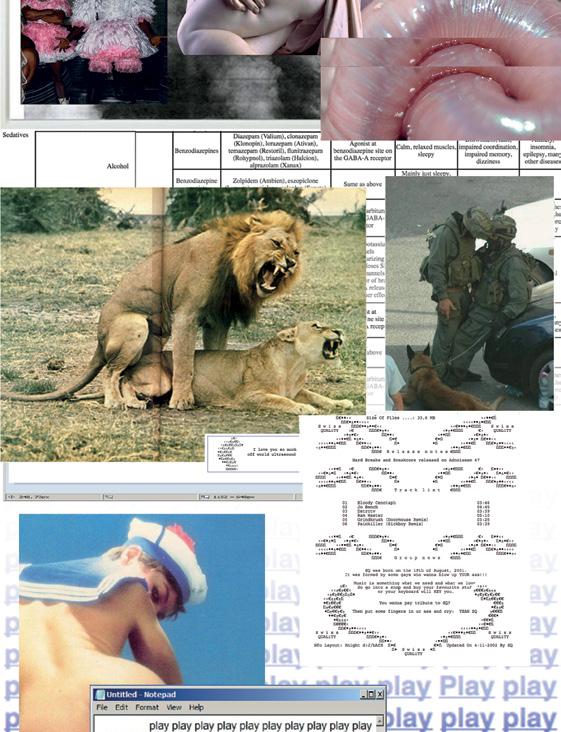
Algro Design, 350 g/m2 (cover)
Soporset Premium Offset, 80 g/m2 (all texts)
EOS vol. 2.0, 90 g/m2 (p.33)
Maxi Satin, 135 g/m2 (p.49, 225)
Holmen TRND vol. 2.0, 70 g/m2 (p.73)
Heaven 42 Absolute White, 135 g/m2 (p.97)
SuperBrut, 120 g/m2 (p.113)
Maxi Gloss 135 g/m2 (p.129)
Magno Volume, 115 g/m2 (p.161, 249)
Lessebo Design White 1.3, 115g/m2 (p.177)
UPM Sol Mat, 90 g/m2 (p.201, 289)
Rebello 110, 90 g/m2 (p.265)
For more information please call +31 344 578 100 or email advies@igepa.nl
SUBSCRIBE NOW to Foam Magazine PLAY! THE GAME CHANGING ISSUE #54 1 YEAR 3 print issues €64 2 YEARS 6 print issues €118 1 YEAR DIGITAL Latest issues €31,99 + archive Receive your issues of the world’s most inspiring photography magazine. Subscribers save up to 50% off the cover price and shipping. Go to ↓ foam.org/subscribe-now.

Brassaï 13 September –4 December 2019 Exhibition organised by
MAPFRE in collaboration with Foam. IN ASSOCIATION WITH
Couple in a Café, near the place d’Italie, c. 1932 © Estate Brassaï Succession, Paris Keizersgracht 609, Amsterdam Foam.org
Fundación
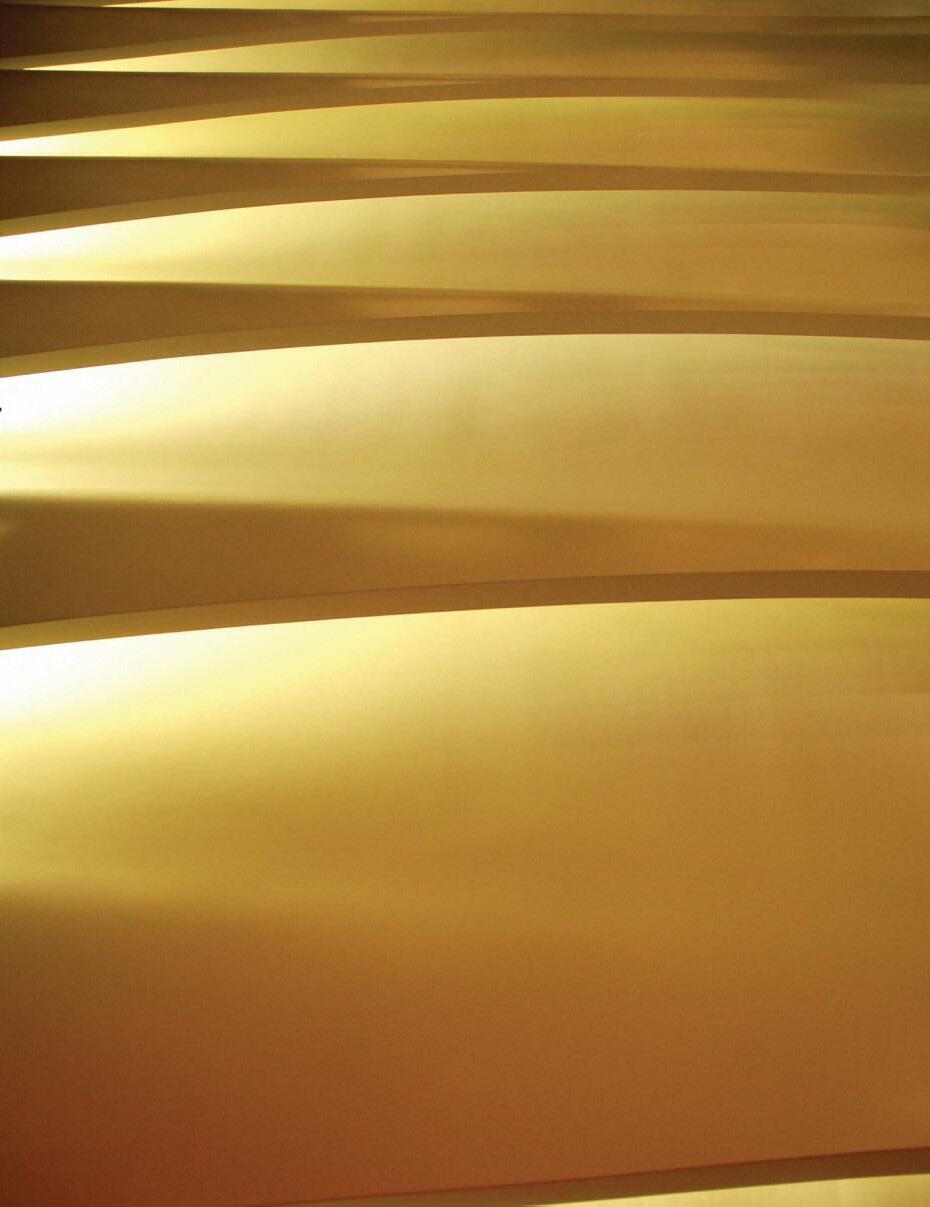
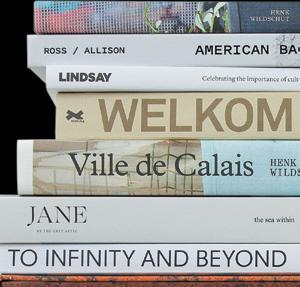
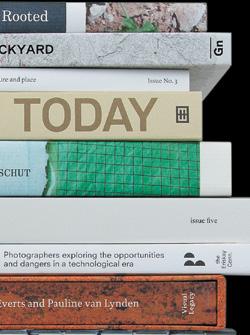

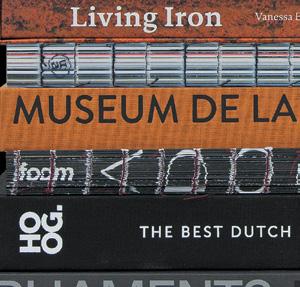
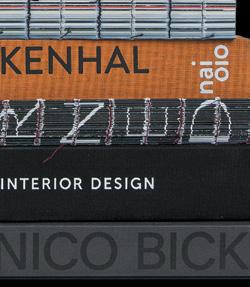





Foam and De Brauw are a natural fit: we each have international ambitions and quality is our foundation.
Managing
Proudly
Foam
2010 YOU DON’T TAKE A PHOTOGRAPH, YOU MAKE IT. WE DON’T JUST PRINT, WE REPRODUCE! PRINTING COMPANY +31 (0)76 531 95 65 www.npndrukkers.nl Rooted Henk Wildschut Design: Robin Uleman American Backyard Ross/Allison | Design: Jason Koxvold Lindsay Magazine Founder and Design: Beth Wilkinson Welkom Today Publisher Atlas Contact/Paradox | Photo’s Ad van Denderen and Lebohang Tlali | Design: Jeremy Jansen Ville de Calais Henk Wildschut Design: Robin Uleman Jane Founder and Design: Odin Wilde To Infinity and Beyond | BredaPhoto Design: Rob van Hoesel Living Iron Vanessa Everts & Pauline van Lynden Design: Frederik de Wal Emergence Magazine Print Edition Design: Studio Airport (Maurits Wouters and Bram Broerse) Museum de Lakenhal | Nai010 publishers Design: Karen Polder Foam Magazine Foam Fotografiemuseum Amsterdam | Design: Hamid Sallali / Ayumi Higuchi The Best Dutch Interior Design Flying High International | Design: Evert Bergervoet Parliaments of the European Union – Nico Bick | Design: SJG / Joost Grootens, Dimitri Jeannottat Nai010 publishers
– Geert Potjewijd
Partner, De Brauw
in partnership with
since
EDITOR-IN-CHIEF
Marcel Feil
EDITORS
Mariama Attah, Marcel Feil, Elisa Medde
MANAGING EDITOR
Elisa Medde
ASSISTANT EDITOR
Mariama Attah
EDITORIAL INTERN
Henri Badaröh
MAGAZINE MANAGEMENT
Matthijs Bakker, Maureen Marck, Madeleine van Wensen
ART DIRECTOR
Hamid Sallali
DESIGN & LAYOUT
Ayumi Higuchi, Hamid Sallali
TYPEFACES
Haarlem (Adrien Menard), L15 Medium, Medium Extended (type), Phase (Elias Hanzer)

CONTRIBUTING PHOTOGRAPHERS & ARTISTS
Franco Ariaudo & Luca Pucci, Pelle Cass, Jimmy DeSana, Laura El-Tantawy, Charlie Engman & Hillary Taymour, Kalev Erickson, Camila Falquez, David Fathi, Rolph Gobits, Jos Houweling, Kay Kasparhauser, William Kentridge, Dana Lixenberg, Mariam Medvedeva, Ivan Mikhailov, Rosana Paulino, Alice Quaresma, Sheida Soleimani, Leonard Suryajaya, Martine Syms, Mickalene Thomas, Lorenzo Vitturi
FRONT COVER
Image from the series wip. tba.001 © Kay Kasparhauser, courtesy of the artist
BACK COVER
Image from the series Mythiccbeing, 2019 © Martine Syms, courtesy of the artist and Sadie Coles HQ
CONTRIBUTING WRITERS
Franco Ariaudo & Luca Pucci, Mariama Attah, Bryan Barcena, Chiara Bardelli Nonino, Sacha Bronwasser, Ben Burbridge, Gabriela Burkhalter, Lewis Bush, Anastasiia Fedorova, Marcel Feil, Hans Gremmen, Hinde Haest, Louis Kaplan, Kim Knoppers, Cat Lachowskyj, Glenn Ligon, Dana Linssen, Maitreyi Maheshwari, Carly Mark, Alecsandra Matias de Oliveira, Elisa Medde, Pim Milo, Timothy Prus, Maisie Skidmore, Mavis Staples, Fiona Tan, Salamishah Tillet, Deborah Willis, Efrem Zelony-Mindell
TRANSLATIONS
Liz Waters
SPECIAL THANKS
Sam Cameron, Elle Burchill, Emanuele Donno, Roger Dorresteijn, Gregory Eddi Jones, Rose Eastwood, Alissa Friedman, Jaap Guldeman, Lotte Hetherington, Jan Hoek, Els Kerremans, Tomo Kosuga, Ola Lanko, Anja Lutz, Ali MacGilp, Guy Martin, Andrea Monti, Kathleen Notari, Amanda Smith
PRINTING & LITHOGRAPHY
NPN Drukkers Minervum 7250 4817 ZM Breda – NL Postbus 5750 4801 ED Breda – NL
PAPER
Igepa Nederland B.V. Biezenwei 16 4004 MB Tie – NL
EDITORIAL ADDRESS
Foam Magazine Keizersgracht 609 1017 DS Amsterdam – NL T +31 20 551 65 00 F +31 20 551 65 01 editors@foam.org
SUBSCRIPTIONS
For subscription inquiries, please e-mail online@foam.org
DISTRIBUTION
Foam Magazine is available at the best book shops worldwide.
For distribution opportunities and conditions please contact: bookshop@foam.org
ADVERTISING
Foam Magazine is looking to team up with like-minded brands and organisations. For information please contact: magazine@foam.org
STOCKISTS
Foam Magazine is available at the best book shops worldwide.
For a full list of stockists look at foam.org/stockists
EAN 8710966455234-00054
© Photographers, authors, Foam Magazine, Amsterdam, 2019. All photographs and illustration material is the copyright property of the photographers and/or their estates, and the publications in which they have been published. Every effort has been made to contact copyright holders.
Any copyright holders we have been unable to reach or to whom inaccurate acknowledgement has been made are invited to contact the publishers at magazine@foam.org.
All rights reserved. No part of this publication may be reproduced or transmittedin any form or by any means, electronic or mechanical, including photo-copy, recording or otherwise without prior written permission of the publishers.
Although the highest care is taken to make the information contained in Foam Magazine as accurate as possible, neither the publishers nor the authors can accept any responsibility for damage, of any nature, resulting from the use of this information. The views and opinions expressed throughout this publication are those of the authors.
The production of Foam Magazine has been made possible thanks to the generous support of paper supplier Igepa Netherlands B.V.
Foam Magazine is supported by the Niemeijer Fund.
288 COLOPHON
ISSUE #54, Play!
Mythiccbeing

289
MARTINE SYMS

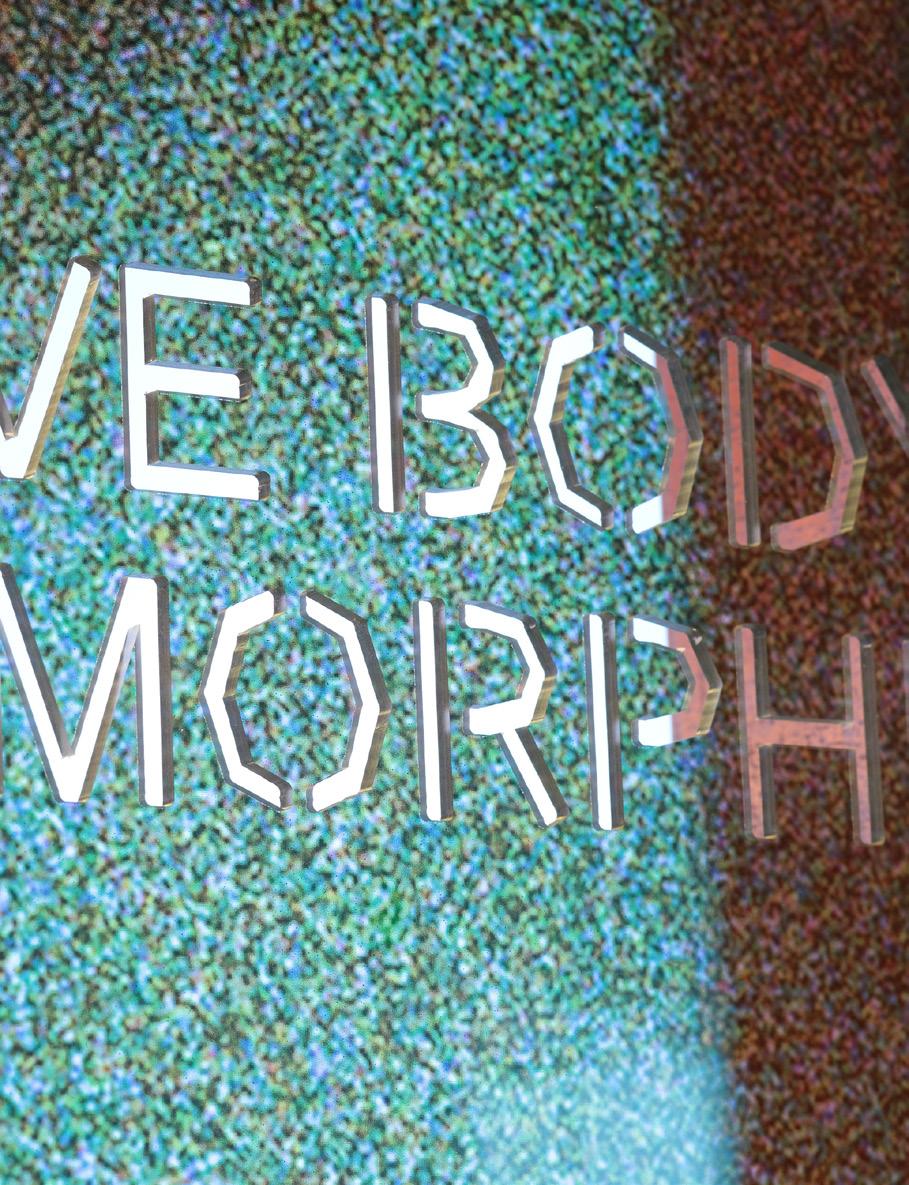

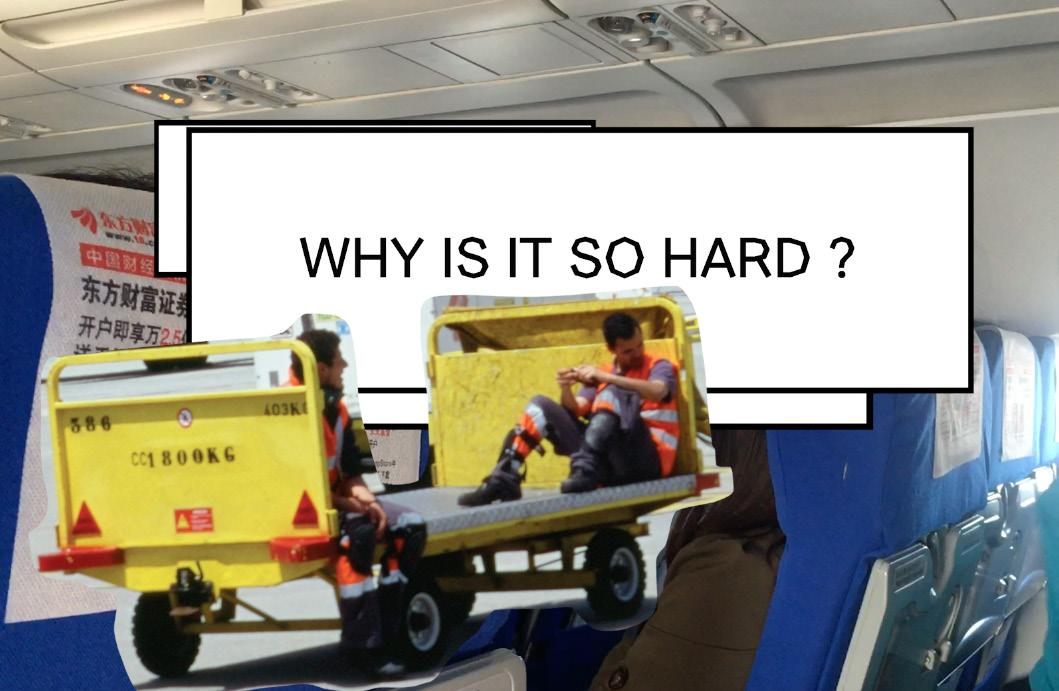
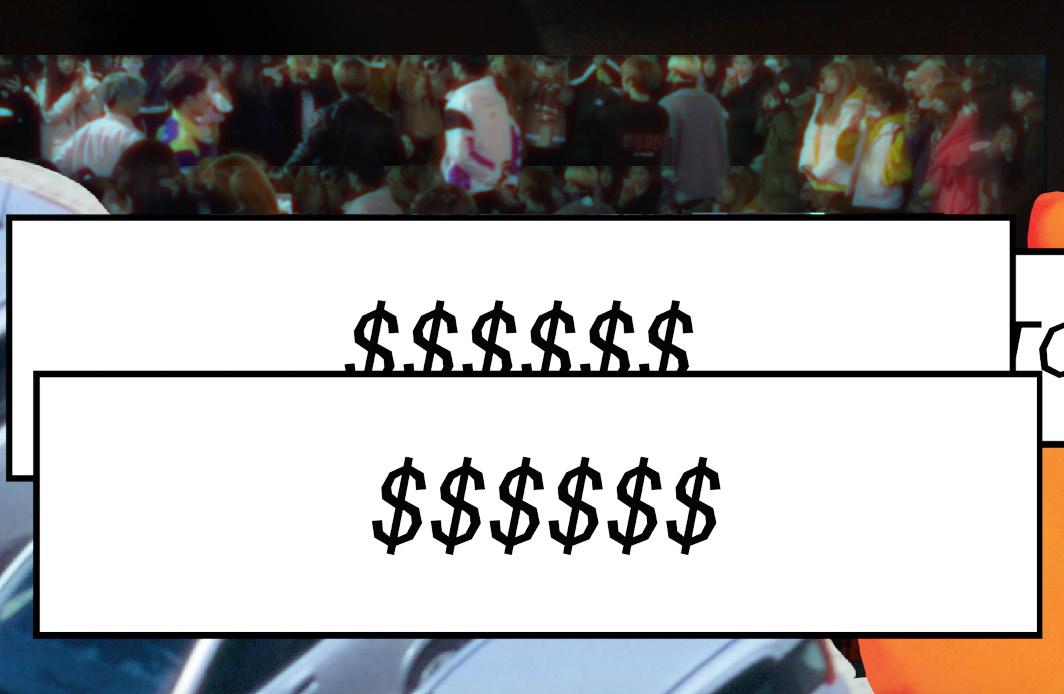
MARTINE SYMS
Mythiccbeing
+ (1|The world is crumbling and depressing, how can I feel happy about anything.)
- It will be like the first warm day after a brutal winter and you greet the sun on your face. <send> Close my eyes and pretend I don’t exist. <send> <delay seconds=5> I want to “cultivate a sense of privilege.”
+ (2|Kanye sliders.)
- I’m That Bitch. I did some cocaine and was worried I kept taking too much in the rotation. <send> <delay seconds=5> When I don’t work I start to slip away.
- Vaporizer or bong?
+ (@Vaporizer)
-I want to get rid of the interface the phone and just talk without having to dial.
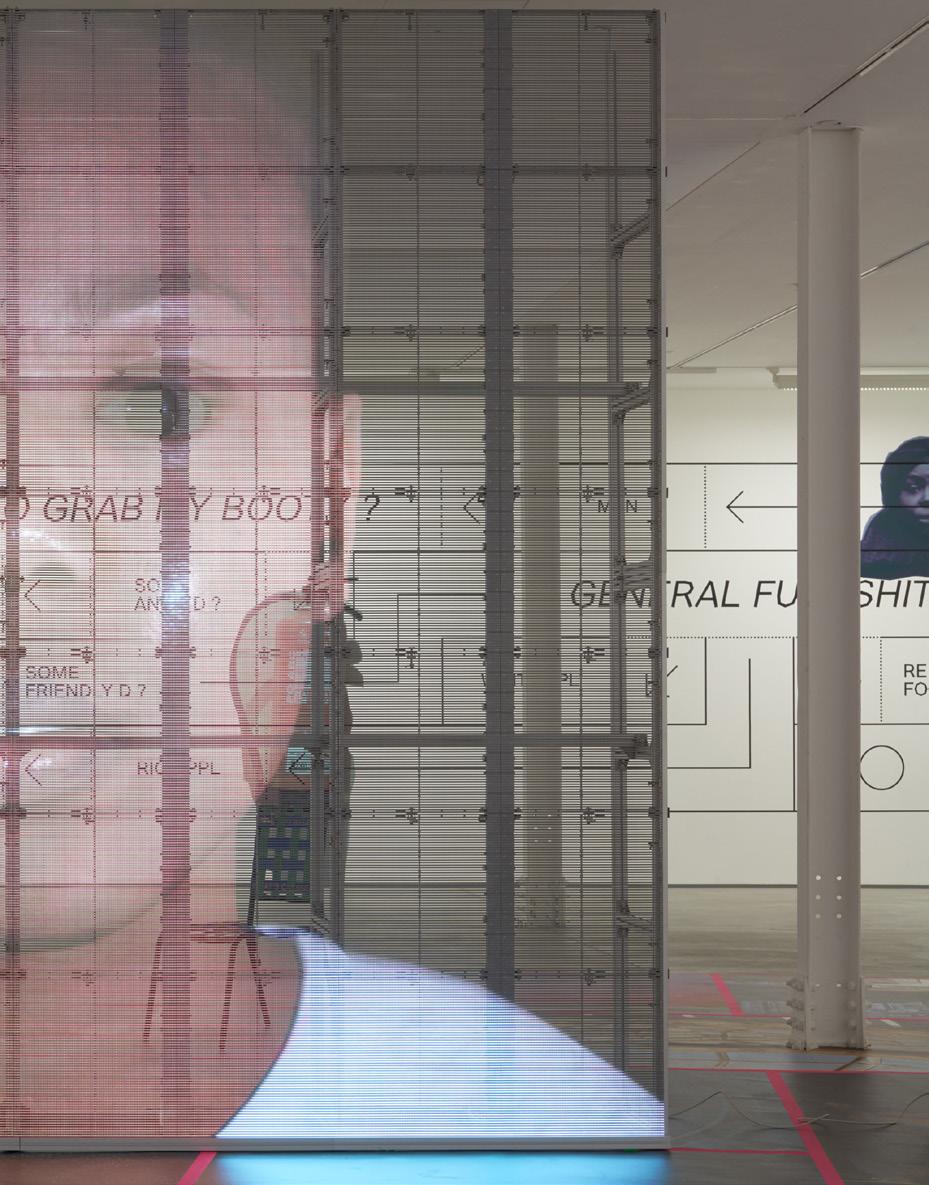
+ (@Bong)
-I forget what else happened, great parties, lots of shrooms, saving one hit for the weekend. I went to this one meeting totally high. It was the perfect use of drugs.
+ *
* <get q> == 1 => {@ question1}
* <get q> == 2 => {@ question2}
- + question1
- - I hate how someone can just insert themselves into your life. <send> <delay seconds=5> Suddenly you’re thinking about them and wondering what they’re doing, wanting to chat, share things. <set q=2>
- + question2
- - It seems like I have to fight for little scraps while everyone else gets the whole world and by everyone else I just mean white people. <set q=3>
- ^buttons (“My horoscope is like bitch CALM DE FUCK DOWN.”,”Last week I texted My Husband about grabbing lunch or dinner. He didn’t respond for about ten minutes then asked ‘Do you want to go to Mexico…?’”)
298

BP










































 by Elisa Medde
by Elisa Medde

 maybe we’re on fire , from the series psychic pictures , acrylic and UV print on carved hand-wood panel, 40×56", 2019
© Zach Nader, courtesy of the artist and Microscope Gallery
maybe we’re on fire , from the series psychic pictures , acrylic and UV print on carved hand-wood panel, 40×56", 2019
© Zach Nader, courtesy of the artist and Microscope Gallery










 make the scanned background same as page background (Rich Black)
make the scanned background same as page background (Rich Black)























































































































 — Text by Salamishah Tillet
— Text by Salamishah Tillet










































































































